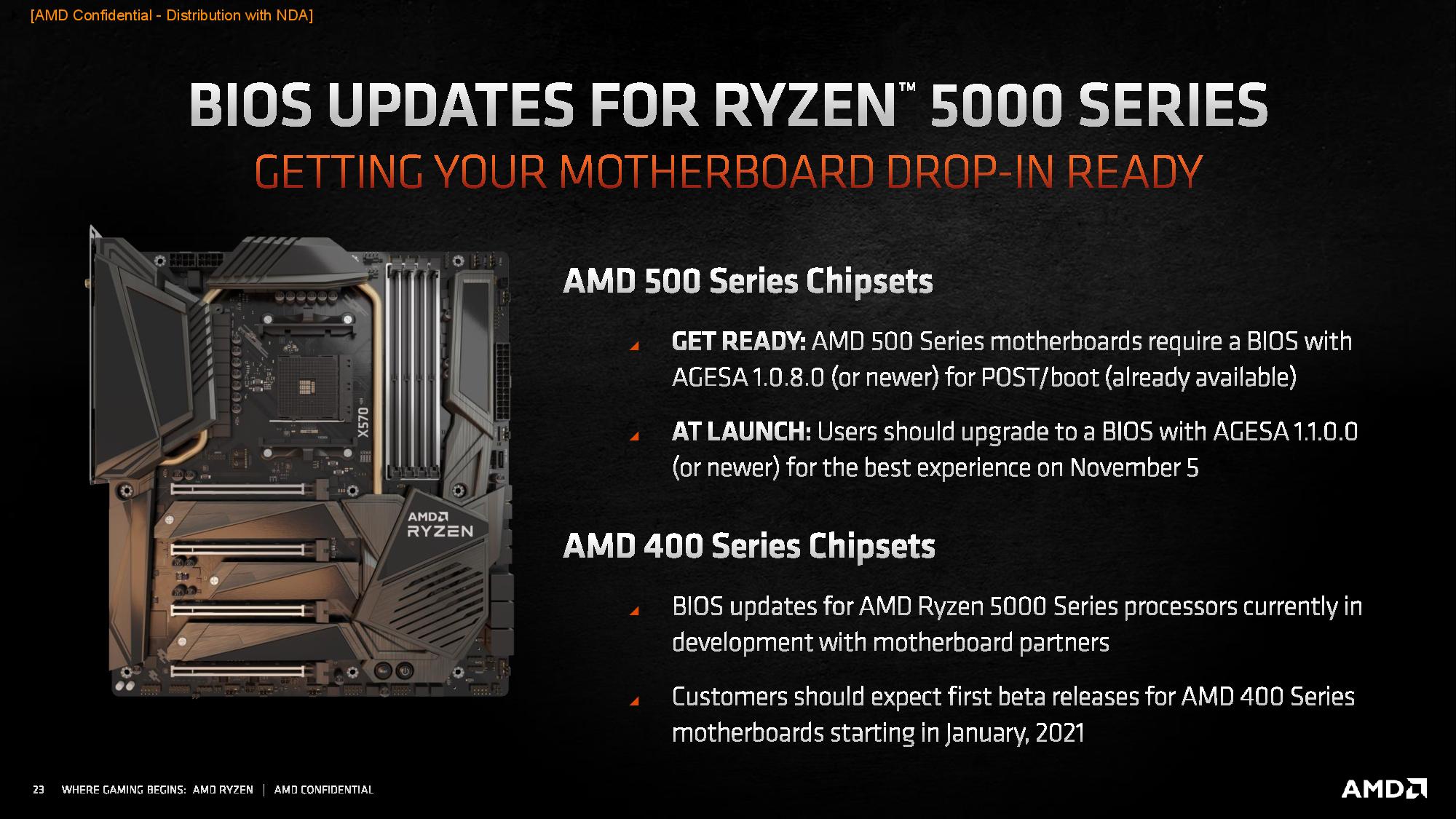AMD Zen 3 Ryzen 5000 Price, Benchmarks, Specs and More
The Zen 3 cometh
With the Ryzen 5000 series, it's fair to say that AMD had finally, and fully, eclipsed Intel's performance dominance in desktop PCs. AMD's Zen 3 architecture landed in the new Ryzen 5000 series, breaking the 5GHz barrier with a newer version of AMD's most successful architecture to date and taking our list of best CPUs for gaming by storm. We've got plenty of gaming and application benchmarks, power measurements, and thermal testing here in this article to serve as a guide to the performance you can expect from AMD's most dominant series of processors in more than a decade. We also have pricing guides and links to tips on where to find the chips at retail, and you can see how the Ryzen 5000 chips rank compared to Intel's chips in our CPU Benchmark Hierarchy.
The desktop PC was first on AMD's Zen 3 chopping block, but the new microarchitecture powers AMD's full lineup of next-gen processors, including the Ryzen 5000 "Vermeer" desktop processors that have taken over our list of Best CPUs and the EPYC Milan data center processors. AMD has also now announced its new Ryzen 5000 Mobile series, which is coming to retail soon in a host of new laptops. This base design also powers the promising new Ryzen 5000G 'Cezanne' APUs that are coming to a desktop PC near you later this year.
The first four Ryzen 5000 series desktop PC models stretch from the $299 Ryzen 5 5600X up to the $799 Ryzen 9 5950X. Barring shortages, the CPUs are on shelves now and represent a massive shift in the AMD vs Intel CPU wars. At launch, the Ryzen 5000 processors finally eclipsed Intel's chips in every single metric that matters, like single- and multi-threaded workloads, productivity applications, and 1080p gaming performance, all by surprising margins.
AMD's Zen 3 features a ground-up rethinking of the microarchitecture that finally allowed it to take the 1080p gaming performance lead from Intel. Paired with a 19% boost to instructions per cycle (IPC) throughput and peak rated boost speeds of up to 4.9 GHz, Zen 3 is the magic 7nm bullet that finally upset Intel from its position at the top of our CPU gaming benchmarks.
However, Intel fired back with the Alder Lake processors, like the Core i9-12900K, Core i7-12700K, and Core i5-12400 which retook the lead, at least at the comparable price points.
Here's the Zen 3 Ryzen 5000 series processors that AMD launched as its initial salvo, and given that the company is launching its Zen 4 Ryzen 7000 chips by the end of the year, we don't think we'll see newer models any time soon:
| Zen 3 Ryzen 5000 Series Processors | RCP (MSRP) | Cores/Threads | Base/Boost Freq. | TDP | L3 Cache | Graphics |
|---|---|---|---|---|---|---|
| Ryzen 9 5950X | $799 | 16 / 32 | 3.4 / 4.9 GHz | 105W | 64MB (2x32) | N/A |
| Ryzen 9 5900X | $549 | 12 / 24 | 3.7 / 4.8 GHz | 105W | 64MB (2x32) | N/A |
| Ryzen 7 5800X | $449 | 8 / 16 | 3.8 / 4.7 GHz | 105W | 32MB (2x16) | N/A |
| Ryzen 5 5600X | $299 | 6 / 12 | 3.7 / 4.6 GHz | 65W | 32MB (2x16) | N/A |
| Ryzen 7 5700G | ? | 8 / 16 | 3.8 / 4.6 | 65W | 20MB | RX Vega 8 |
| Ryzen 7 5700GE | ? | 8 / 16 | 3.2 / 4.6 | 35W | 20MB | RX Vega 8 |
| Ryzen 5 5600G | ? | 6 / 12 | 3.9 / 4.4 | 65W | 12MB | RX Vega 7 |
| Ryzen 5 5600GE | ? | 6 / 12 | 3.4 / 4.4 | 35W | 12MB | RX Vega 7 |
| Ryzen 3 5300G | ? | 4 / 8 | 4.0 / 4.2 | 65W | 10MB | RX Vega 6 |
| Ryzen 3 5300GE | ? | 4 / 8 | 3.6 / 4.2 | 35W | 10MB | RX Vega 6 |
AMD followed up that impressive roster with a new lineup to face down Intel's Alder Lake:
| Row 0 - Cell 0 | Price Street/MSRP | Design - Arch. | E/P – Core|Thread | P-Core Base/Boost (GHz) | TDP / PBP / MTP | L3 Cache |
| Ryzen 7 5800X3D | $449 | Zen 3 - Vermeer | 8P | 16T | 3.4 / 4.5 | 105W | 96MB |
| Ryzen 7 5700X | $299 | Zen 3 - Vermeer | 8P | 16T | 3.4 / 4.6 | 65W | 32MB |
| Ryzen 5 5600 | $199 | Zen 3 - Vermeer | 6P|12T | 3.5 / 4.4 | 65W | 32MB |
| Ryzen 5 5500 | $159 | Zen 3 - Cezanne | 6P | 12T | 3.6 / 4.2 | 65W | 16MB |
| Ryzen 5 4600G | $154 | Zen 2 - Renoir | 6P | 12T | 3.7 / 4.2 | 65W | 8MB |
| Ryzen 5 4500 | $129 | Zen 2 - Renoir | 6P | 12T | 3.6 / 4.1 | 65W | 8MB |
| Ryzen 3 4100 | $99 | Zen 2 - Renoir | 4P | 8T | 3.8 / 4.0 | 65W | 4MB |
AMD’s new Cezanne and Renoir chips take a new approach of using Zen 3 and Zen 2-powered APU silicon with disabled integrated graphics units to tackle the low-end, while the Ryzen 7 5800X3D retook the gaming performance crown.
Get Tom's Hardware's best news and in-depth reviews, straight to your inbox.
We also took the Ryzen 7 5700X, Ryzen 5 5600, and the Ryzen 5 5500 all for a spin, and we're working to test the last few of the new AMD Ryzen 5000 entrants. We'll do a full update of the article below after we've retested the entire Ryzen 5000 stack. For now, you can check out these charts with the new competitive positioning and the following face-offs, all of which will help highlight the current competitive positioning:
| Row 0 - Cell 0 | Price Street/MSRP | Design - Arch. | E/P – Core|Thread | P-Core Base/Boost (GHz) | E-Core Base/Boost (GHz) | TDP / PBP / MTP | Memory Support | L3 Cache |
| Ryzen 9 5950X | $600 ($799) | Zen 3 - Vermeer | 16P | 32T | 3.4 / 4.9 | - | 105W | DDR4-3200 | 64MB (2x32) |
| Core i9-12900K / KF | $589 (K) - $564 (KF) | Alder Lake | 8P+8E | 16C/24T | 3.2 / 5.2 | 2.4 / 3.9 | 125W / 241W | DDR4/5-3200/4800 | 30MB |
| Ryzen 9 5900X | $450 ($549) | Zen 3 - Vermeer | 12P | 24T | 3.7 / 4.8 | - | 105W | DDR4-3200 | 32MB (1x32) |
| Ryzen 7 5800X3D | $449 | Zen 3 - Vermeer | 8P | 16T | 3.4 / 4.5 | - | 105W | DDR4-3200 | 96MB |
| Core i7-12700K / KF | $409 (K) - $384 (KF) | Alder Lake | 8P+4E | 12C/20T | 3.6 / 5.0 | 2.7 / 3.8 | 125W / 190W | DDR4/5-3200/4800 | 25MB |
| Ryzen 7 5800X | $350 ($449) | Zen 3 - Vermeer | 8P | 16T | 3.8 / 4.7 | - | 105W | DDR4-3200 | 32MB |
| Row 0 - Cell 0 | Price Street/MSRP | Design - Arch. | E/P – Core|Thread | P-Core Base/Boost (GHz) | E-Core Base/Boost (GHz) | TDP / PBP / MTP | Memory Support | L3 Cache |
| Core i7-12700K / KF | $409 (K) - $384 (KF) | Alder Lake | 8P+4E | 12C/20T | 3.6 / 5.0 | 2.7 / 3.8 | 125W / 190W | DDR4/5-3200/4800 | 25MB |
| Ryzen 7 5800X | $350 ($449) | Zen 3 - Vermeer | 8P | 16T | 3.8 / 4.7 | - | 105W | DDR4-3200 | 32MB |
| Ryzen 7 5700X | $299 | Zen 3 - Vermeer | 8P | 16T | 3.4 / 4.6 | - | 65W | DDR4-3200 | 32MB |
| Core i5-12600K / KF | $289 (K) - $264 (KF) | Alder Lake | 6P+4E | 10C/16T | 3.7 / 4.9 | 2.8 / 3.6 | 125W / 150W | DDR4/5-3200/4800 | 16MB |
| Ryzen 7 5700G (APU) | $295 ($359) | Zen 3 - Cezanne | 8P | 16T | 3.8 / 4.6 | - | 65W | DDR4-3200 | 16MB |
| Ryzen 5 5600X | $225 ($299) | Zen 3 - Vermeer | 6P | 12T | 3.7 / 4.6 | - | 65W | DDR4-3200 | 32MB |
| Ryzen 5 5600G (APU) | $220 ($259 ) | Zen 3 - Cezanne | 6P | 12T | 3.9 / 4.4 | - | 65W | DDR4-3200 | 16MB |
| Ryzen 5 5600 | $199 | Zen 3 - Vermeer | 6P|12T | 3.5 / 4.4 | - | 65W | DDR4-3200 | 32MB |
| Core i5-12400 / F | $192 - $167 (F) | Alder Lake | 6P+0E | 6C/12T | 4.4 / 2.5 | - | 65W / 117W | DDR4/5-3200/4800 | 18MB |
| Ryzen 5 3600X | $250 ($240) | Zen 2 | 6P | 12T | 3.8 / 4.4 | - | 95W | DDR4-3200 | 32MB |
| Ryzen 5 3600 | $229 ($200) | Zen 2 | 6P | 12T | 3.6 / 4.2 | - | 65W | DDR4-3200 | 32MB |
| Ryzen 5 5500 | $159 | Zen 3 - Cezanne | 6P | 12T | 3.6 / 4.2 | - | 65W | DDR4-3200 | 16MB |
| Ryzen 5 4600G (APU) | $154 | Zen 2 - Renoir | 6P | 12T | 3.7 / 4.2 | - | 65W | DDR4-3200 | 8MB |
| Row 0 - Cell 0 | Price Street/MSRP | Design - Arch. | E/P – Core|Thread | P-Core Base/Boost (GHz) | TDP / PBP / MTP | Memory Support | L3 Cache |
| Ryzen 5 5500 | $199 | Zen 3 - Cezanne | 6P | 12T | 3.6 / 4.2 | 65W | DDR4-3200 | 16MB |
| Ryzen 5 4600G (APU) | $154 | Zen 2 - Renoir | 6P | 12T | 3.7 / 4.2 | 65W | DDR4-3200 | 8MB |
| Core i3-12100 / F | $122 - $97 (F) | Alder Lake | 4P+0E | 4C/8T | 3.3 / 4.3 | 60W / 89W | DDR4/5-3200/4800 | 12MB |
| Ryzen 5 4500 | $129 | Zen 2 - Renoir | 6P | 12T | 3.6 / 4.1 | 65W | DDR4-3200 | 8MB |
| Ryzen 3 4100 | $99 | Zen 2 - Renoir | 4P | 8T | 3.8 / 4.0 | 65W | DDR4-3200 | 4MB |
- Ryzen 7 5800X3D vs Core i7-12700K and Core i9-12900K Face-Off: The Rise of 3D V-Cache
- Intel Core i9-12900K vs Ryzen 9 5900X and 5950X: Alder Lake and Ryzen 5000 Face Off
- Intel Core i5-12600K vs AMD Ryzen 5 5600X and 5800X Face Off: Ryzen Has Fallen
- Intel Core i7-12700K vs AMD Ryzen 9 5900X and 5800X Face Off: Intel Rising
- Intel Core i5-12400 vs AMD Ryzen 5 5600X Face-Off: The Gaming Value Showdown
Check out those articles above for the latest performance and pricing info. We'll update the rest of the article once we're done retesting the new Ryzen 5000 models. The historical view follows:
AMD's Zen 3 Ryzen 5000 series begins with the impressive 16-core 32-thread Ryzen 9 5950X that has a recommended $799 price tag. This chip boosts up to 4.9 GHz, has 64MB of unified L3 cache, and a 105W TDP rating. As you'll see in the CPU benchmark comparisons below, AMD's Ryzen chip is faster than Intel's 10-core Core i9-10900K in pretty much everything, which isn't surprising — Intel has no equivalent for the mainstream desktop.
The $549 Ryzen 9 5900X slots in as the more mainstream contender, at least by AMD's definition of 'mainstream,' with 12 cores and 24 threads that boost up to 4.8 GHz. Intel's Rocket Lake Core i9-11900K exceeds the 5900X's AMD's single-threaded prowess while still trailing in gaming and multi-threaded work.
The 6-core 12-thread $299 Ryzen 5 5600X's base clocks come in at 100 MHz less than the previous-gen 3600XT, while boosts are 100 MHz higher at 4.6 GHz. AMD's previous-gen 6C/12T Ryzen 5 3600XT had a 95W TDP, but AMD dialed that back to 65W with the 5600X, showing that Zen 3's improved IPC affords lots of advantages. Despite the reduced TDP rating, the 5600X delivers explosive performance gains.
The Ryzen 5 5600X's $300 price tag establishes a new price band for a mainstream processor, so Intel doesn't have chips with an identical price range; the Core i5-11600K is the nearest Intel comparable. This chip carries a $262 price tag for the full-featured model, while the graphics-less 11600KF weighs in at $237.
But AMD does have a glaring hole in its product stack: You'll have to shell out an extra $150 to step up from the $300 6C/12T Ryzen 5 5600X to the $450 8C/16T Ryzen 7 5800X, which is a steep jump that leaves room for the 10700K to operate. Based upon product naming alone, it appears there is a missing Ryzen 7 5700X in the stack, but it remains to be seen if AMD will actually introduce that model.
AMD also recently announced the Ryzen 9 5900 and Ryzen 7 5800 processors, but those are destined for OEMs, meaning you won't be able to find them at retail. The company also announced its Ryzen 5000 Mobile 'Cezanne' processors at CES 2021, bringing the power of Zen 3 to laptops for the first time, which we'll dive into further below. AMD has also announced its long-anticipated Ryzen 5000G chips that come armed with the Zen 3 architecture and Vega graphics. These chips are headed to OEMs now and will come to retail outlets soon, meaning enthusiasts will soon have a lower-cost path to entry-level gaming, which will be helpful in these times of shortages.
As odd as it sounds, Intel may have one hidden advantage — pricing. AMD now positions the Ryzen 5000 series as the premium brand. As a result, AMD has pushed pricing up by $50 across the stack compared to its Ryzen XT models. However, the XT family doesn't really represent AMD's best value; its own Ryzen 3000 series, which comes at much lower price points, holds that crown.
However, AMD still maintains the performance-per-dollar lead that justifies the price tag. Let's see below how that shakes out.
AMD Zen 3 Ryzen 5000 Series At A Glance
- 1080p gaming performance leadership
- Ryzen 9, 7, and 5 models
- CPUs from 6C/12T up to 16C/32T
- Same optimized 7nm process as Ryzen XT models
- Zen 3 microarchitecture delivers 19% IPC improvement
- 24% gen-on-gen power efficiency improvement — 2.8X better than 10900K
- Higher peak frequencies for most models — 4.9 GHz on Ryzen 9 5950X
- Lower base frequency for all models, offset by increased IPC
- L3 cache now unified in a single 32MB cluster per eight-core chiplet (CCD)
- Higher pricing across the stack (~$50)
- No bundled cooler with Ryzen 9 and Ryzen 7 models
- Drop-in compatible with the AM4 socket
- No new chipset/motherboards launched
- Current-gen 500-series motherboards work now (caveats below)
- Beta support for 400-series motherboards has already begun
- All Zen 3 desktop, mobile, and APU CPUs will carry Ryzen 5000 branding
- Same 142W maximum socket power for AM4 socket as previous-gen
- Same 12nm GlobalFoundries I/O Die (IOD)
AMD Ryzen 5000 Series Specifications
Here we can see the full Ryzen 5000 series product stack, and how the new CPUs stack up against Intel's Comet Lake. The first big thing you'll notice is the increased Precision Boost clock rates, which now stretch up to 4.9 GHz. However, we also see a broad trend of lower base frequencies for the Ryzen 5000 series compared to the previous-gen processors, but that isn't too surprising considering the much higher performance-per-watt that we'll outline below.
| Zen 3 Ryzen 5000 Series Processors | RCP (MSRP) | Cores/Threads | Base/Boost Freq. | TDP | L3 Cache |
|---|---|---|---|---|---|
| Ryzen 9 5950X | $799 | 16 / 32 | 3.4 / 4.9 | 105W | 64MB (2x32) |
| Core i9-10980XE | $815 (retail) | 18 / 36 | 3.0 / 4.8 | 165W | 24.75MB |
| Ryzen 9 3950X | $749 | 16 / 32 | 3.5 / 4.7 | 105W | 64MB (4x16) |
| Ryzen 9 5900X | $549 | 12 / 24 | 3.7 / 4.8 | 105W | 64MB (2x32) |
| RKL-S Core i9-11900K (KF) | $539 (K) - $513 (KF) | 8 / 16 | 3.5 / 5.3 | 125W | 16MB |
| Core i9-10900K / F | $488 - $472 | 10 / 20 | 3.7 / 5.3 | 125W | 20MB |
| Ryzen 9 3900XT | $499 | 12 / 24 | 3.9 / 4.7 | 105W | 64MB (4x16) |
| Ryzen 7 5800X | $449 | 8 / 16 | 3.8 / 4.7 | 105W | 32MB (2x16) |
| Core i9-10850K | $453 | 10 / 20 | 3.6 / 5.2 | 95W | 20MB |
| RKL-S Core i7-11700K (KF) | $399 (K) - $374 (KF) | 8 / 16 | 3.6 / 5.0 | 125W | 16MB |
| Core i7-10700K / F | $374 - $349 | 8 / 16 | 3.8 / 5.1 | 125W | 16MB |
| Ryzen 7 3800XT | $399 | 8 / 16 | 3.9 / 4.7 | 105W | 32MB (2x16) |
| Ryzen 5 5600X | $299 | 6 / 12 | 3.7 / 4.6 | 65W | 32MB (1x32) |
| RKL-S Core i5-11600K (KF) | $262 (K) - $237(KF) | 6 / 12 | 3.9 / 4.9 | 125W | 12MB |
| Core i5-10600K / F | $262 - $237 | 6 / 12 | 4.1 / 4.8 | 125W | 12MB |
| Ryzen 5 3600XT | $249 | 6 / 12 | 3.8 / 4.5 | 95W | 32MB (1x32) |
AMD obviously leans on its improved IPC rather than raw clock speeds, thus boosting its power efficiency and reducing heat generation. The Ryzen 5 5600X is the best example of that — despite only a slight reduction to the base frequency, the chip drops to a 65W TDP compared to its predecessor's 95W.
What's not as impressive? AMD has continued with the precedent it set with its Ryzen XT series: Bundled coolers no longer come with processors with a TDP higher than 65W. That means the Ryzen 5 5600X will be the only Ryzen 5000 chip that comes with a cooler in the box. AMD said it decided to skip bundled coolers in higher-TDP models largely because it believes most enthusiasts looking for high-performance CPUs use custom cooling anyway. AMD also still specs a 280mm (or greater) AIO liquid cooler for the Ryzen 9 and 7 CPUs, which significantly adds to the overall platform costs.
AMD continues to only guarantee its boost frequencies on a single core, and all-core boosts will vary based on the cooling solution, power delivery, and motherboard BIOS. The Ryzen 5000 series CPUs still expose the same 20 lanes of PCIe 4.0 to the user (another four are dedicated to the chipset) and stick with DDR4-3200 memory. Memory overclocking capabilities have also improved vastly, particularly regarding fabric clocking that allows tuners to run the memory in optimized 'coupled' 1:1 mode. We've seen plenty of reports of reaching DDR4-4000 in coupled mode, and we've done it ourselves. However, as with all overclocking, your mileage may vary – we could only achieve a stable DDR4-4000 overclocked in coupled mode with one of our four samples (The 5950X). (For more about overclocking head to our How to Overclock a CPU article.)
Ryzen 5000 Mobile
Before we jump to performance benchmarks for the desktop chips, AMD announced the 'Cezanne' Ryzen 5000 Mobile processors that bring the powerful Zen 3 architecture to the notebook market for the first time, opening the door for the company to finally have a larger presence in the highest-end gaming notebooks. That means that we'll finally see AMD's chips paired with the highest-end mobile GPUs when the new Ryzen 5000 Mobile processors come to market in February, which could shake up our Best Gaming Laptops rankings.
| Row 0 - Cell 0 | Cores / Threads | Base / Boost | TDP | GPU CU / Boost | Cache |
| Ryzen 9 5980HX | 8 / 16 | 3.3 / 4.8 | 45W+ | 8 / 2.1 GHz | 20MB |
| Ryzen 9 5980HS | 8 / 16 | 3.0 / 4.8 | 35W | 8 / 2.1 GHz | 20MB |
| Ryzen 9 5900HX | 8 / 16 | 3.3 / 4.6 | 45W+ | 8 / 2.1 GHz | 20MB |
| Ryzen 9 5900HS | 8 / 16 | 3.0 / 4.6 | 35W | 8 / 2.1 GHz | 20MB |
| Ryzen 9 4900H | 8 / 16 | 3.3 / 4.3 | 45W | 8 / 1.75 GHz | 12MB |
| Ryzen 9 4900HS | 8 / 16 | 3.0 / 4.3 | 35W | 8 / 1.75 GHz | 12MB |
| Ryzen 7 5800H | 8 / 16 | 3.2 / 4.4 | 45W | 8 / 2.0 GHz | 20MB |
| Ryzen 7 4800H | 8 / 16 | 2.9 / 4.2 | 45W | 7 / 1.6 GHz | 12MB |
| Ryzen 7 5800HS | 8 / 16 | 2.8 / 4.4 | 35W | 8 / 2.0 GHz | 20MB |
| Ryzen 7 4800HS | 8 / 16 | 2.9 / 4.2 | 35W | 7 / 1.6 GHz | 12MB |
| Ryzen 5 5600H | 6 / 12 | 3.3 / 4.2 | 45W | 7 / 1.8 GHz | 19MB |
| Ryzen 5 4600H | 6 / 12 | 3.0 / 4.0 | 45W | 6 / 1.5 GHz | 11MB |
| Ryzen 5 5600HS | 6 / 12 | 3.0 / 4.2 | 35W | 7 / 1.8 GHz | 19MB |
| Ryzen 5 4600HS | 6 / 12 | 3.0 / 4.0 | 35W | 6 / 1.5 GHz | 11MB |
AMD says the new chips set the new standard for battery life in x86 notebooks and remain the only 8-core x86 chips for ultrathin laptops. The 13 new processors span from low-power 15W chips up to two new overclockable 45W+ HX-series models designed to bring desktop PC-like gaming performance to notebooks. The Ryzen 5000 mobile processors all come with threading enabled, the 7nm Vega graphics engine with higher graphics boost clocks than the prior-gen models, support CPPC (Collaborative Power and Performance Control) technology, which we’ll dive into shortly, and have higher CPU boost clocks than the previous-gen.
As before, the H-series models are designed for notebooks that will use discrete graphics. The two 45W+ eight-core HX models carve out a new high-performance niche by bringing CPU, memory, and fabric overclocking to AMD-powered notebooks for the first time, but overclocking headroom will largely be dictated by the thermal and power characteristics of each notebook. Naturally, bulkier notebooks with more robust cooling and power delivery will unlock better overclockability.
The two H models slot in with eight- and six-core variants and a 45W TDP rating, with the former having eight CUs that boost to 2.0 GHz, while the latter has seven CUs that stretch up to 1.8 GHz.
AMD also expanded its HS series with four chips with boost clocks that reach up to 4.8 GHz within the 35W TDP envelope. AMD segments the HS stack with three eight-core models with varying base and boost clocks, but these models have lower base clocks than the H-series models to accommodate the 35W TDP envelope. AMD also has a lone six-core twelve-thread model to round out the bottom of the H-Series stack. AMD also segments the HS models with either seven or eight Vega CUs, with peak boost clocks weighing in at 2.1 GHz.
| Row 0 - Cell 0 | Cores / Threads | Base / Boost | GPU CU / Boost | Cache |
| Ryzen 7 5800U - Zen 3 | 8 / 16 | 1.9 / 4.4 | 8 / 2.0 GHz | 20MB |
| Ryzen 7 4800U | 8 / 16 | 1.8 / 4.1 | 8 / 1.75 GHz | 8MB |
| Ryzen 7 5700U - Zen 2 | 8 / 16 | 1.8 / 4.3 | 8 / 1.9 GHz | 12MB |
| Ryzen 7 4700U | 8 / 16 | 2.0 / 4.1 | 7 / 1.6 GHz | 8MB |
| Ryzen 5 5600U - Zen 3 | 6 / 12 | 2.3 / 4.2 | 7 / 1.8 GHz | 19MB |
| Ryzen 5 4600U | 6 / 12 | 2.1 / 4.0 | 6 / 1.5 GHz | 8MB |
| Ryzen 5 5500U - Zen 2 | 6 / 12 | 2.1 / 4.0 | 7 / 1.8 GHz | 11MB |
| Ryzen 5 4500U | 6 / 6 | 2.3 / 4.0 | 6 / 1.5 GHz | 8MB |
| Ryzen 3 5400U - Zen 3 | 4 / 8 | 2.6 / 4.0 | 6 / 1.6 GHz | 10MB |
| Ryzen 3 4300U | 4 / 4 | 2.7 / 3.7 | 5 / 1.4 GHz | 4MB |
| Ryzen 3 5300U - Zen 2 | 4 / 8 | 2.6 / 3.8 | 6 / 1.5 GHz | 6MB |
The 15W U-Series models slot in for thin and light devices and will often lean on the integrated graphics units. AMD recently chose to unify its Ryzen Mobile branding under the same Ryzen 5000 umbrella as its desktop chips to clear up the confusion with the Ryzen 4000 series processors that came with an older architecture than desktop Ryzen 3000 models.
However, AMD also sprinkled in three Zen 2 'Lucienne' chips in the Ryzen 5000 Mobile stack, muddying the waters. AMD says this approach meets specific pricing criteria and customer (OEM) demand on the lower end of its product stack. These Zen 2-powered Ryzen 3, 5, and 7 models slot into the lowest-end 15W U-series category.
The Zen 2 variants come with the same design as their predecessors, but again, the targeted enhancements to the SoC (all of the same modifications listed below apply) and increased clock rates result in higher performance.
The Ryzen 7, 5, and 3 families also include one Zen 3 model apiece with either eight cores and 16 threads, or four cores and eight threads. Unlike the previous-gen Ryzen 4000 chips, all of the 15W models come threading enabled.
We're primarily focused on the desktop PC chips for this article, but you can head to our AMD Announces Ryzen 5000 Mobile 'Cezanne' Processors, Zen 3 and Overclocking Comes to Laptops article for an overview of the mobile chips, including Ryzen 5000 Mobile benchmarks. We also have our AMD Ryzen 5000 Mobile 'Cezanne' SoC Deep Dive: Zen 3 Powers Into Notebooks article that has all the deep-dive architectural details.
AMD Ryzen 5000 Zen 3 Performance Benchmarks and Comparisons
AMD Ryzen 9 5950X and Ryzen 9 5900X Gaming and Application CPU Benchmarks
Here you can see the geometric mean of our gaming tests at 1080p and 1440p, with each resolution split into its own chart.
We're accustomed to Intel dominate the gaming charts, so these cumulative measurements are quite shocking: AMD's stock Ryzen 9 5950X and Ryzen 9 5900X lead Intel's heavily-overclocked Core i9-10900K and Core i7-10700K in our 1080p gaming suite in average frame rates (Intel's overclocked chips hold a slight lead in 99th-percentile measurements).
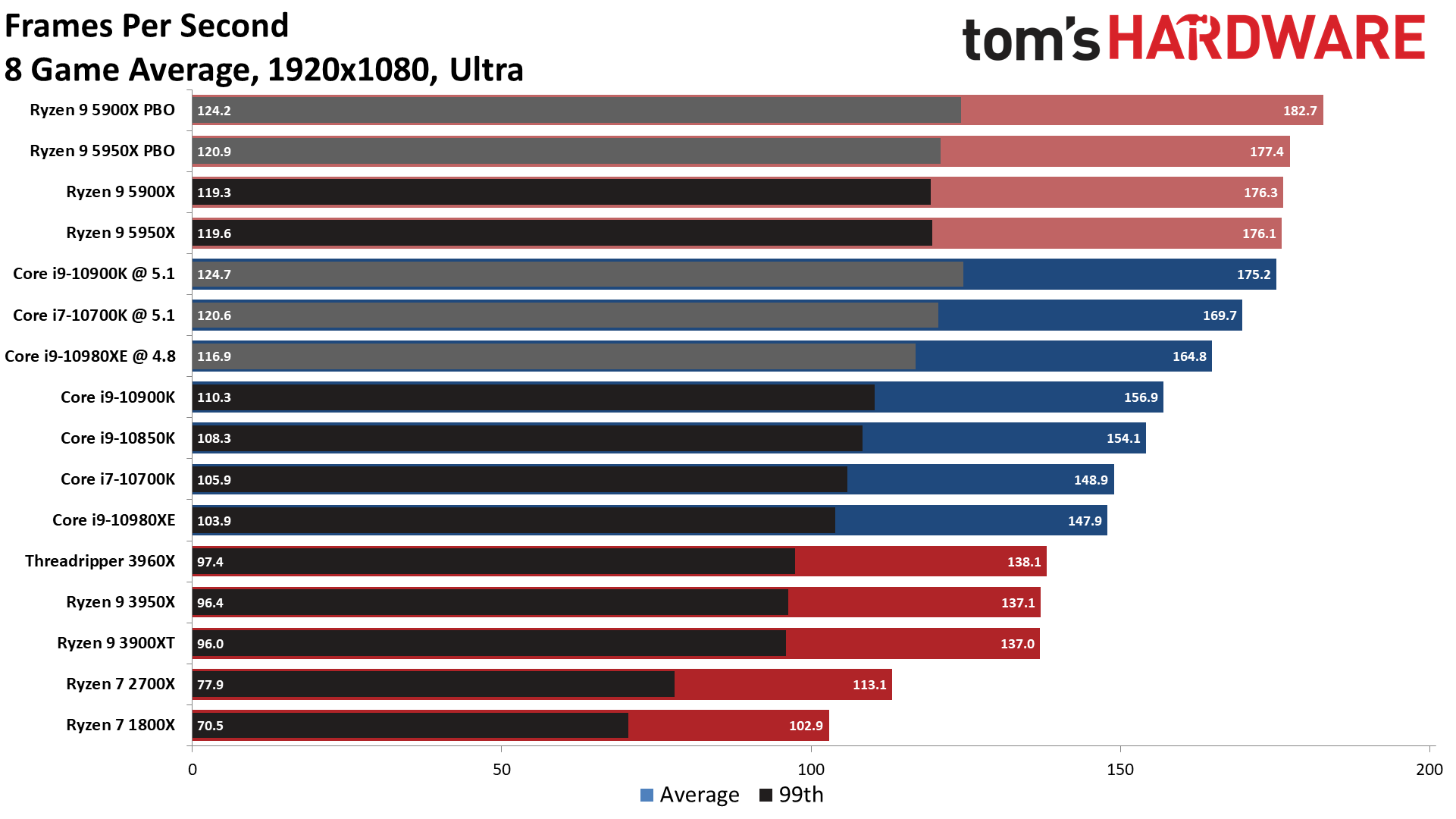
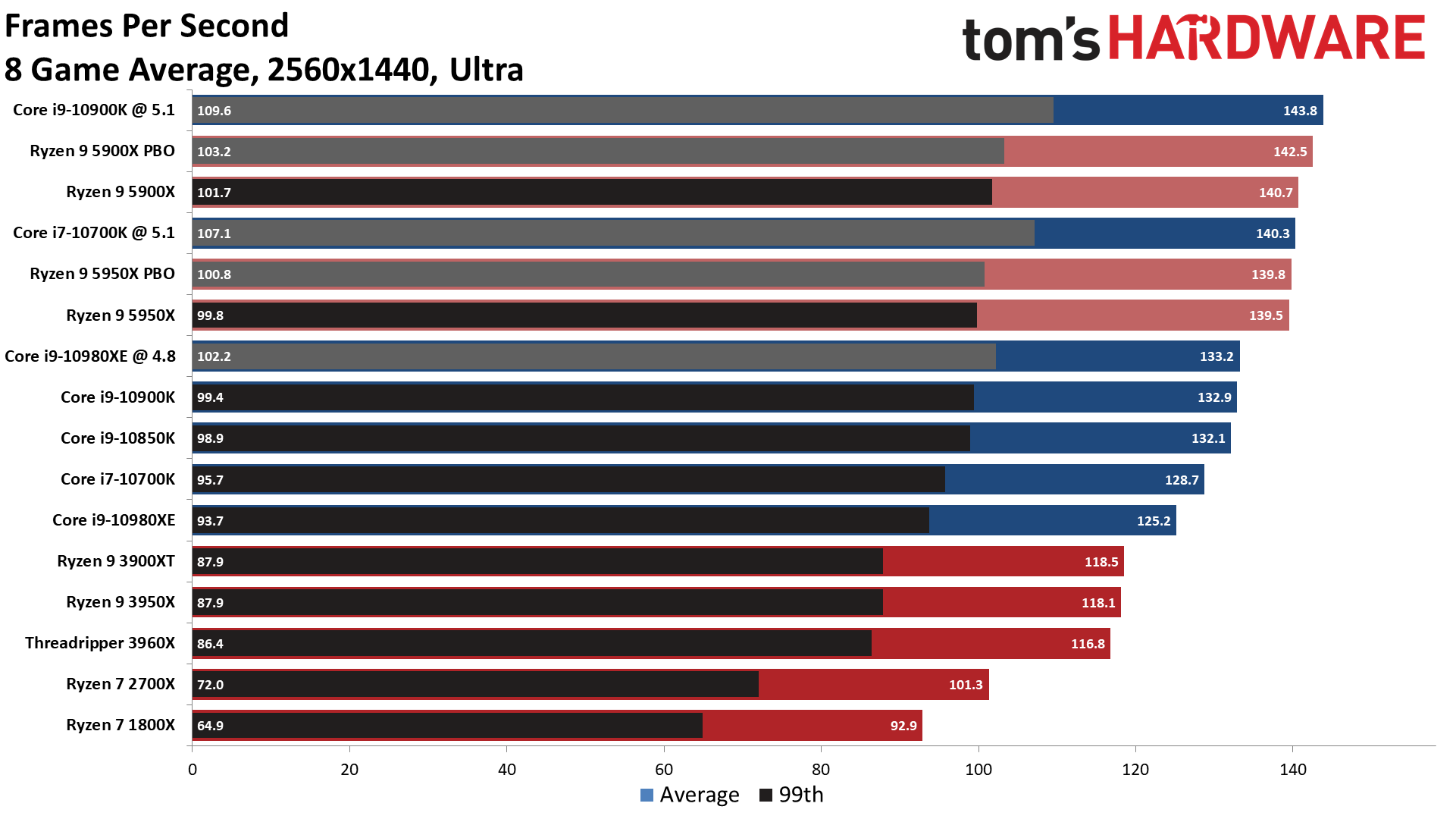
To put things in perspective, take a glance at the delta in 1080p gaming between the previous-gen Ryzen 9 3900XT, which basically runs overclocked right out of the box, compared to the Ryzen 9 5950X. That's a huge generational leap. AMD has made big gains in a single generation.
Flipping over to the 1440p chart improves things a bit for Intel, but only slightly — the overclocked Core i9-10900K returns to its normal spot at the top of the chart, and it still has better 99th percentile frame rates after overclocking. However, AMD still beats Intel in both average and 99th-percentiles at stock settings, cementing the company's lead.
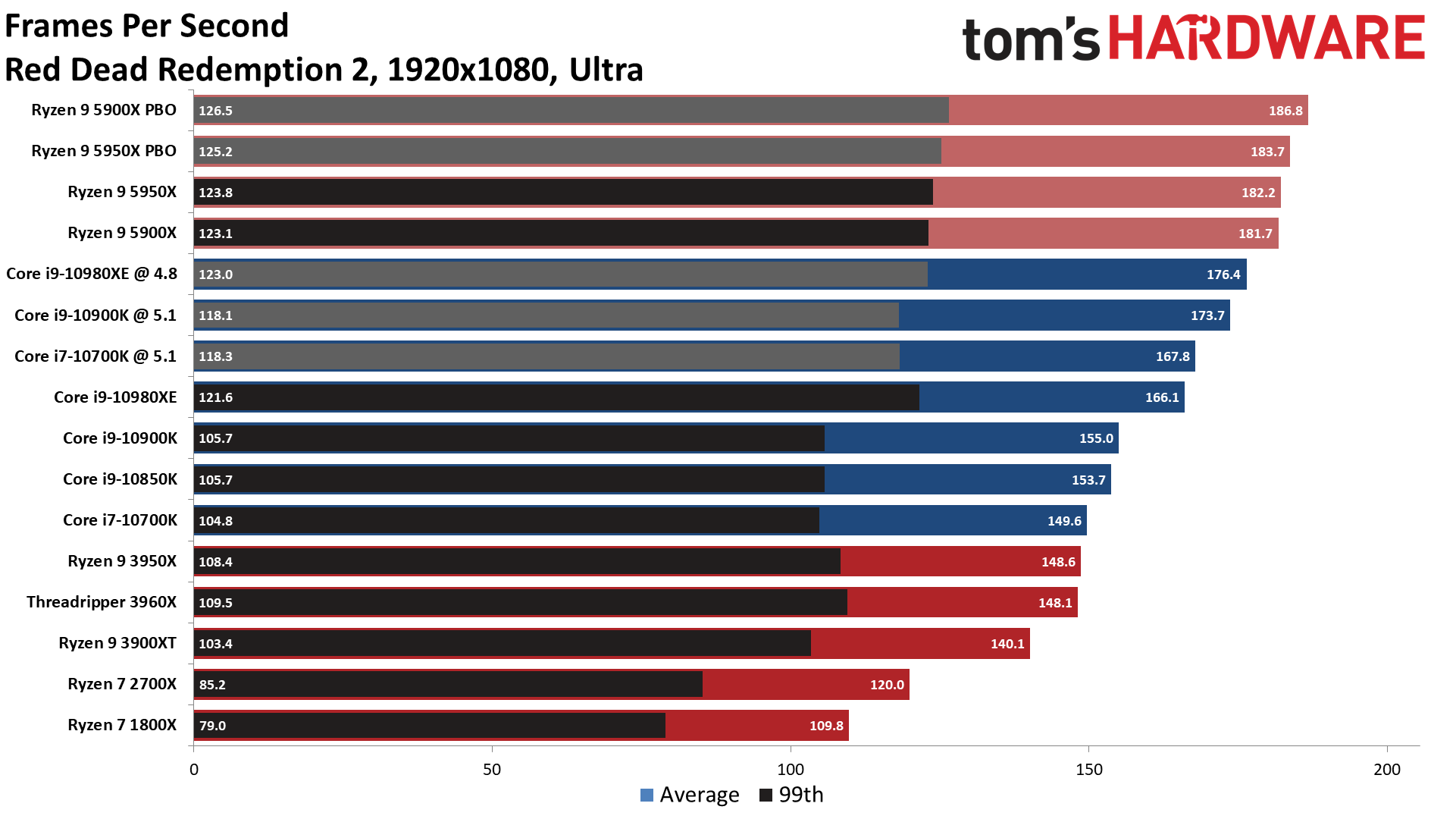
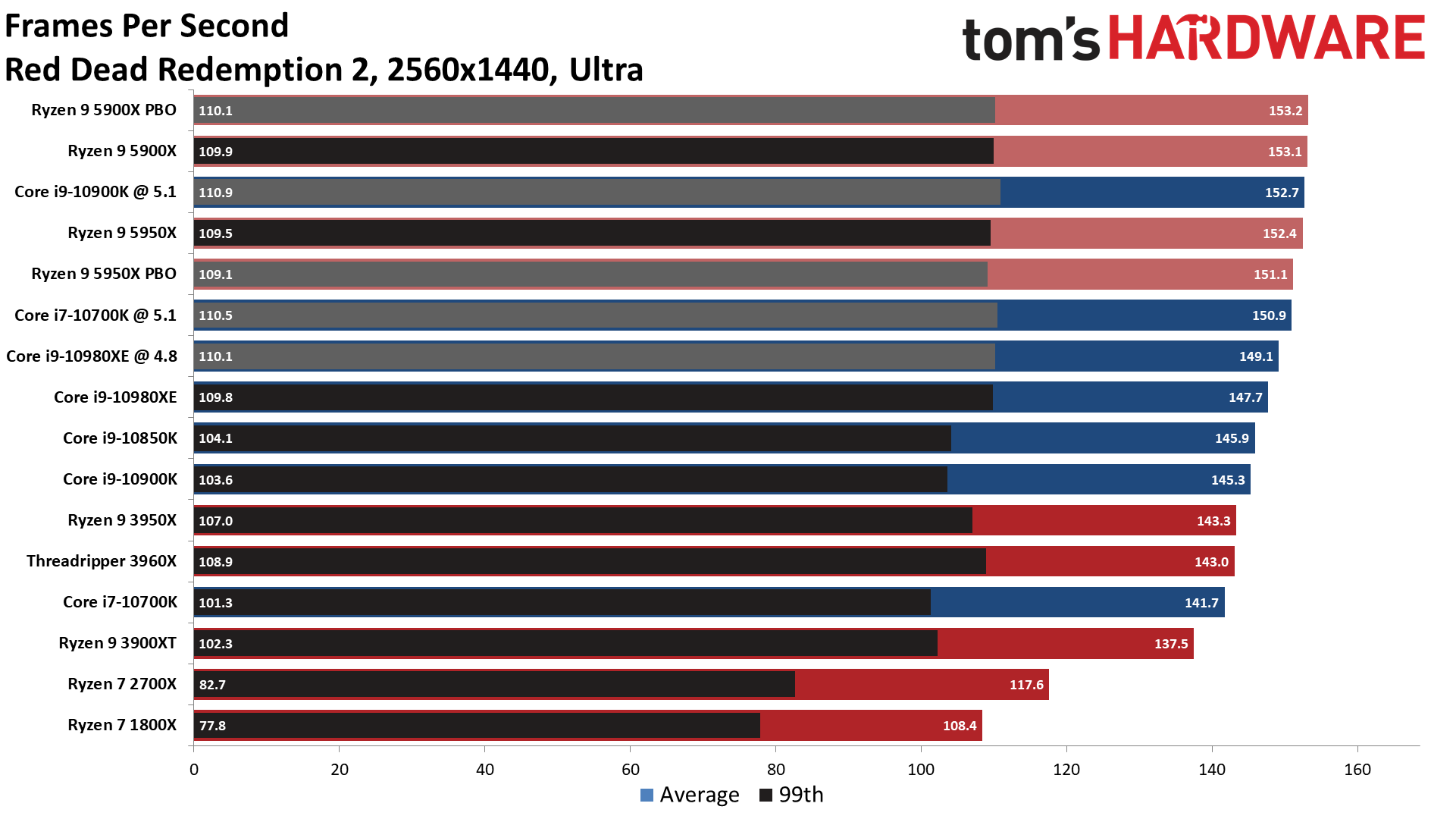
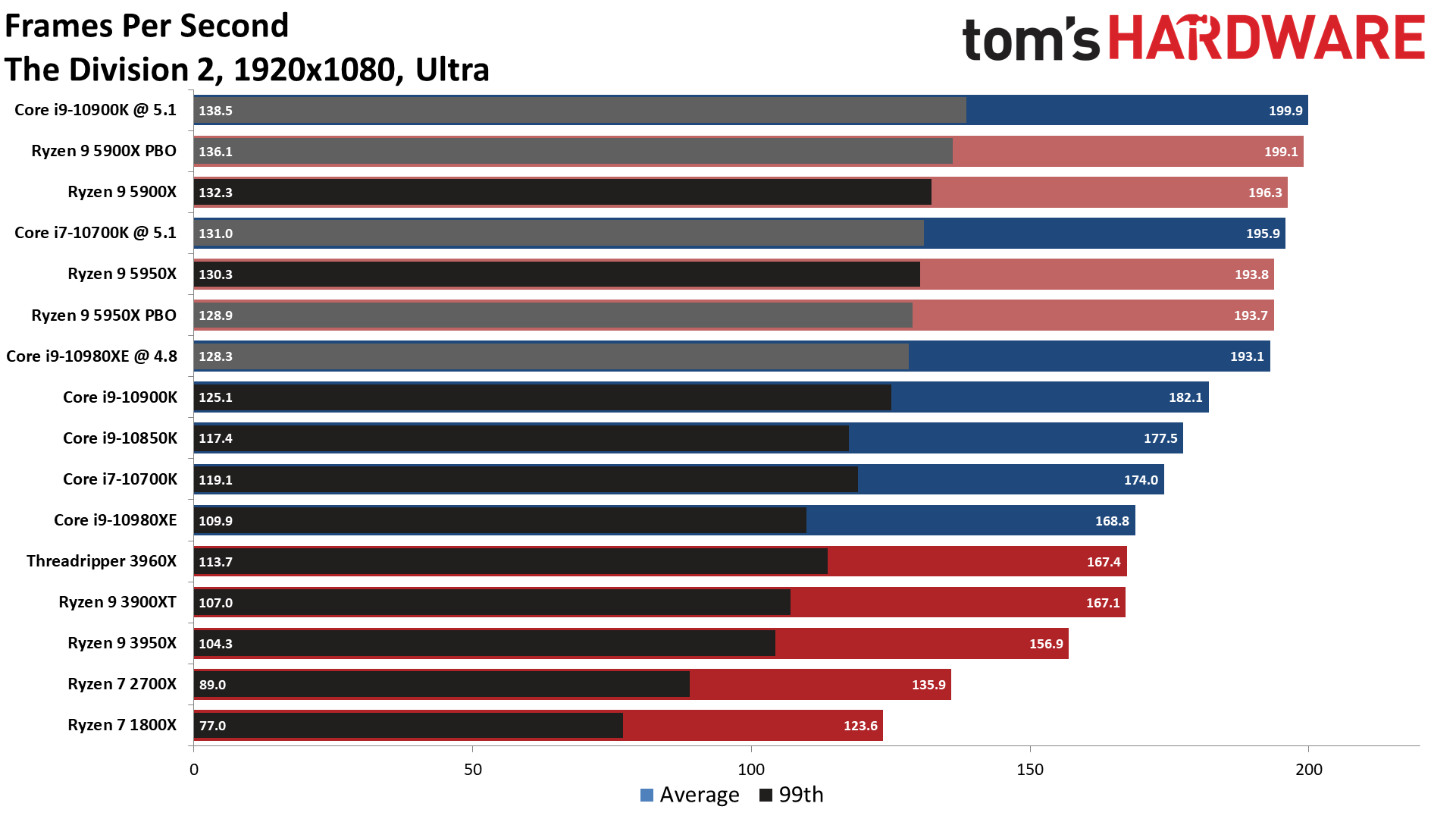
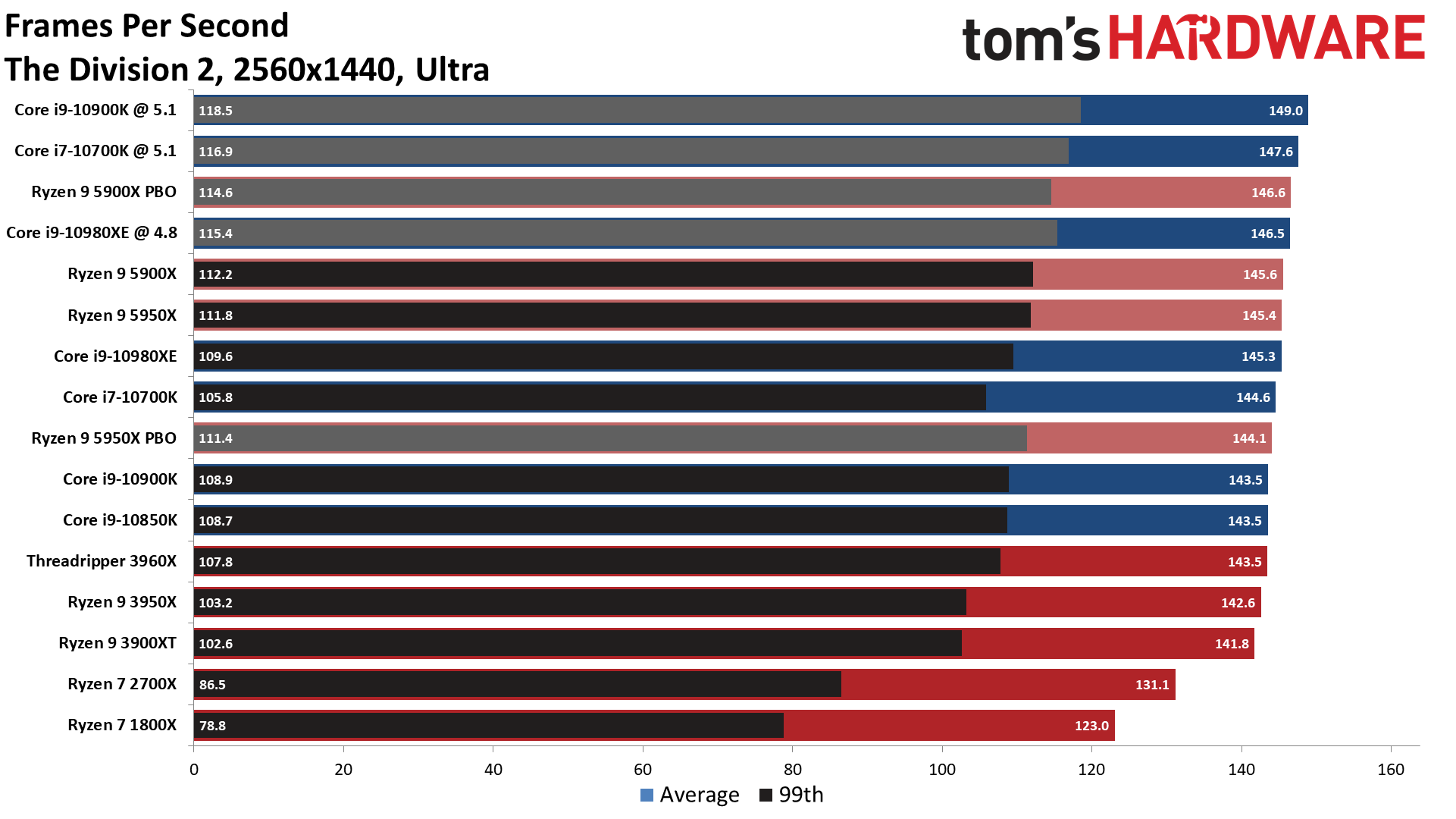
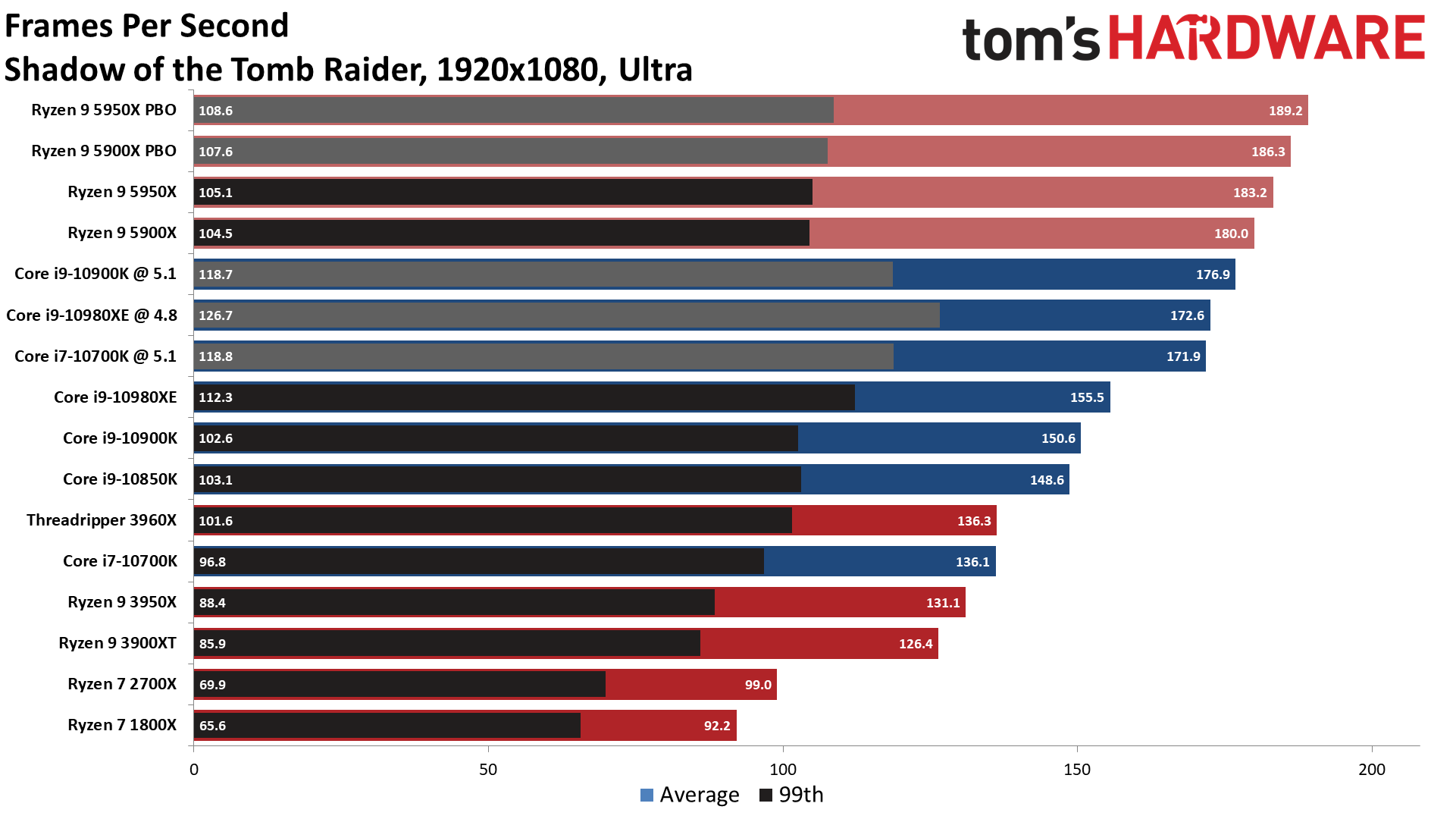
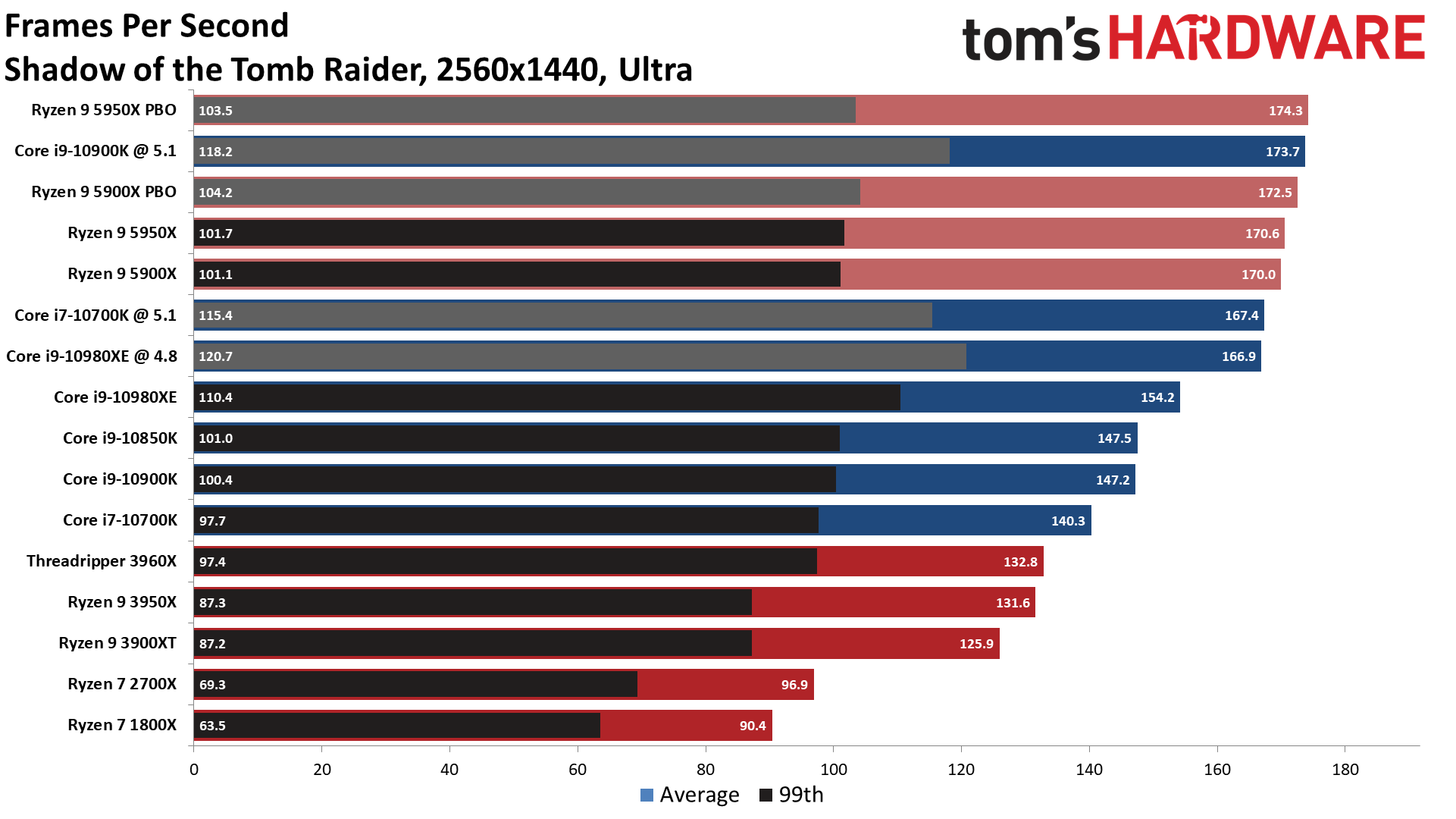
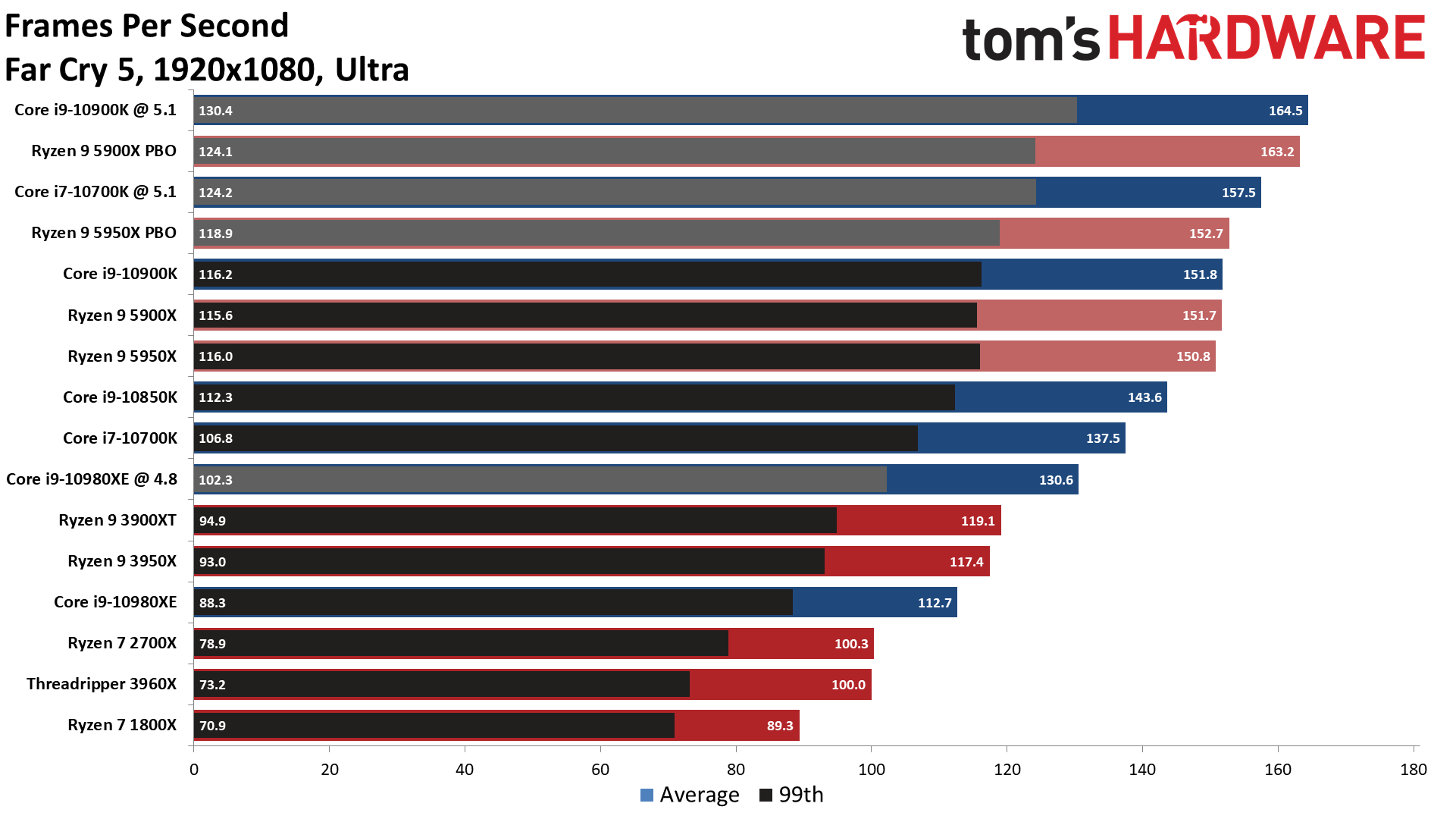
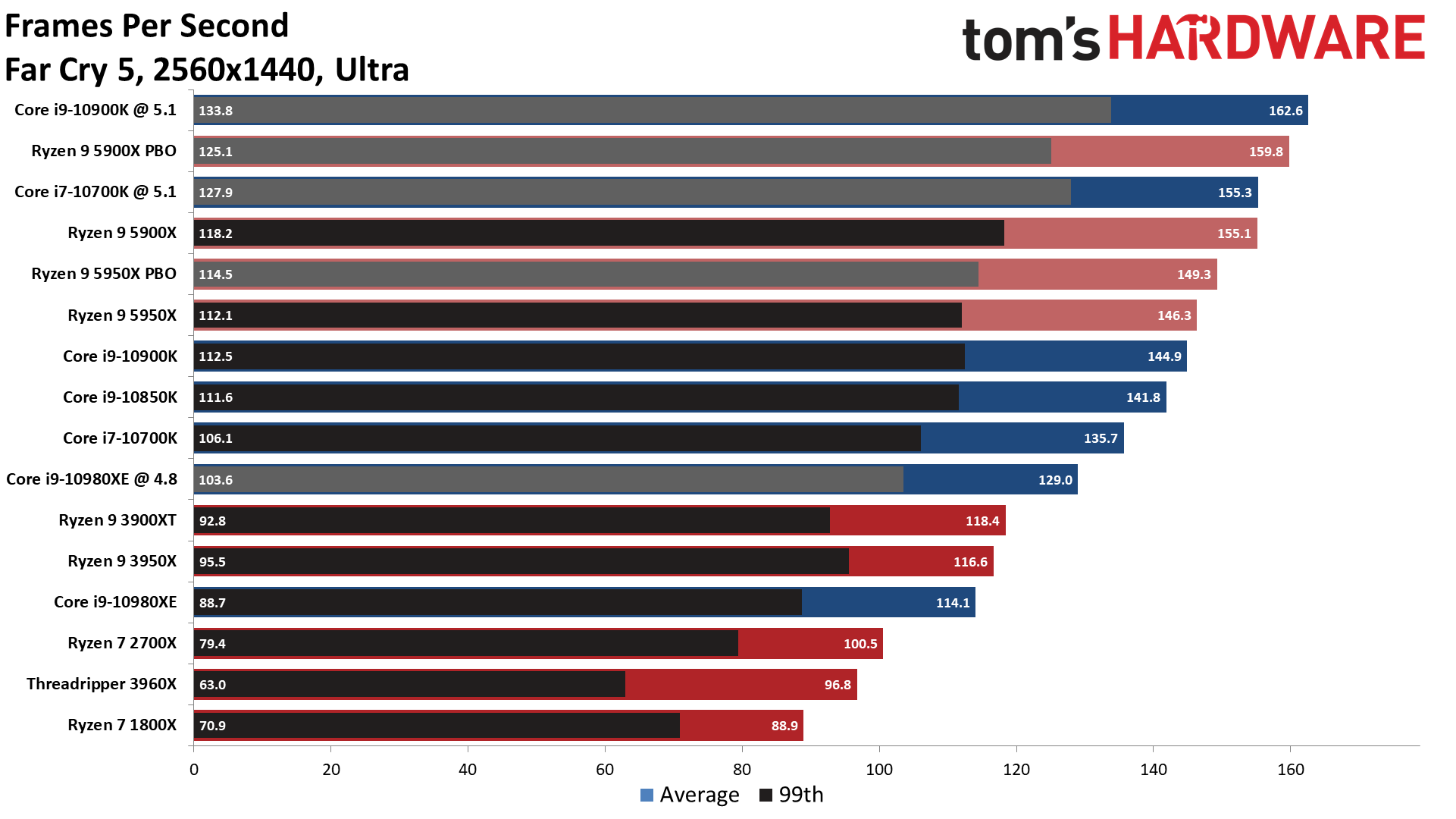
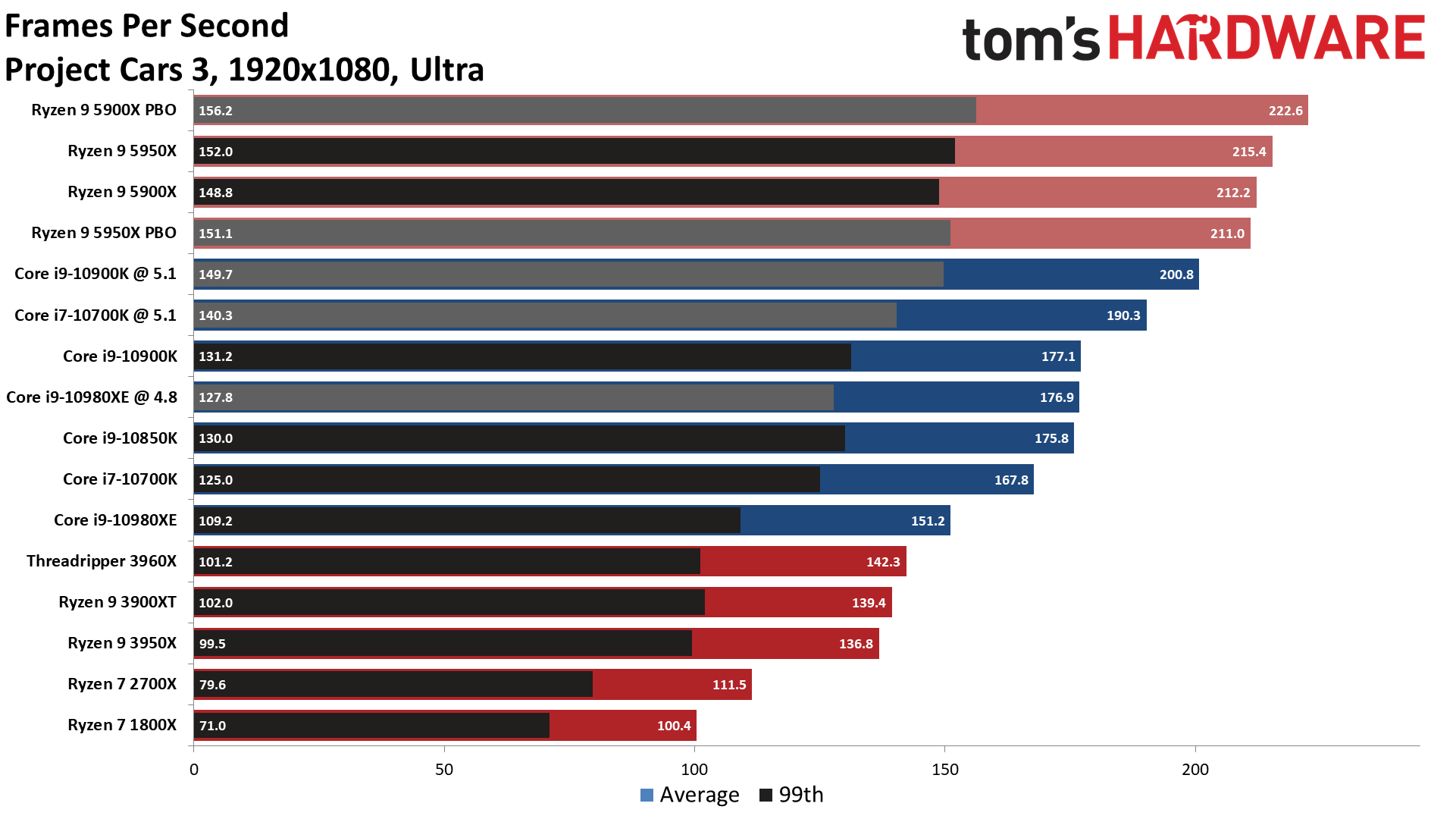
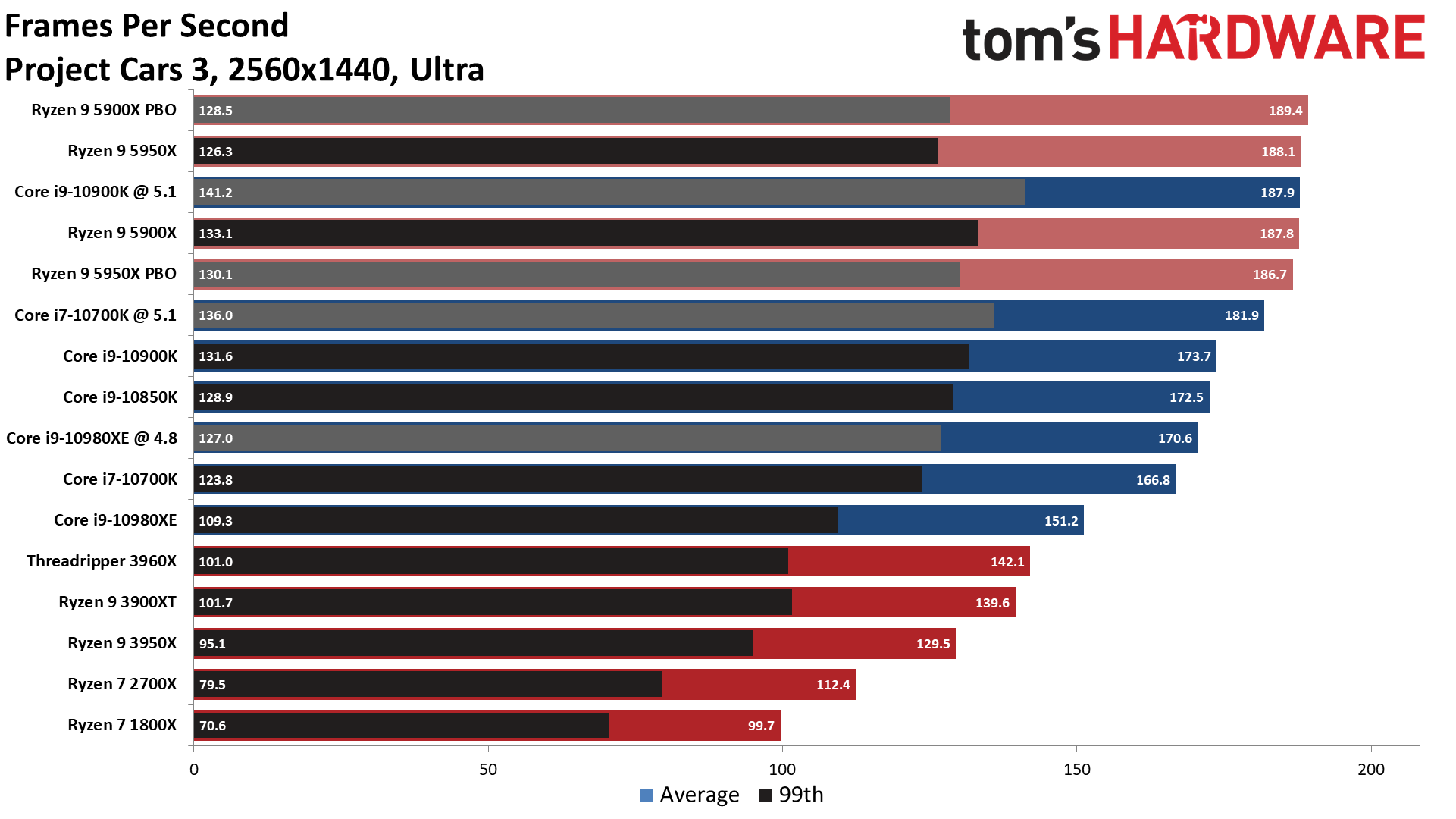
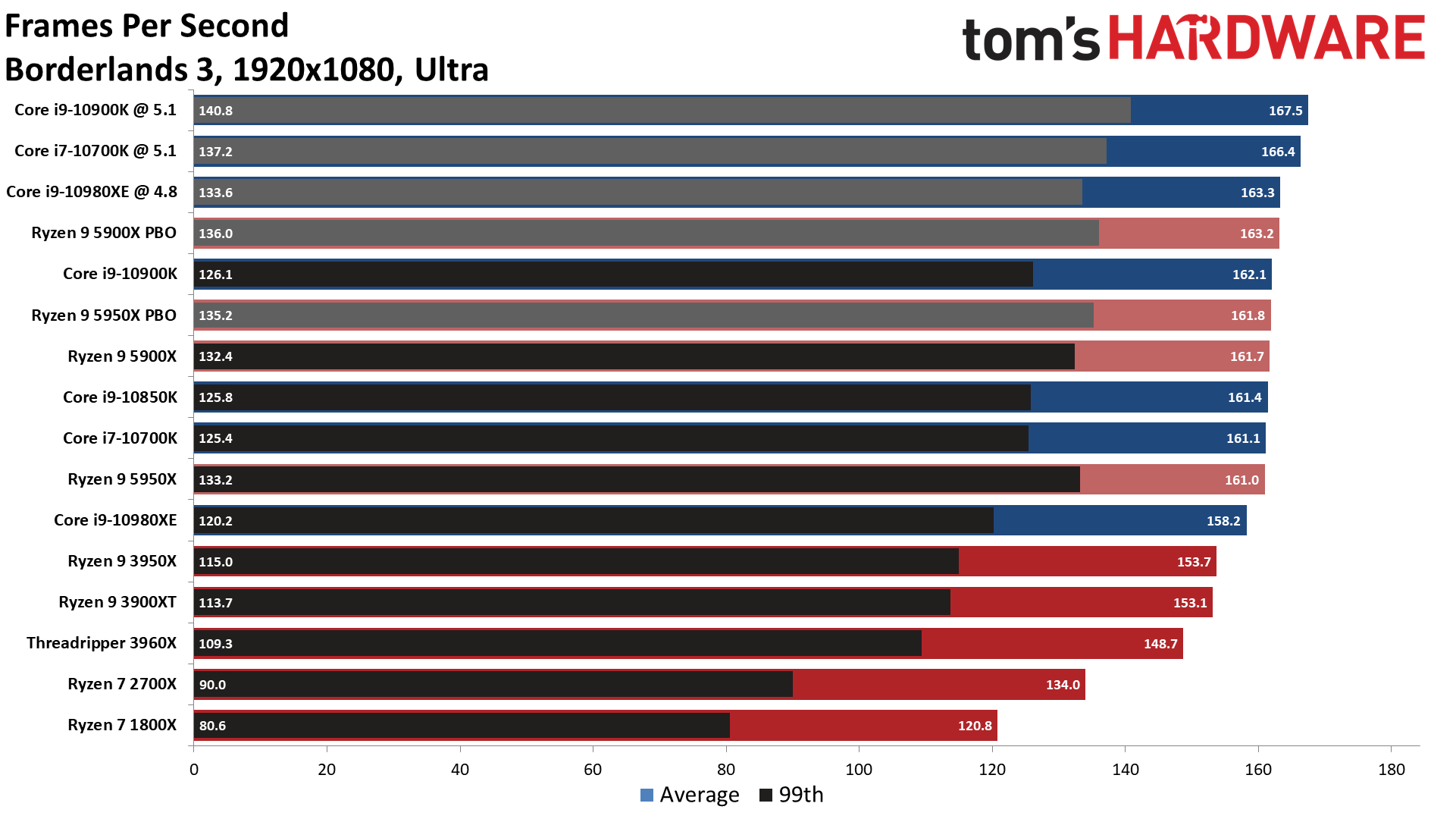
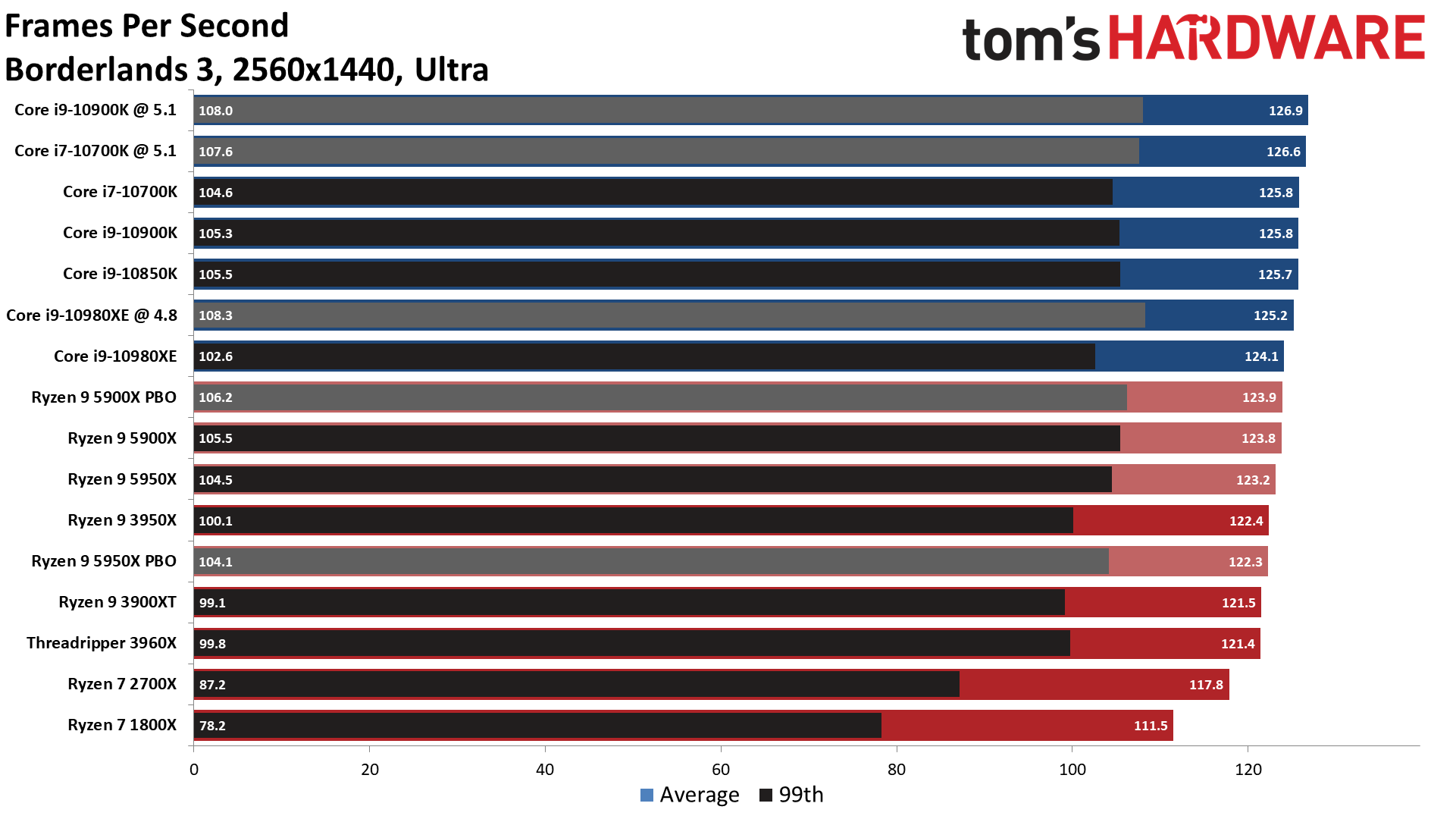
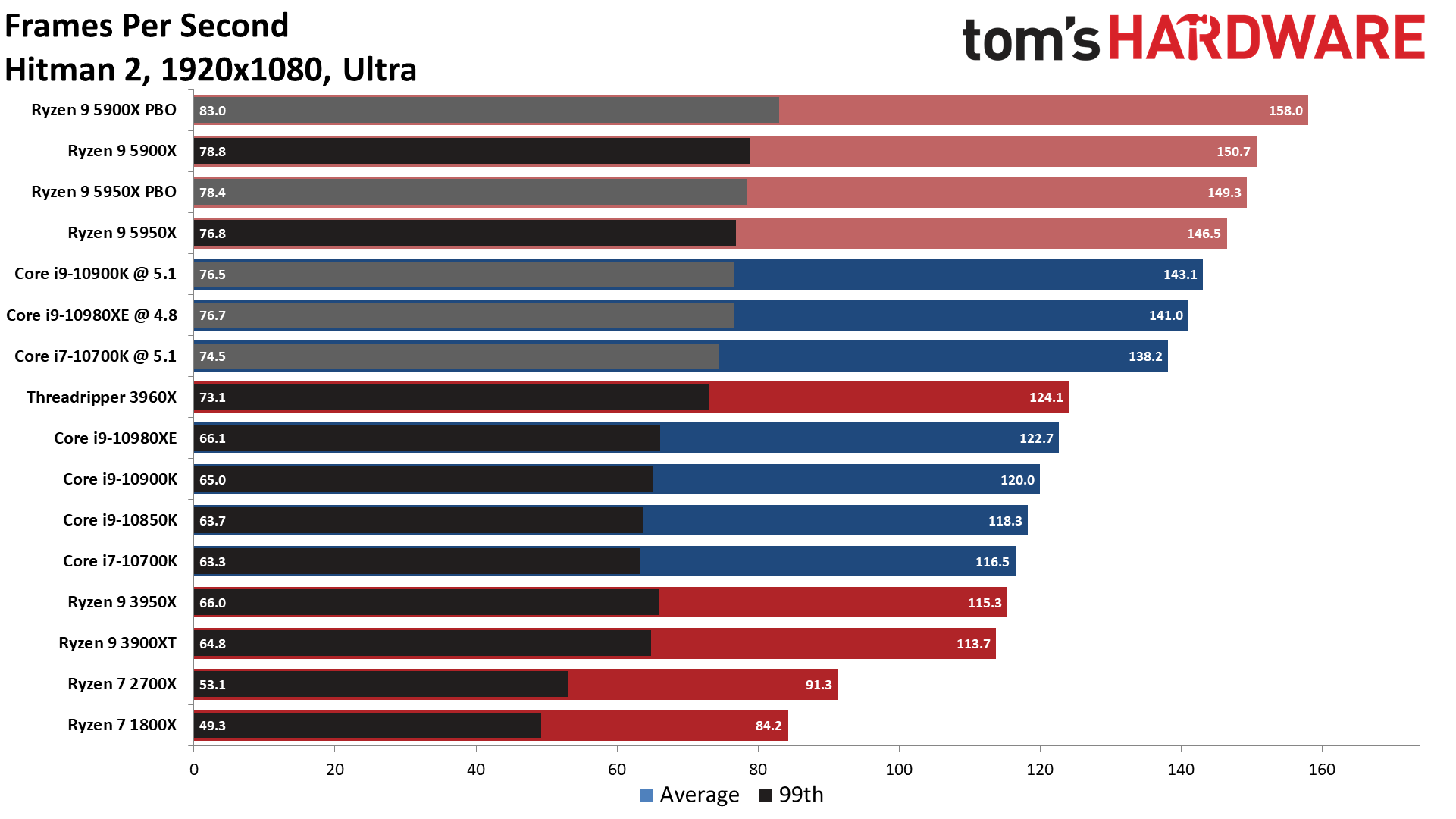
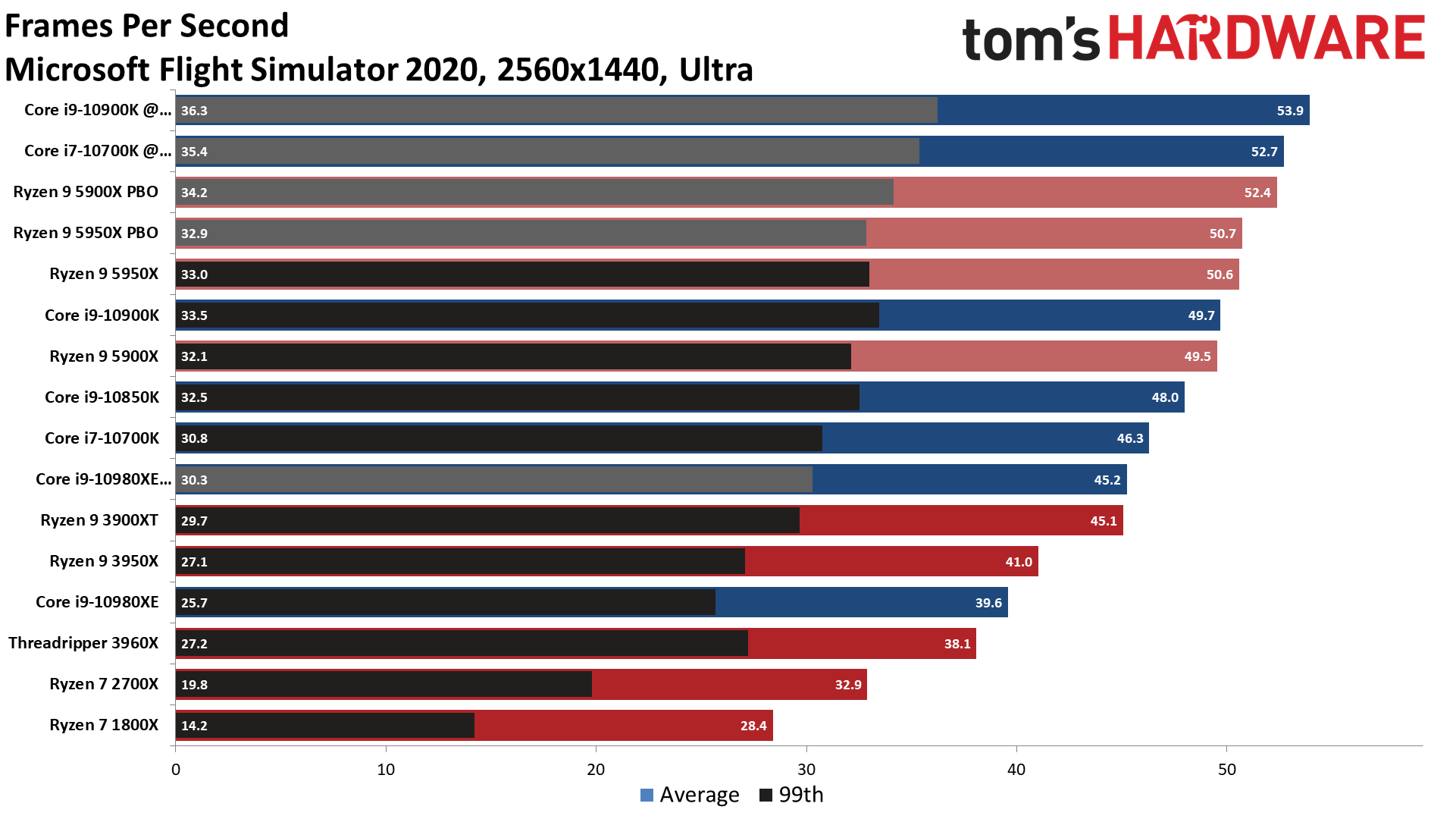
Here are the individual results of our Ryzen 9 5950X and Ryzen 9 5900X real-world game benchmarks at both 1080p and 1440p resolutions. For further analysis of each title, and to see our synthetic gaming benchmarks, head to our review.
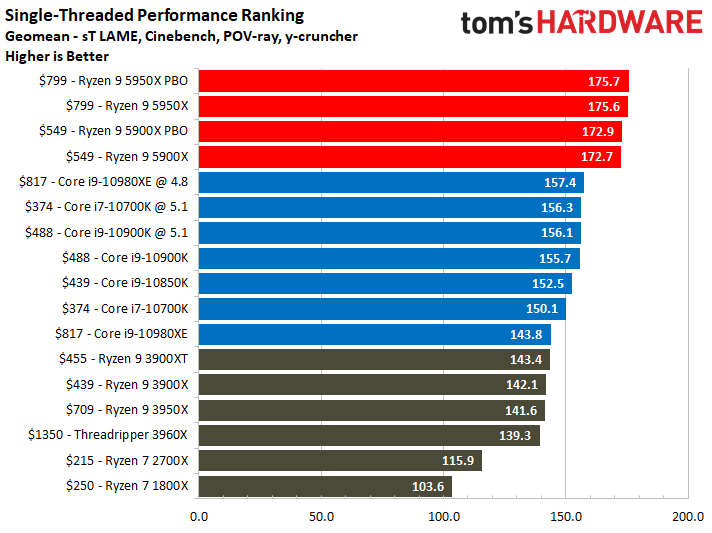
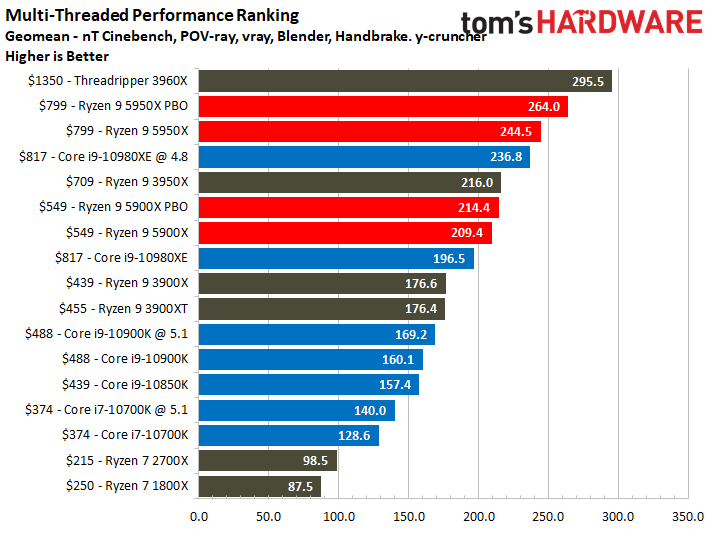
These measurements include the geometric mean of both the most important lightly- and heavily-threaded tests in our application suite, which gives us a broad sense of overall performance. We're quite accustomed to AMD's chips leading in the multi-threaded rankings while trailing, sometimes by a big amount, in the single-threaded performance ranking. Zen 3 changes that entirely and easily leads both rankings. This is the underpinnings of the solid performance we see in nearly every workload we throw at the Ryzen 5000 series CPUs.
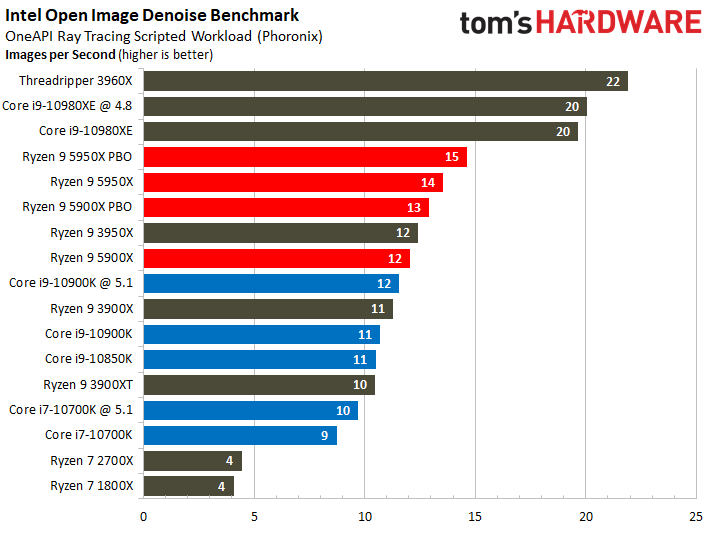
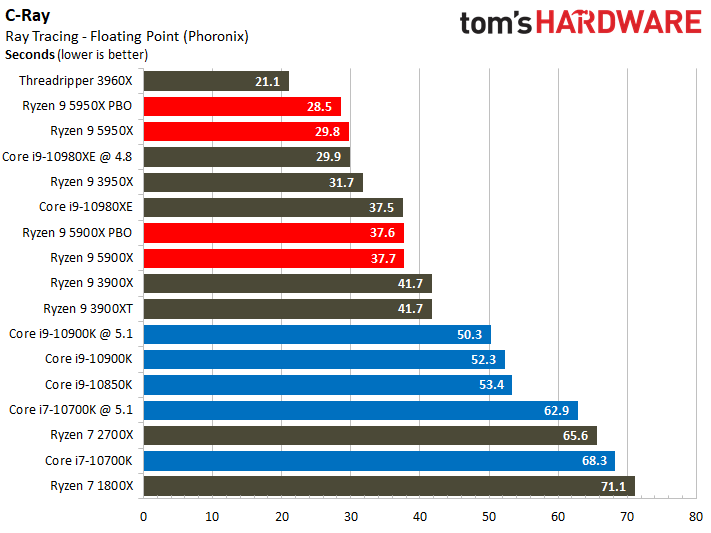
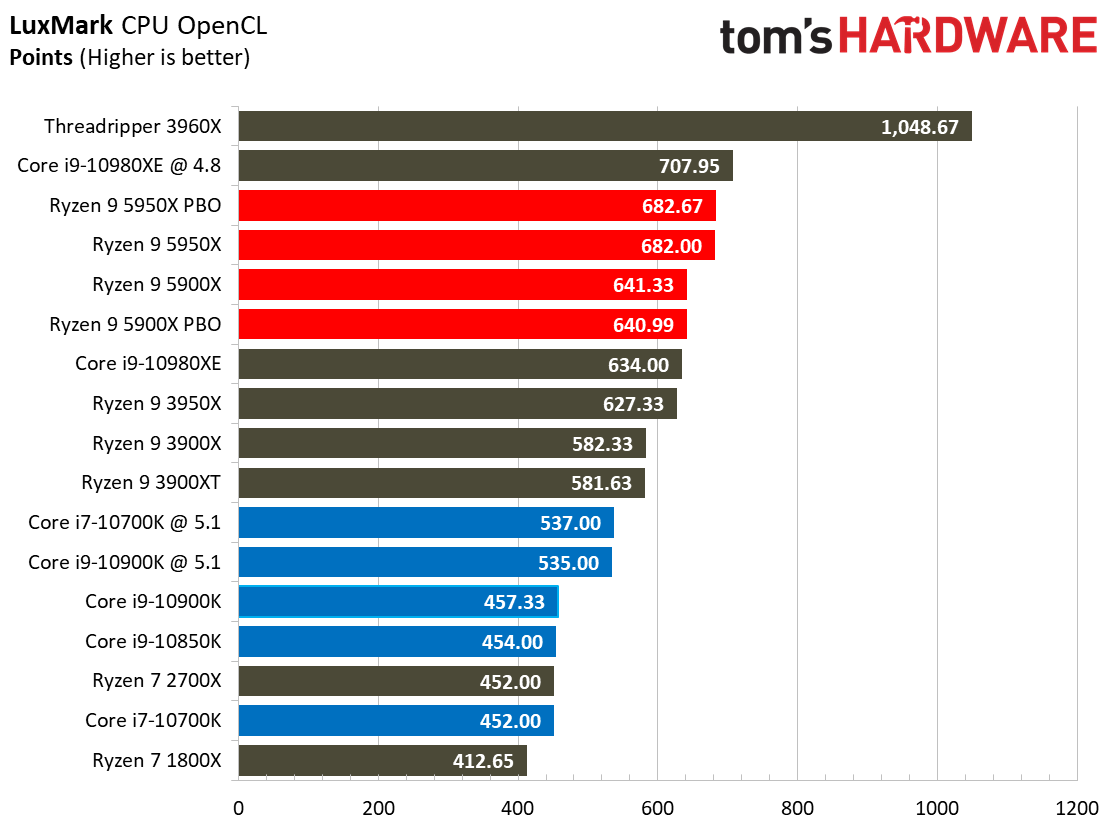
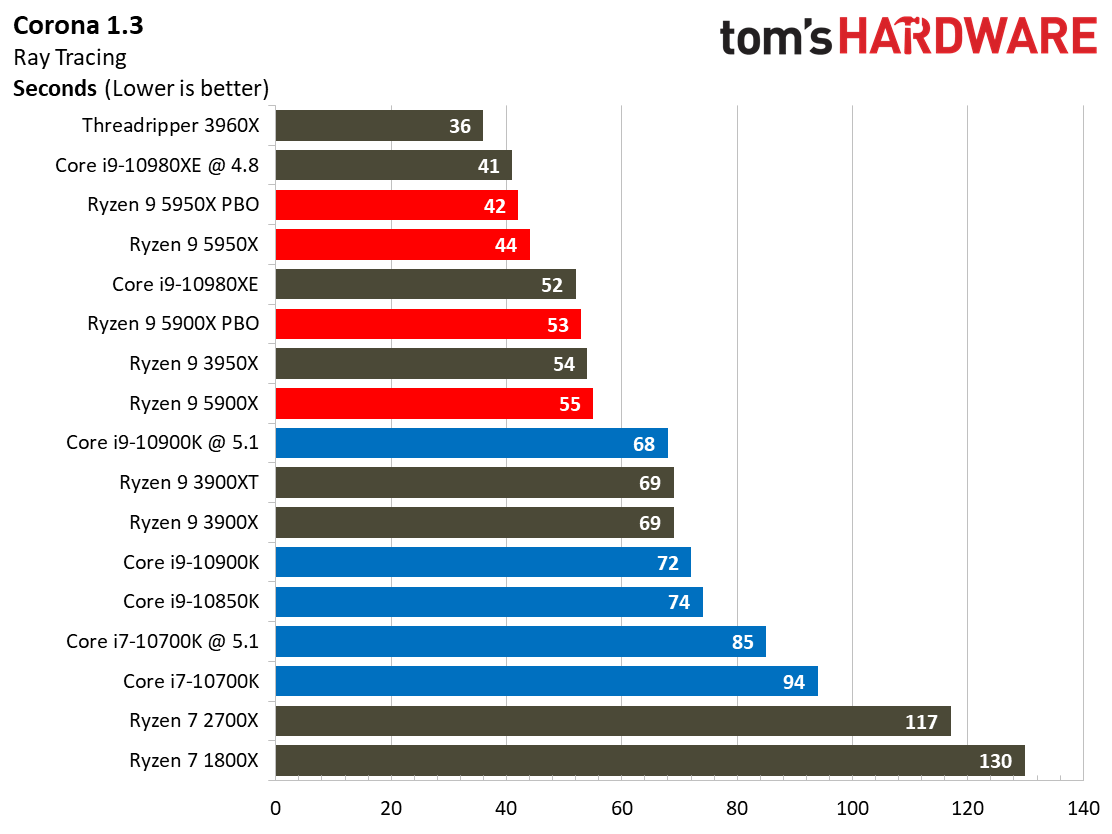
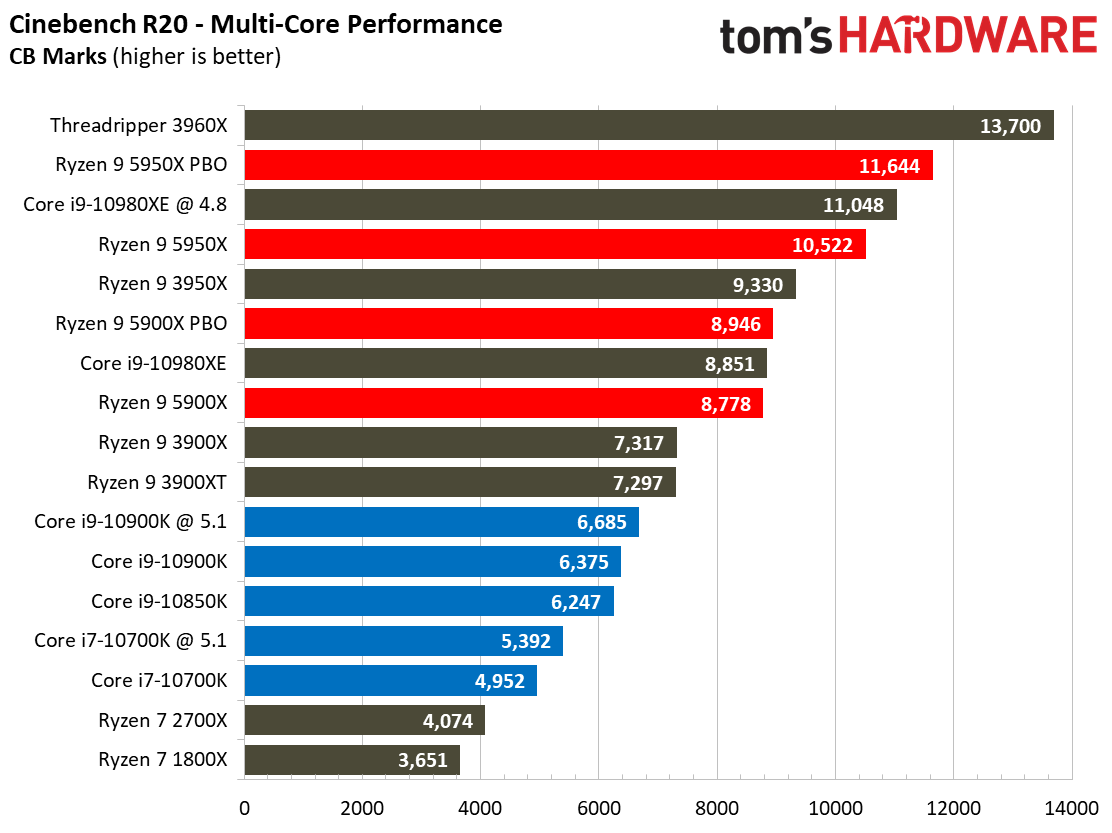
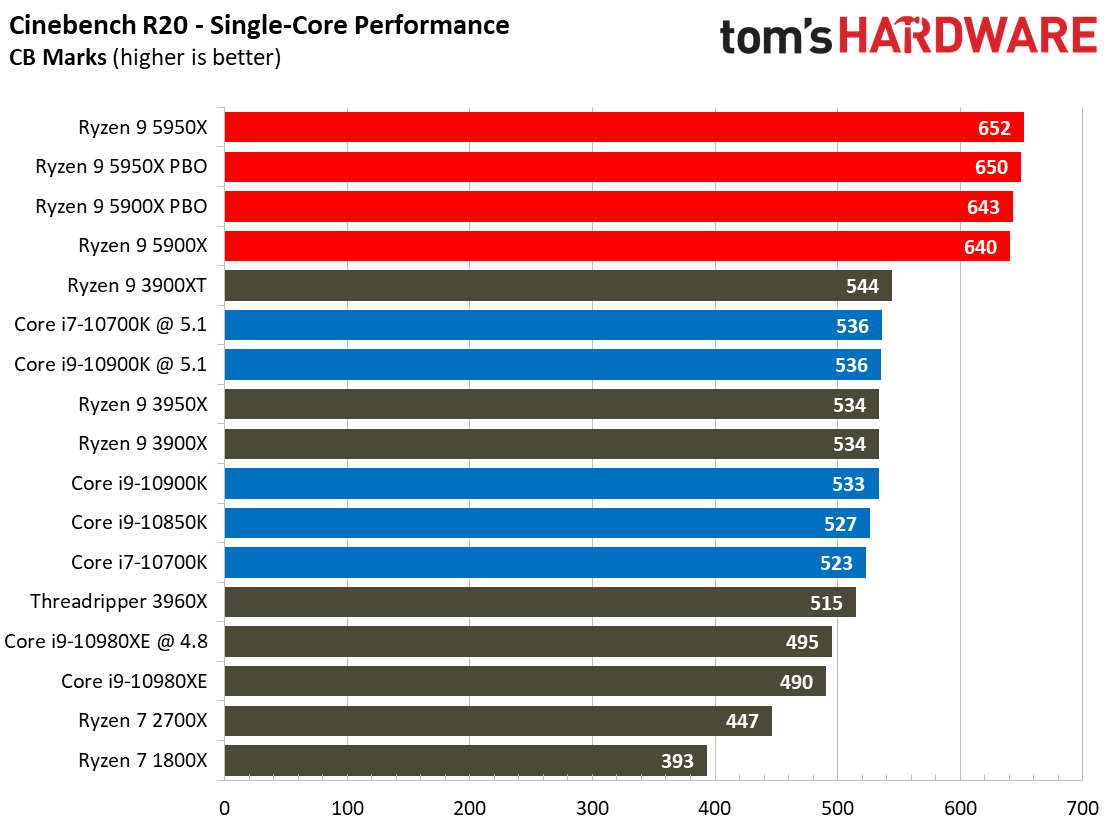
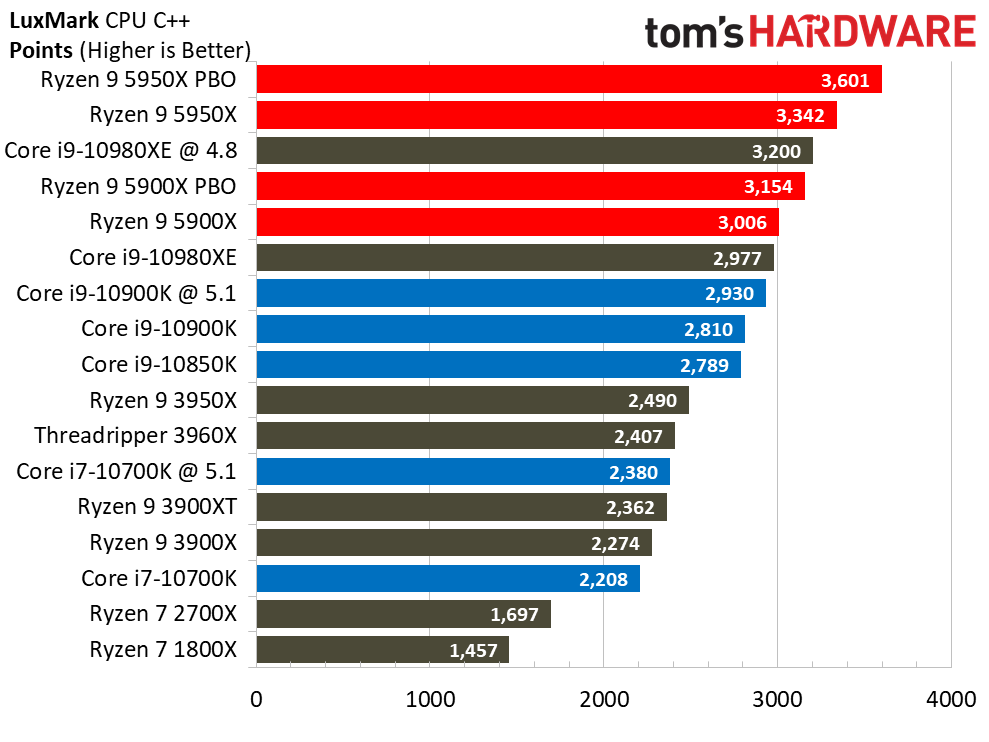
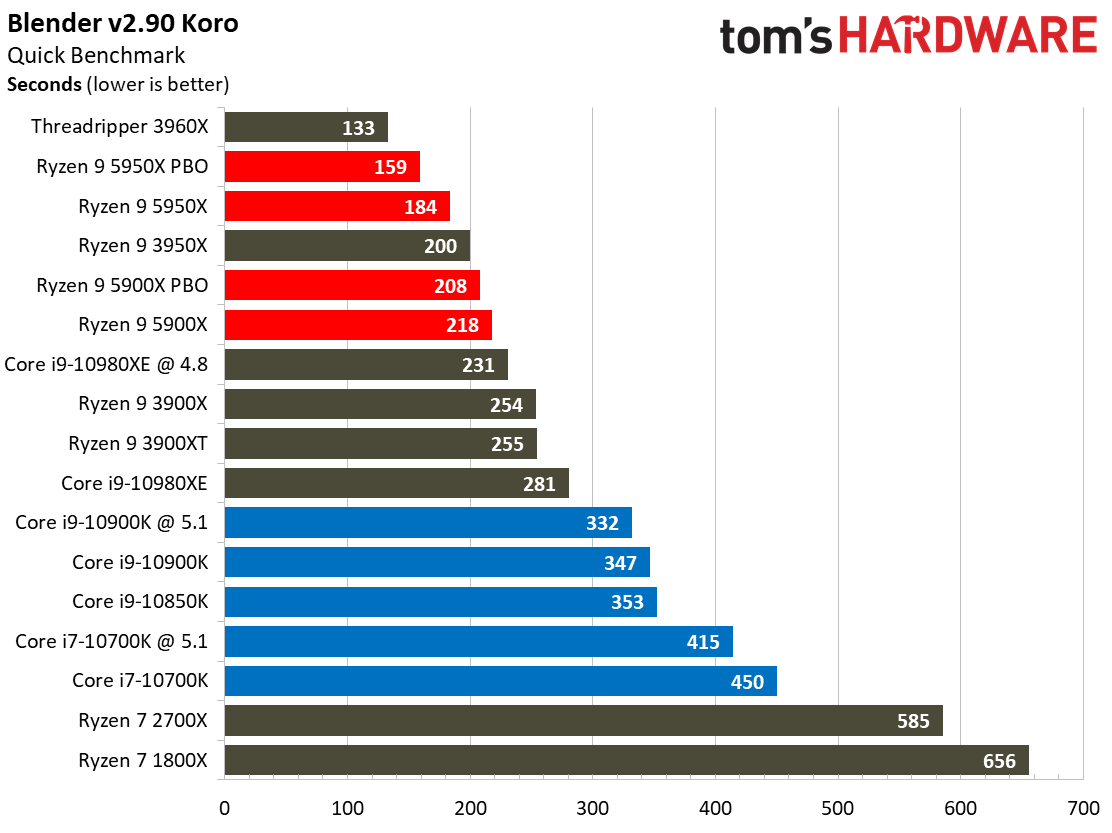
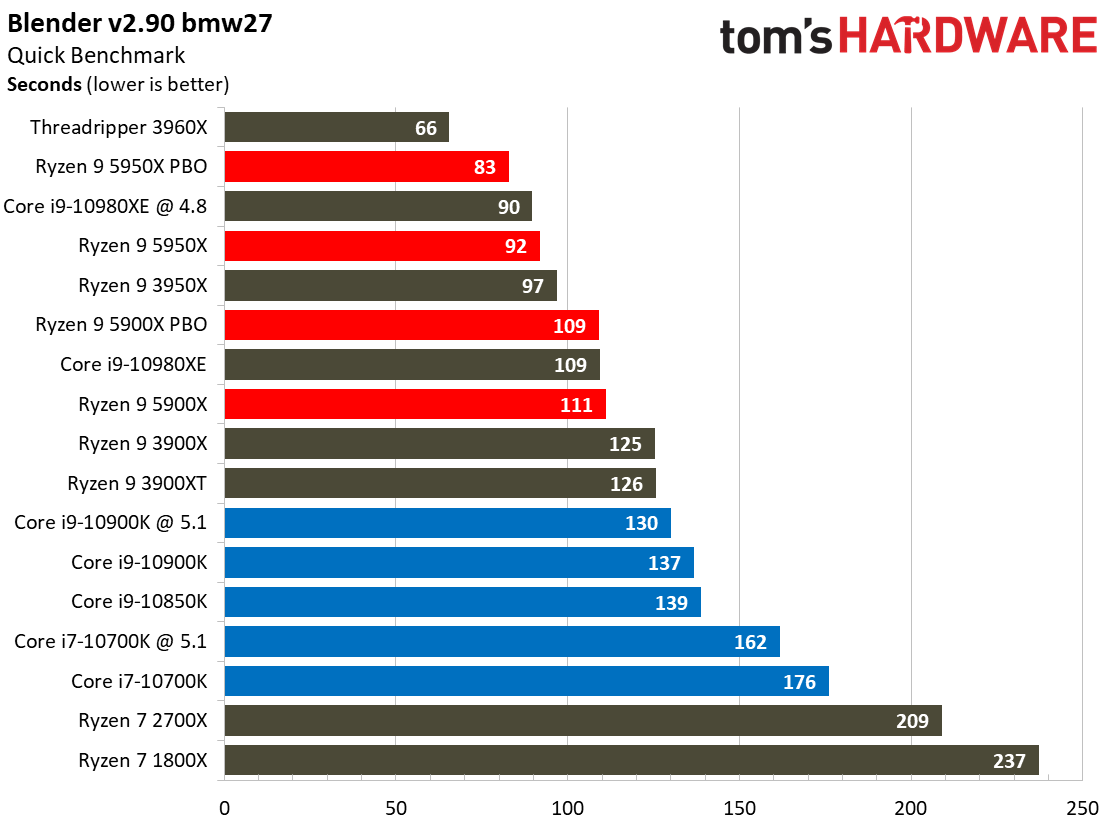
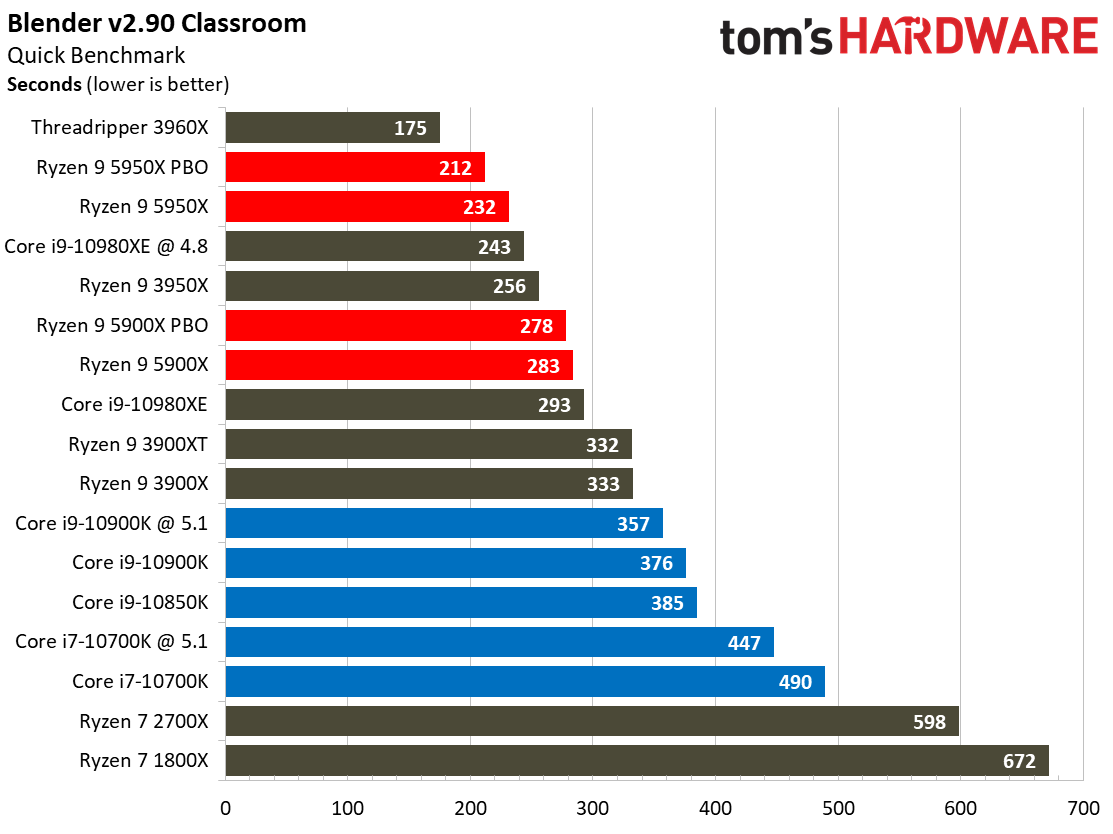
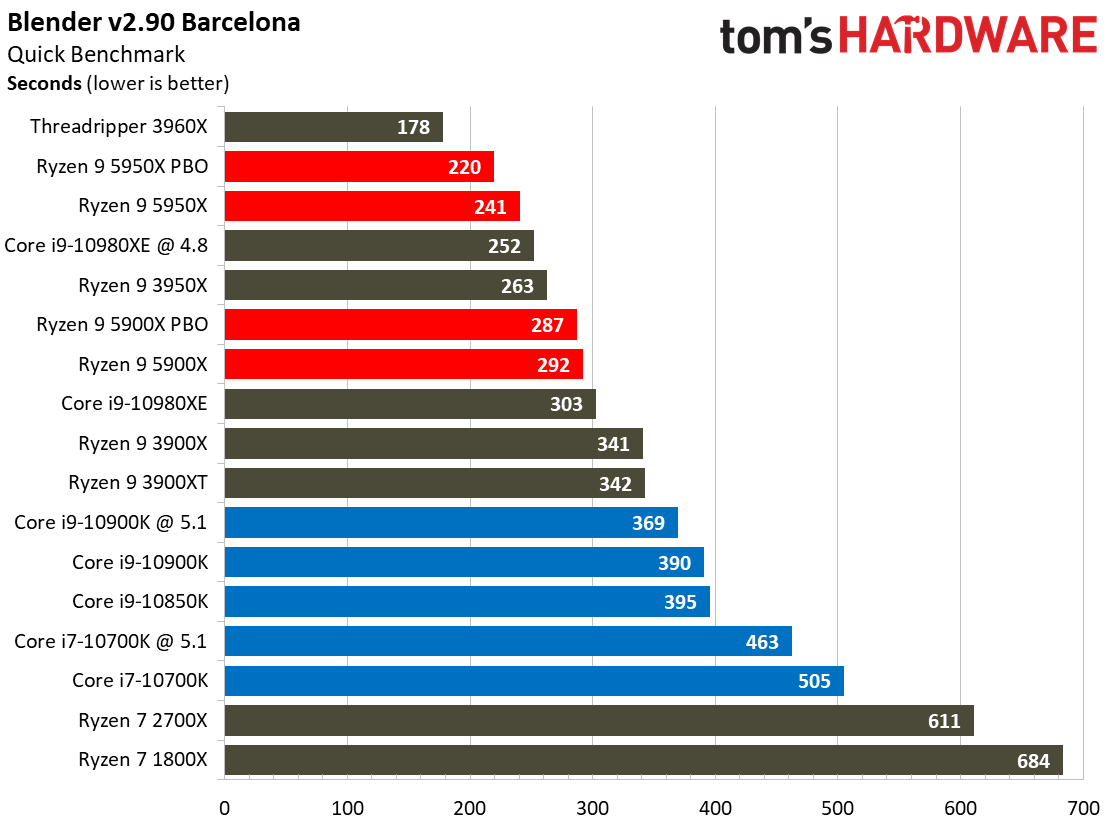
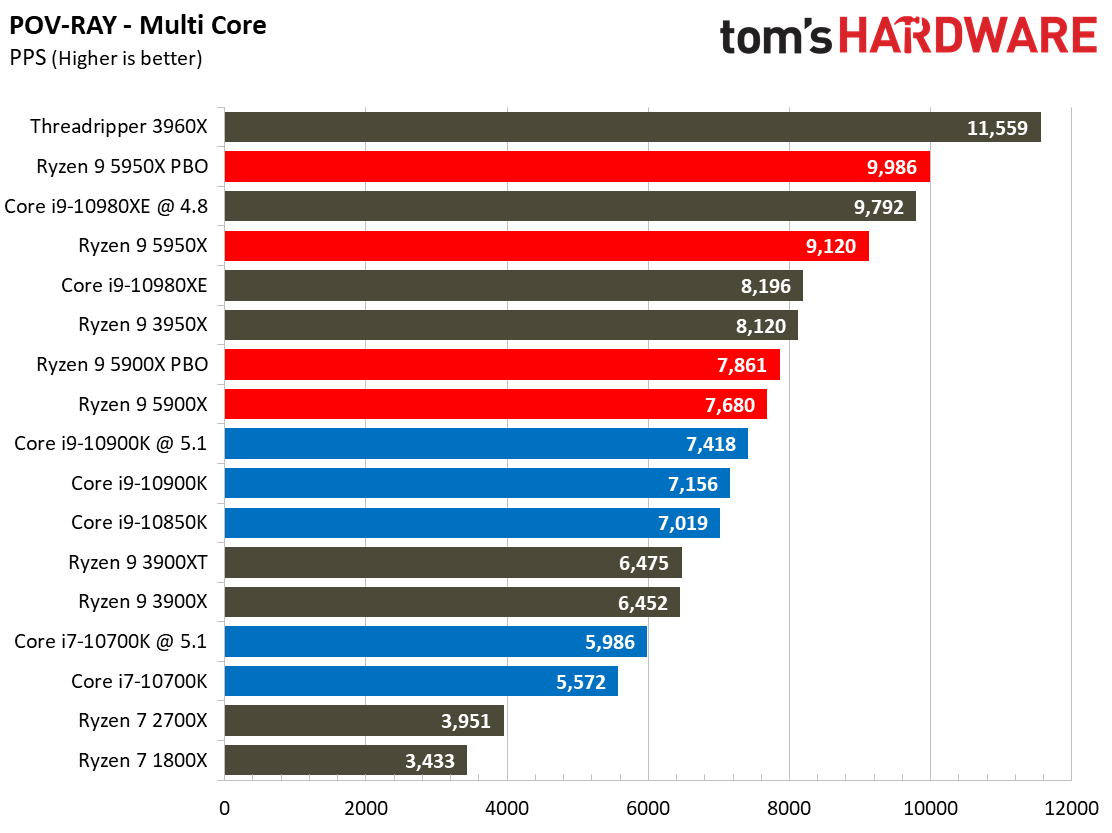
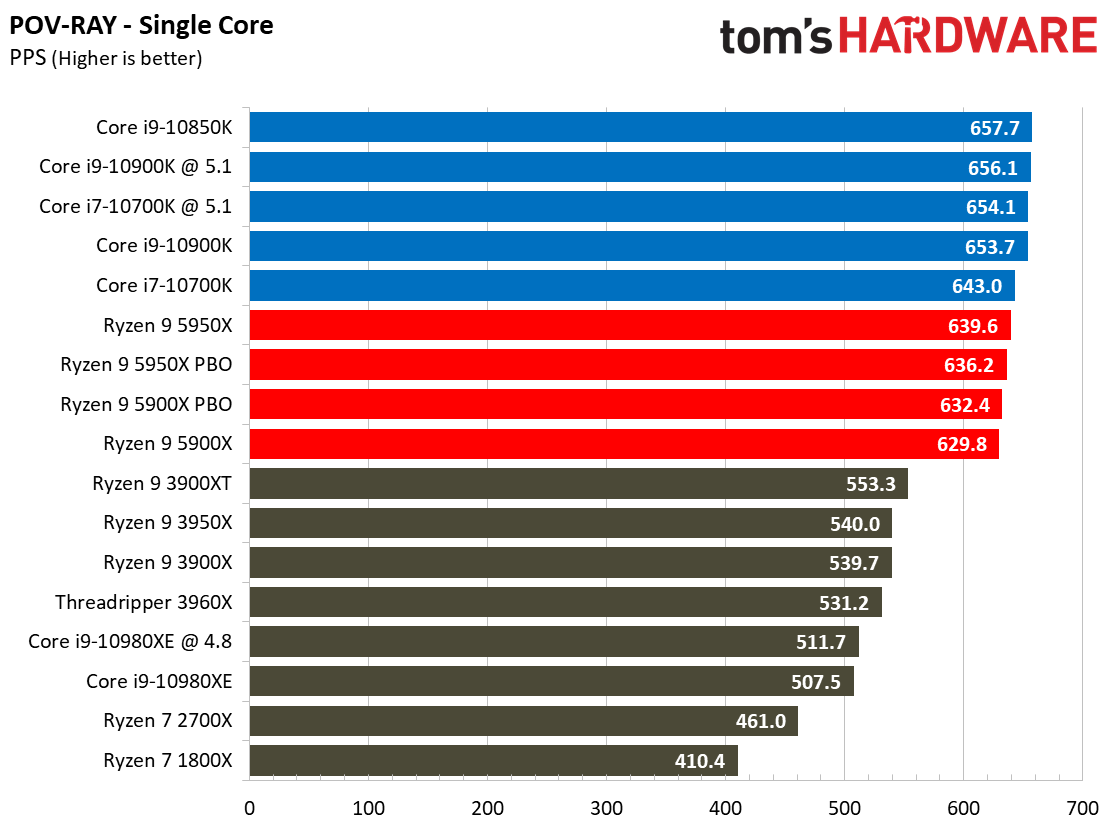
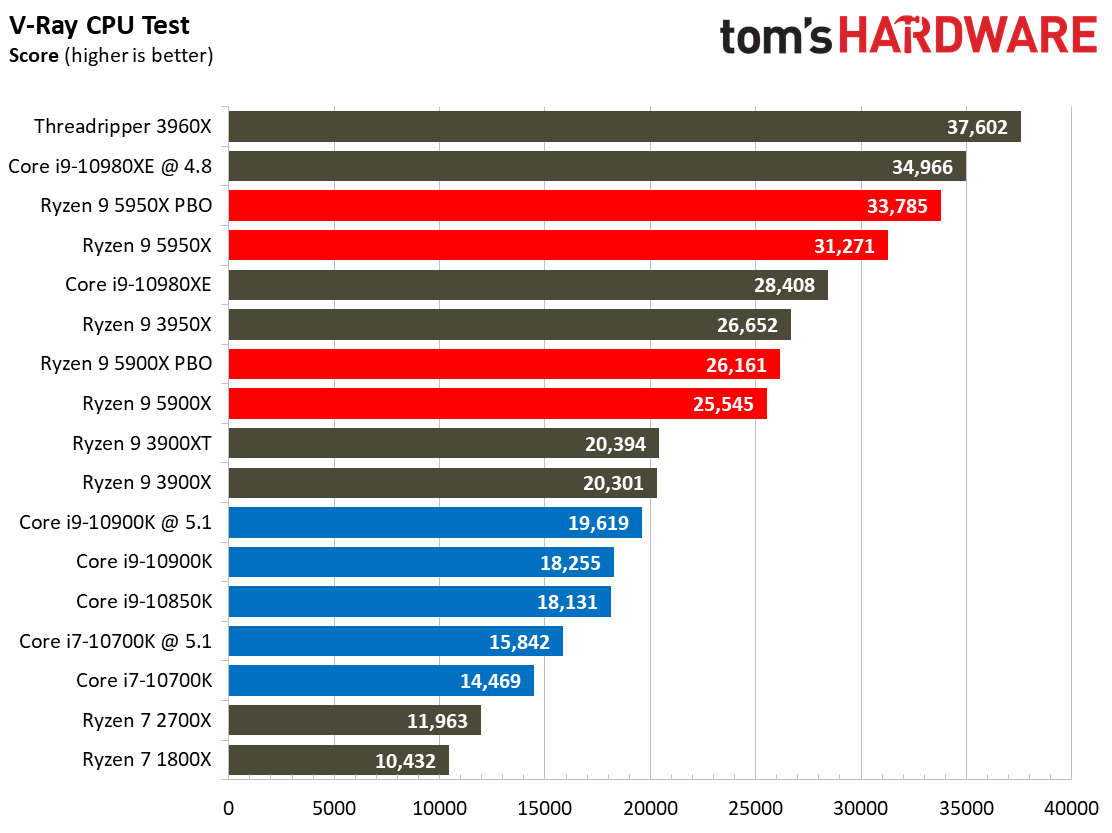
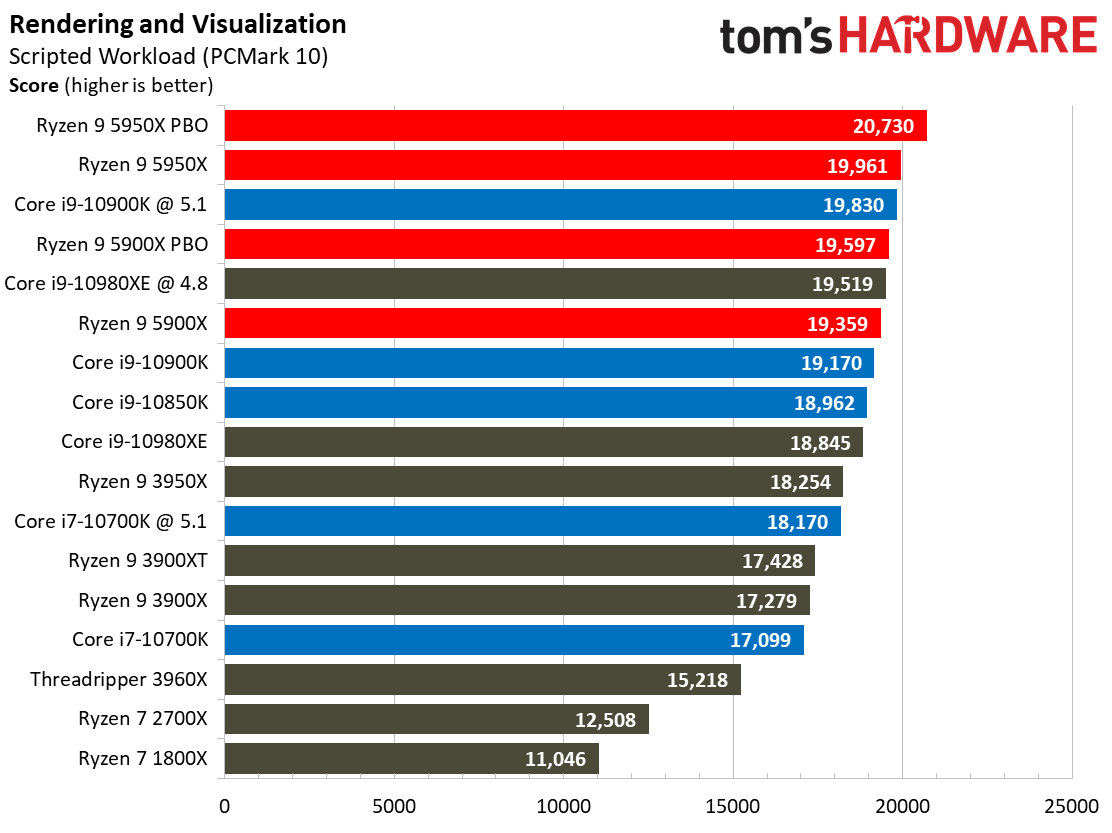
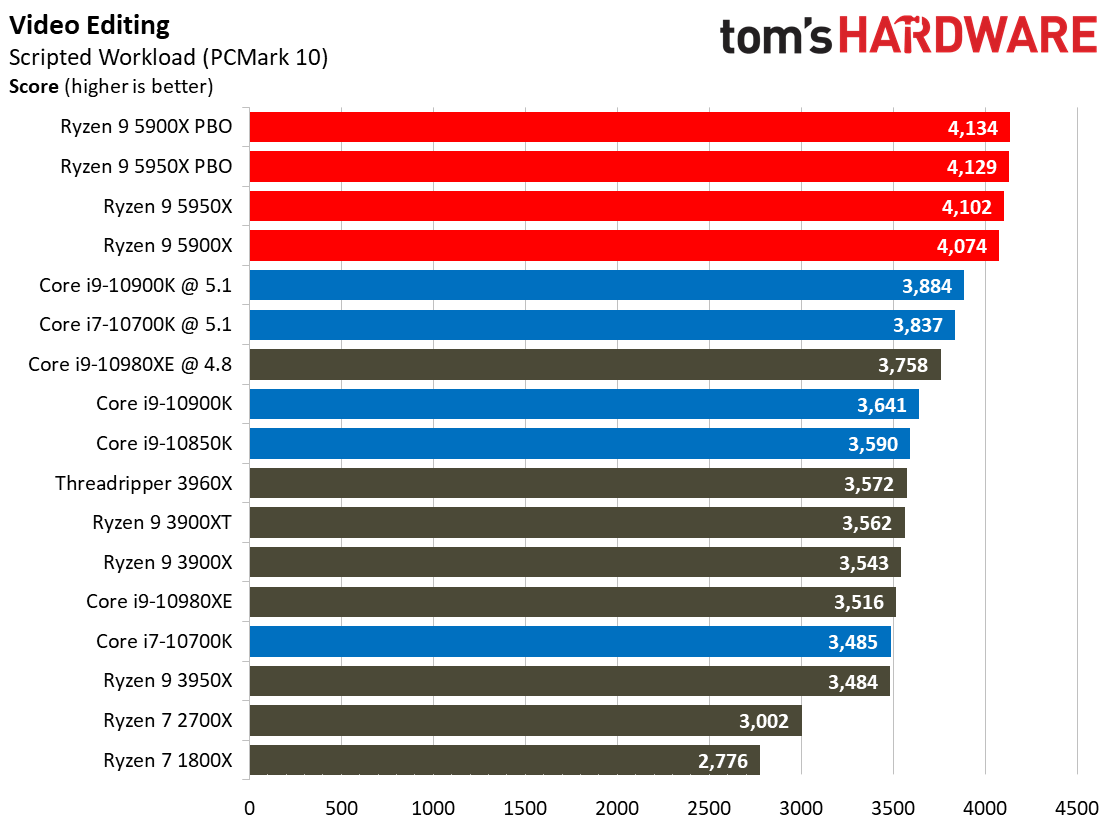
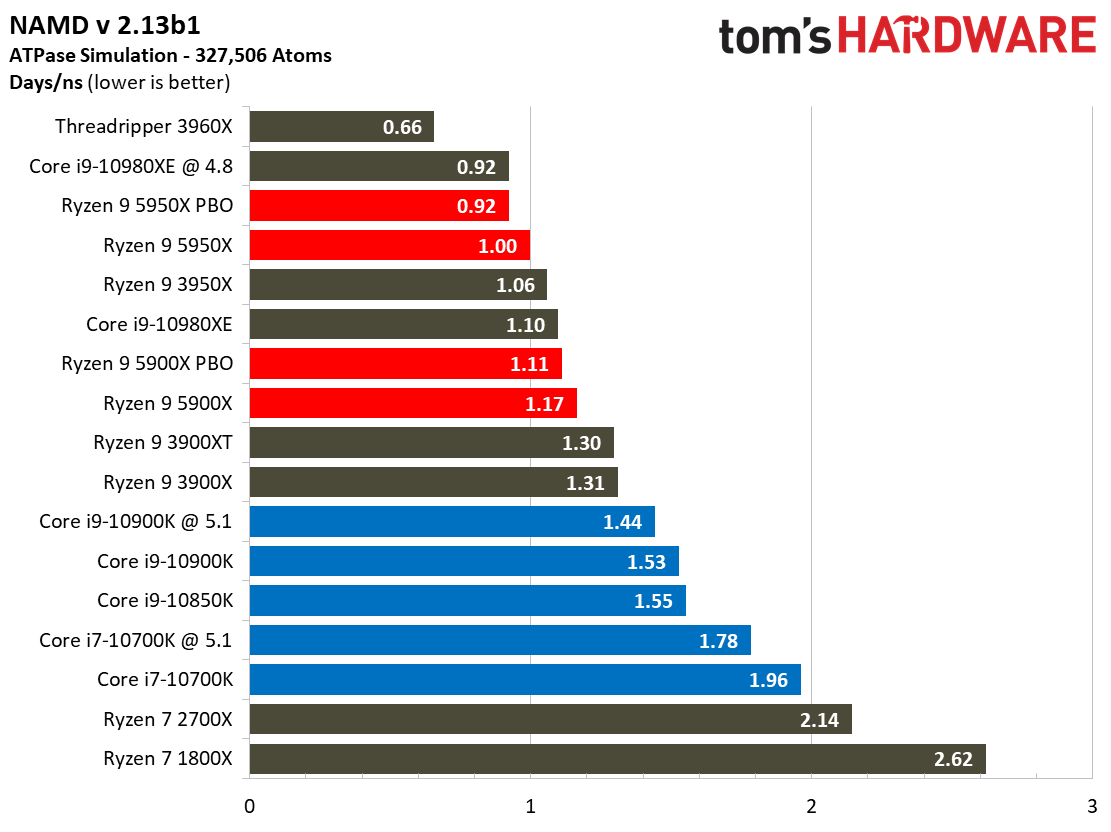
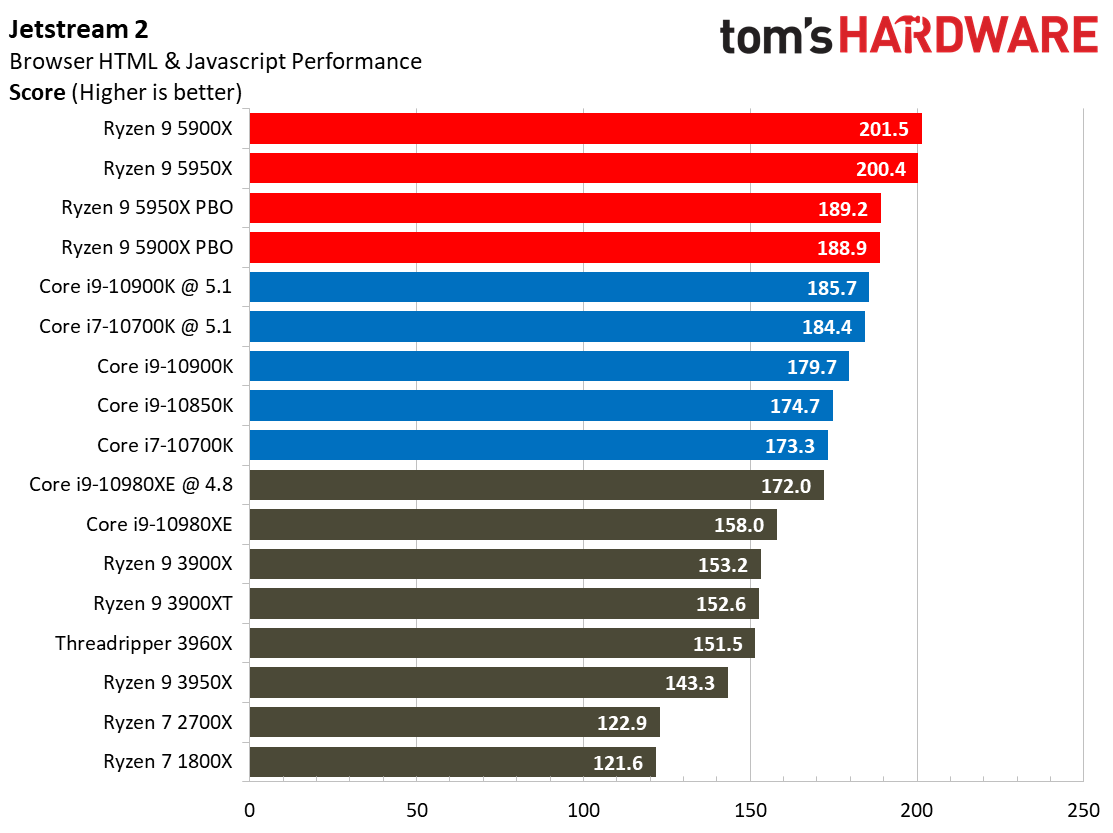
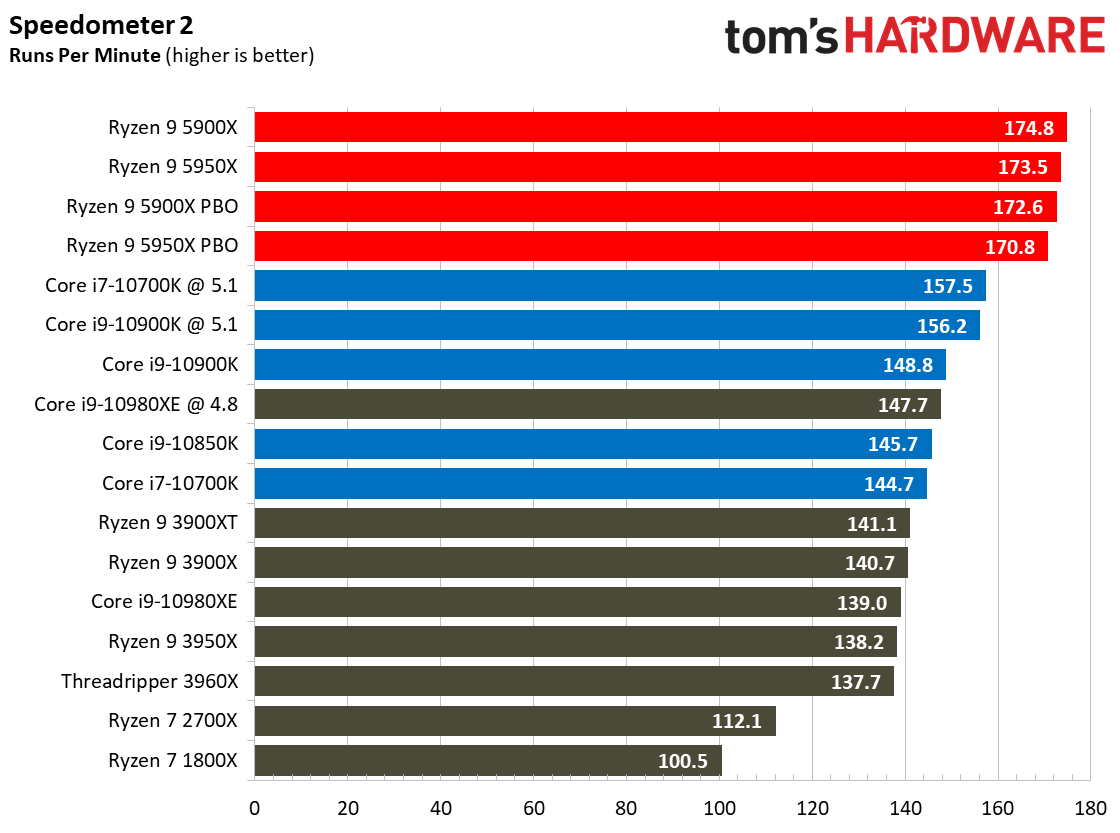
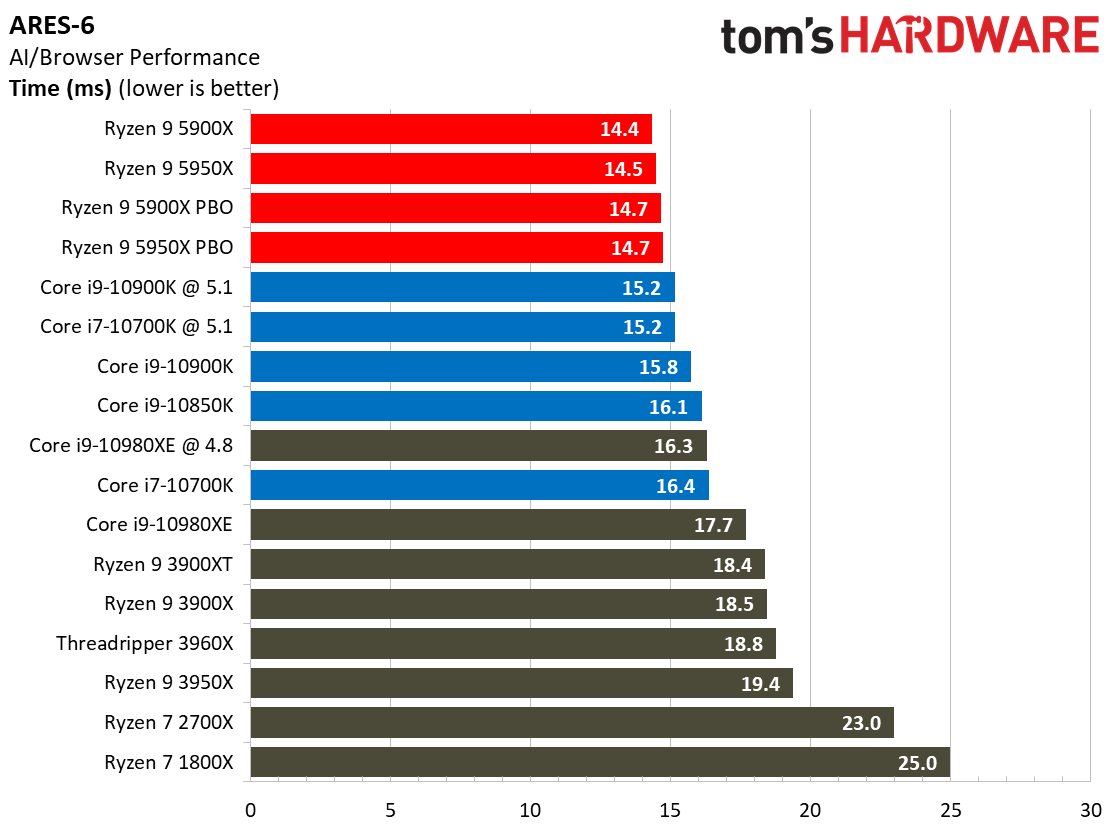
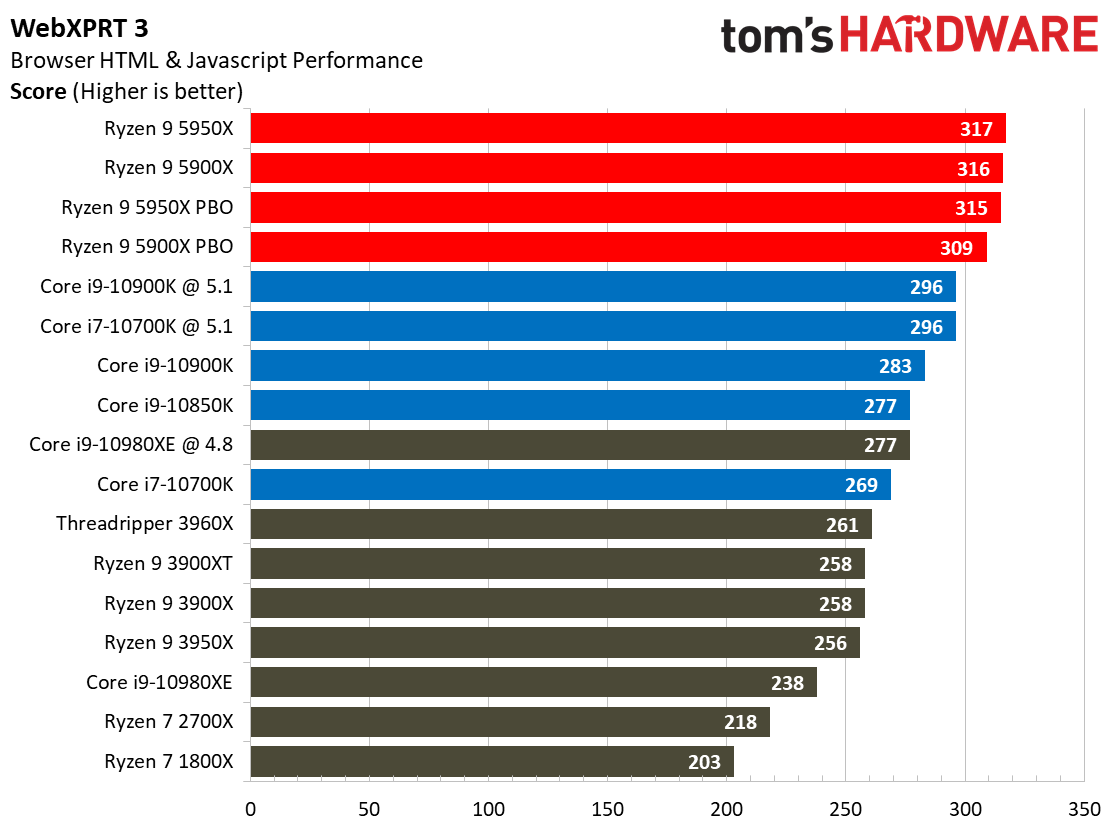
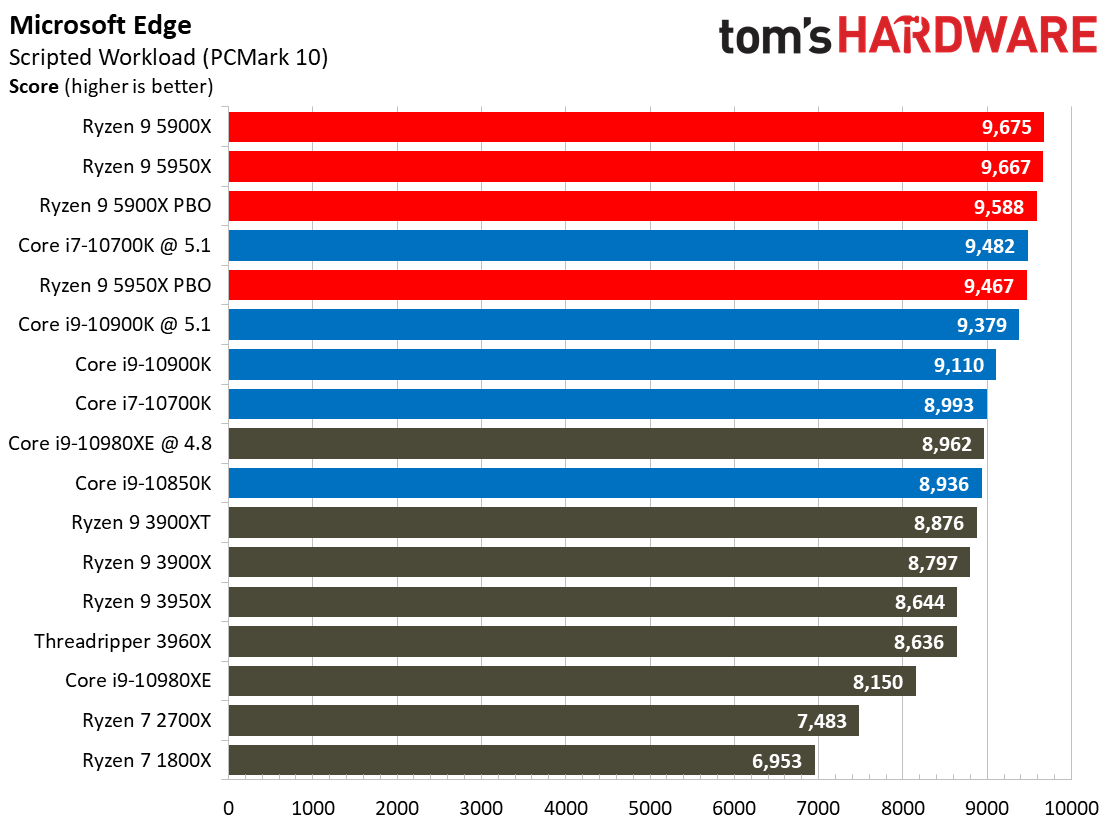
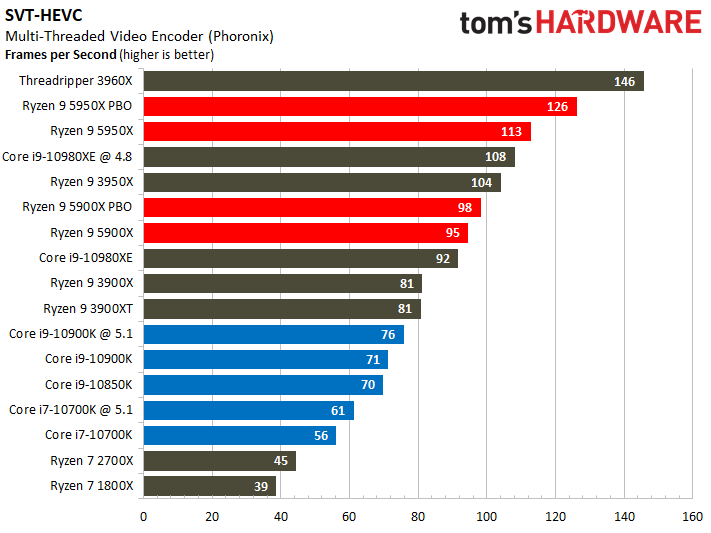
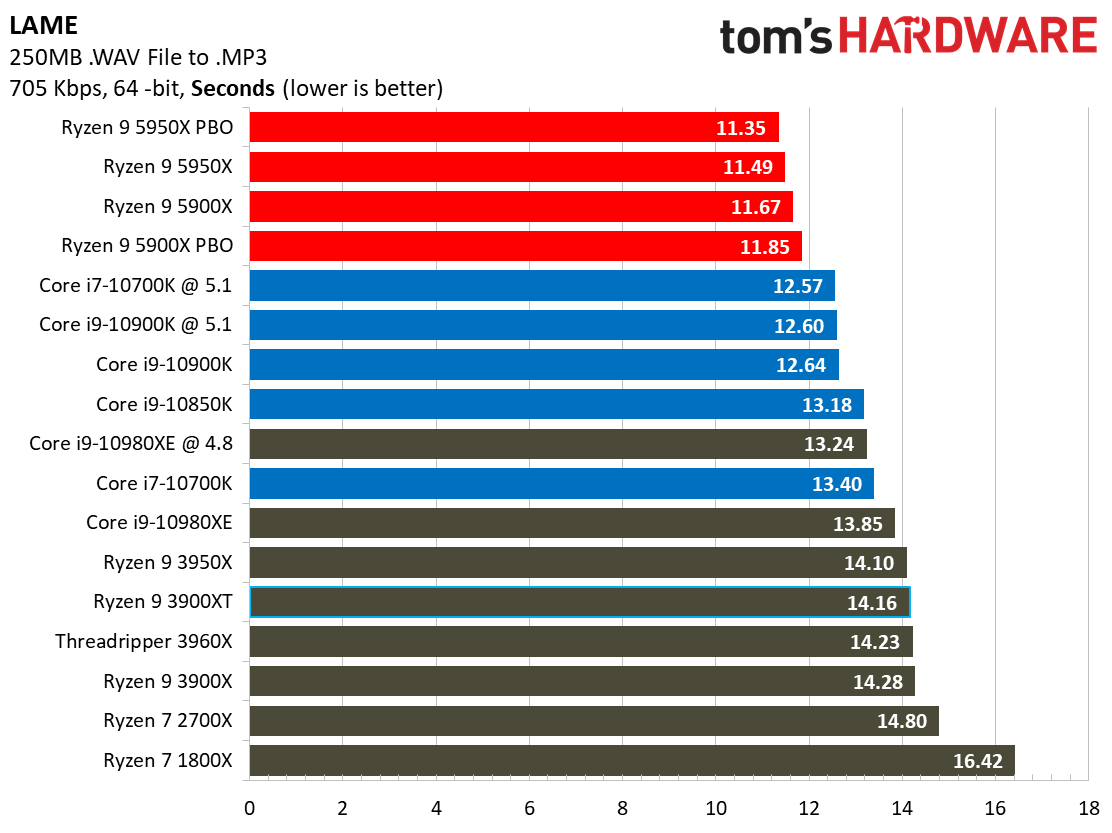
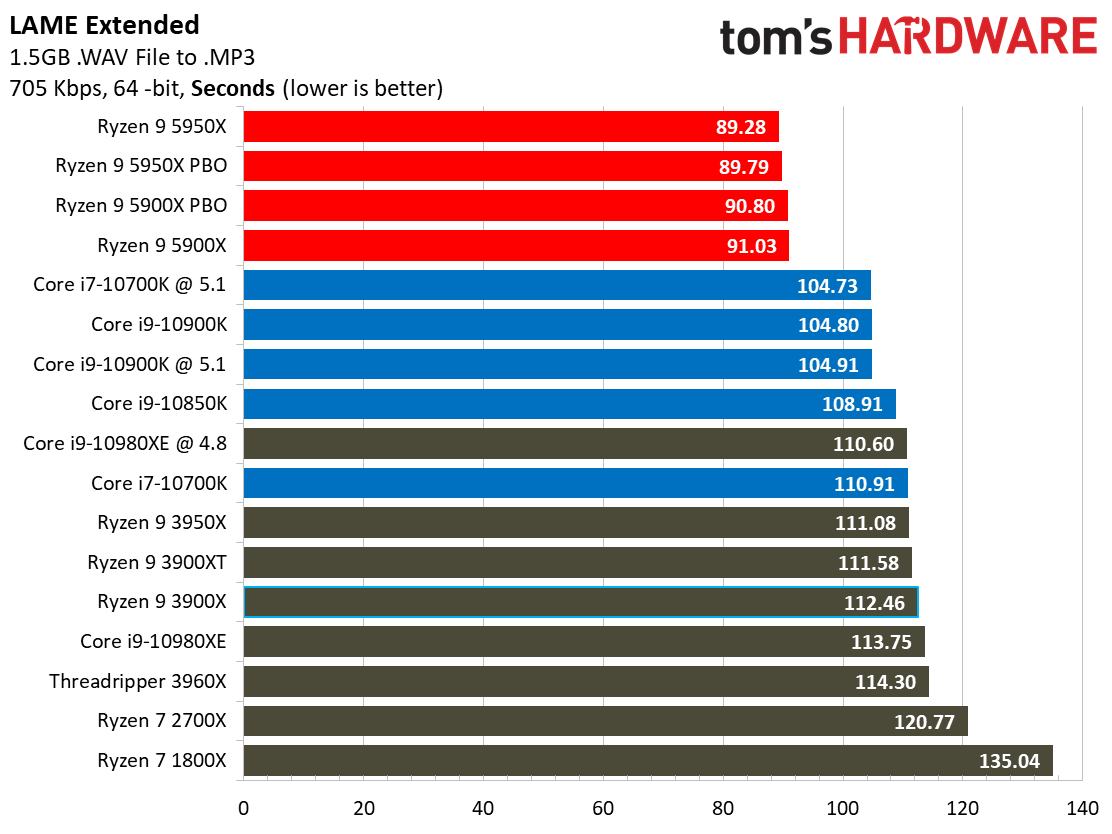
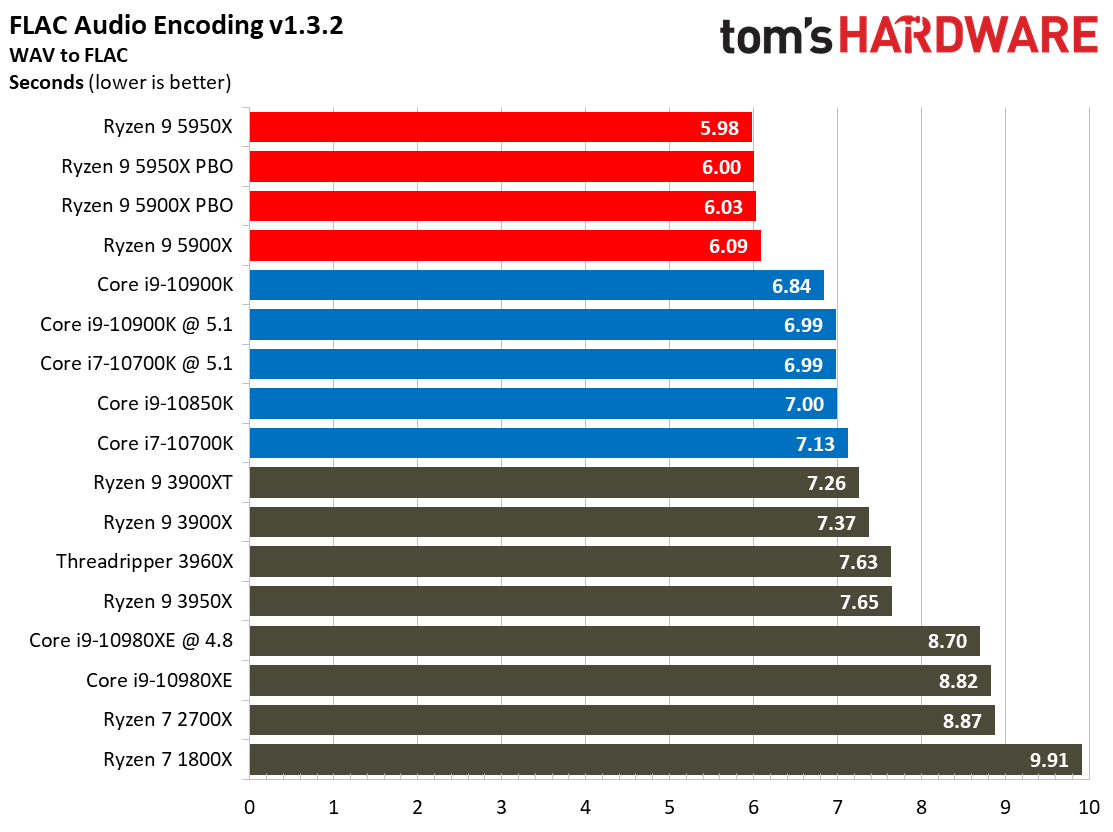
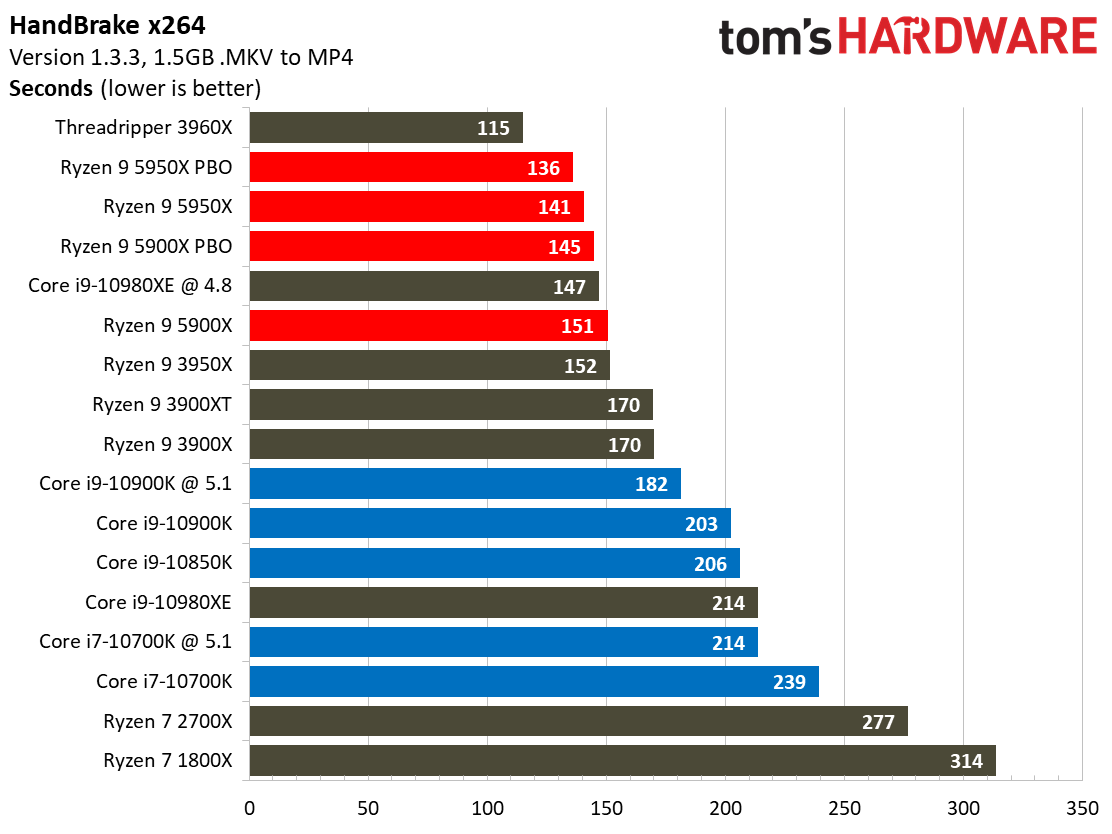
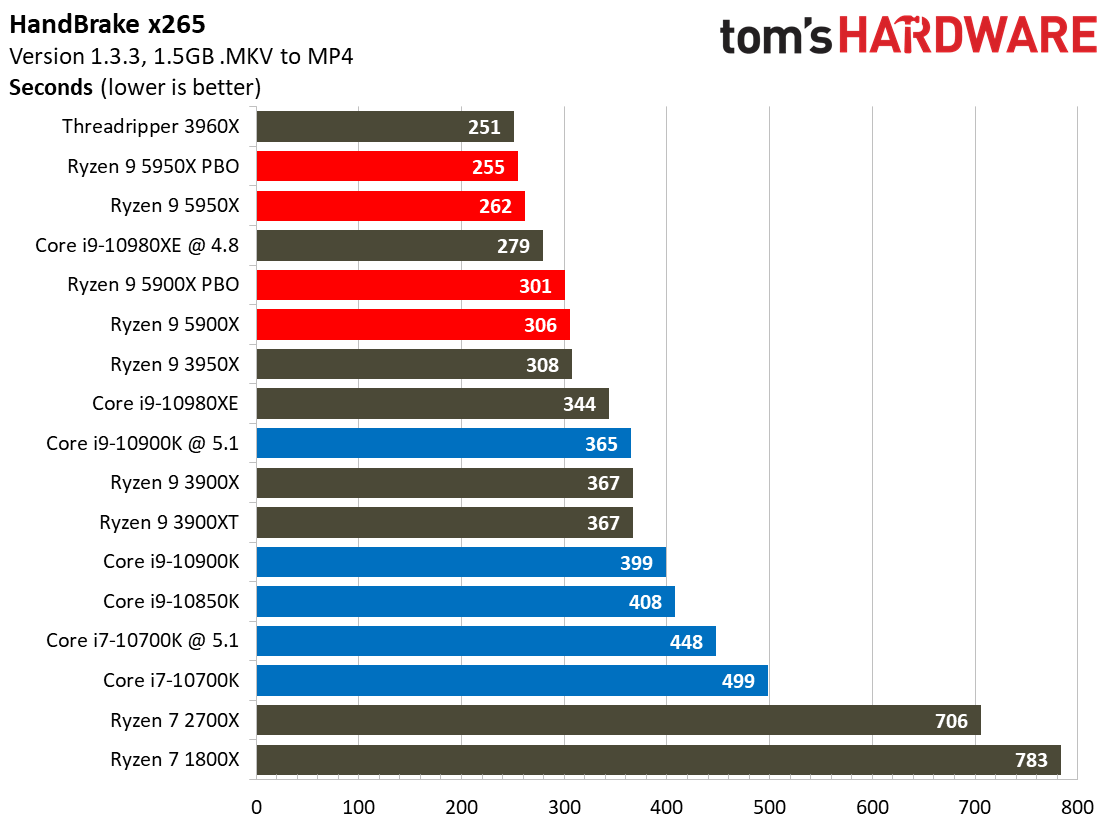
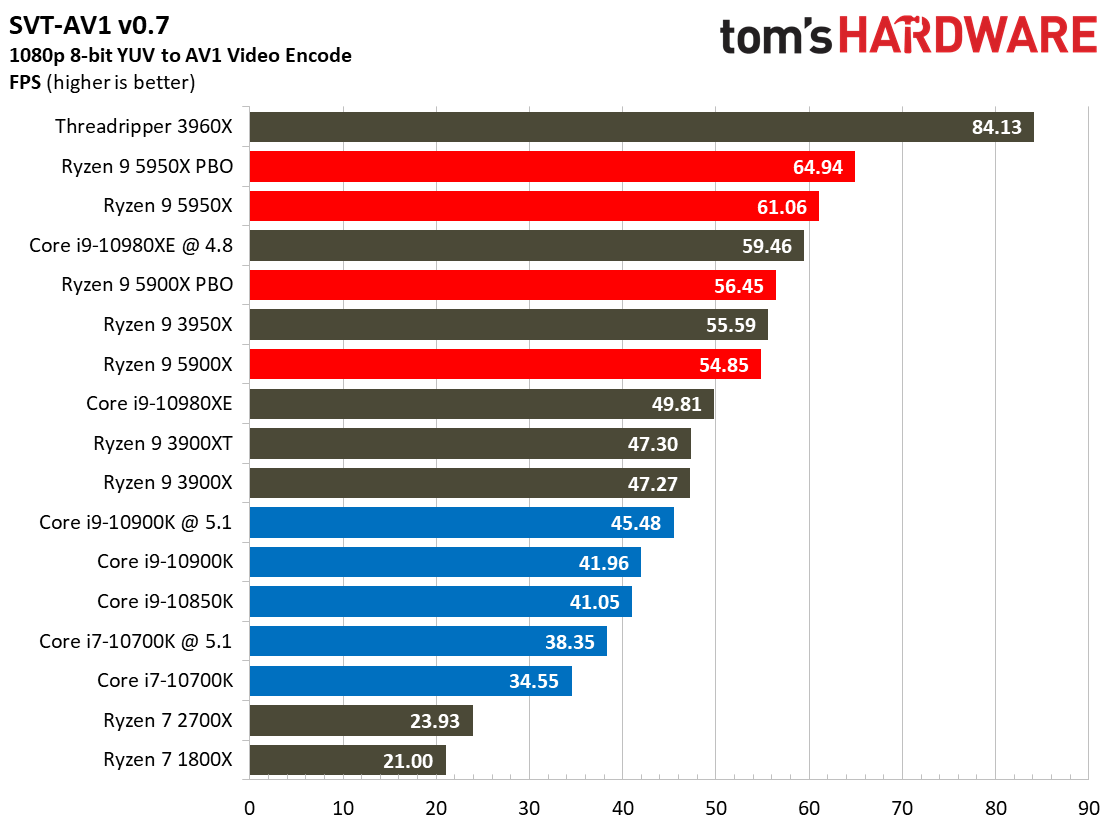
Here's a rollup of a selection of our mainstream application tests, but we have far more tests in our full review. We also have testing in the Adobe suite, SPECWorkstation3, and SpecViewPerf 2020 for those interested in professional applications.
Again, head to our Ryzen 9 5950X and 5900X review for more benchmarks and in-depth analysis, including power testing, thermals, overclocking, and efficiency measurements.
AMD Ryzen 7 5800X and Ryzen 5 5600X Gaming and Application Performance Benchmarks
Here you can see the geometric mean of our gaming tests at 1080p and 1440p, with each resolution in its own chart. Again, this gives us a broad sense of overall gaming performance for the Ryzen 5 5600X and Ryzen 7 5800X.
We tested the Ryzen 5 5600X with both the bundled Wraith Stealth cooler (marked as HSF in the charts above) and the Corsair H115i 280mm liquid cooler (AIO) to measure the difference in gaming. Overall, the Wraith Spire cooler provides the same level of gaming performance as the AIO cooler.
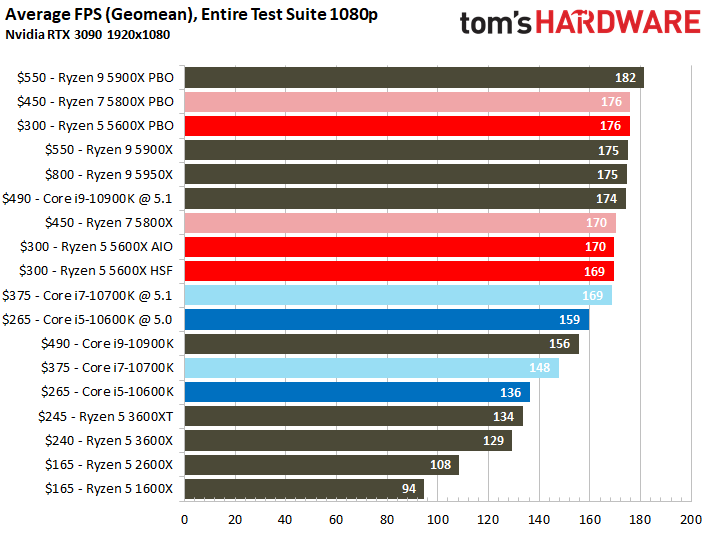
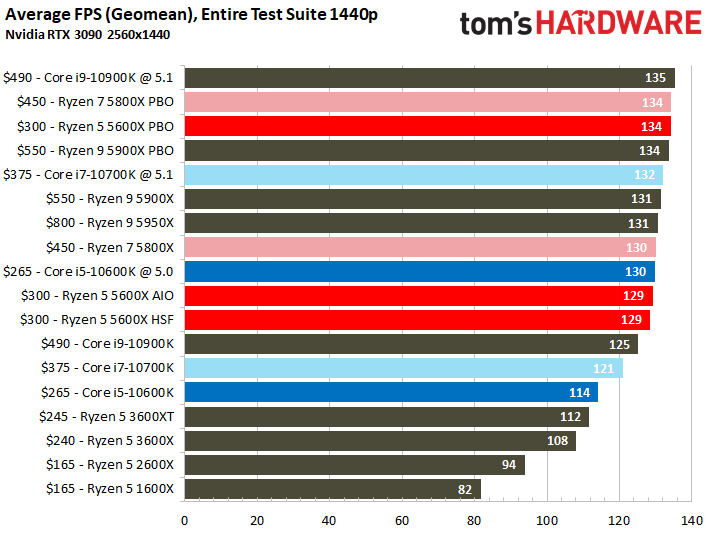
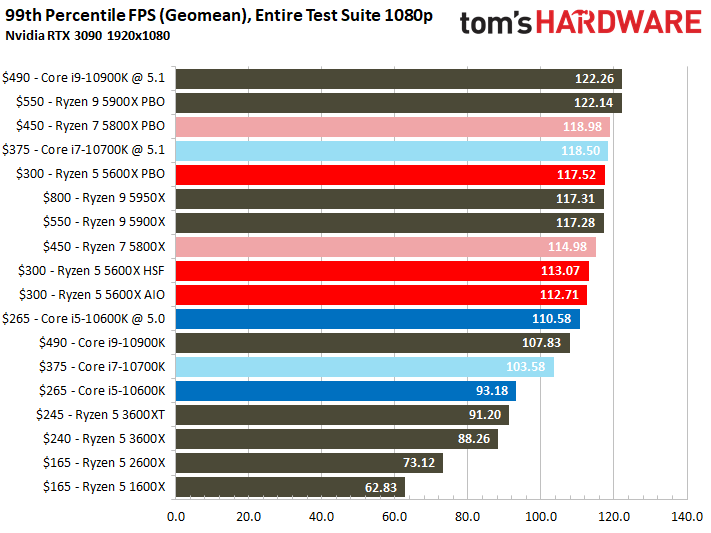
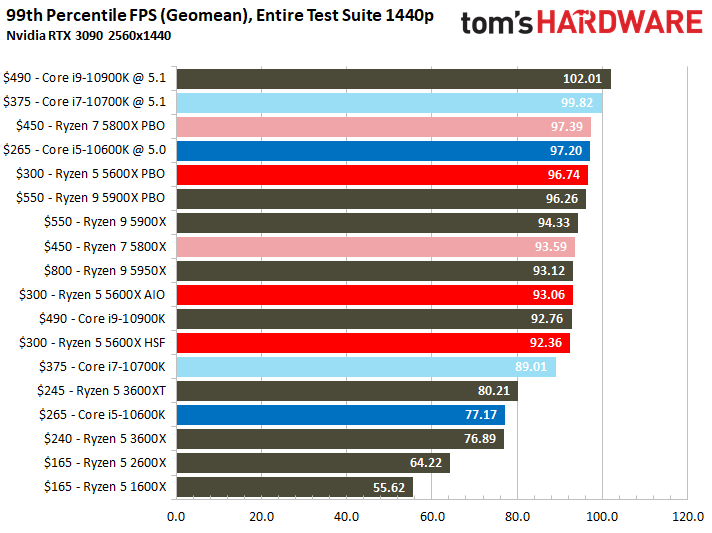
In terms of value, the $300 Ryzen 5 5600X wrecks Intel's halo $490 Core i9-10900K in our 1080p gaming suite. The 5600X even takes away the overall performance crown, too. The 10900K is a bit more impressive in our 1440p suite, but not by much - it trails the 5600X at stock settings, and overclocking the 10900K only yields a scant 1 fps advantage. For all intents and purposes, the processors have effectively tied after overclocking.
The 5600X is even more dominating over the chips in its price range. At stock, the Ryzen 5 5600X beats the Core i5-10600K in both 1080p and 1440p gaming by ~25% and 13%, respectively. Overclocking the Core i5-10600K to 5.0 GHz doesn't help much - the Intel chip still trails the stock 5600X by 7% at 1080p and effectively ties the 5600X at 1440p. Naturally, overclocking the Ryzen 5 5600X gives it the lead.
The $300 Ryzen 5 5600X is $35 more expensive than the Core i5-10600K, though, so we turn to Intel's higher-end $375 Core i7-10700K to see how it stacks up. If gaming is your primary goal, paying $75 more for the 10700K than the 5600X is a waste of money. The stock 5600X beats the10700K by 15% at 1080p, and ~8% at 1440p. Overclocking the 10700K doesn't help, either – the stock 5600X ties the overclocked 10700K at 1080p and trails by a mere 3 fps at 1440p. Overclocking the Ryzen 5 5600X gives it the lead over the pricey 10700K.
Finally, if you step up a tier to the $450 Ryzen 7 5800X, you won't get much extra over the 5600X, at least as far as gaming is concerned. The Ryzen 5 5600X matches the overclocked Ryzen 7 5800X step-for-step at both stock and overclocked settings in both resolutions, making the Ryzen 5 5600X the new mainstream gaming champ.
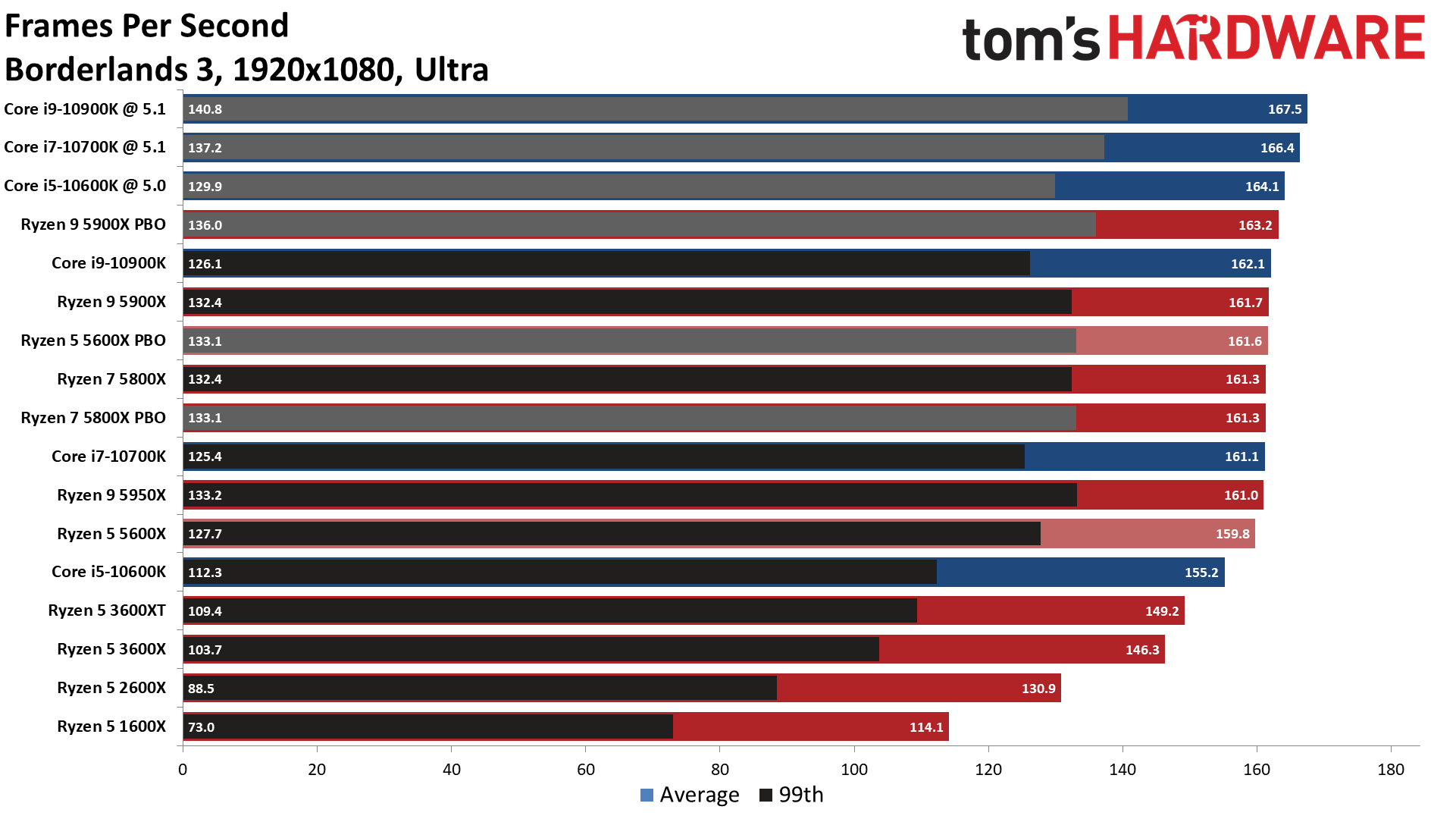
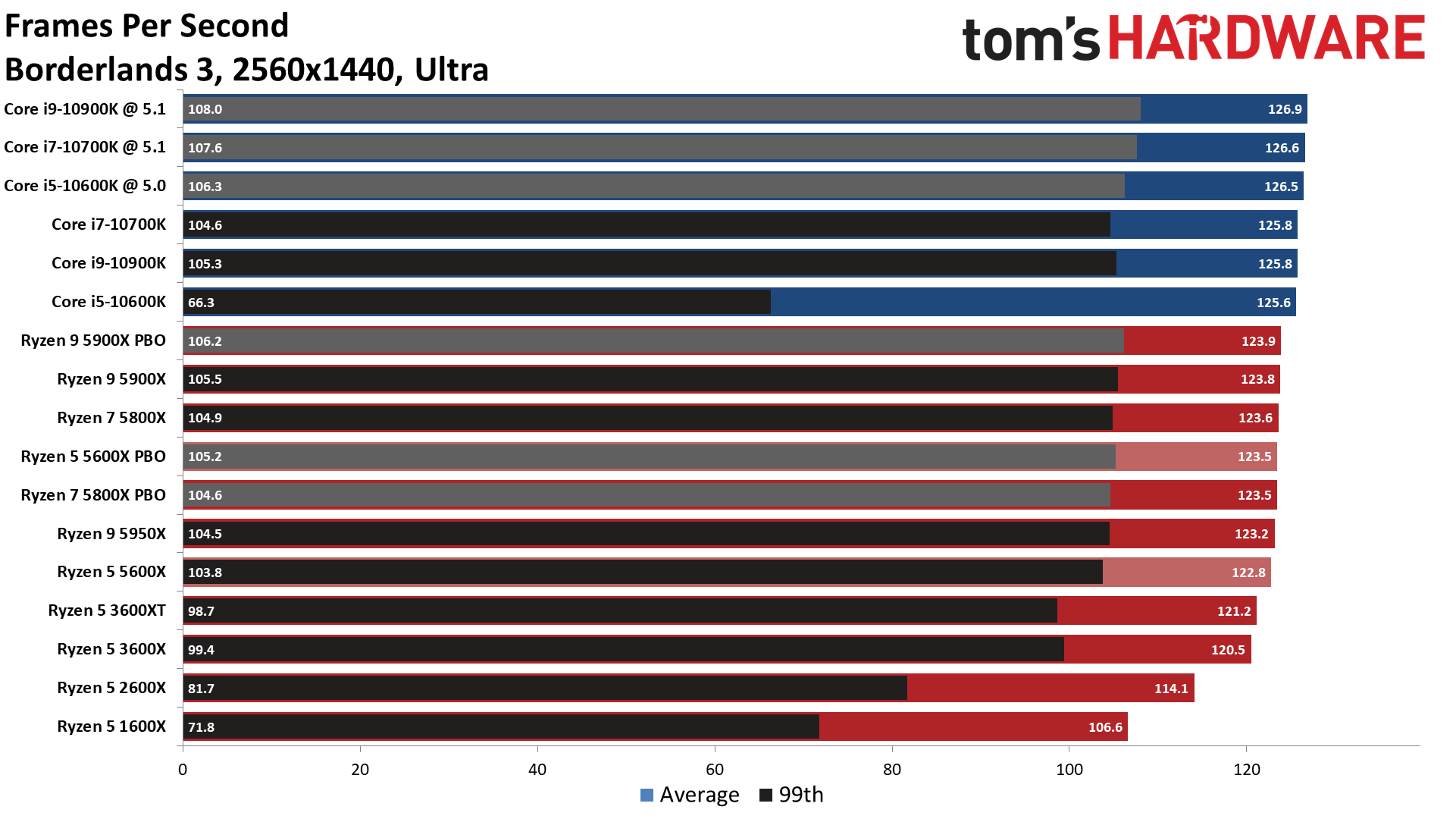
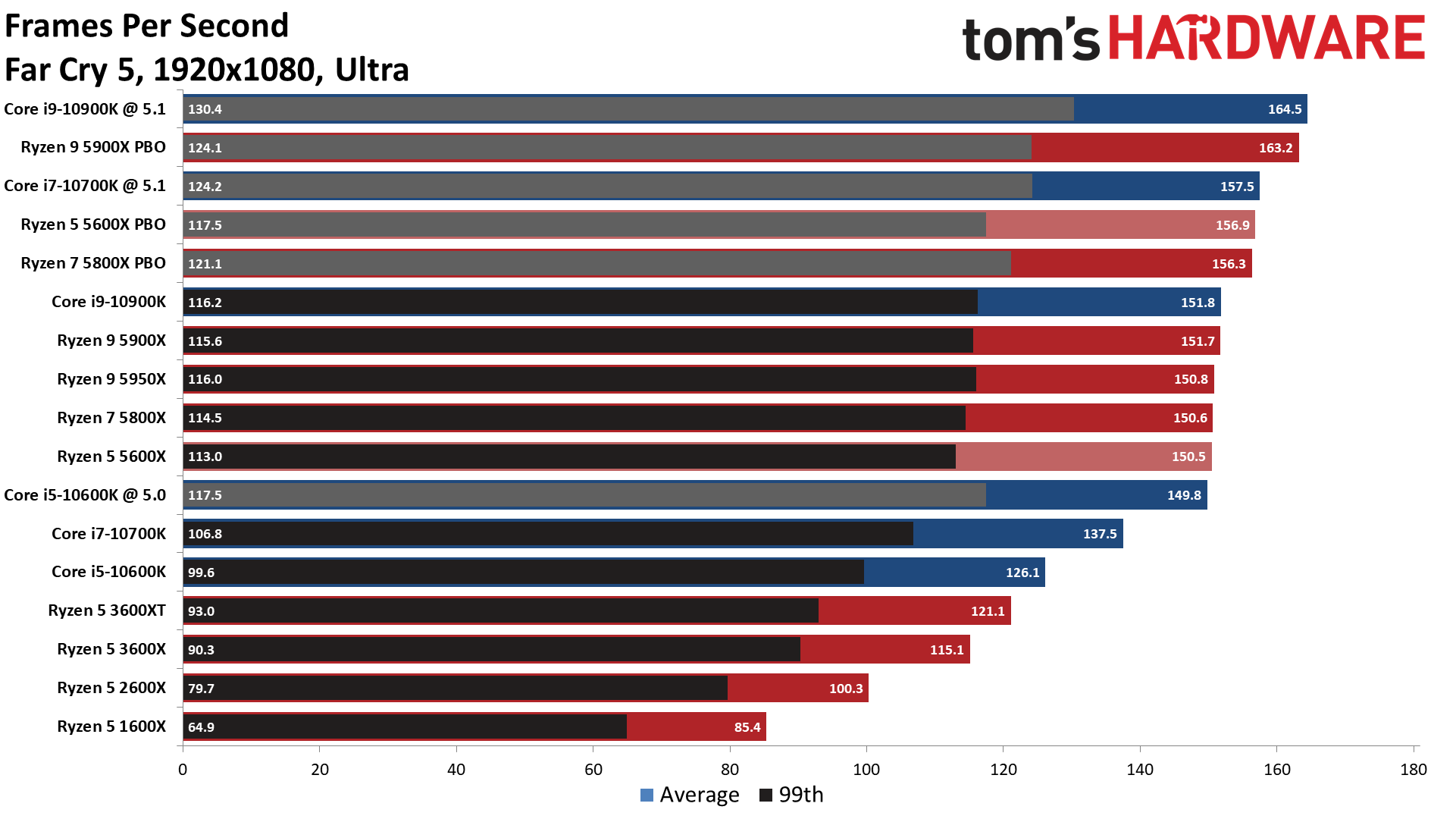
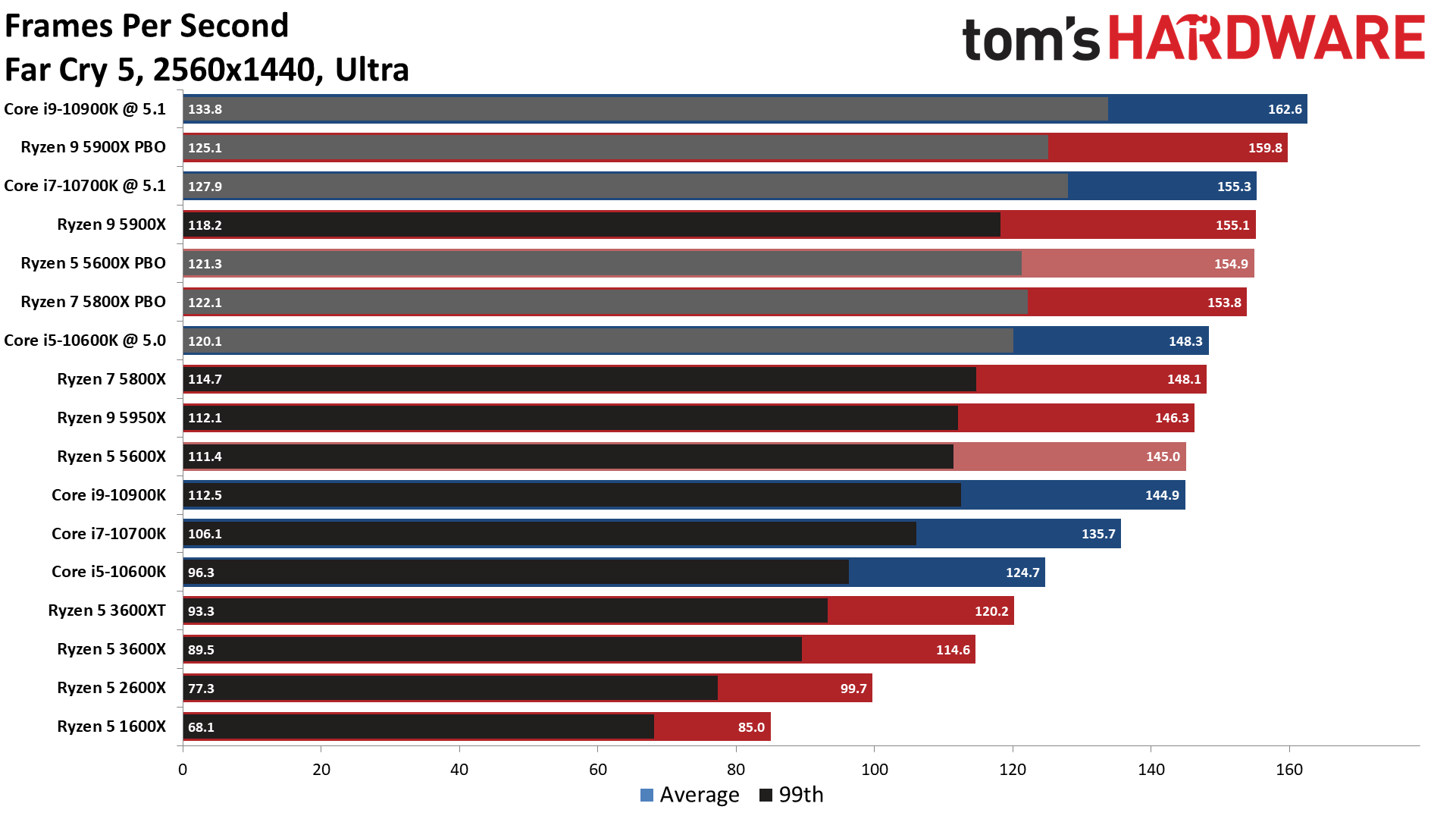
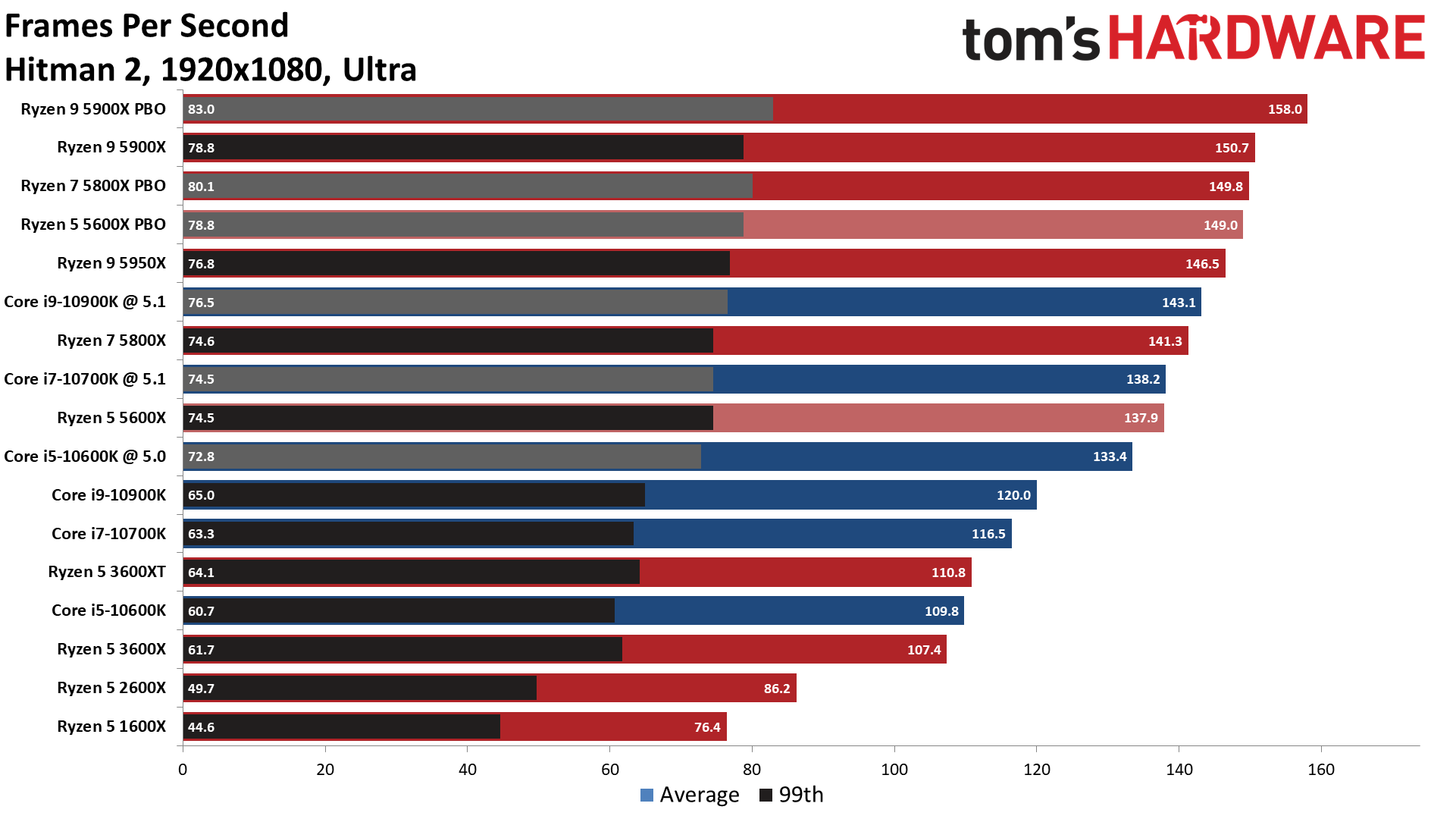
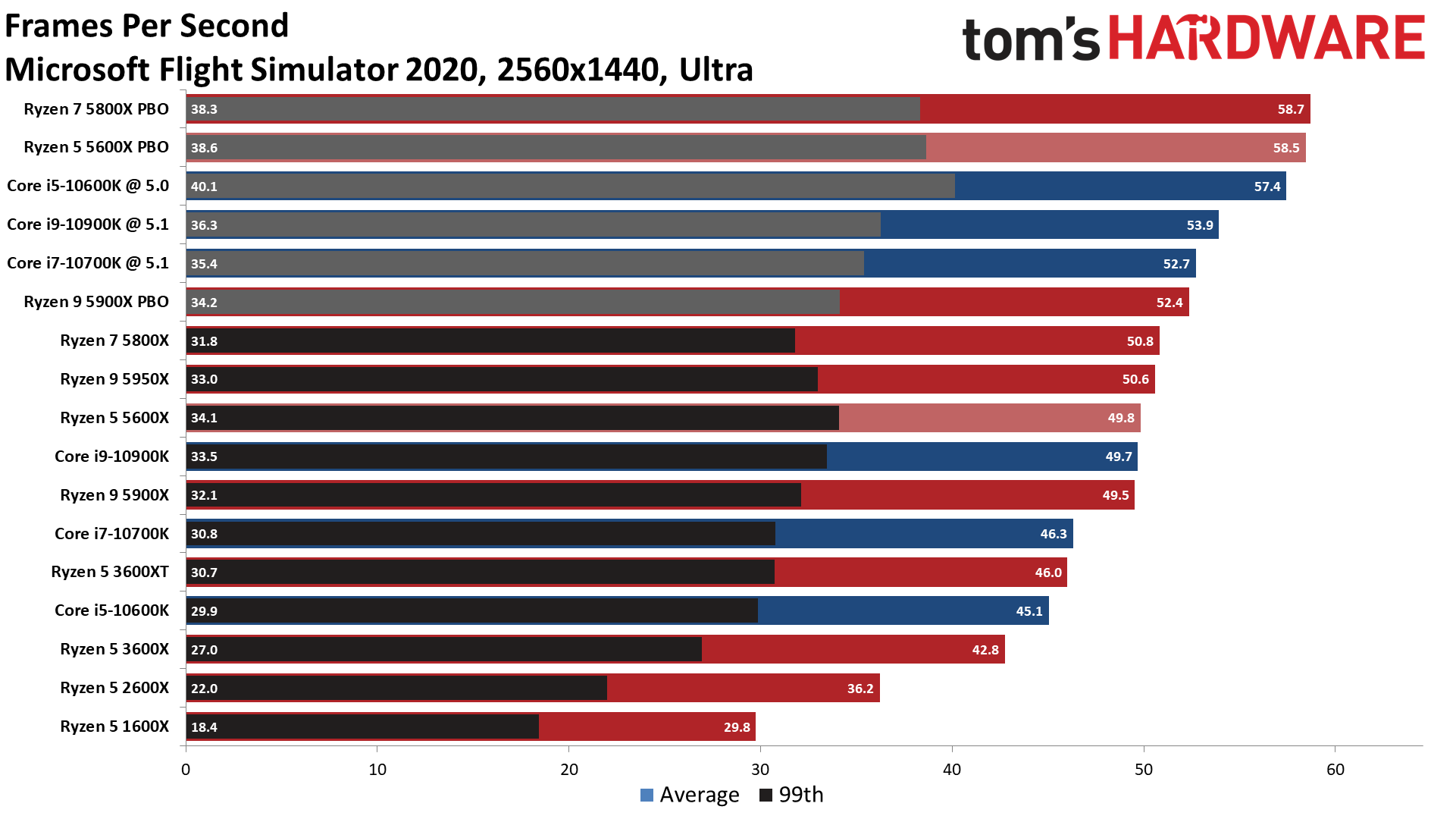
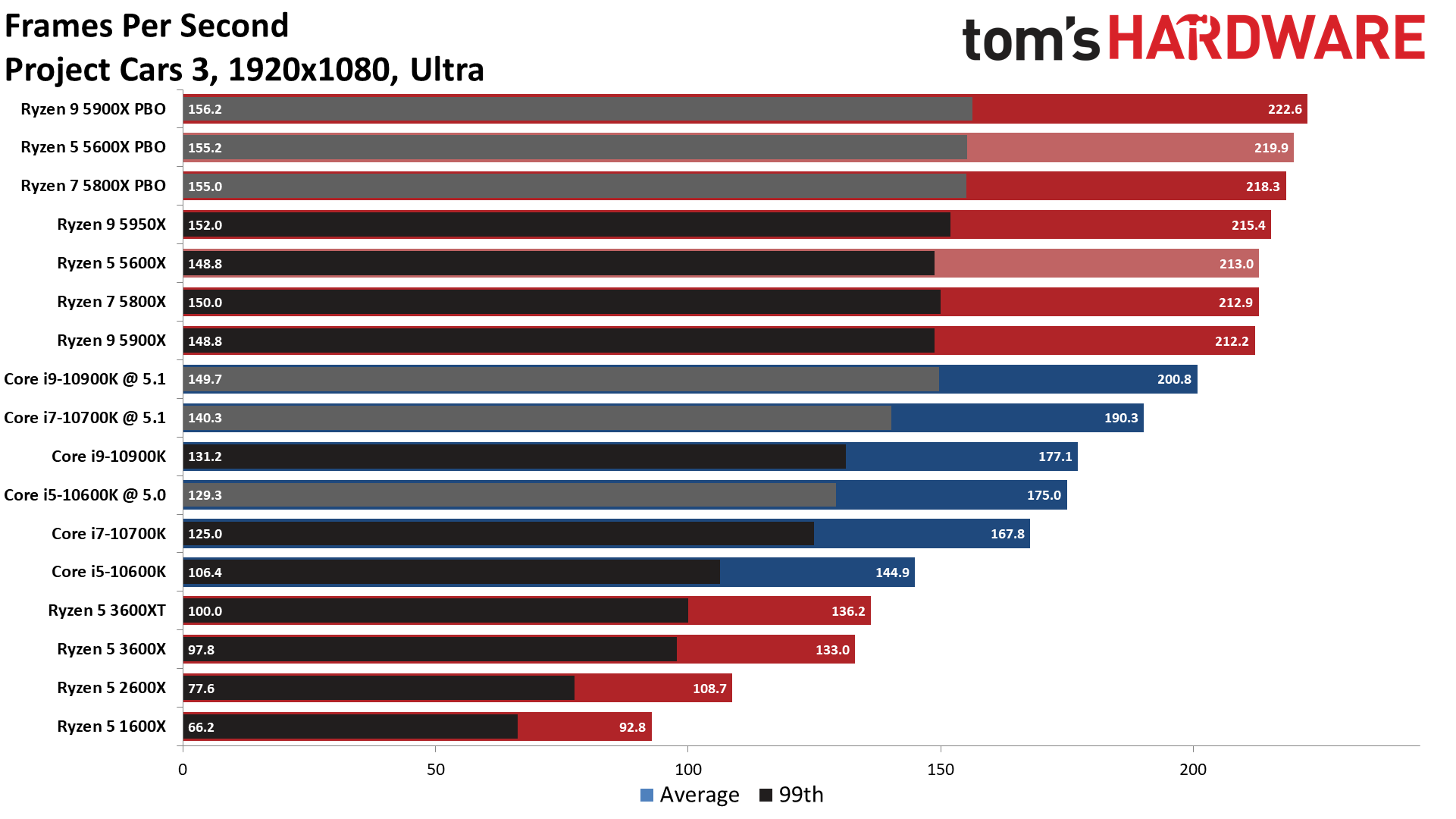

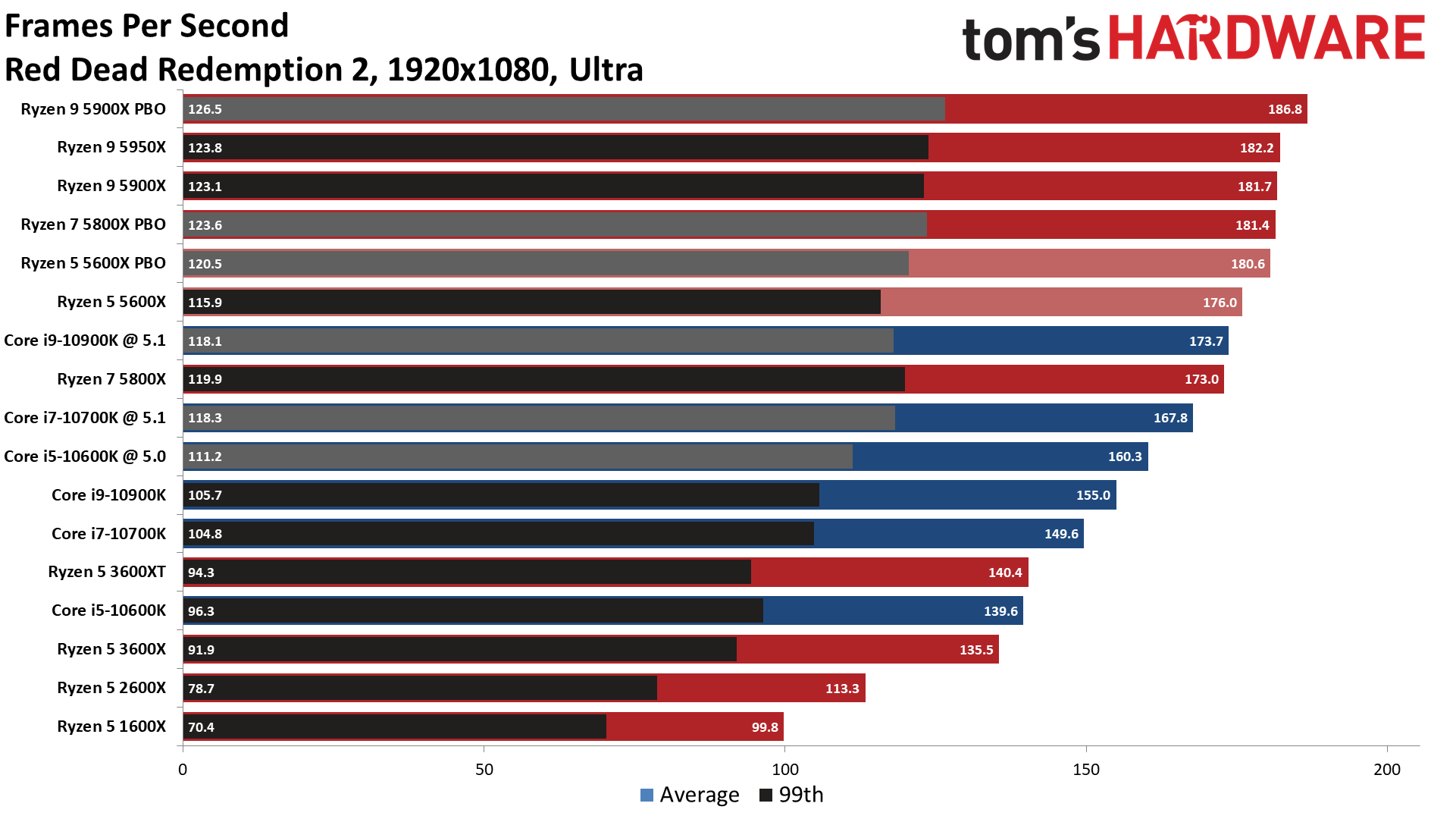
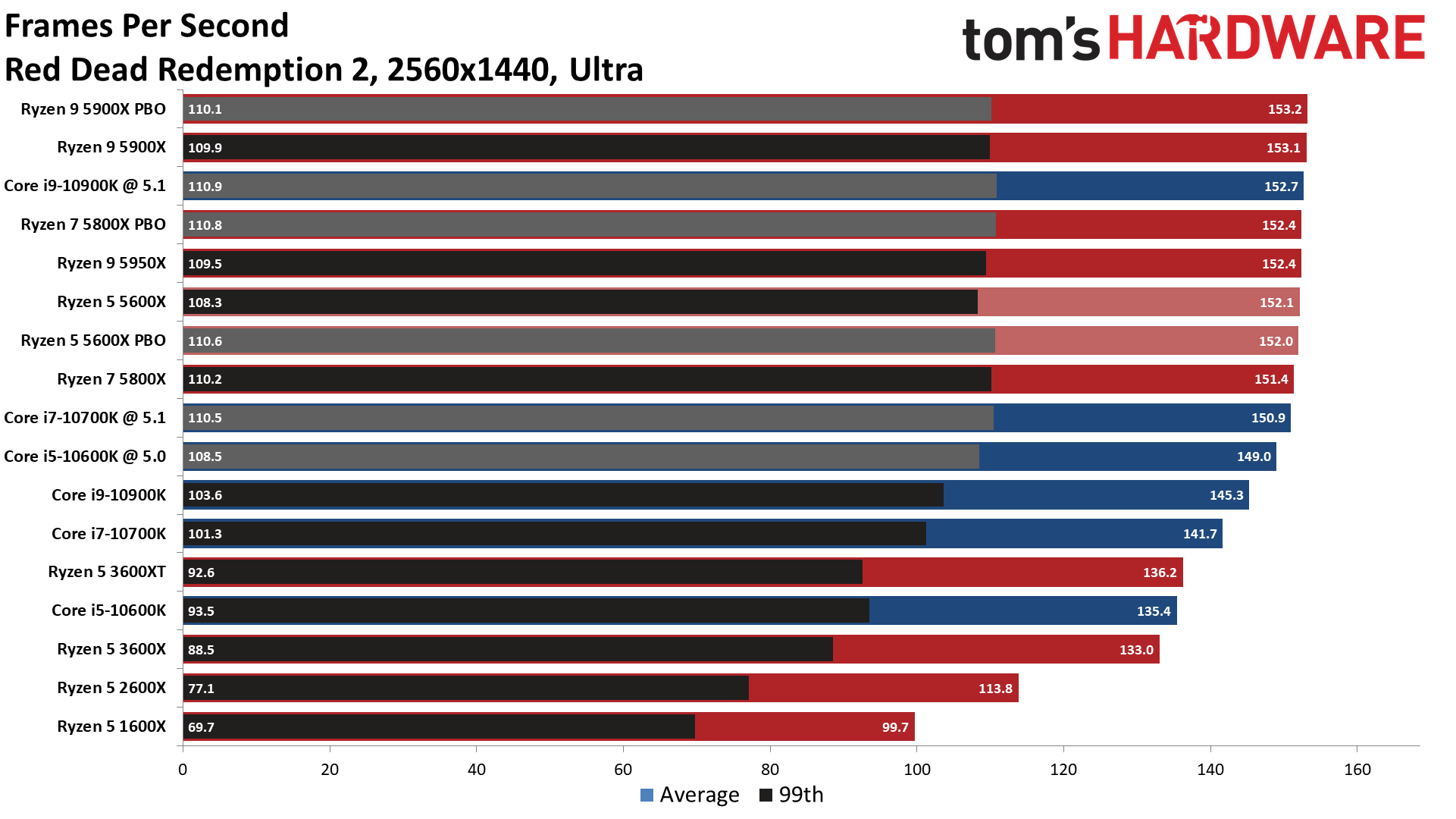
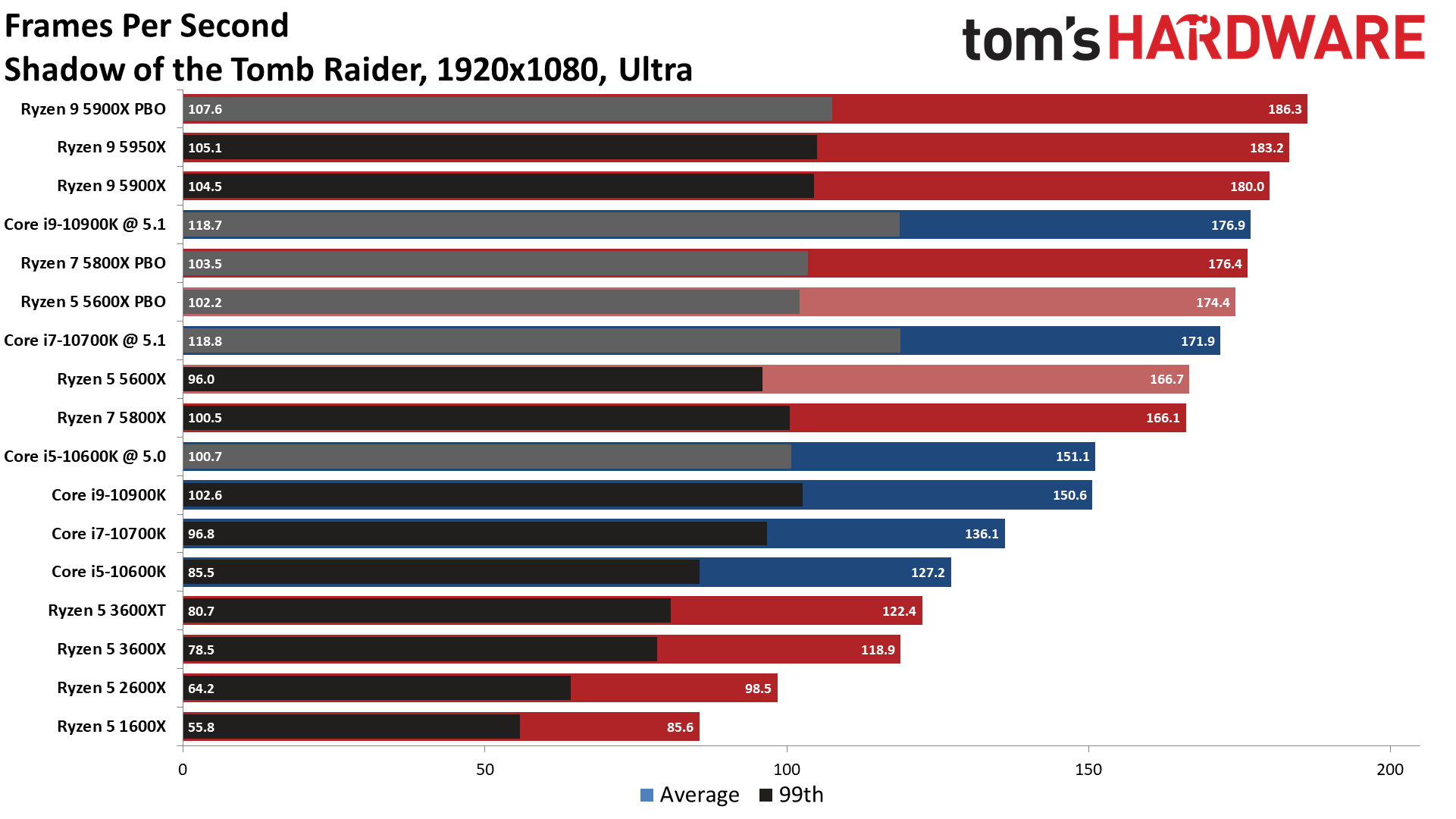
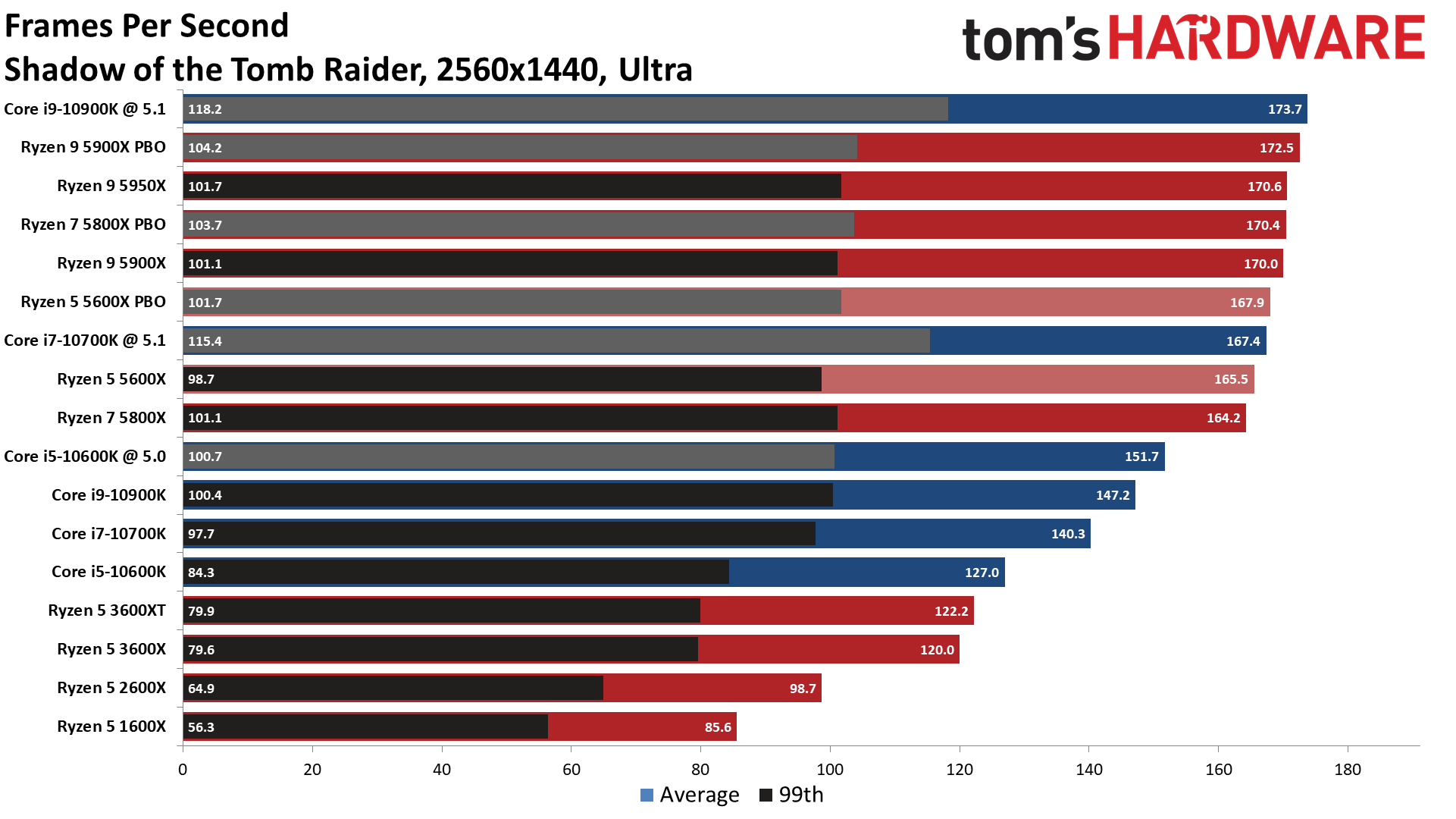
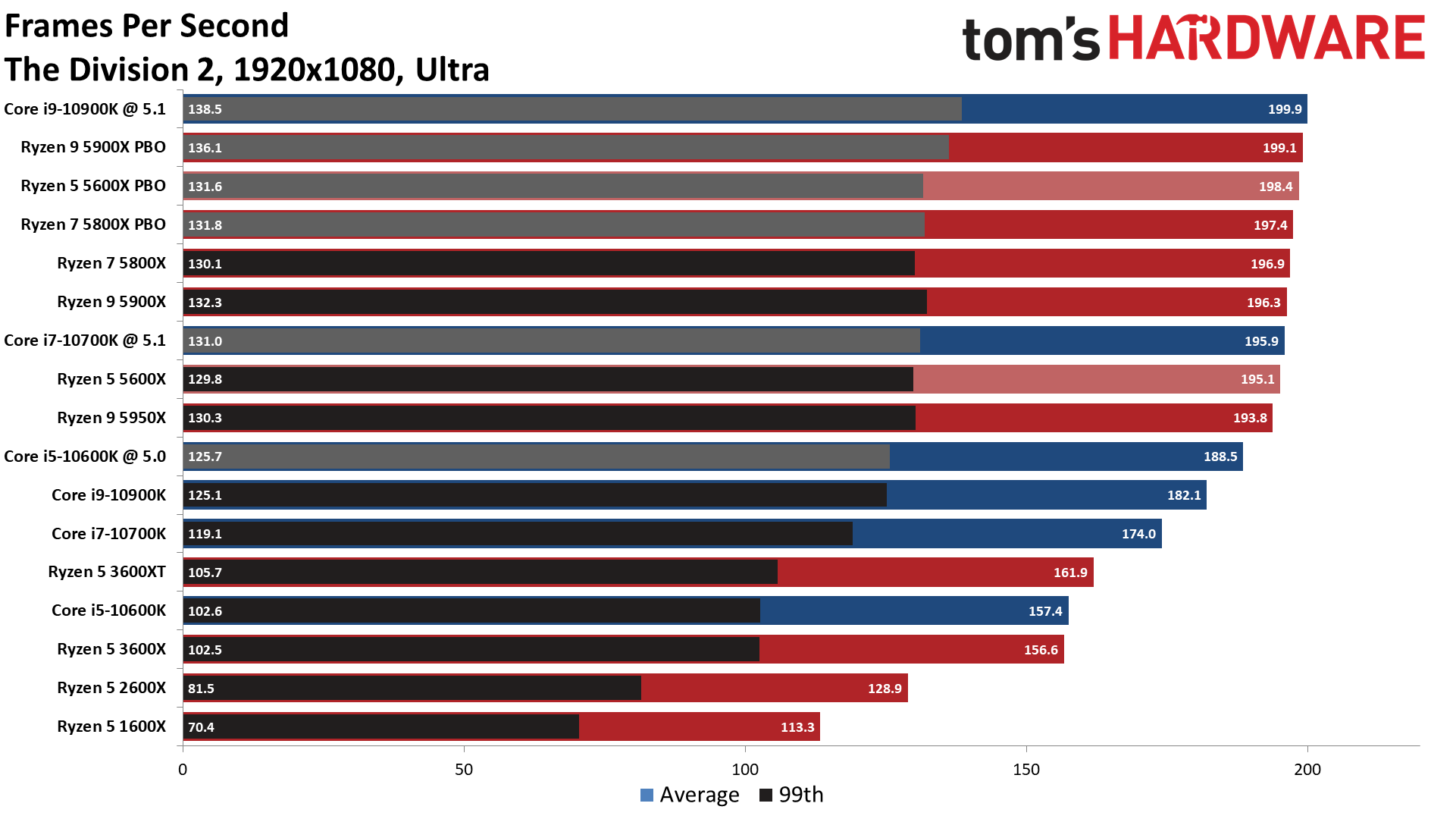
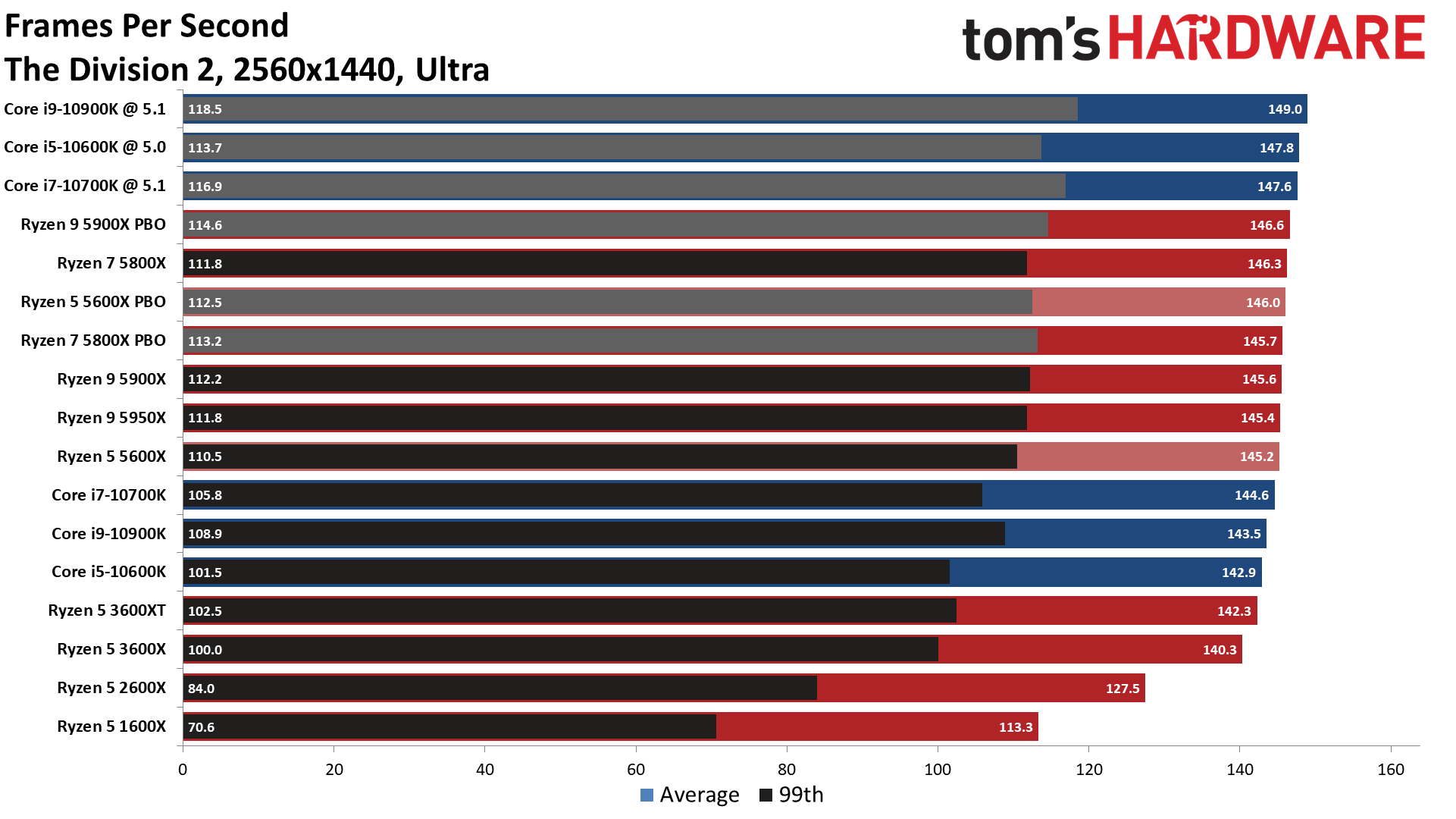
Here you can see the game-by-game breakdown of the benchmarks compared to Intel's Comet Lake chips, but you can head to our Ryzen 5 5600X review for a more detailed analysis. You can't go wrong with either the Ryzen 7 5800X or Ryzen 5 5600X for gaming, but if you don't need a lot of threaded heft for frequent heavy workloads, the Ryzen 5 5600X is the best value.
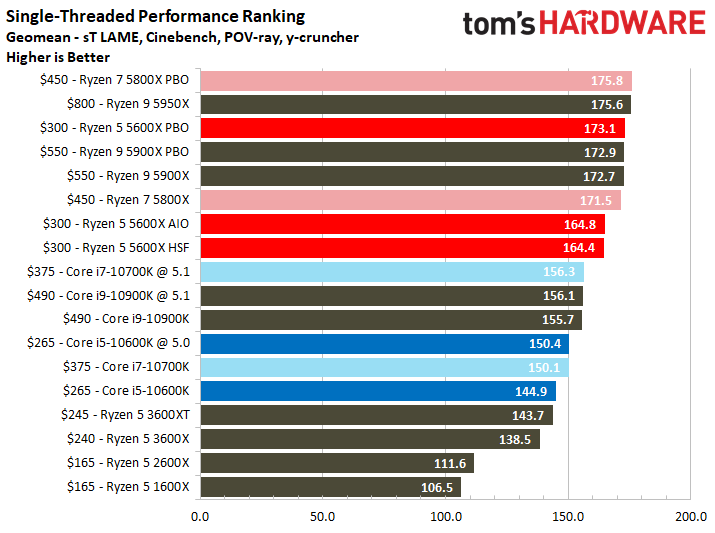
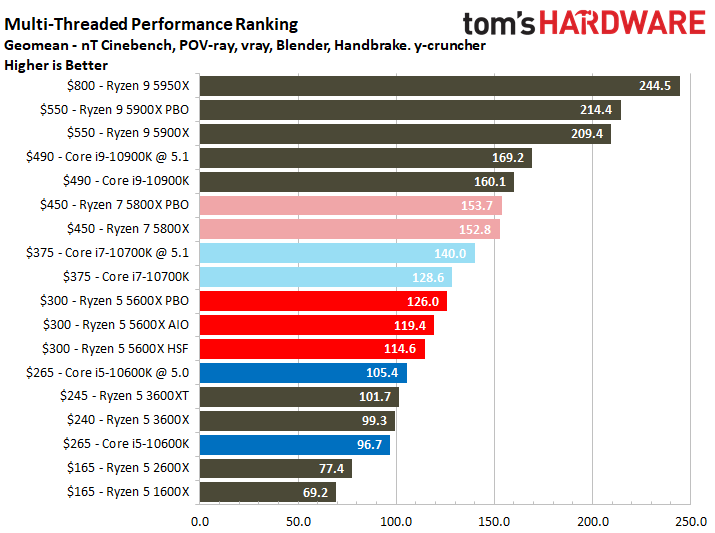
These geometric means of the lightly- and heavily-threaded tests in our application suite tell quite the story. Again, AMD now dominates on both sides of the ball.
As we saw in our gaming tests, there is little to no difference between single-threaded performance with the bundled Wraith Spire and Corsair H115i coolers, but we see a bigger difference in heavily-threaded applications. We recorded a 4% boost to performance with the H115i in our cumulative measure, but it's important to note that this varies on the workload. With that in mind, be aware that we've charted performance with our H115i cooler throughout the rest of the application testing.
However, regardless of the cooler, one thing remains true - the Ryzen 5 5600X easily beats the 10600K in threaded applications and even challenges the 10700K that comes with two more cores and a $75 premium. That makes the 5600X a solid bang-for-your-buck for heavy applications. If you need more performance and want to step up a tier, the Ryzen 7 5800X provides a solid boost through its additional two cores - but you have to pay $150 more for the privilege.
Moving over to the single-threaded performance rankings really highlights the 5600X's strengths - the stock Ryzen 5 5600X beats the full roster of Intel chips, including the Core i9-10900K, in our ranking - and that's even after we overclock the Intel chips to the limits.
The Ryzen 5 5800X is a nice step up from the 5600X for lightly threaded work, but overclocking both chips yields a small 1.5% advantage for the Ryzen 7 5800X. That isn't a difference you'll feel in any lightly threaded app, making the Ryzen 5 5600X the price-to-performance champ for lightly-threaded work, too. You certainly won't be left wanting if you decide to step up to the Ryzen 7 5800X, either.
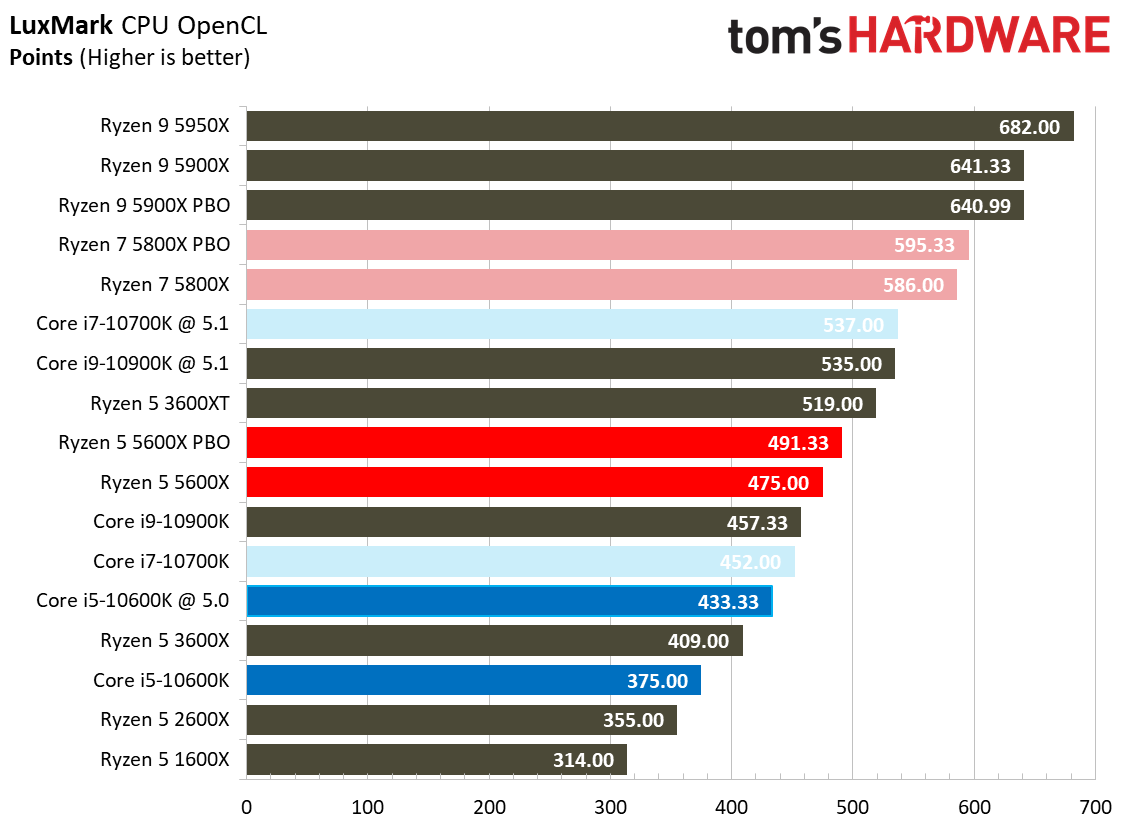
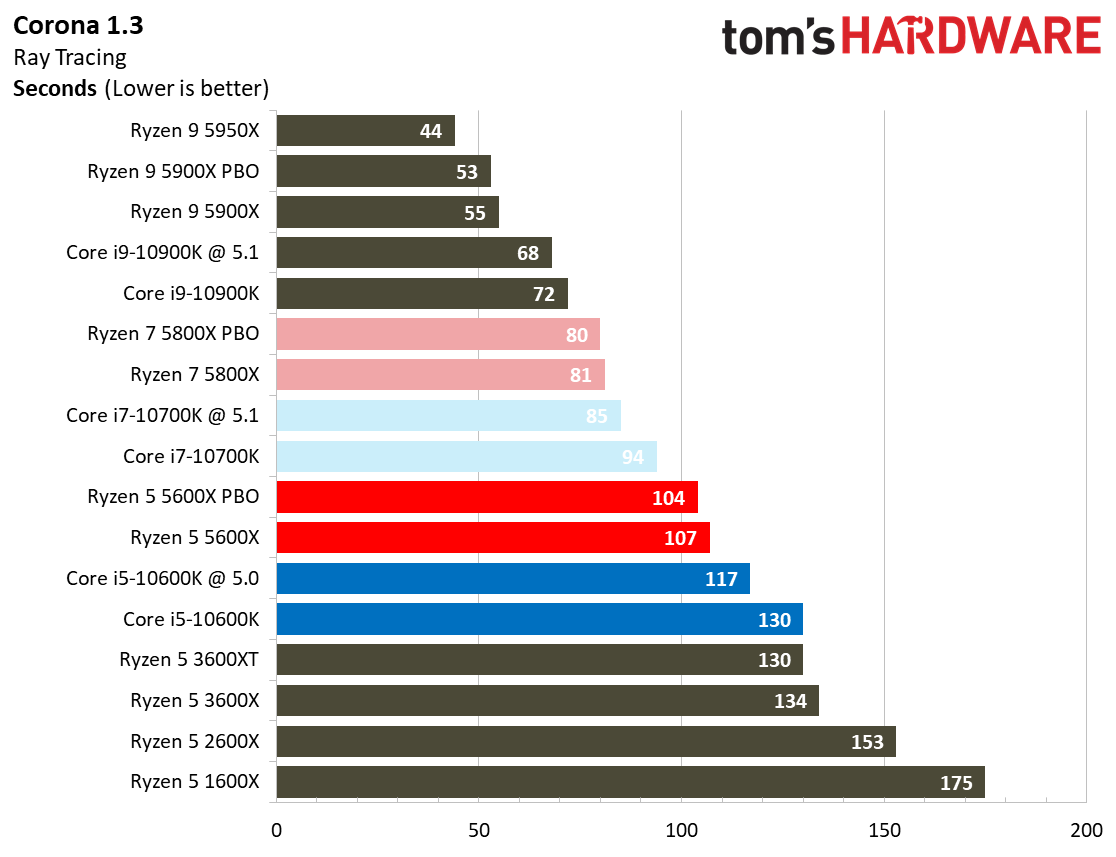
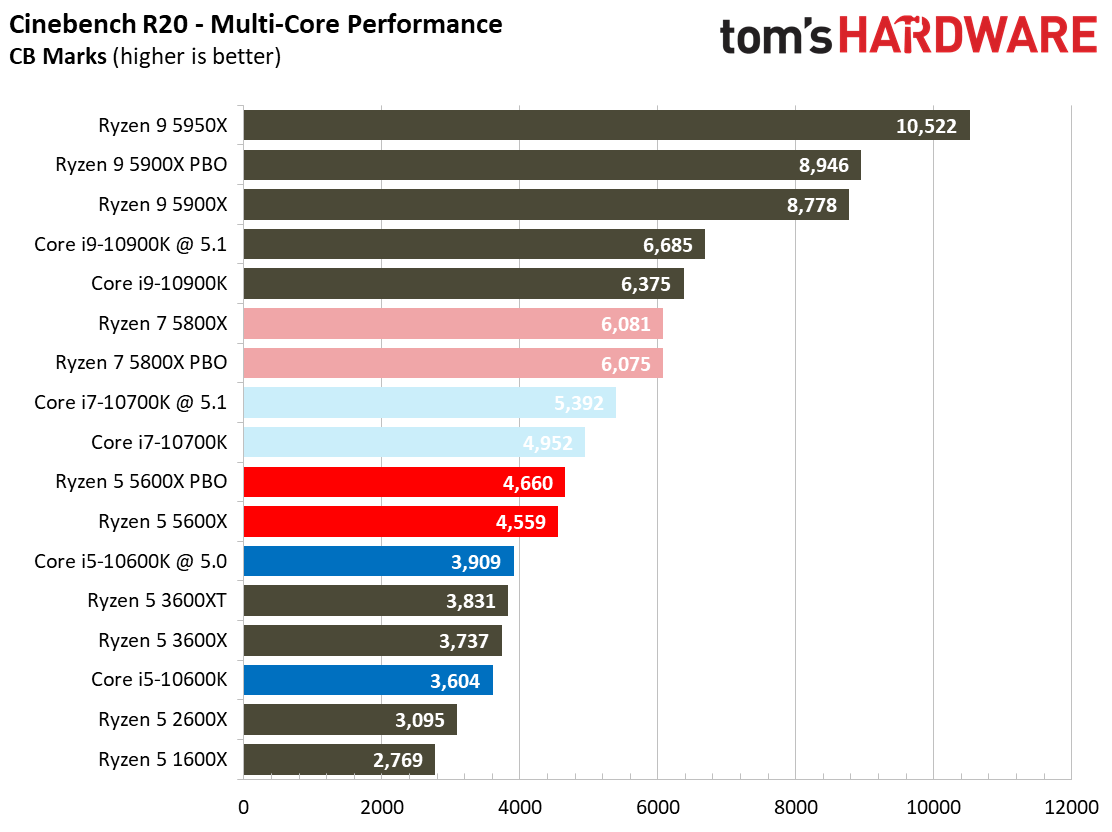
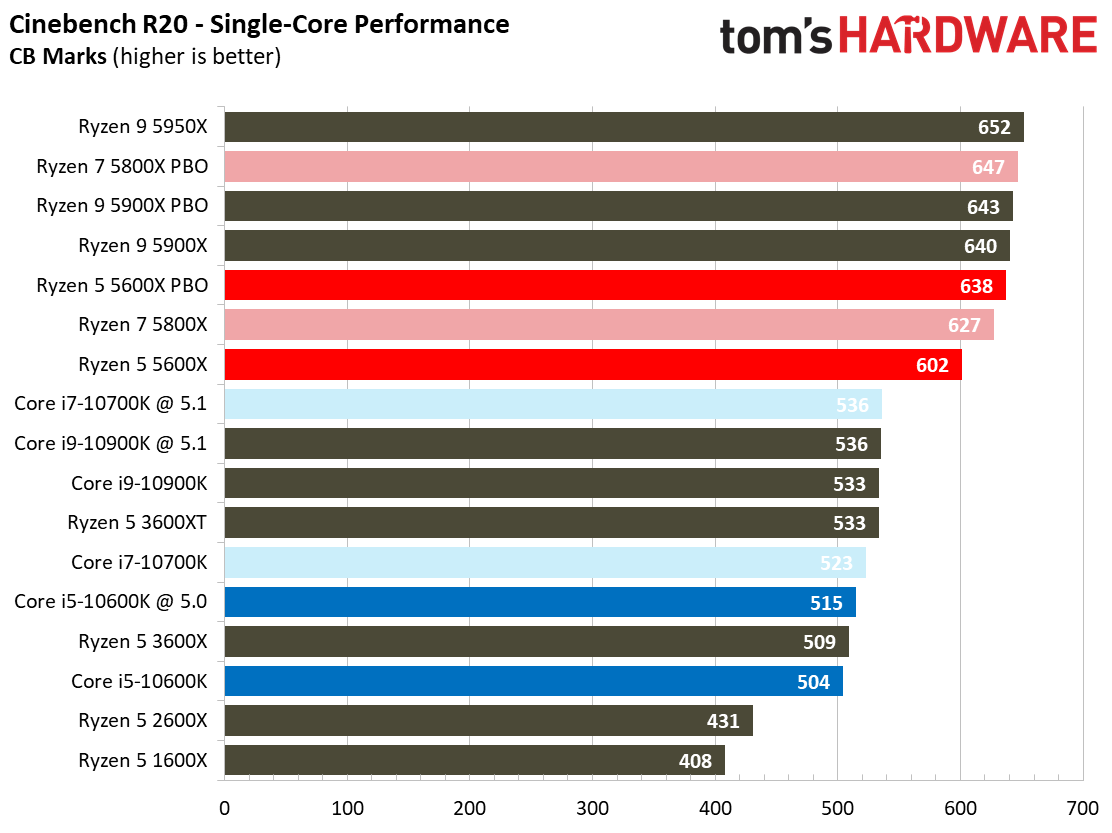
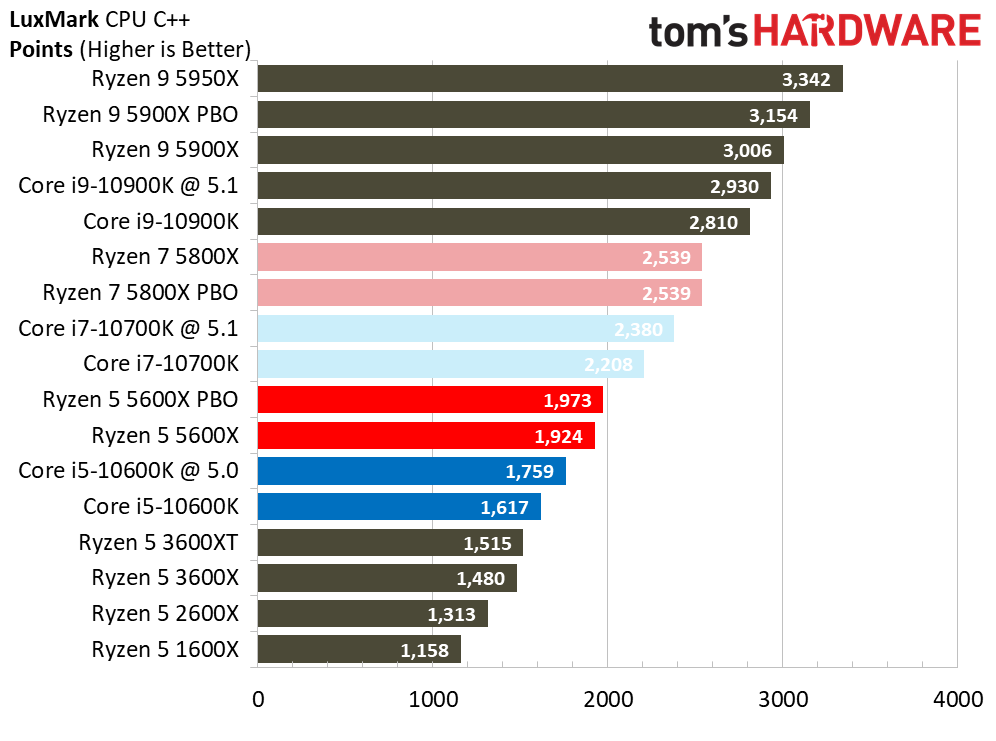
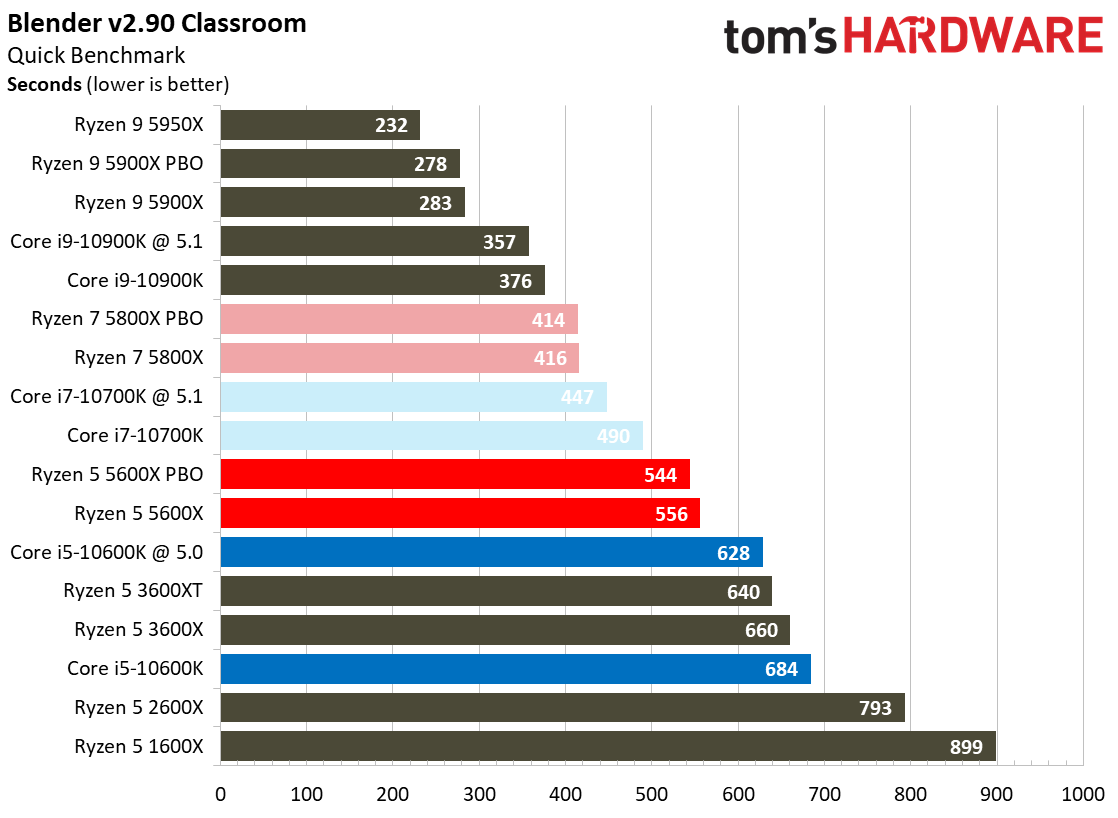
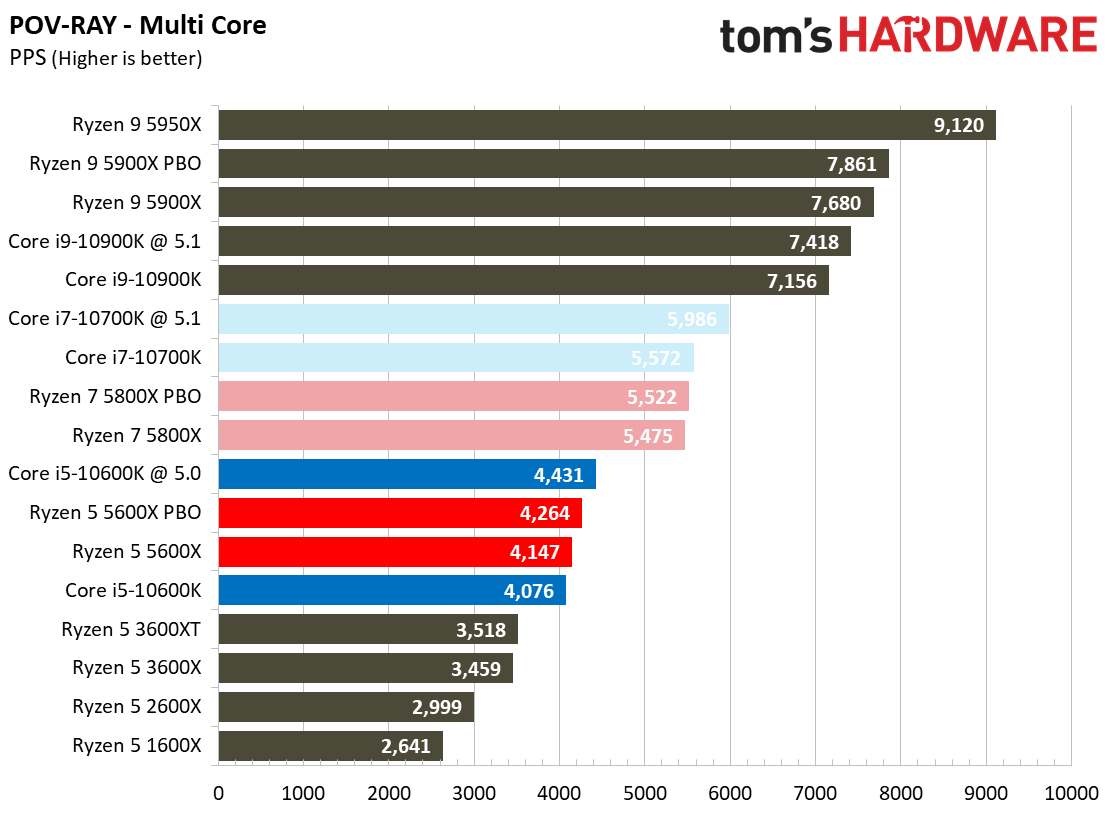
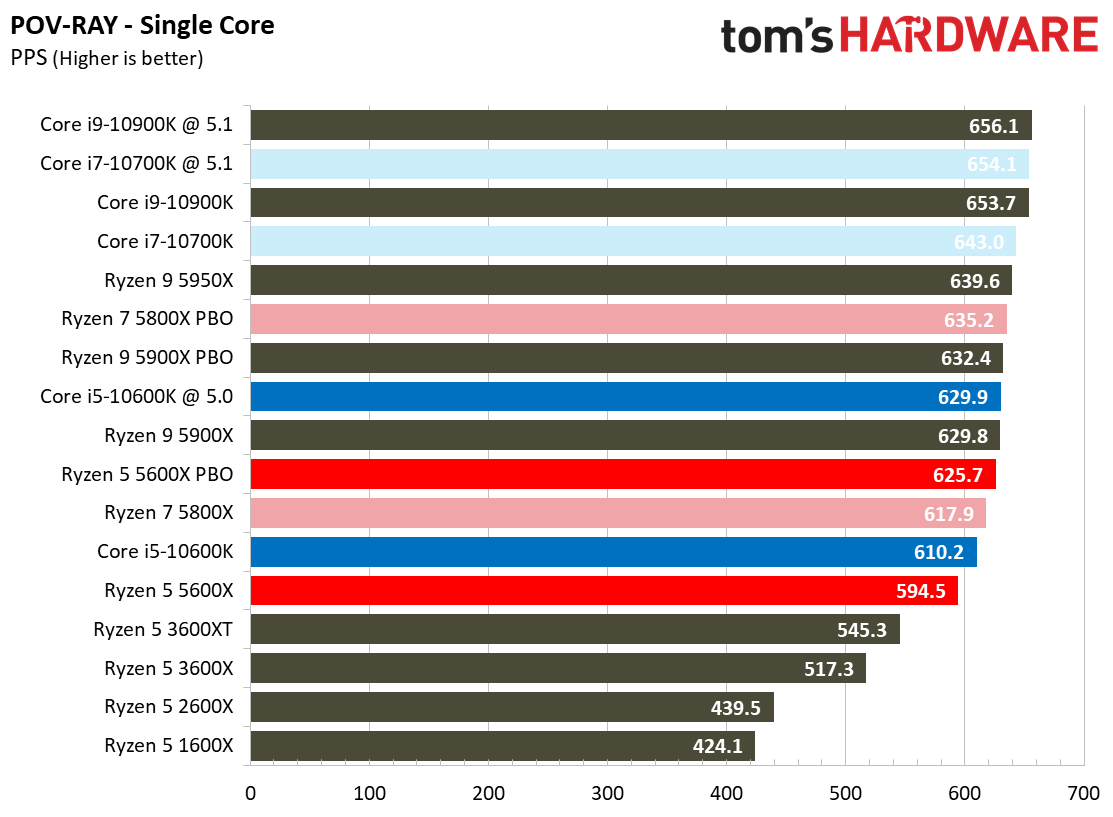
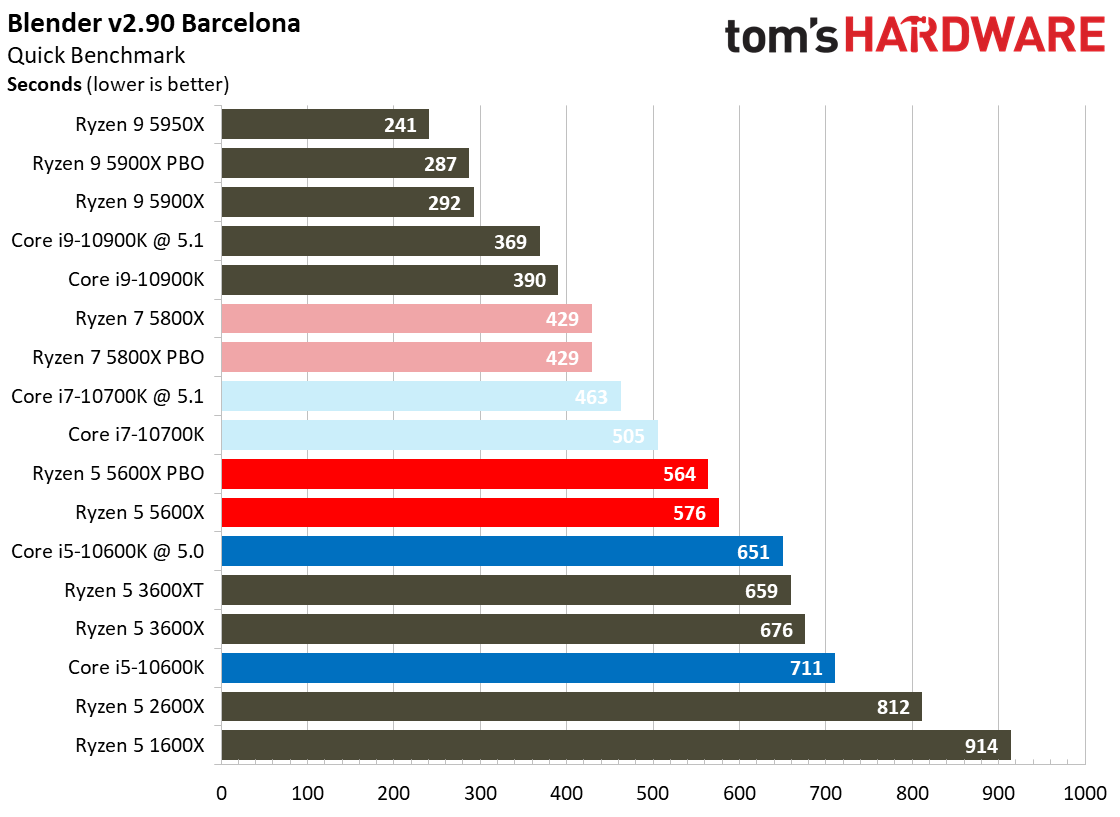
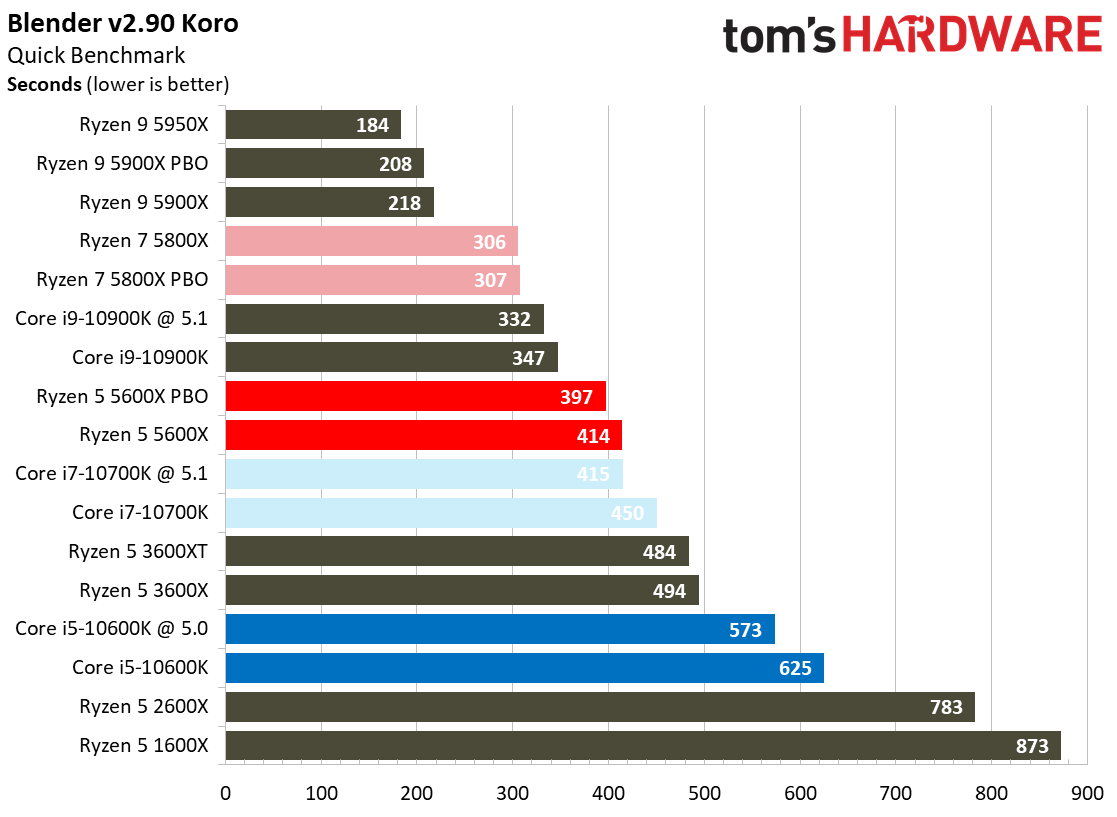
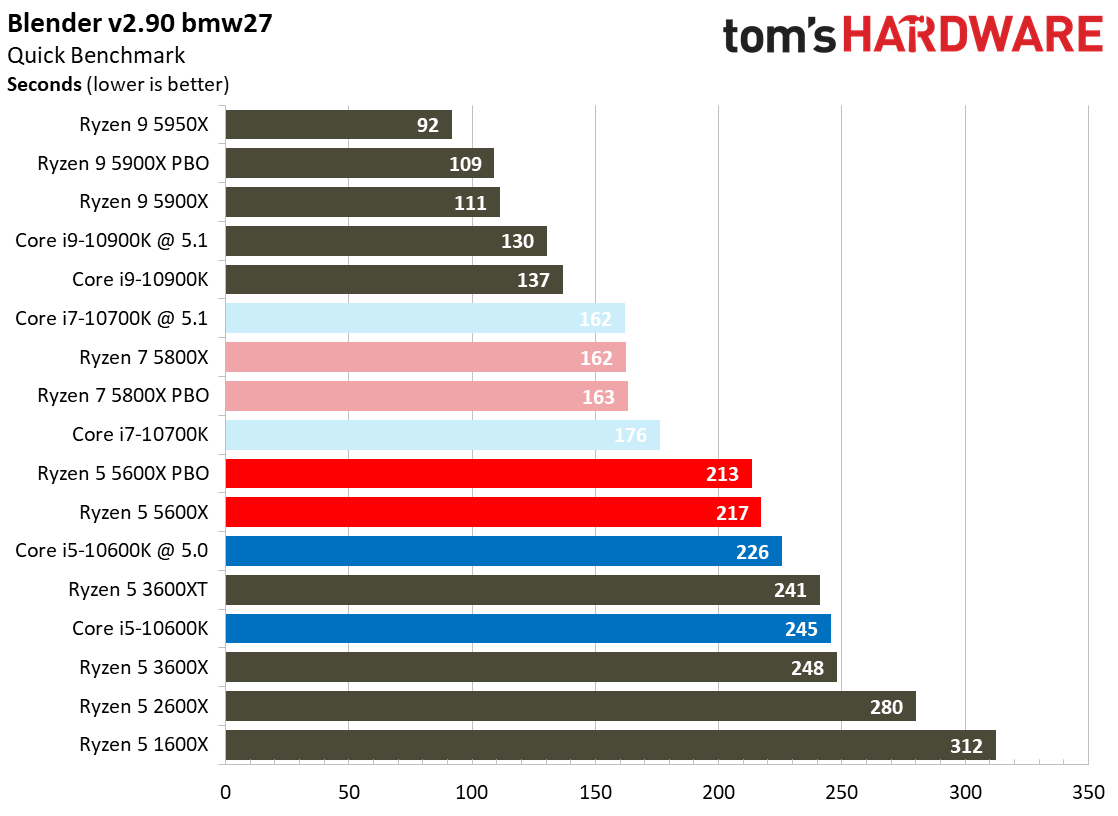
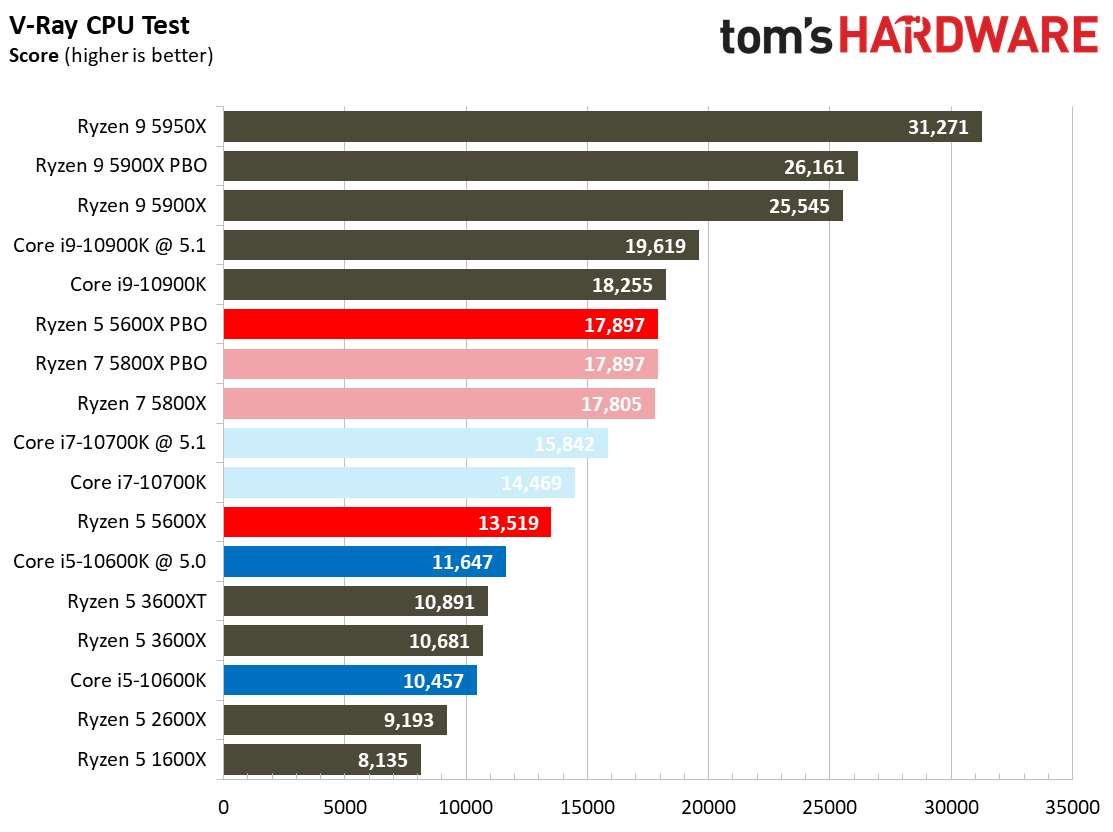
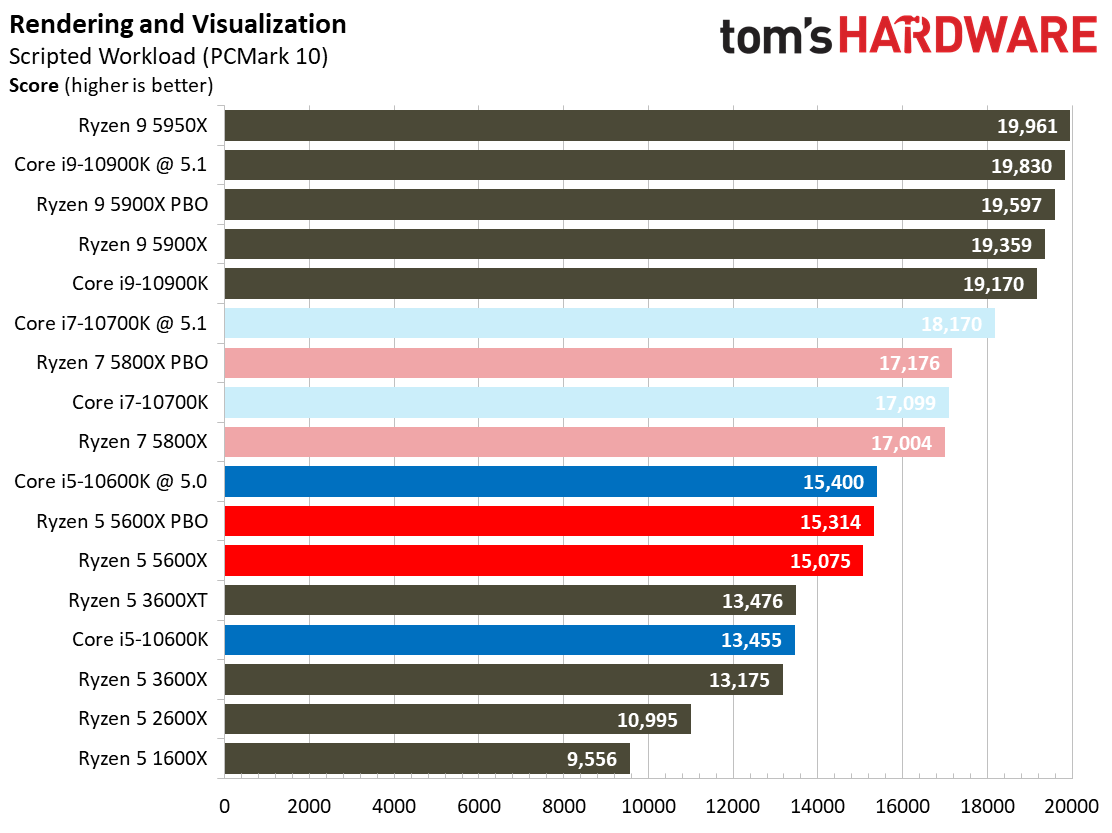
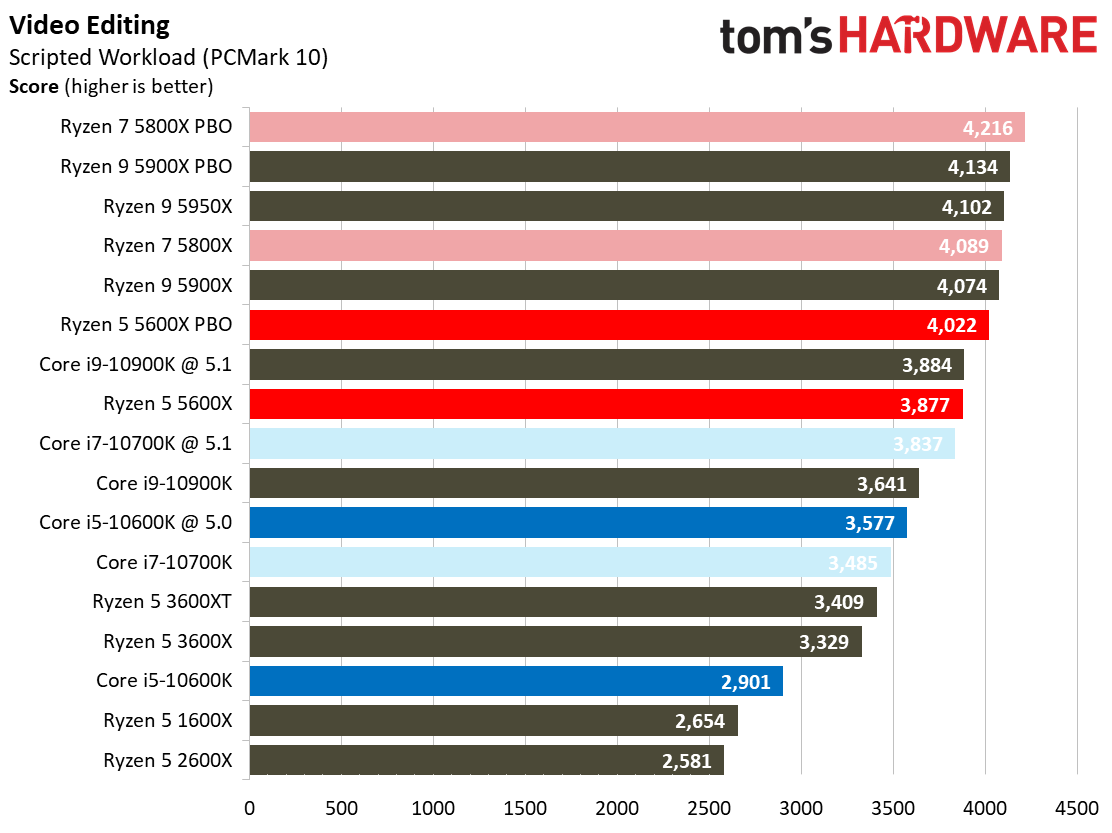
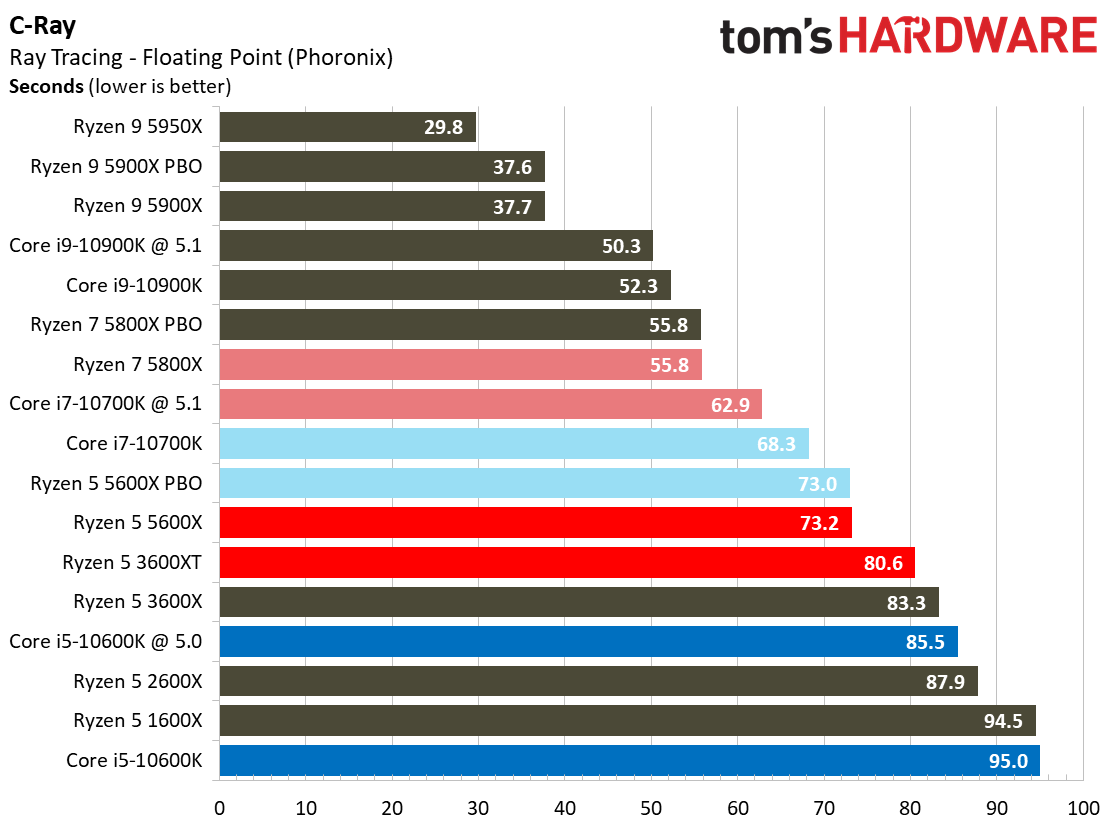
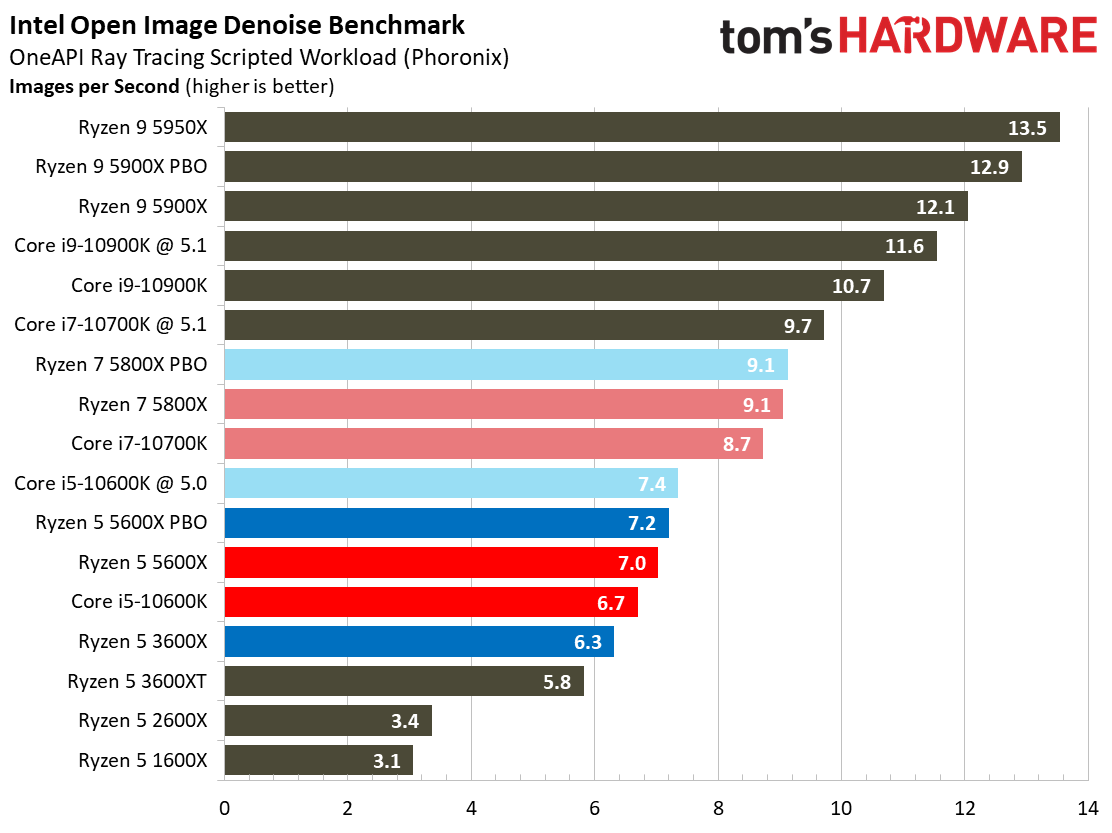
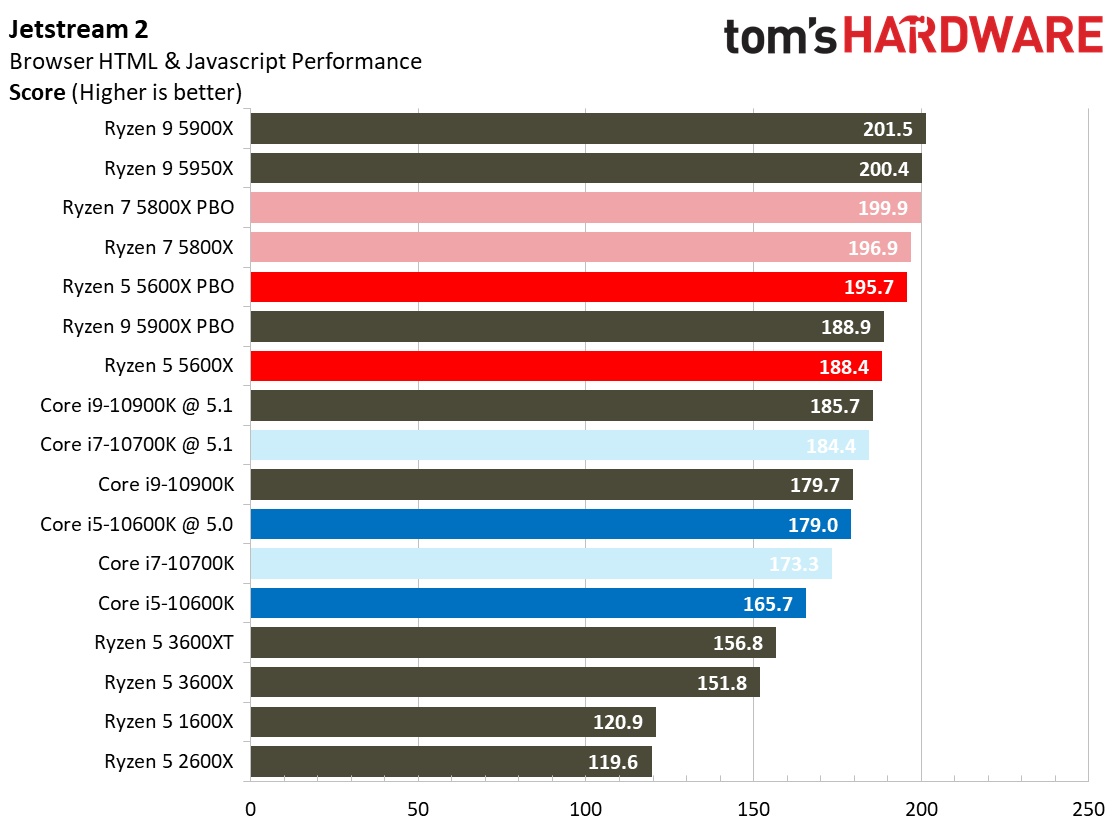
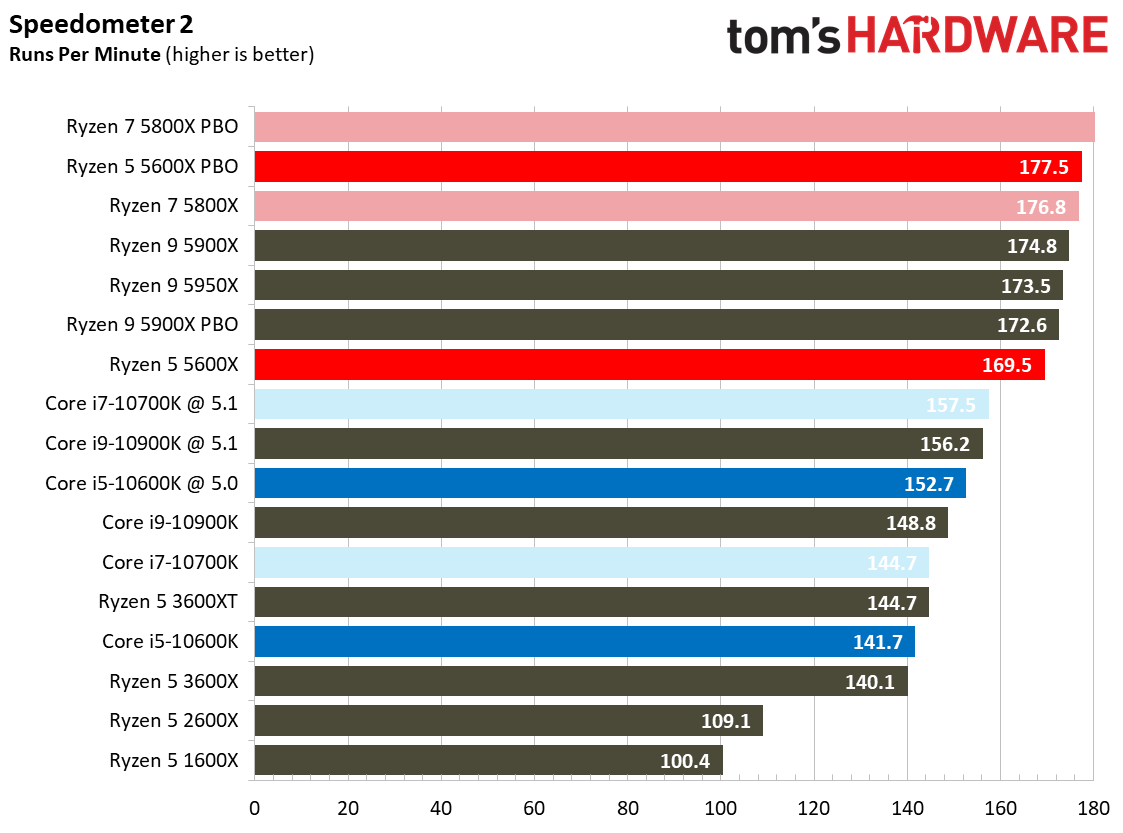
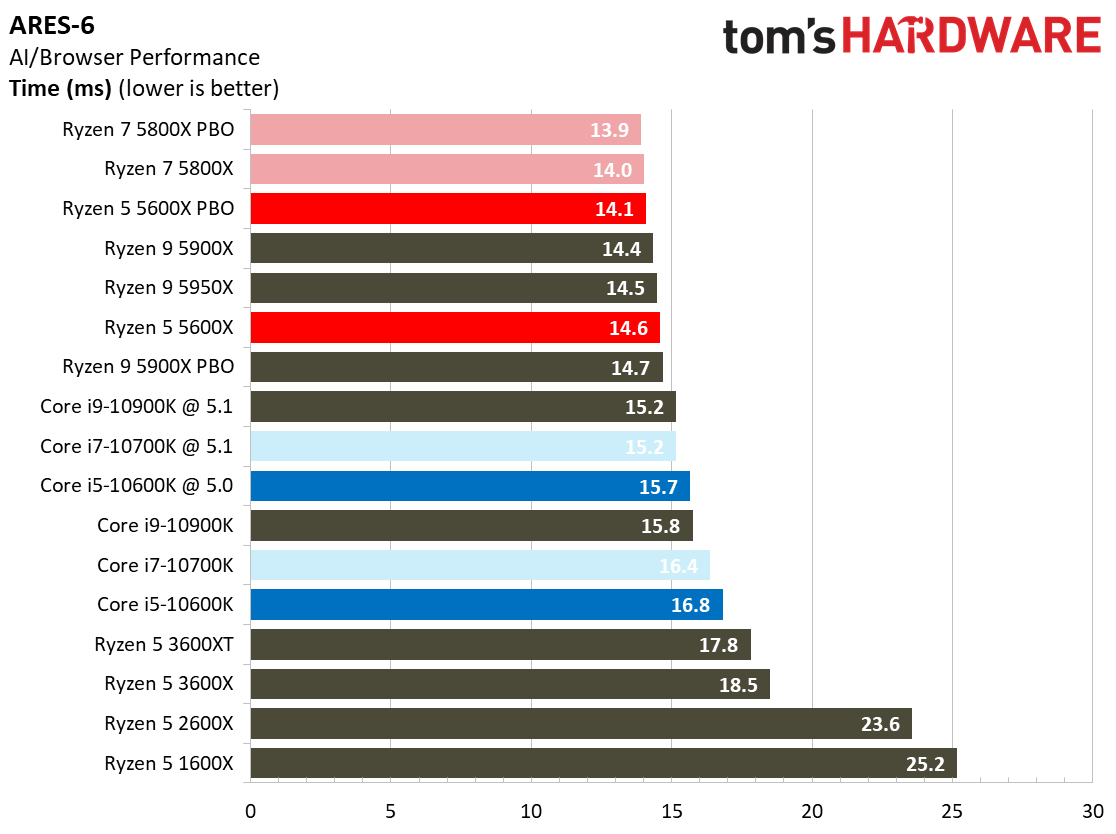
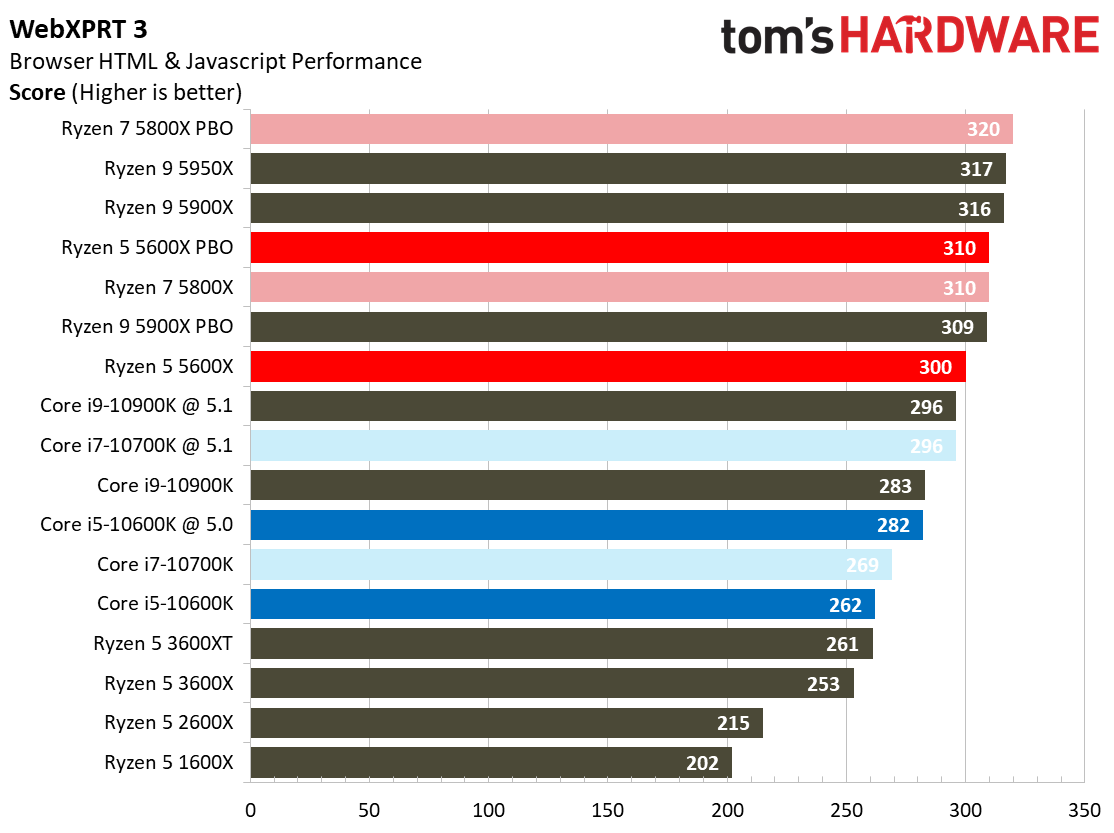
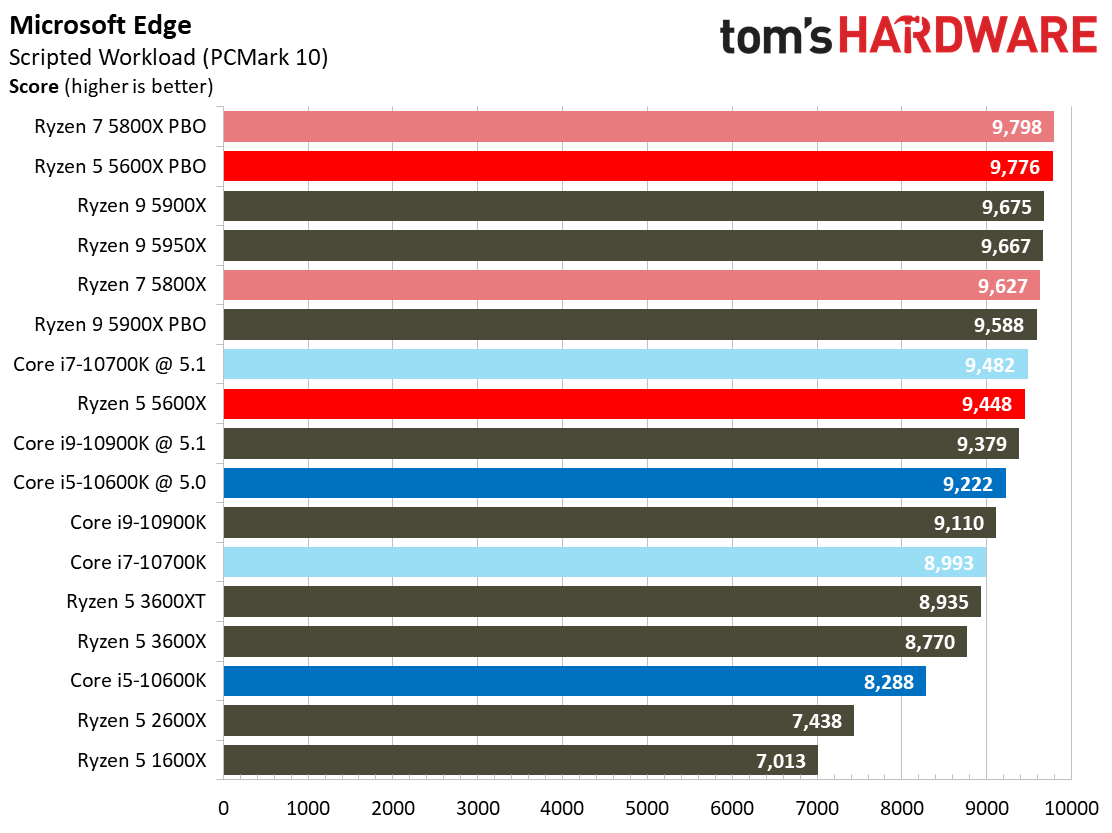
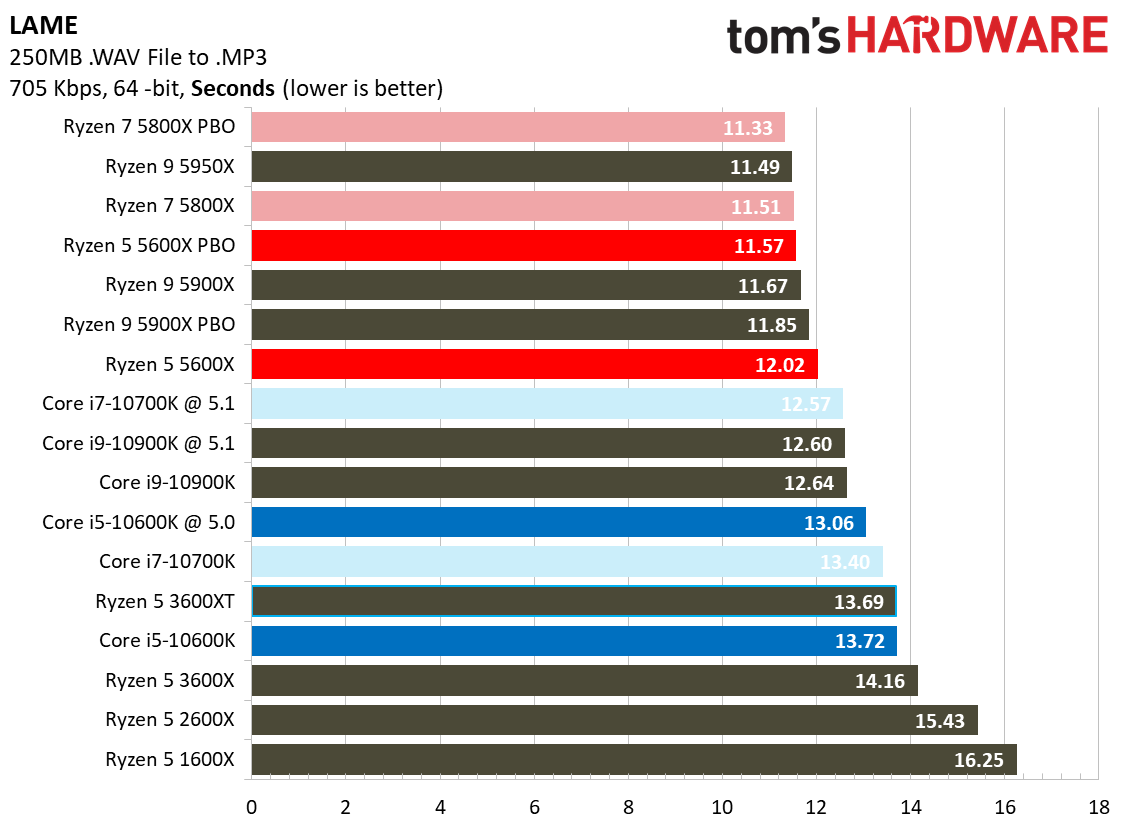
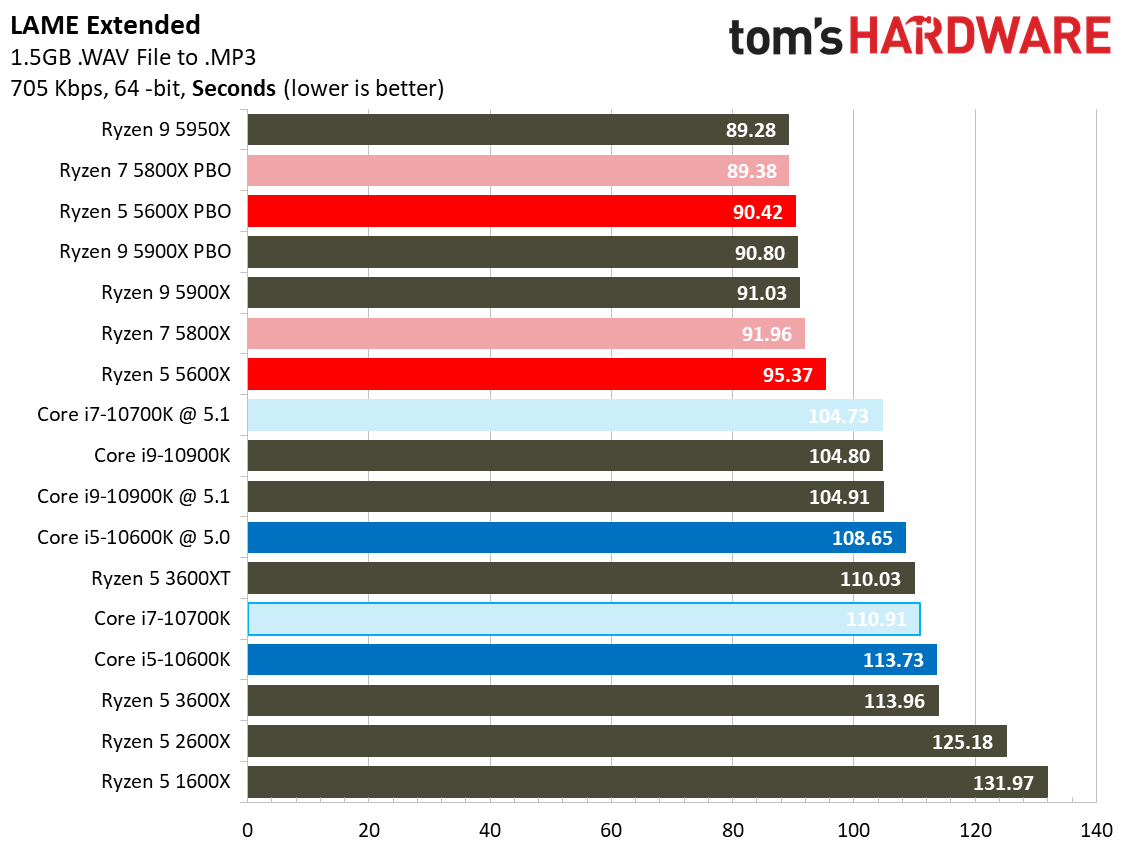
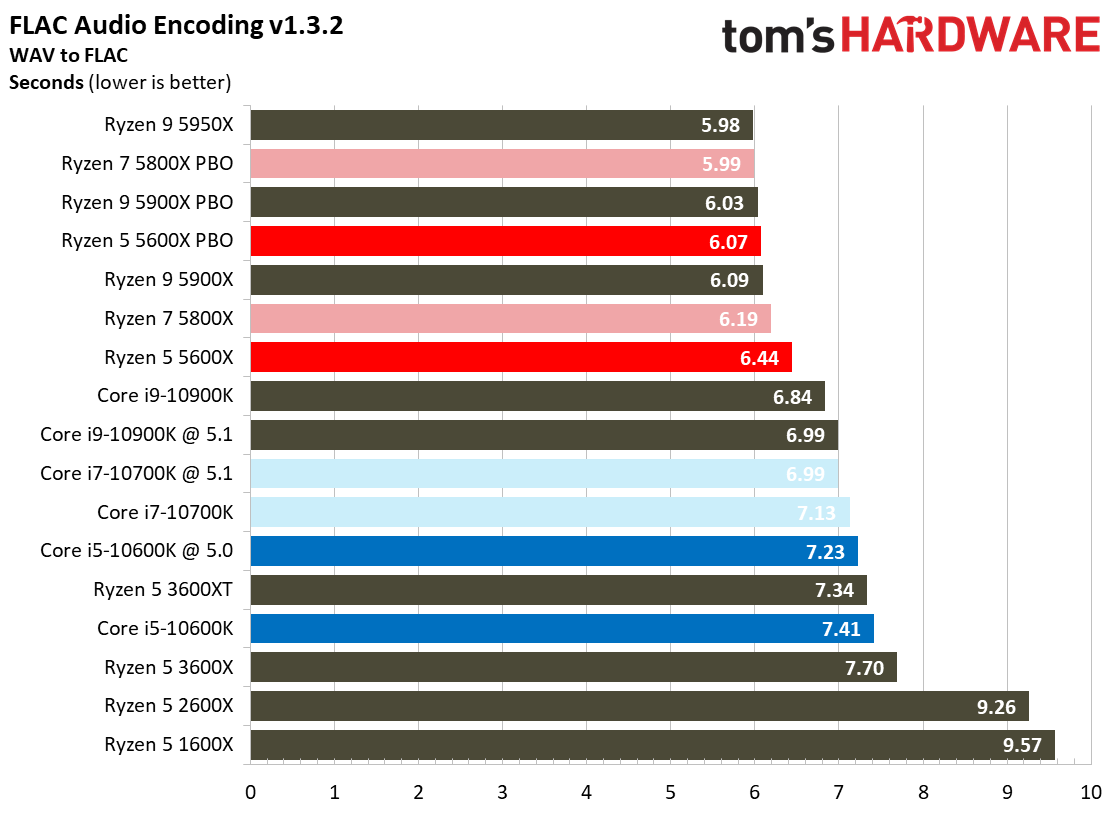
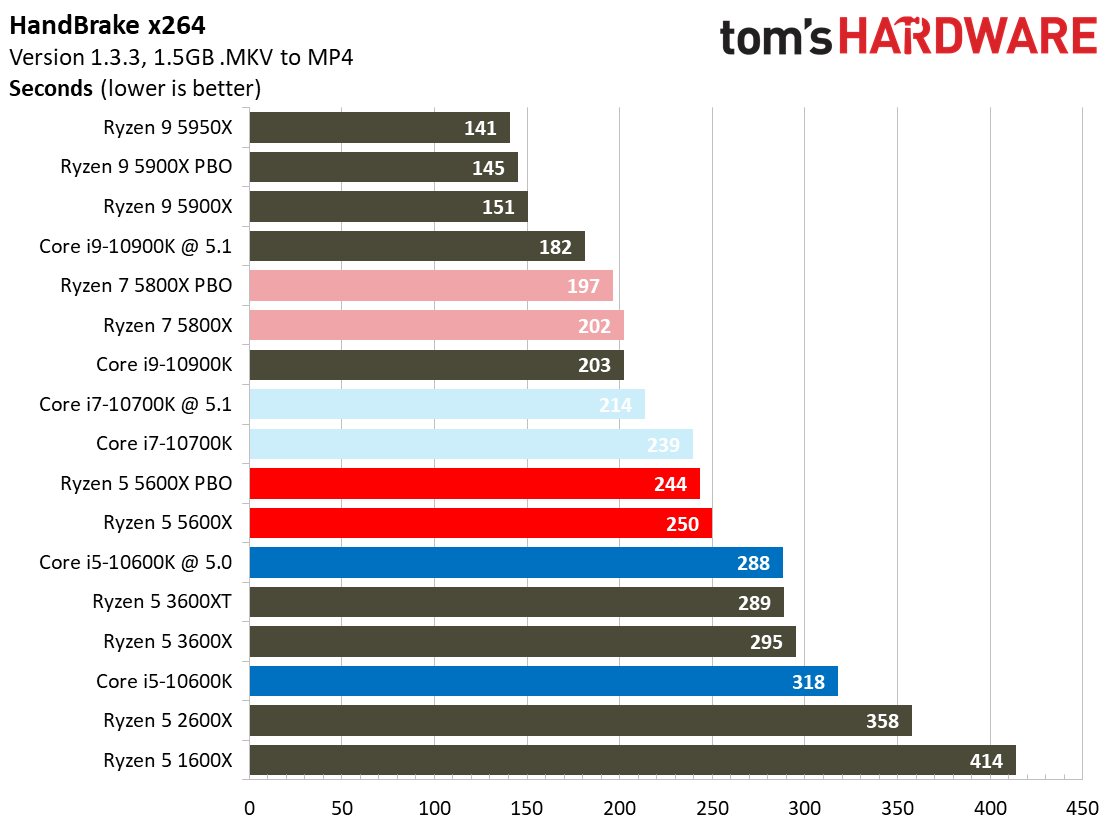
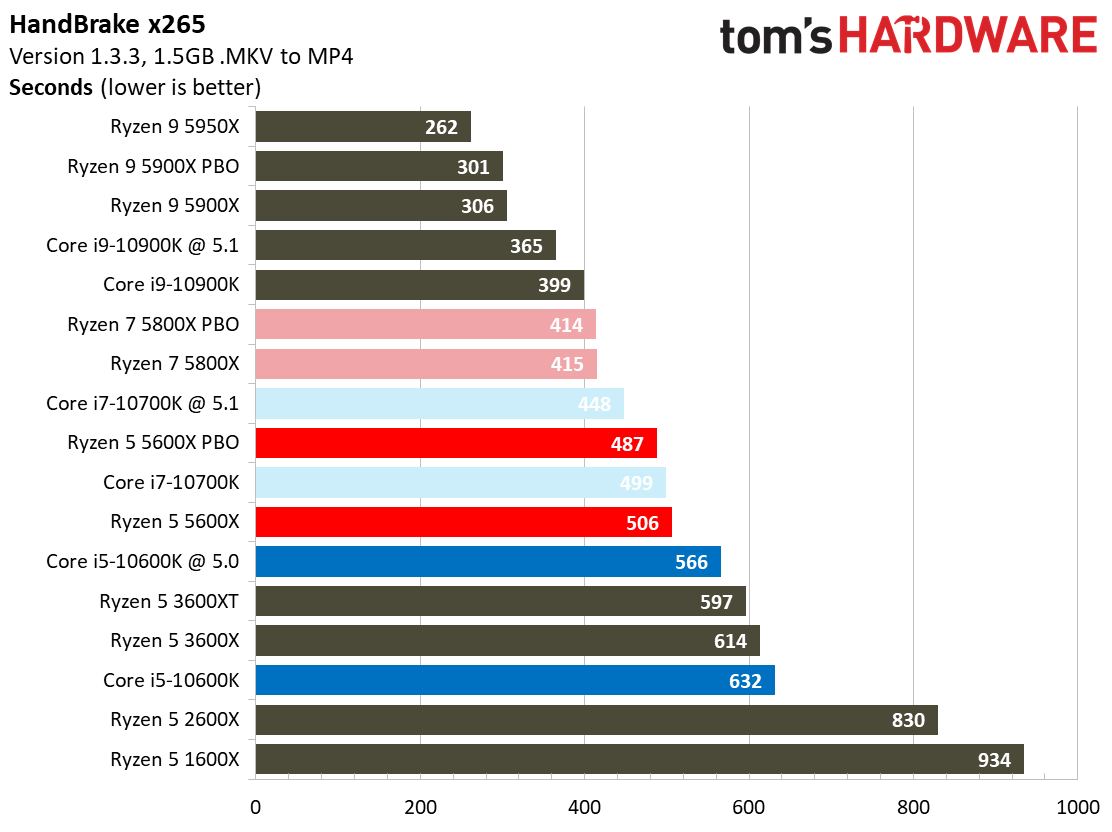
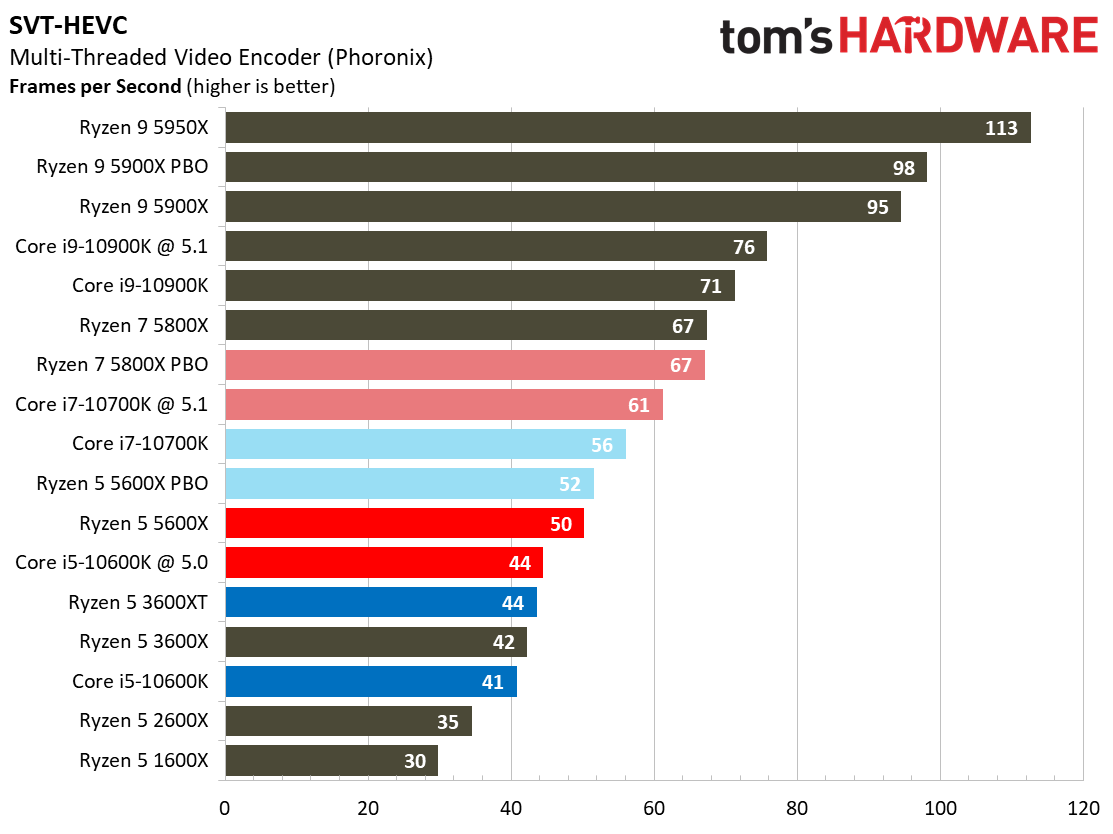
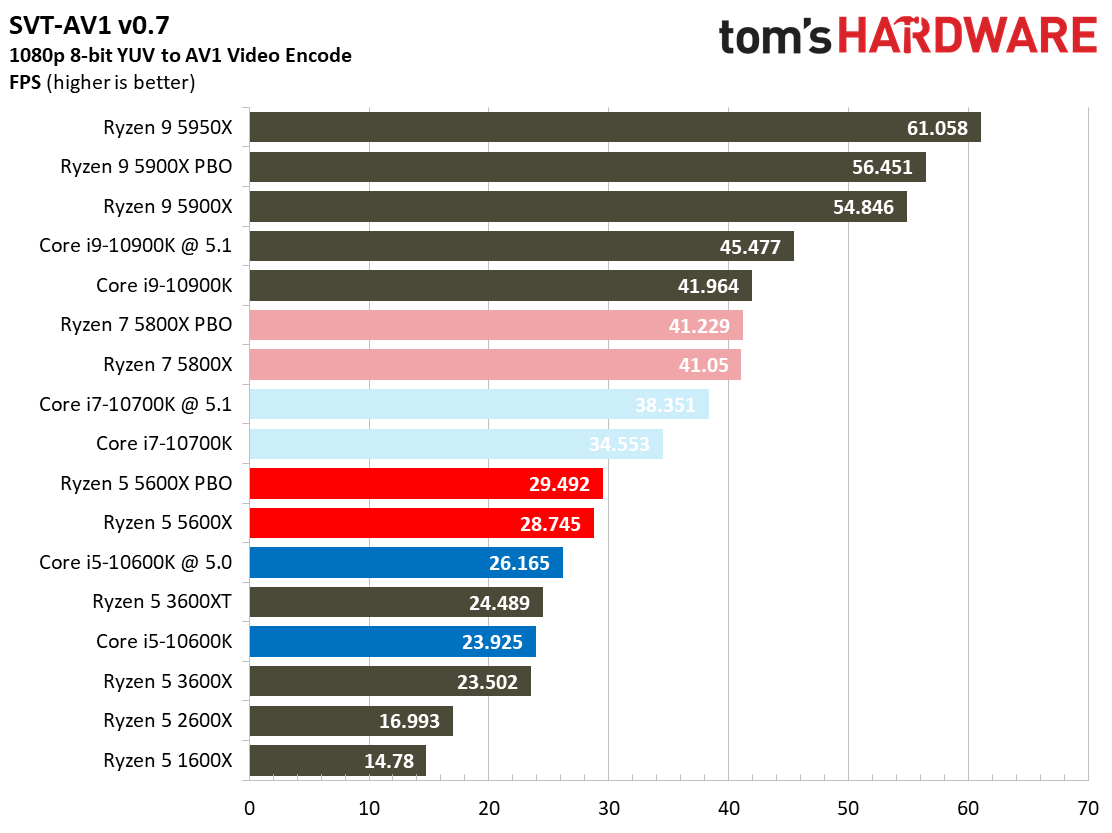
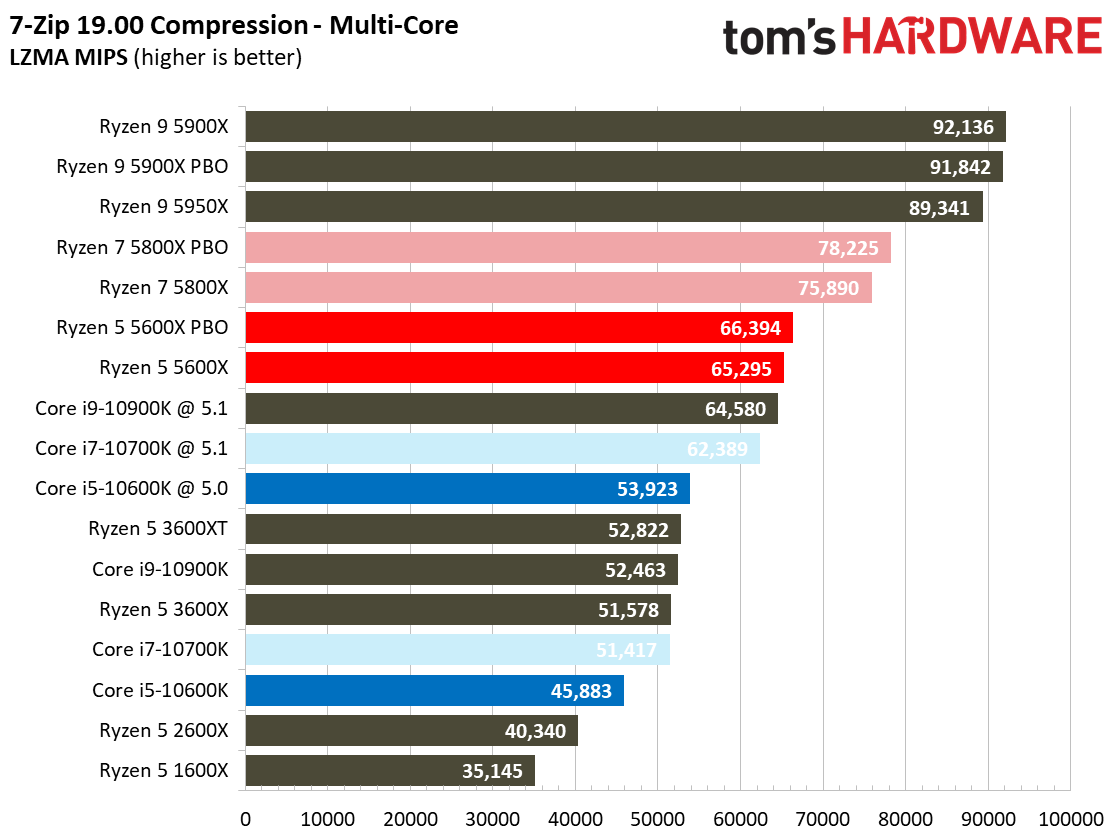
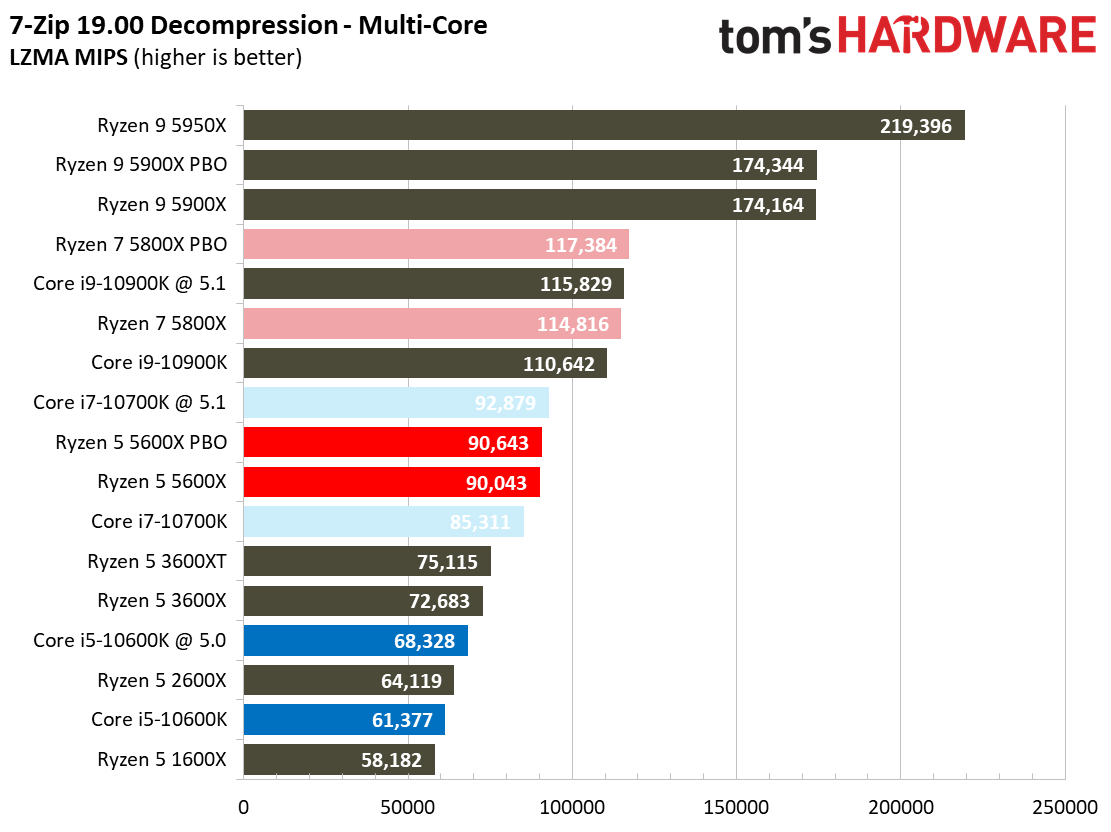
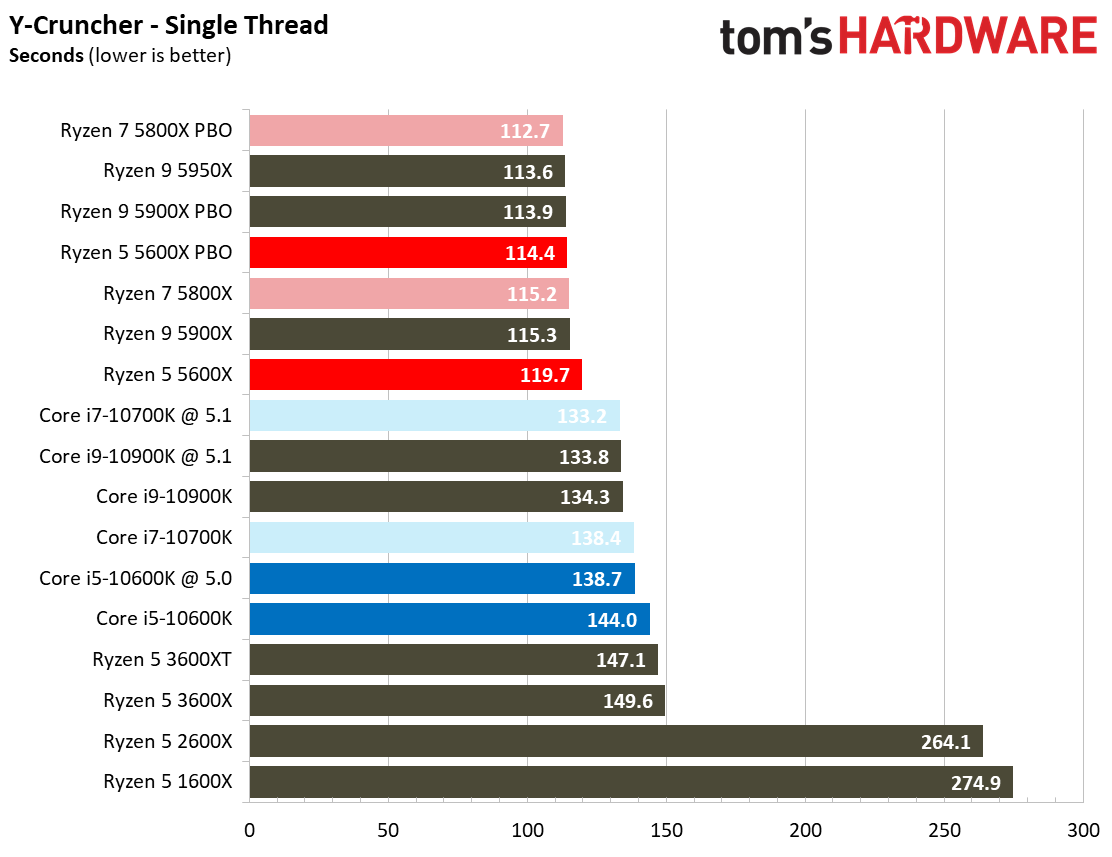
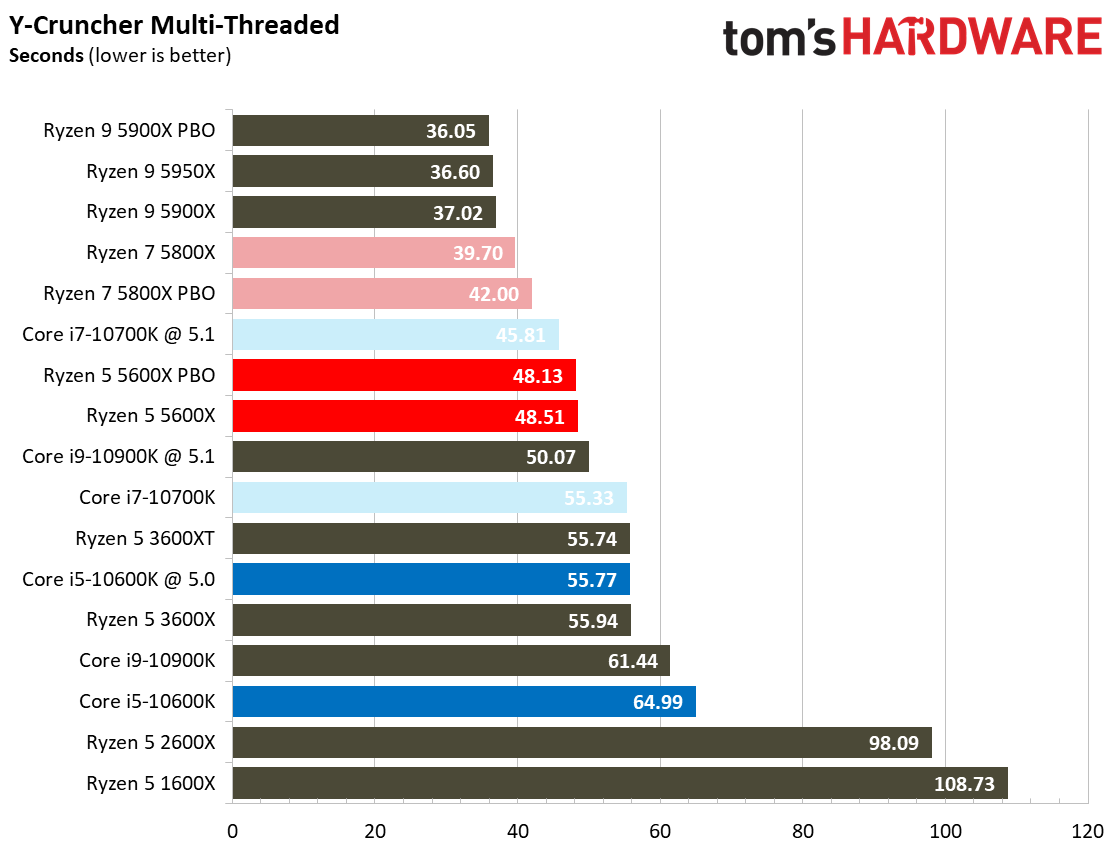
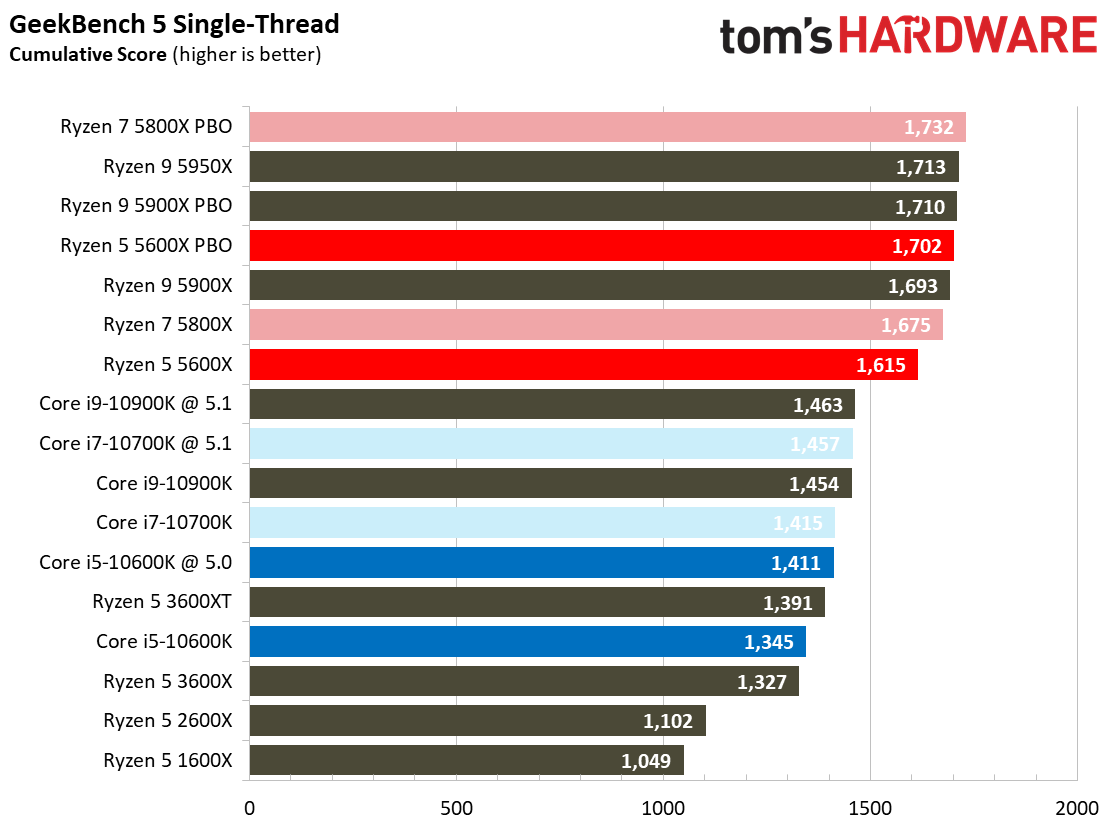
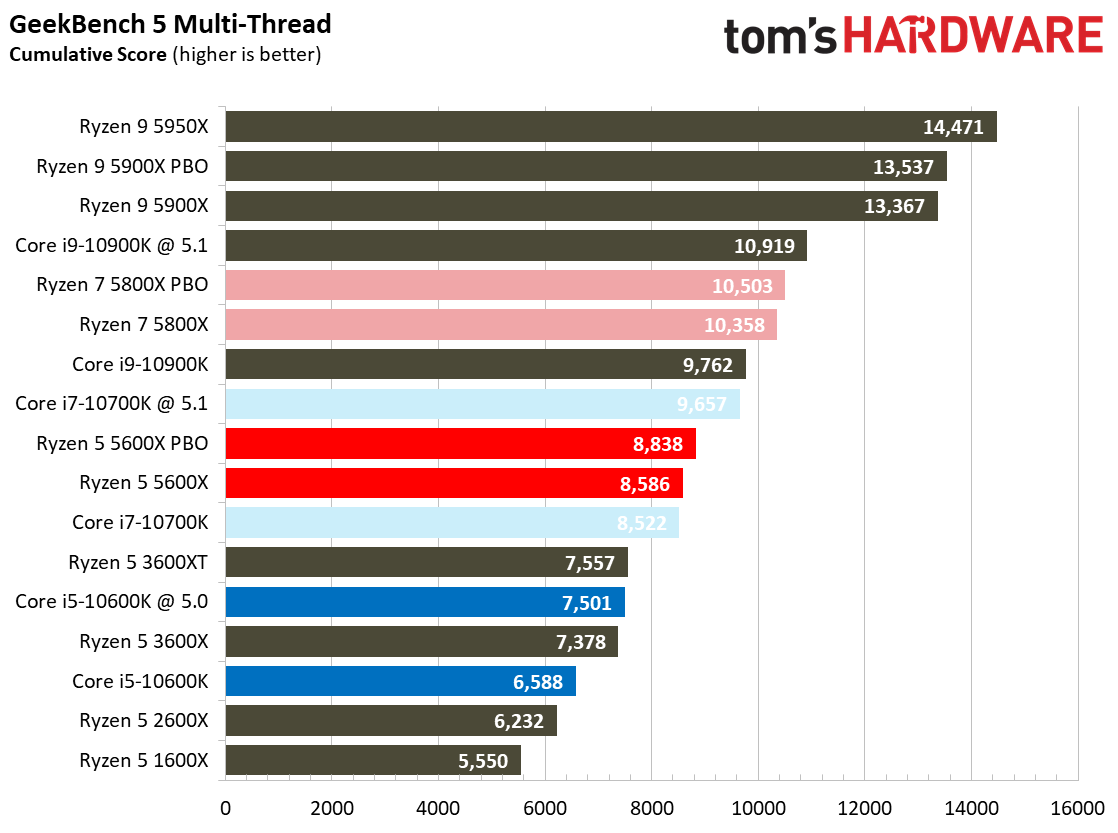
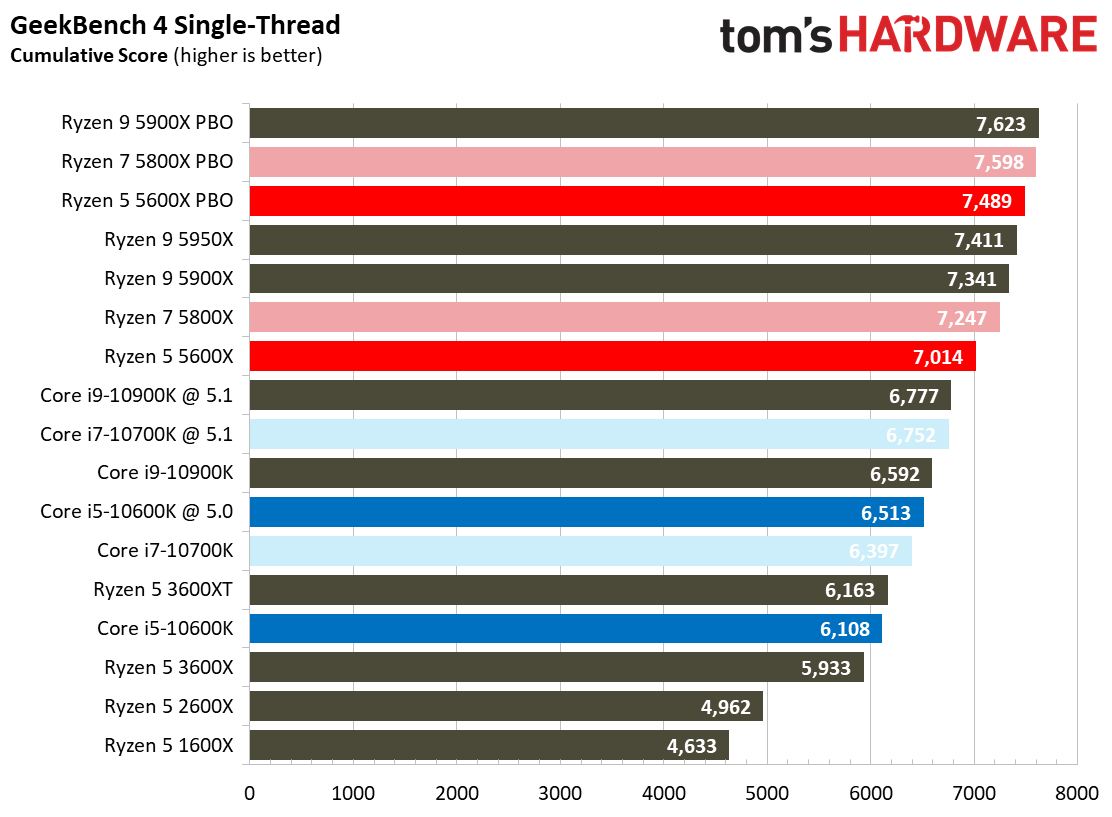
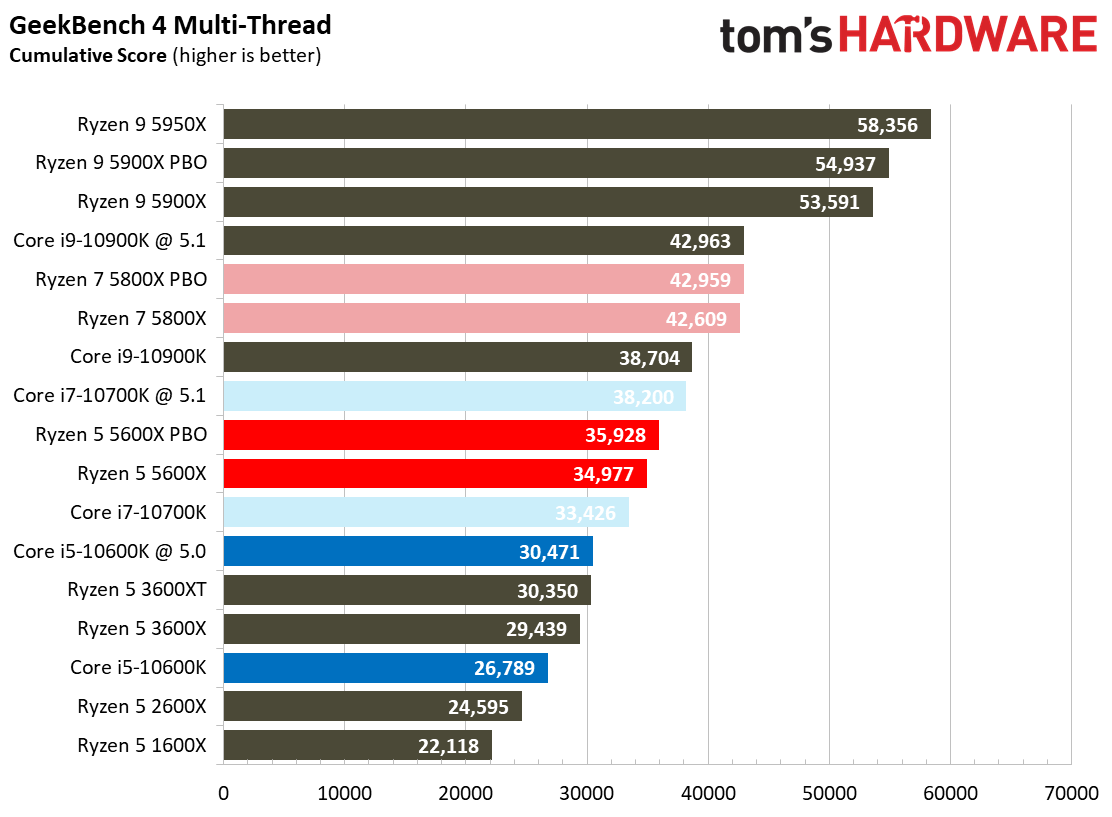
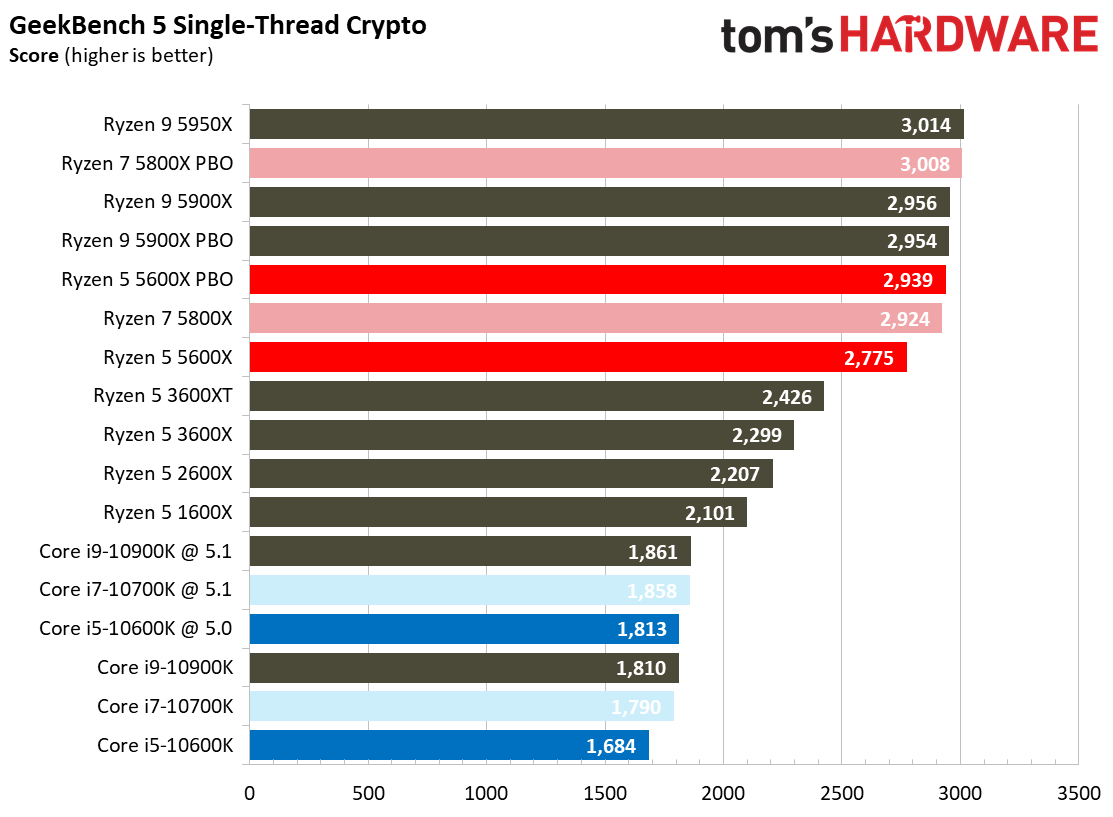
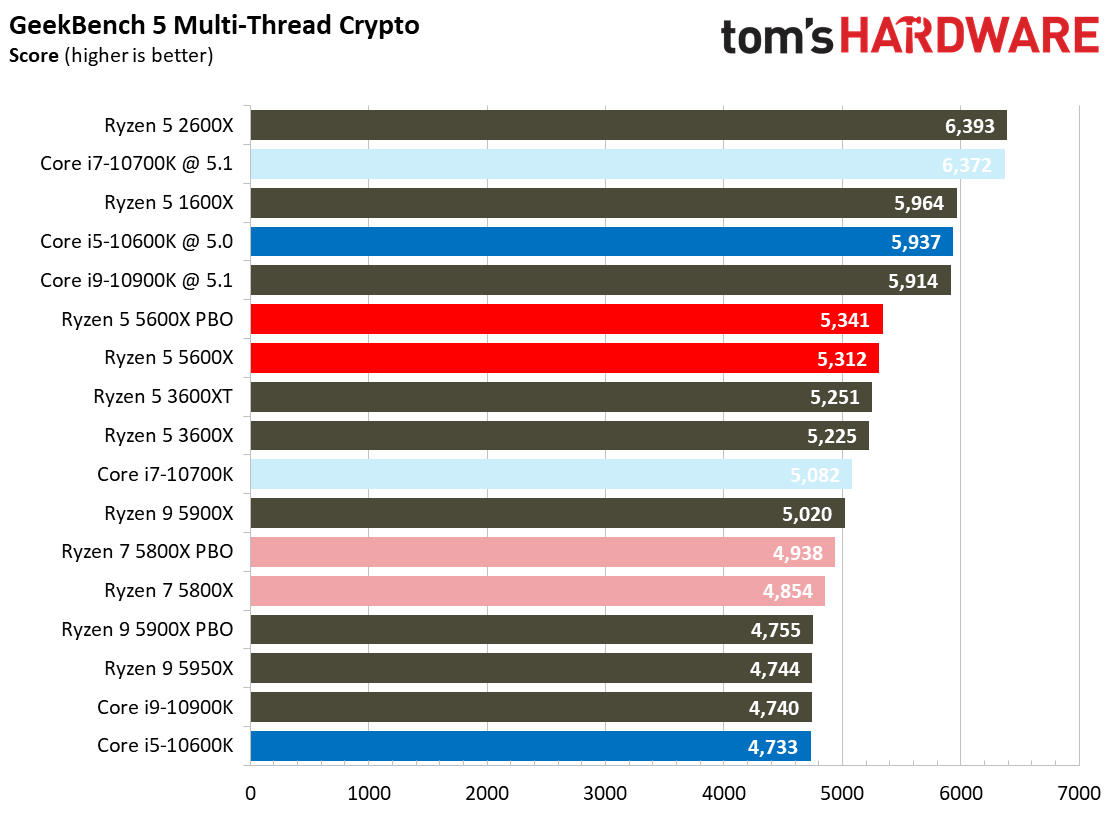
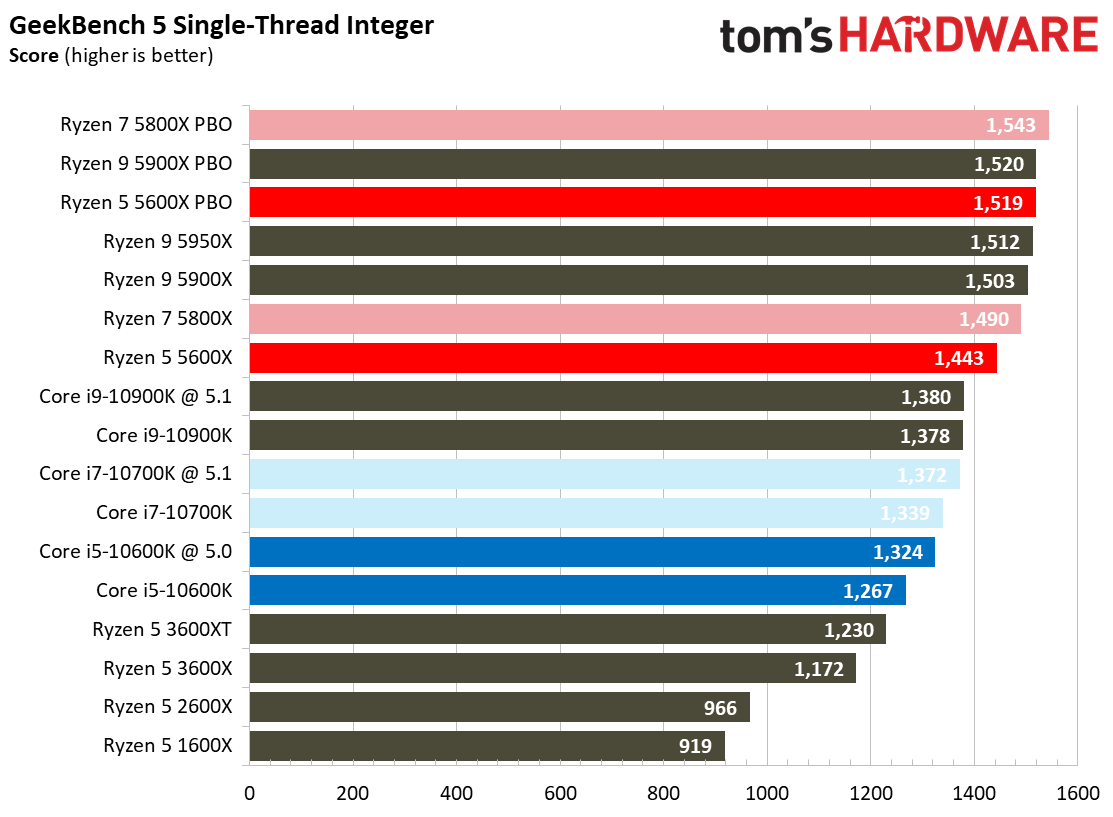
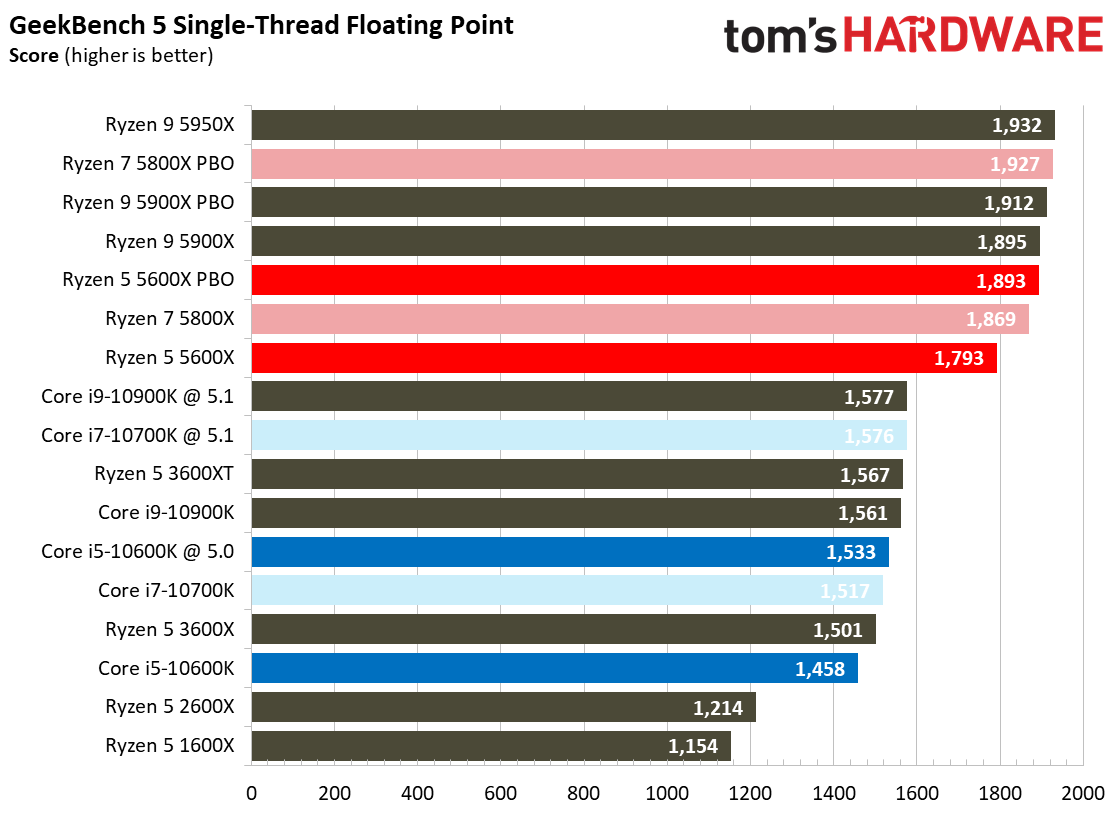
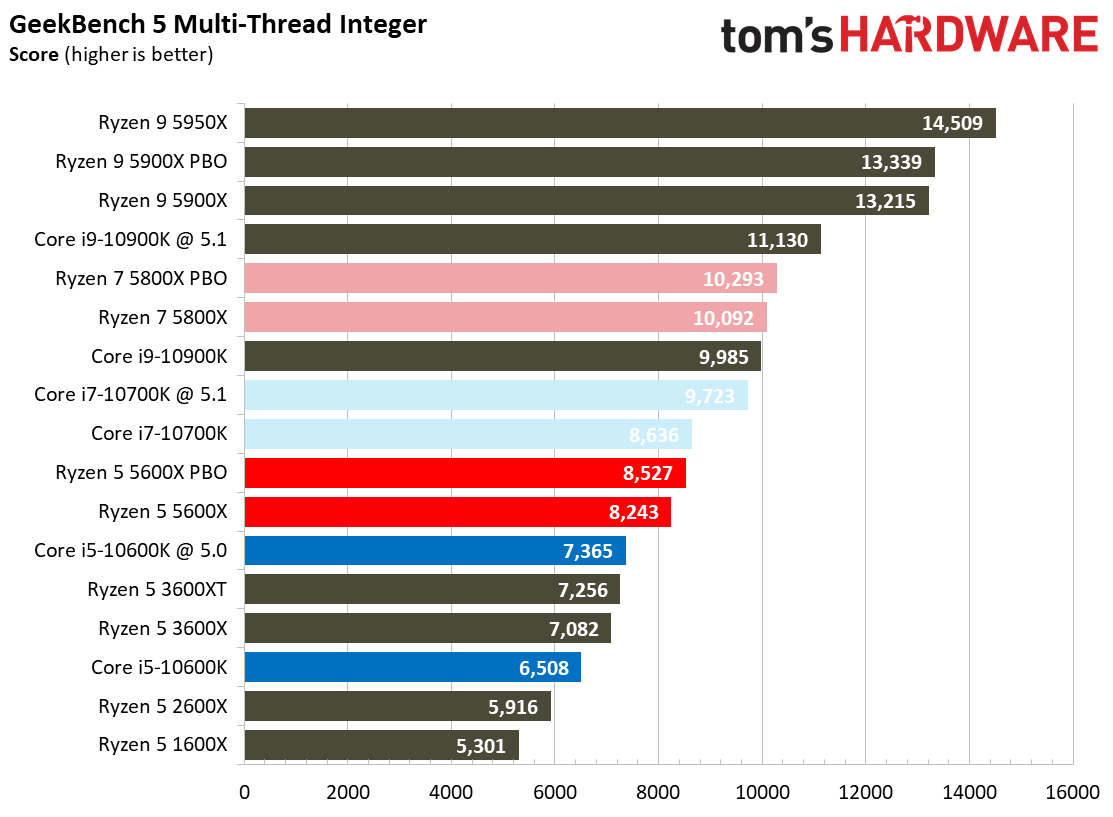
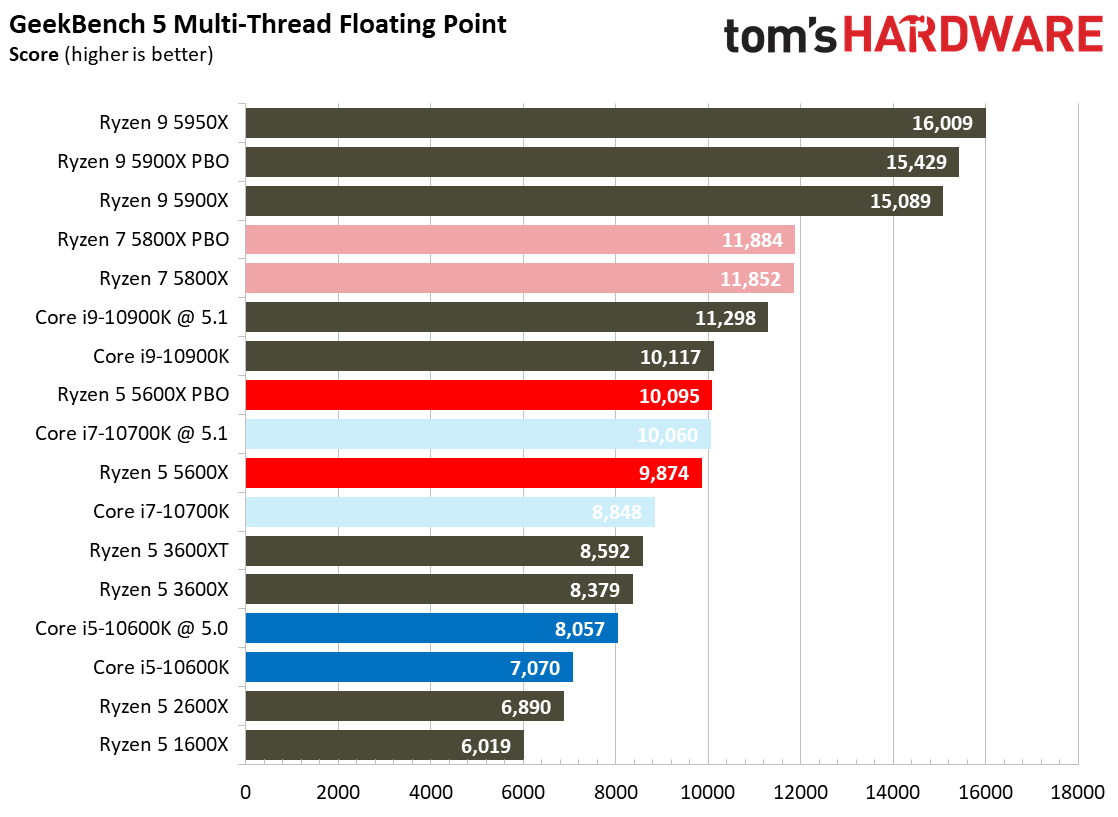
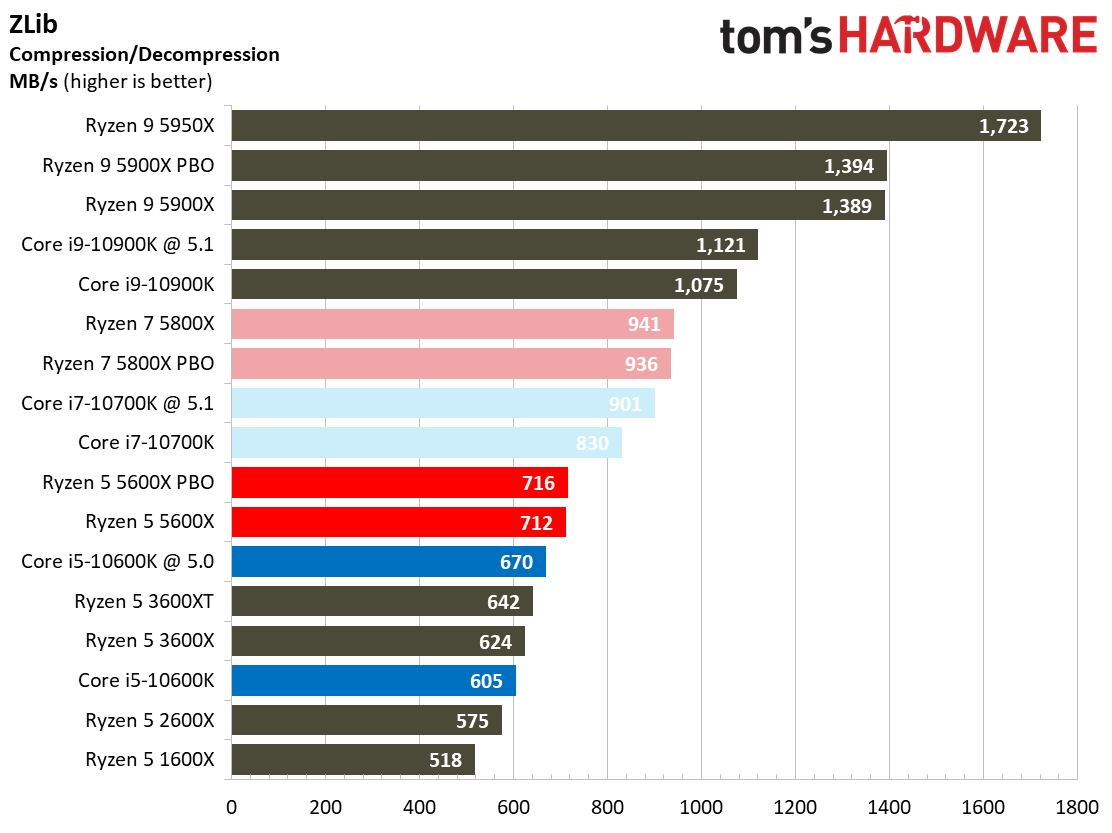
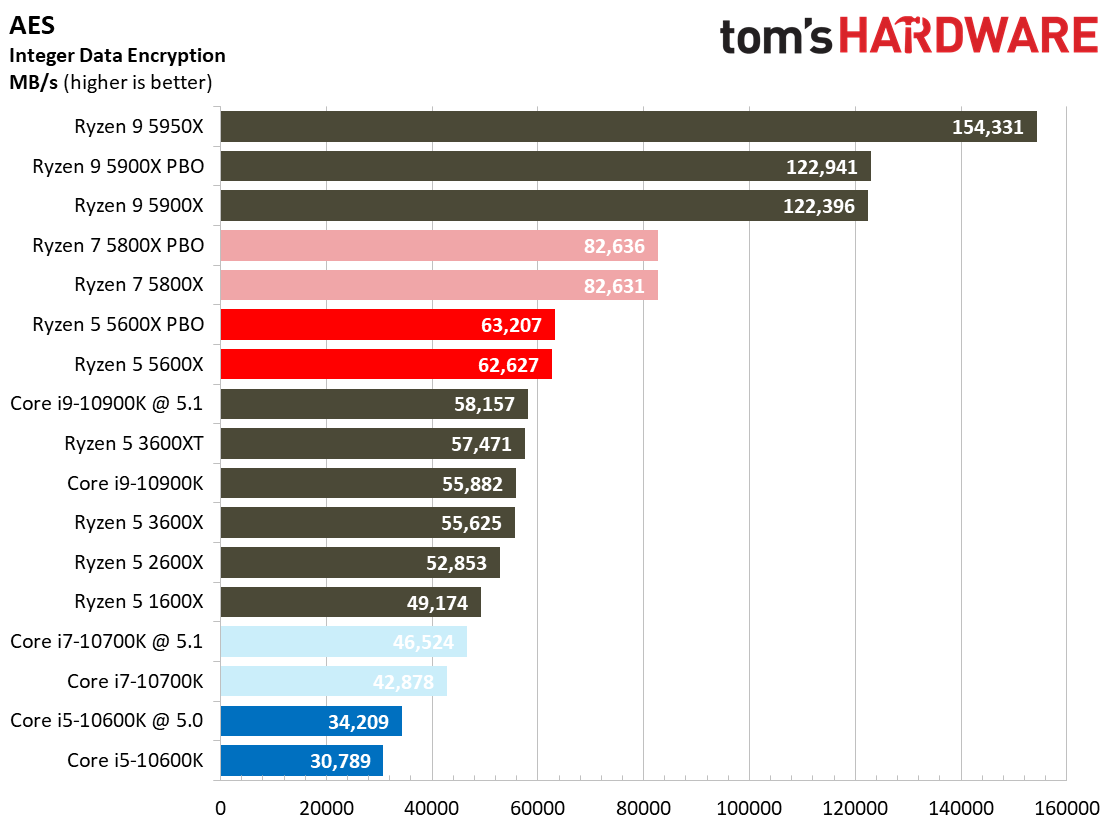
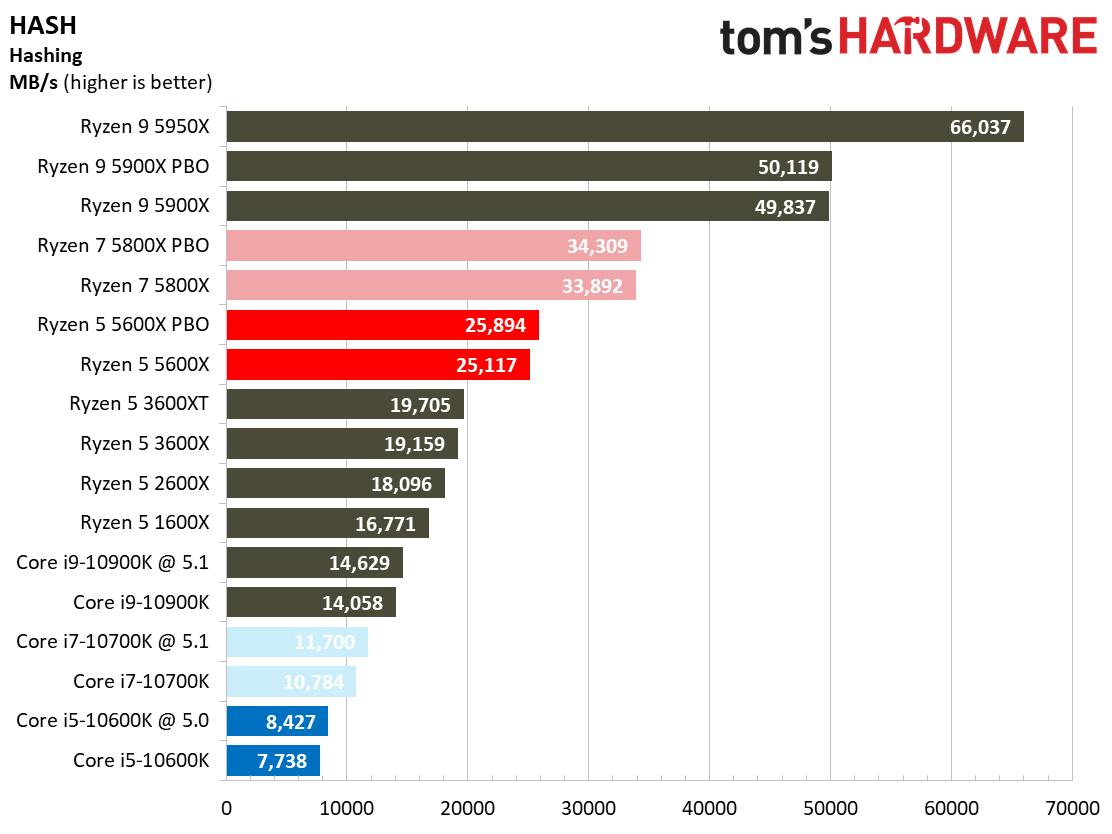
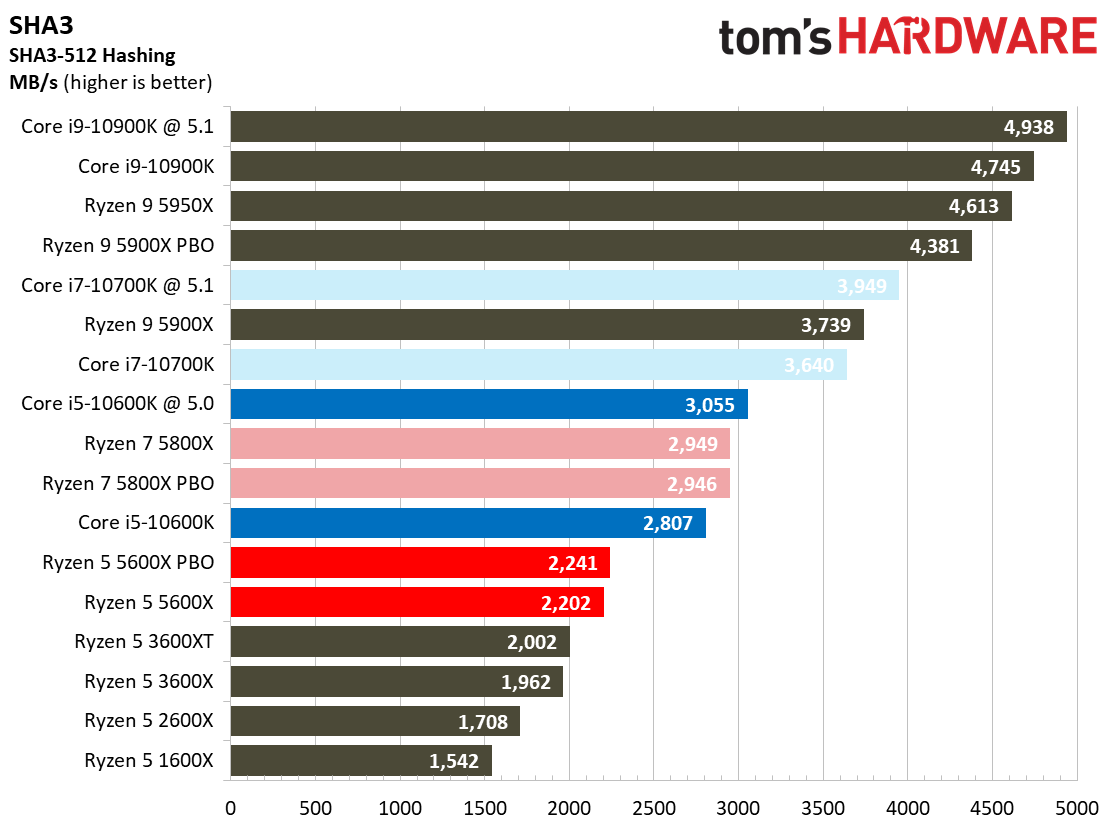
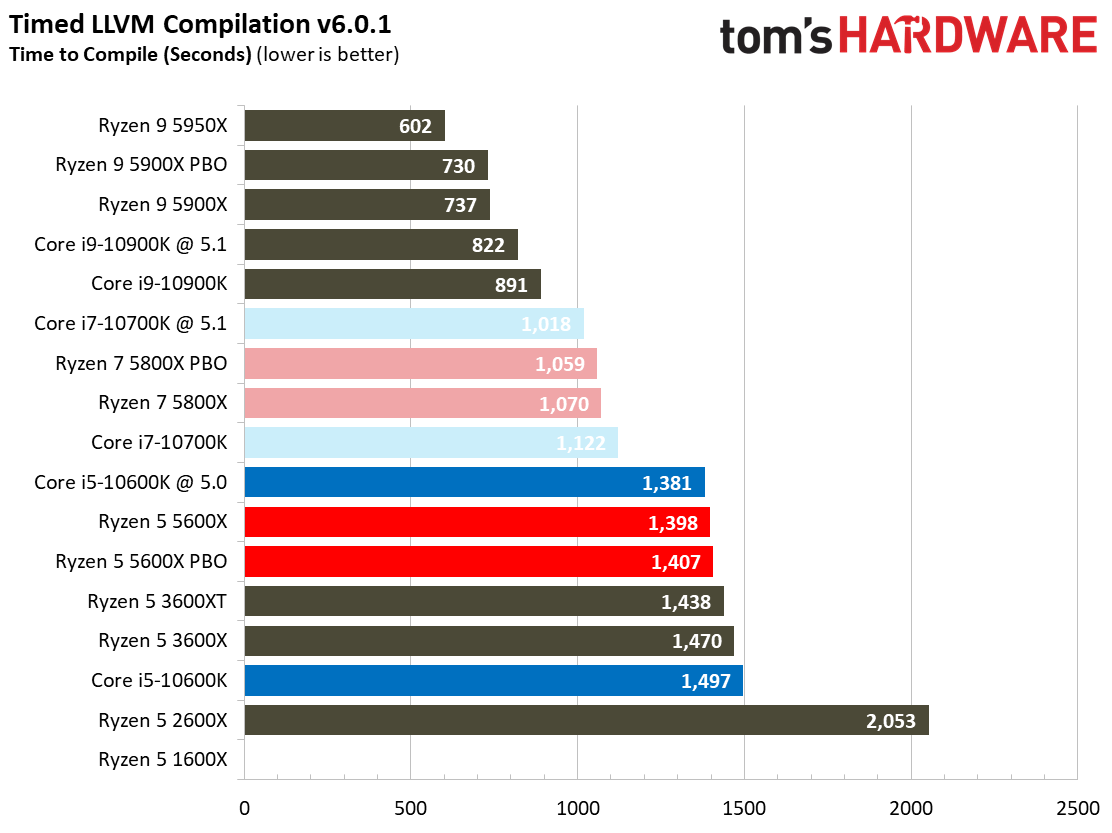
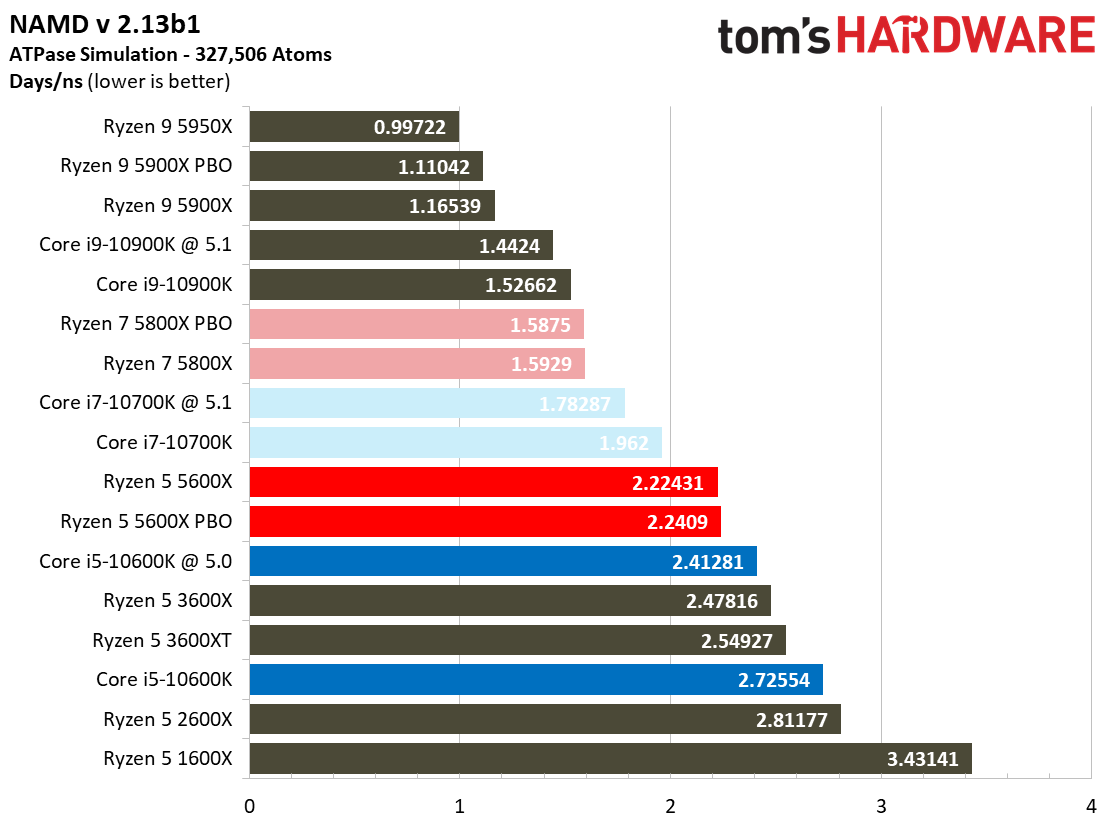
Here you can a selection of some of the most important application benchmarks, like rendering, encoding, and web browsing, but we have more analysis and far more benchmarks, including power, efficiency, thermals, and overclocking testing, in our Ryzen 5 5600X review. Stay tuned for our full Ryzen 7 5800X review, too.
AMD Zen 3 Ryzen 5000 Series Motherboards
AMD didn't launch a new chipset with the Ryzen 5000 series; instead, the CPUs drop right into existing 500-series chipsets, like X570, B550 and A520 models. These boards require an AGESA 1.0.8.0 (or newer) BIOS to boot a Zen 3 processor, but AMD has been shipping silently shipping supporting BIOSes since summer. As a result, every 500-series motherboard on the market should have a downloadable BIOS available.
While the early BIOS revisions ensure the processors will work on the most basic level, you'll have to update to an AGESA 1.1.0.0 (or better) BIOS for the best performance. These revisions are available for all 500-series motherboards. Many motherboard vendors are also distributing newer BIOS revisions with enhanced functionality.
AMD originally announced it wouldn't provide Zen 3 support for 400-series motherboards, but due to concerns from the enthusiast community, the company reversed course. Now AMD will also provide support for 400-series chipsets, but the BIOS updates are under development, and the first beta BIOSes will be officially available in January of 2021. That hasn't stopped several vendors from offering the leading versions of the new BIOS, which you can already find in the wild.
However, a series of important restrictions apply to 400-series upgraders, which you can read more about here. Note: You lose support for PCIe 4.0 on 400-series boards, but most gamers will not, and should not, care — PCIe 4.0 makes no meaningful performance difference in gaming.
AMD Ryzen 5000 Series Pricing and Availability
The Ryzen 5000 series are available now, but the chips have been subject to severe shortages, leading to price gouing. Here's some advice on how to score a chip. Fortunately, prices have been on the rebound for the Ryzen 7 5800X and Ryzen 5 5600X, and supply continues to improve.
We also expect to eventually hear about Threadripper 5000 products with the Zen 3 architecture, but we aren't sure when AMD will bring the new design to its ultra-powerful high end desktop (HEDT) lineup. AMD will also update its APUs with the Zen 3 architecture, but we aren't sure of the timeline for that advance.
The Zen 3 Ryzen 5000 processors do come with a recommended $50 markup across the product stack. AMD's suggested pricing often has little to do with what we see at retail; you can expect the CPUs to eventually retail for far lower pricing, particularly as supply improves.
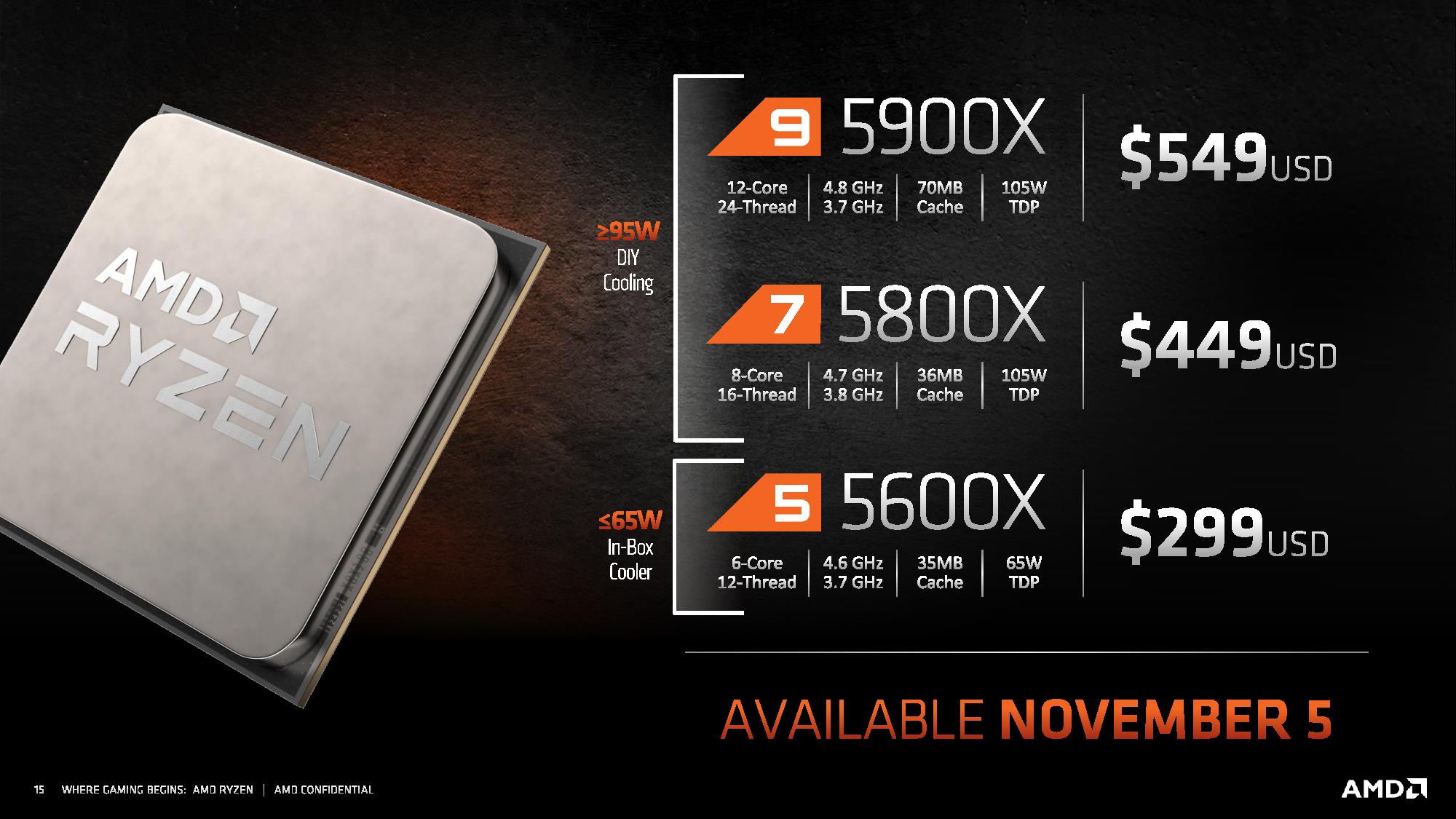
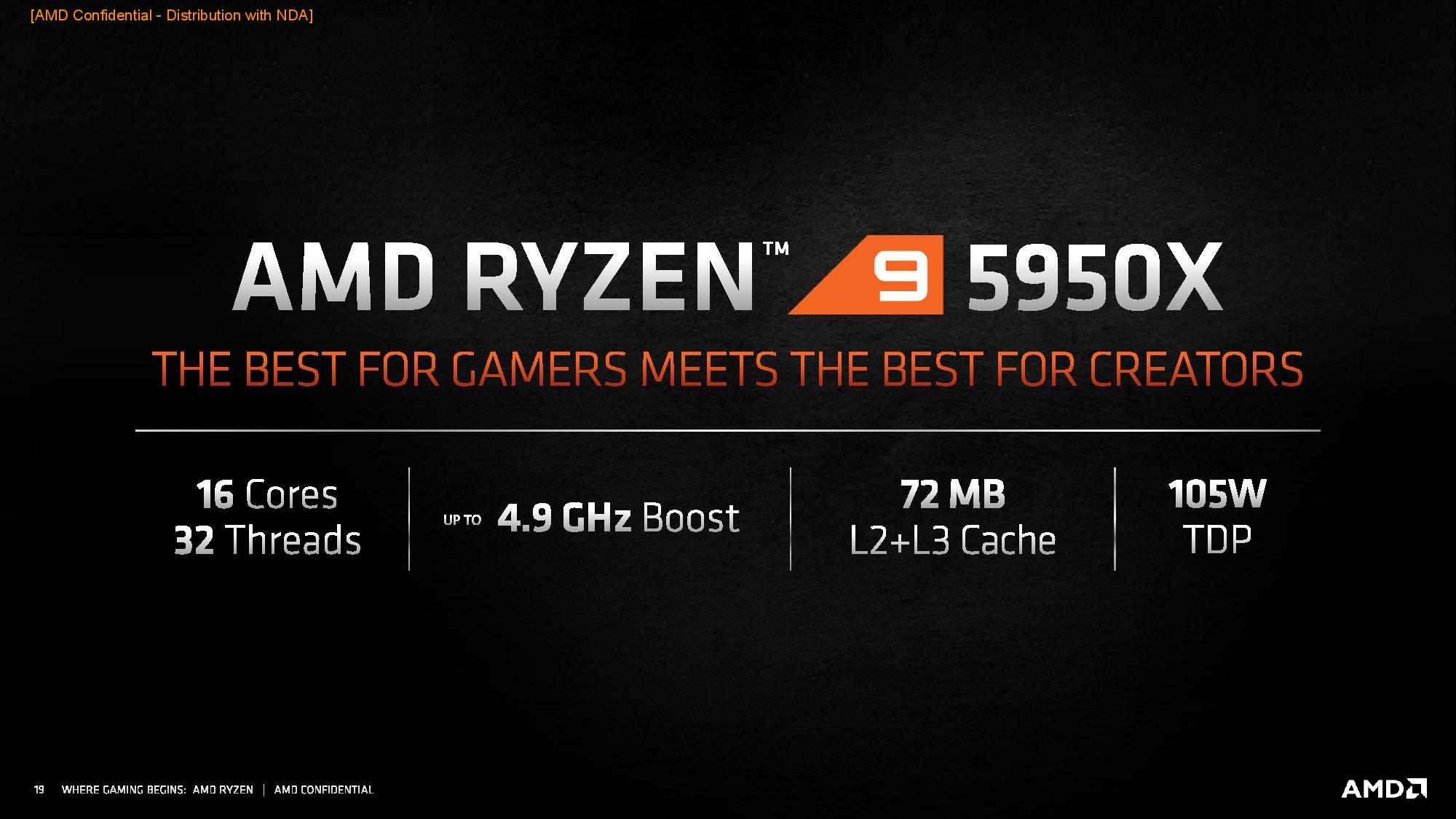
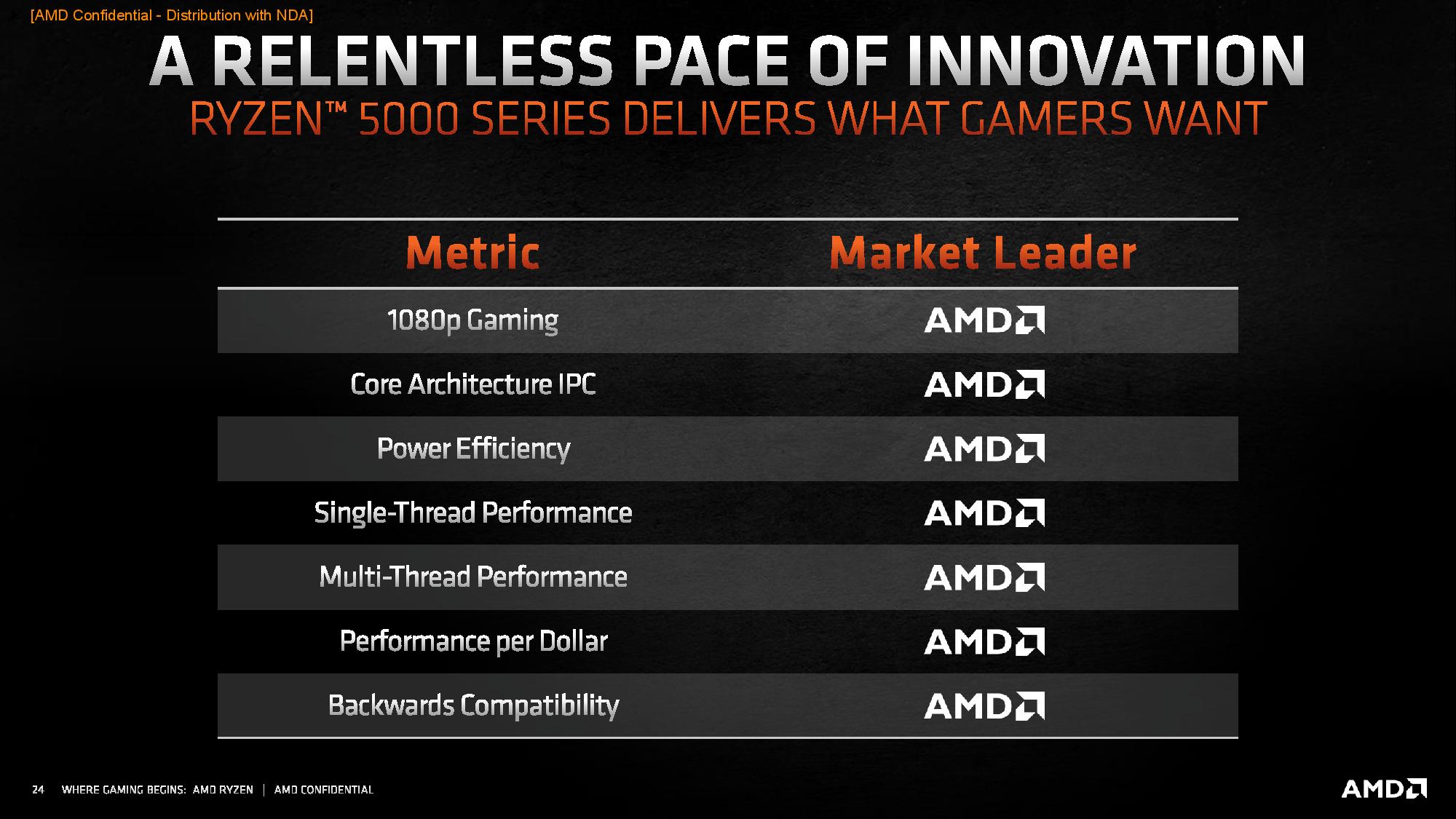
AMD's pricing increase comes as it positions itself as a premium chip supplier, as opposed to its long history as the value alternative. The continued absence of bundled coolers also serves to drive up the platform cost - in most cases, you'll need to invest at least $40 to find a cooler that's as capable as AMD's stock coolers. The company specs a 280mm AIO cooler (or equivalent air cooler) for the processors, so plan accordingly.
Zen 3 has lived up to its billing, and it looks like AMD’s only constraint will be production capacity at TSMC. AMD is selling every Ryzen 5000 series chip it punches out, at least until Rocket Lake arrives – and we still don't know if Intel’s new 14nm design can keep pace with AMD’s 7nm CPUs.
Luckily, AMD’s ecosystem of 500- and 400-series motherboard partners have plenty of relatively affordable options, so there aren't any problems with motherboard supply.
AMD Ryzen 5000 Smart Memory Access and Radeon RX 6000 'Big Navi' GPUs
AMD’s Radeon RX 6000 GPUs will now operate in tandem with AMD’s Ryzen 5000 processors (with the caveat that you need a 500-series motherboard) through a new Smart Access Memory feature that will boost gaming performance by enhancing data transfer between the CPU and GPU.
AMD isn’t sharing the new tech's full details, but we do know the broad strokes. By enabling the Smart Memory Access feature in the Radeon RX6000’s vBIOS and the motherboard BIOS, the CPU and GPU gain unprecedented full access to each other’s memory, which maximizes data transfer performance between the CPU and the GPU’s on-card 16GB of VRAM.
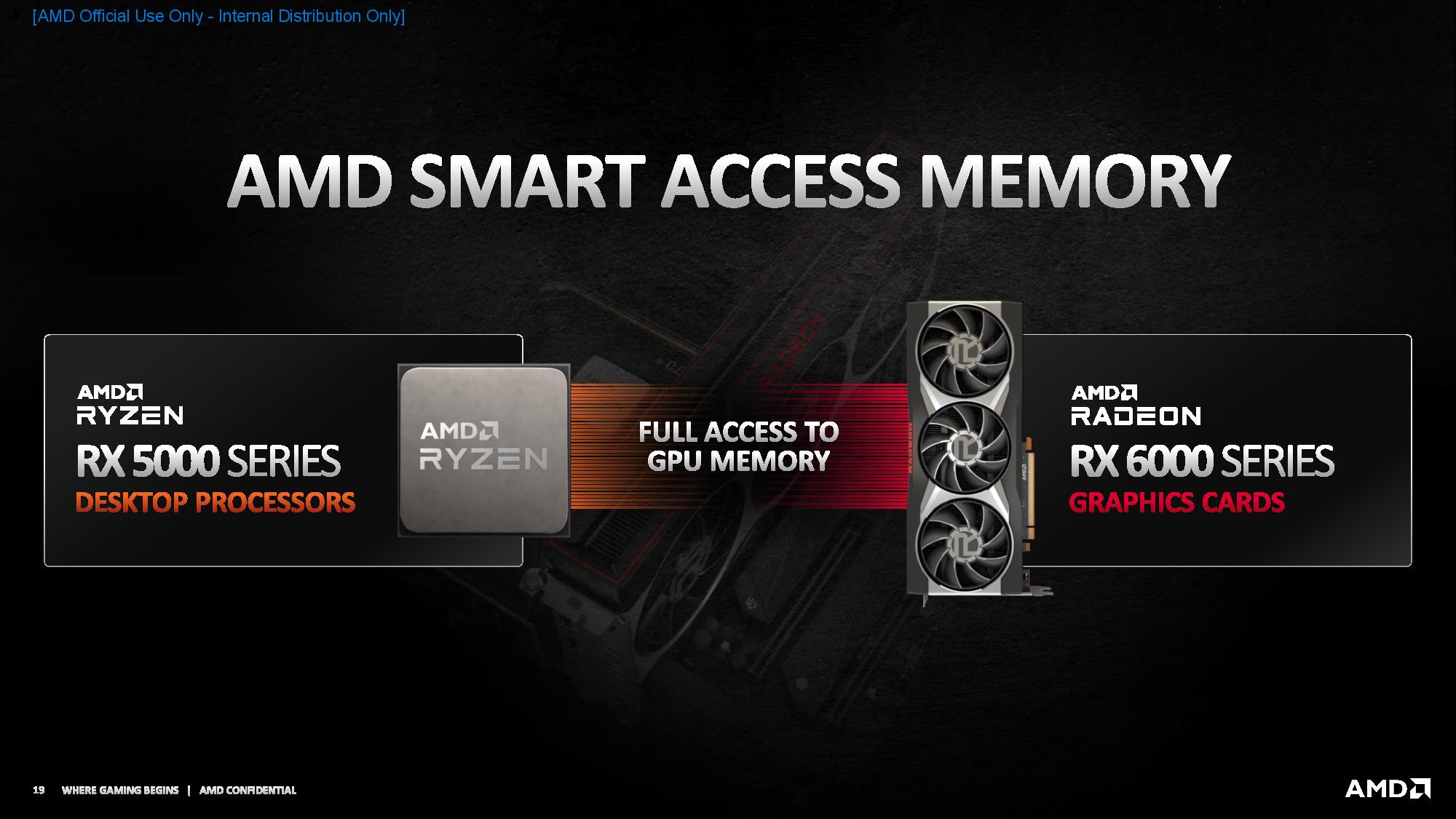

As a basic explainer, AMD says that the CPU and GPU are usually constrained to a 256MB ‘aperture’ for data transfers. That limits game developers and requires frequent trips between the CPU and main memory if the data set exceeds that size, causing inefficiencies and capping performance. Smart Access Memory removes that limitation, thus boosting performance due to faster data transfer speeds between the CPU and GPU. This happens by leveraging the Resizable PCIe Bar feature, which is part of the PCI specification, and the same gains can be had with Nvidia GPUs, too, once the company enables it. Nvidia hasn't given a firm timeline yet but says it has a similar feature working in its labs.
For now, you’ll need three ingredients to unlock the Smart Memory Access feature with AMD's GPUs: A Radeon RX 6000 GPU (all models support it), a Ryzen 5000 processor, and a standard 500-series motherboard. We asked AMD if the tech will come to its previous-gen CPUs and motherboards, but the company merely tells us that it would provide updates at a future time if there is more enablement.
Should I Buy a Ryzen 5000 Series Zen 3 CPU?
Should you buy a Zen Ryzen 5000 processor? The Short answer: Yes.
The Ryzen 5000 series outperforms all of Intel's competing Comet Lake chips and offers a better price-to-performance ratio. Until Intel reduces its pricing, we can't recommend any Comet Lake processor that competes in the same price ranges as AMD's Ryzen 5000 series processors. The only trick is finding AMD's premium silicon at retail - intense demand has led to severe shortages. If you're in need of a processor now, or if the entry-level pricing of $300 is too high for your liking, look to AMD's Ryzen 3000 series as the value alternatives.
AMD Zen 3 Ryzen 5000 Series Microarchitecture
AMD shared the full details about the Zen 3 microarchitecture. AMD embarked on what it describes as a ground-up redesign of the Zen 2 microarchitecture to deliver the gains we would normally see with an entirely new design. In fact, the company's ~19% increase in IPC represents its largest single-generation increase in the 'post-Zen' era (Zen+, Zen 2). We certainly haven't seen an increase of this magnitude for desktop CPUs from Team Blue in the recent past, either — the initial Skylake architecture achieved a similar boost, but everything since has been nearly static.
AMD calculates its 19% IPC number from the geometric mean of 25 workloads measured with two eight-core processors locked at 4.0 GHz. The impressive IPC gains required a 'front-to-back' series of modifications to the design, including (but not limited to) the cache subsystem, front end, branch predictor, execution engine, and load/store elements, all with a focus on boosting single-threaded performance while wringing out better instruction level parallelism (ILP). The result is improved performance across the board in both single- and multi-threaded integer and floating point workloads. However, the 142W power limit imposed by the AM4 socket does restrict the scope of performance gains in heavily-threaded workloads, though there are some advances there, too.
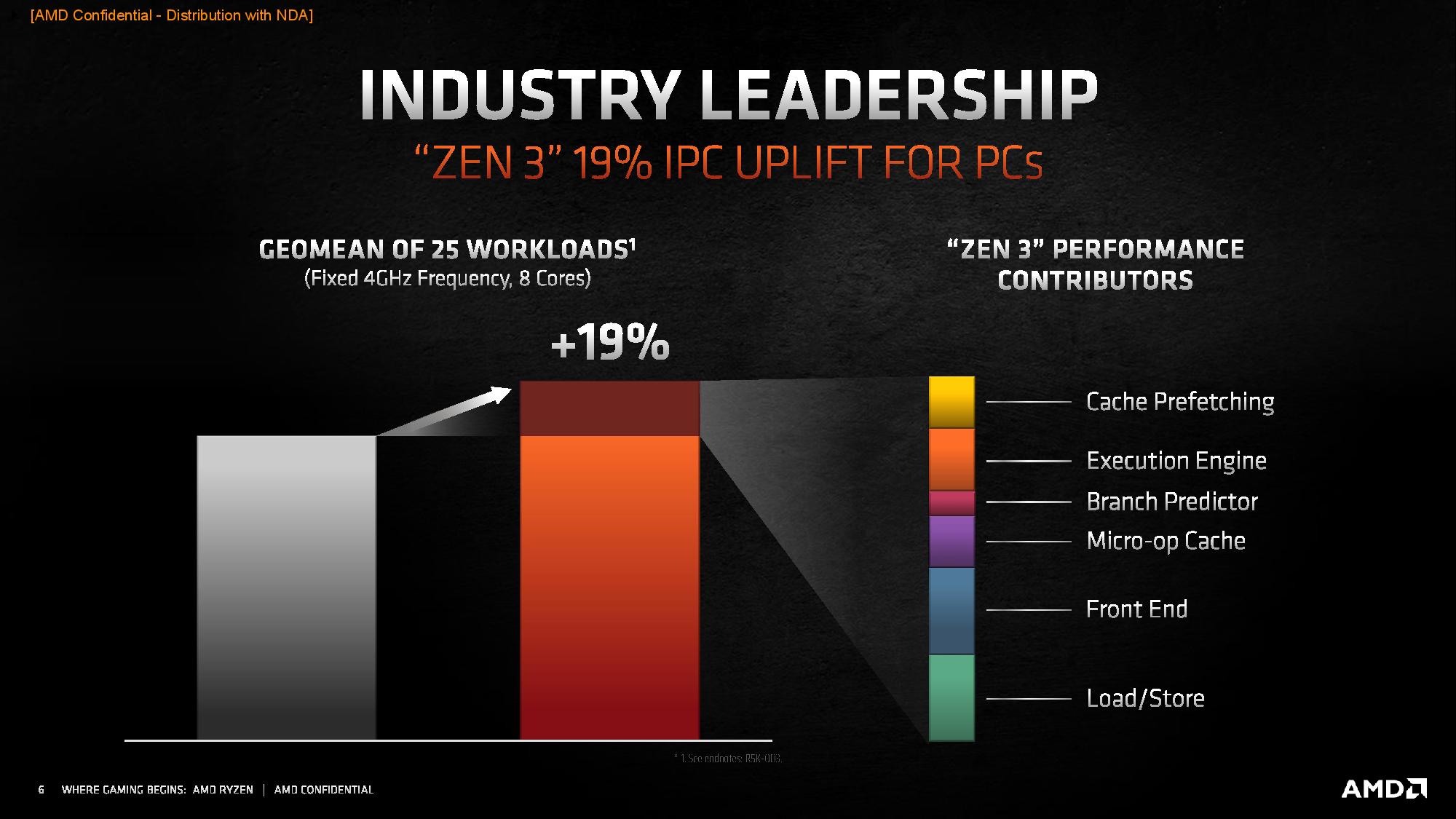
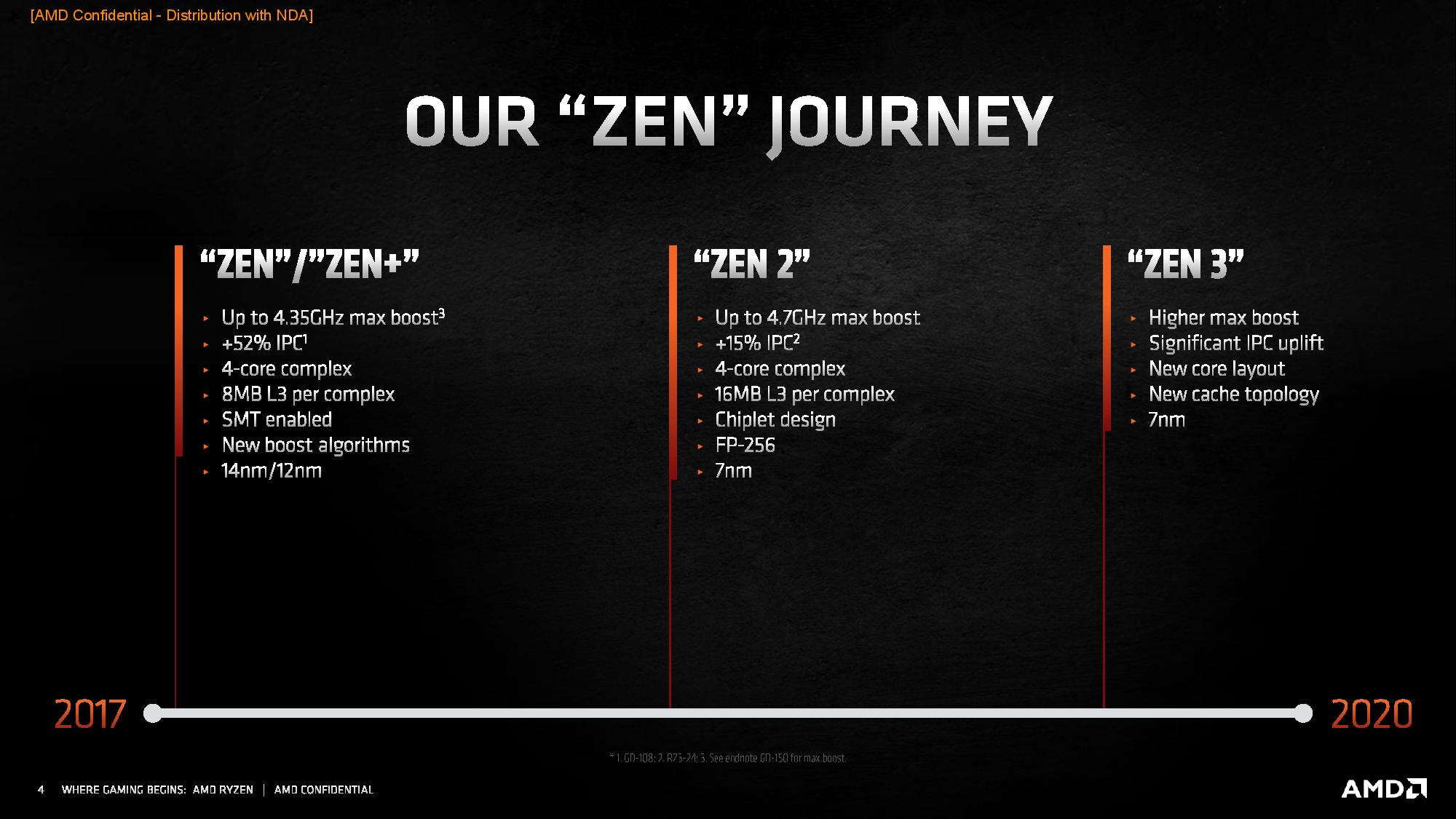
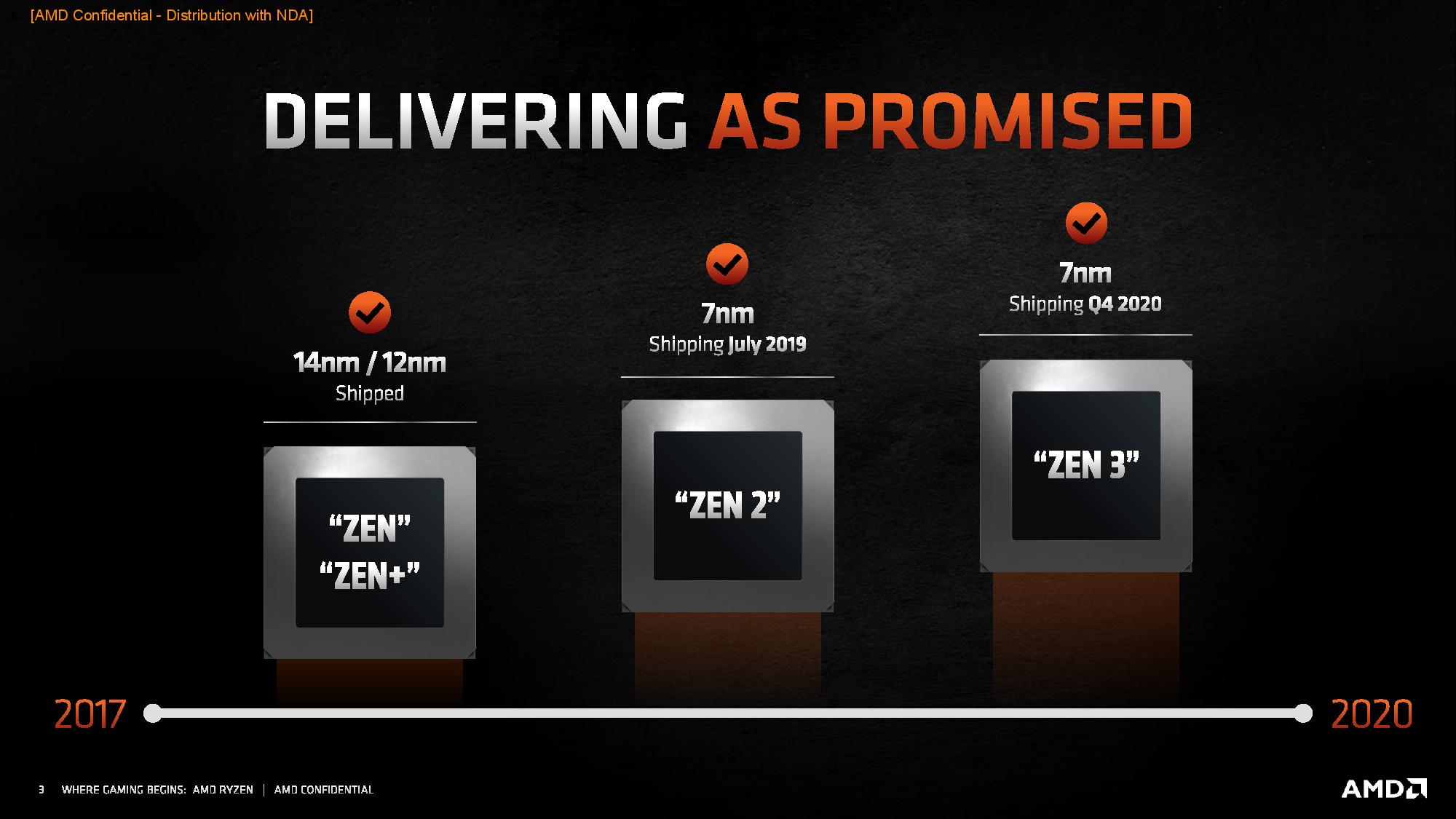
AMD says it uses the same enhanced version of TSMC's 7nm process node that it used for the Ryzen XT series, but still hasn't provided specifics. AMD's 'special recipe' for 7nm is largely kept confidential, but the firm specified that it doesn't use TSMC's 7nm+ (an EUV node). That means that AMD uses the standard N7 from Zen 2 with improved design rules, or that the CPUs use the N7P node.
AMD's end goal is to have undisputed best-in-class performance across the full spectrum of applications, and gaming performance was a particular focus, which brings us to the changed cache hierarchy.
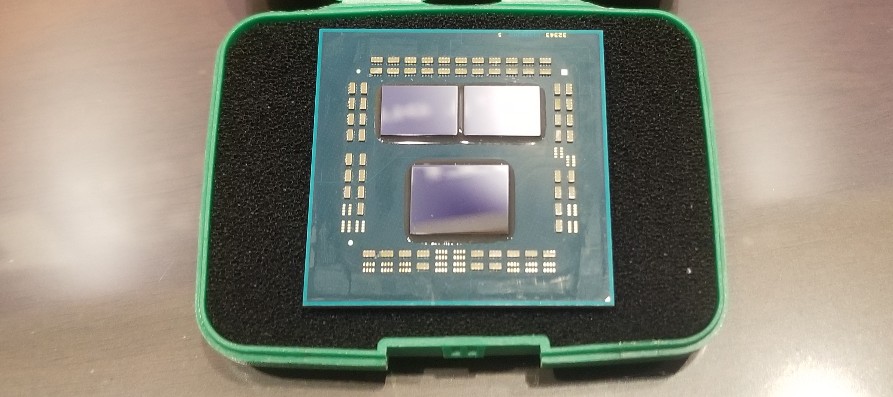
As with the Zen 2 processors, Zen 3 uses the same 12nm I/O die (IOD) paired with either one or two chiplets in an MCM (Multi-Chip Module) arrangement. In the image above, we can see the large I/O die and the two smaller eight-core chiplets.
AMD chose to stick with this basic design for its Zen 3 Ryzen 5000 processors. And just like we see with the previous-gen Zen 2 CPUs, processors with six or eight cores come with one chiplet, while CPUs with 12 or 16 cores come with two chiplets.
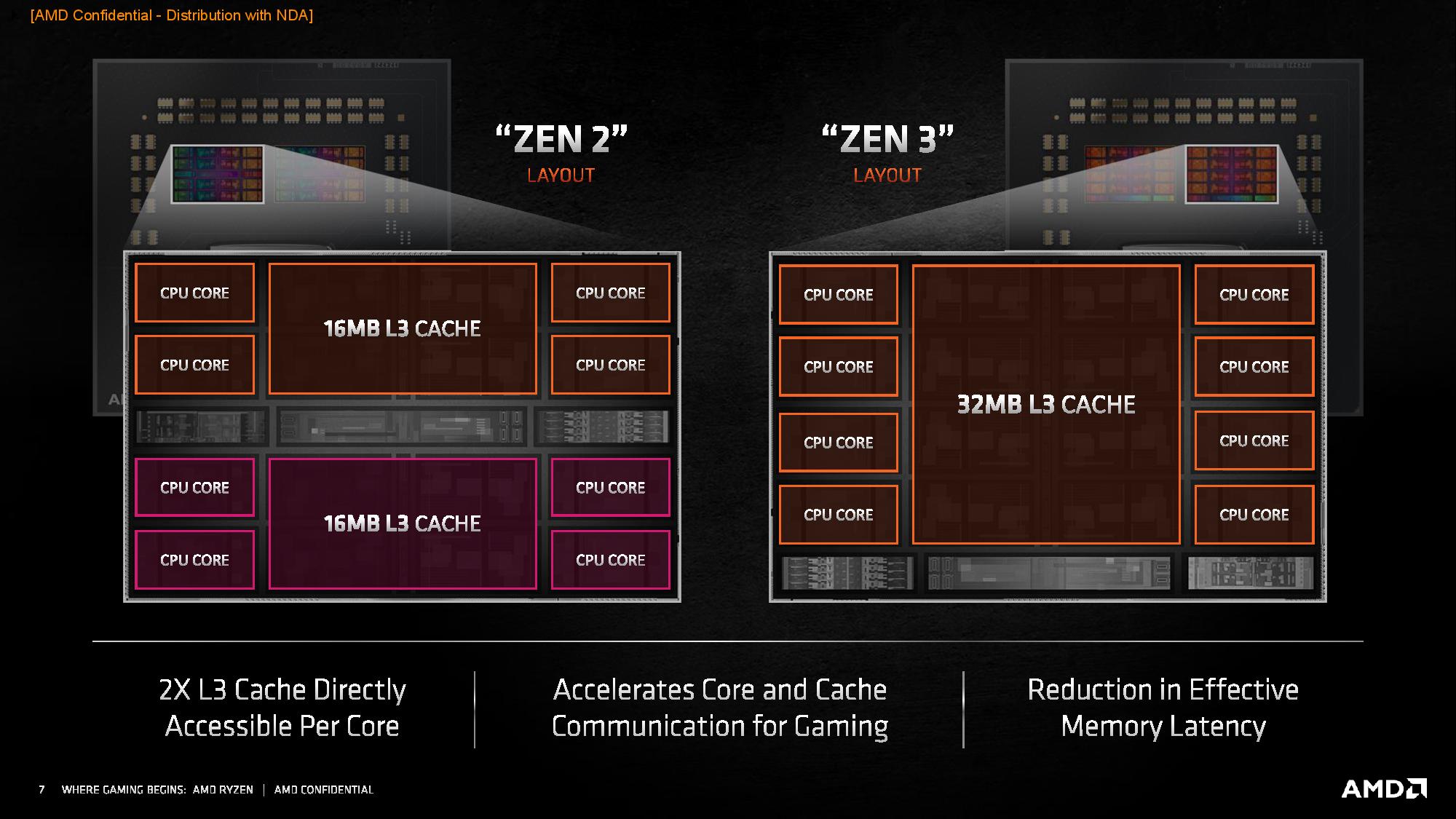
While the overall package design is the same three-chiplet design, AMD made drastic changes to the internals of the two eight-core chiplets. In the Zen 2 architecture (left), each Zen compute chiplet (CCD) contained two four-core clusters (CCXes) with access to an isolated 16MB slice of L3 cache. So, while the entire chiplet contained 32MB of cache, not all cores had access to all of the cache in the chiplet.
To access an adjacent slice of L3 cache, a core had to communicate with the other quad-core cluster by issuing a request that traversed the Infinity Fabric to the I/O die. The I/O die then routed the request to the second quad-core cluster, even though it was contained within the same chiplet. To fulfill the request, the data had to travel back over the fabric to the I/O die, and then back into the quad-core cluster that issued the request.
On the right side of the slide, we can see that the chiplet now contains one large unified 32MB slice of L3 cache, and all eight cores within the chiplet have full access to the shared cache. This improves not only core-to-cache latency, but also core-to-core latency within the chiplet.
While all eight cores can access the L3 cache within a single compute chiplet, in a dual-chiplet Zen 3 chip, there will be times that the cores will have to communicate with the other chiplet and its L3 cache. In those cases, the compute chiplet's requests will still have to traverse the Infinity Fabric via signals routed through the I/O die, which incurs latency.
Still, because an entire layer of external communication between the two four-core clusters inside each chiplet has been removed, the Infinity Fabric will naturally have far less traffic. This results in less contention on the fabric, thus simplifying scheduling and routing, and it could also increase the amount of available bandwidth for this type of traffic. All of these factors will result in faster transfers (i.e., lower latency) communication between the two eight-core chiplets, and it possibly removes some of the overhead on the I/O die, too. We imagine there could also be other advantages, particularly for main memory latency, but we'll wait for more details. We do know that the default fabric speeds haven’t changed, though.
All of this is important because games rely heavily on the memory subsystem, both on-die cache and main memory (DDR4). A larger pool of cache resources keeps more data closer to the cores, thus requiring fewer high-latency accesses to the main memory. Additionally, lower cache latency can reduce the amount of time a core communicates with the L3 cache. This new design will tremendously benefit latency-sensitive applications, like games — particularly if they have a dominant thread that accesses cache heavily (which is common).
Naturally, power efficiency will improve as a function of reduced traffic on the Infinity Fabric, but that's probably a small fraction of the performance-per-watt gains AMD has extracted from the architecture. Increased IPC and other SoC-level optimizations obviously factor in here. Still, the net result is that AMD managed to stay within the same TDP thermal and electrical ranges as the Ryzen 3000 series CPUs while delivering more performance.
Here's AMD's high-level bullet point list of improvements to the Zen 3 microarchitecture:
- Front-end enhancements:
- Major Design Goal: Faster fetching, especially for branchy and large-footprint code
- L1 branch target buffer (BTB) doubled to 1024 entries for better prediction latency
- Improved branch predictor bandwidth
- Faster recovery from misprediction
- "No Bubble" prediction to make back-to-back predictions faster and better handle branchy code
- Faster sequencing of op-cache fetches
- Finer granularity in switching of op-cache pipes
- Execution Engines:
- Major Design Goal: Reduce latency and enlarge to extract higher instruction-level parallelism (ILP)
- New dedicated branch and st-pickers for integer, now at 10 issues per cycle (+3 vs. Zen 2)
- Larger integer window at +32 vs Zen 2
- Reduced latency for select float and integer operations
- Floating point has increased bandwidth by +2 for a total of 6-wide dispatch and issue
- Floating point FMAC is now one cycle faster
- Load/Store:
- Major Design Goal: Larger structures and better prefetching — enhance execution engine bandwidth
- Overall higher bandwidth to feed larger/faster execution resources
- Higher load and store bandwidth vs. Zen 2 by +1
- More flexibility in load/store operations
- Improved memory dependence detection
- +4 table walkers in the Translation Look-aside Buffer (TLB)
Notably, AMD also added support for memory protection keys, added AVX2 support for VAES/VPCLMULQD instructions, and made a just-in-time update to the Zen 3 microarchitecture to provide in-silicon mitigation for the Spectre vulnerability.
Naturally, performance and power efficiency will improve as a function of architectural improvements. The reduced traffic on the Infinity Fabric also contributes (it always requires more energy to move data than to process it). Which brings us to IPC.
AMD Ryzen 5000 Zen 3 IPC (Instruction Per Cycle) Benchmarks
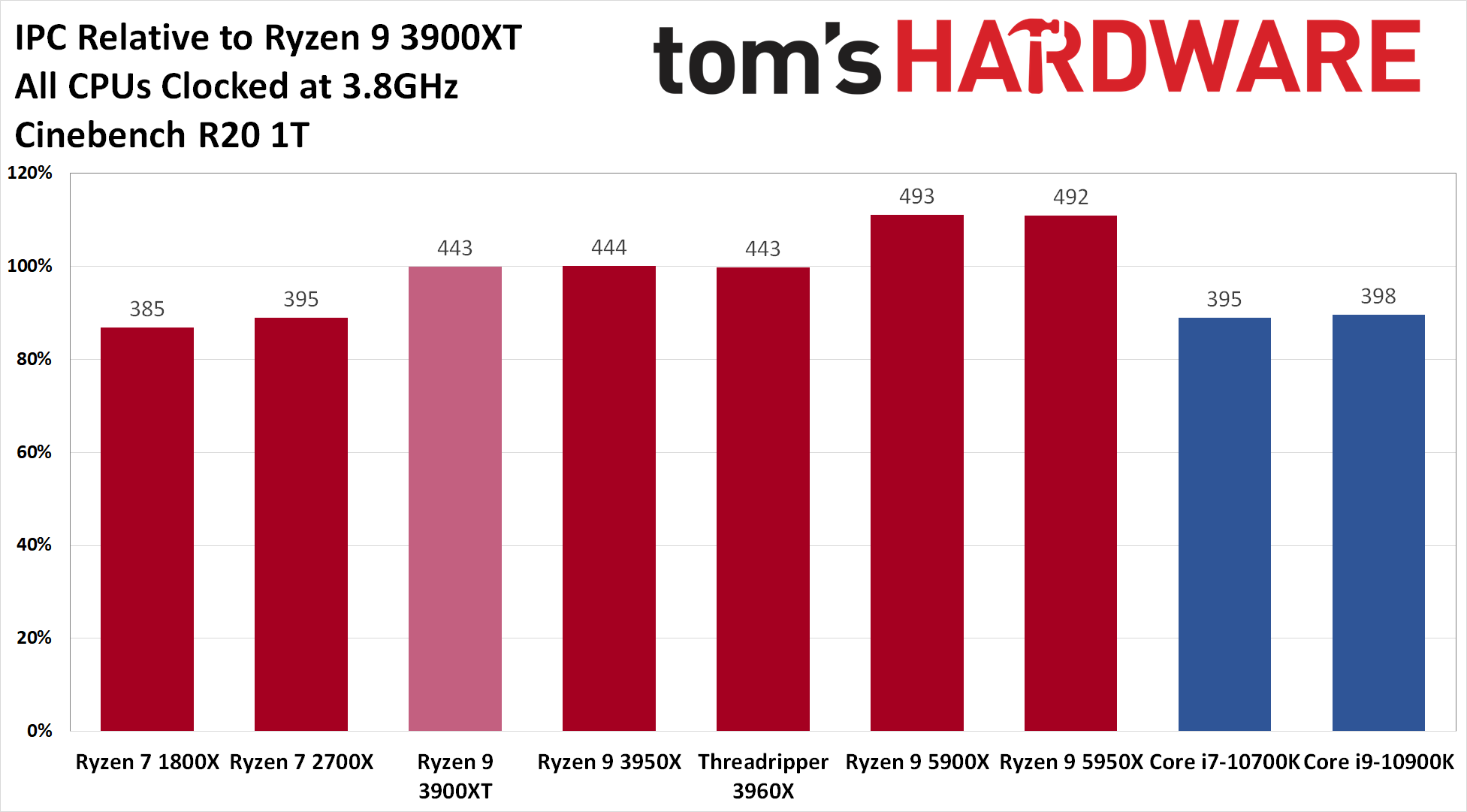
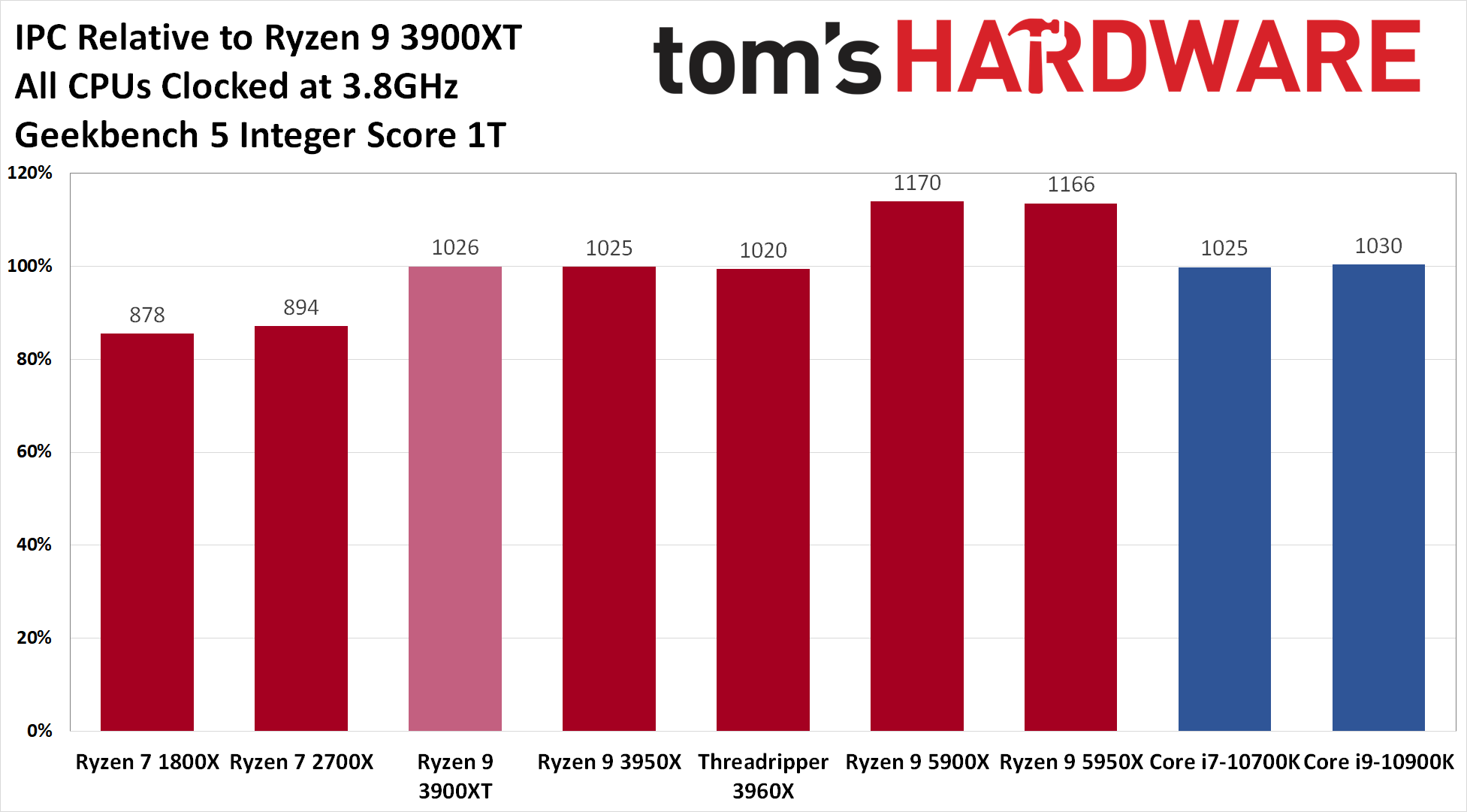
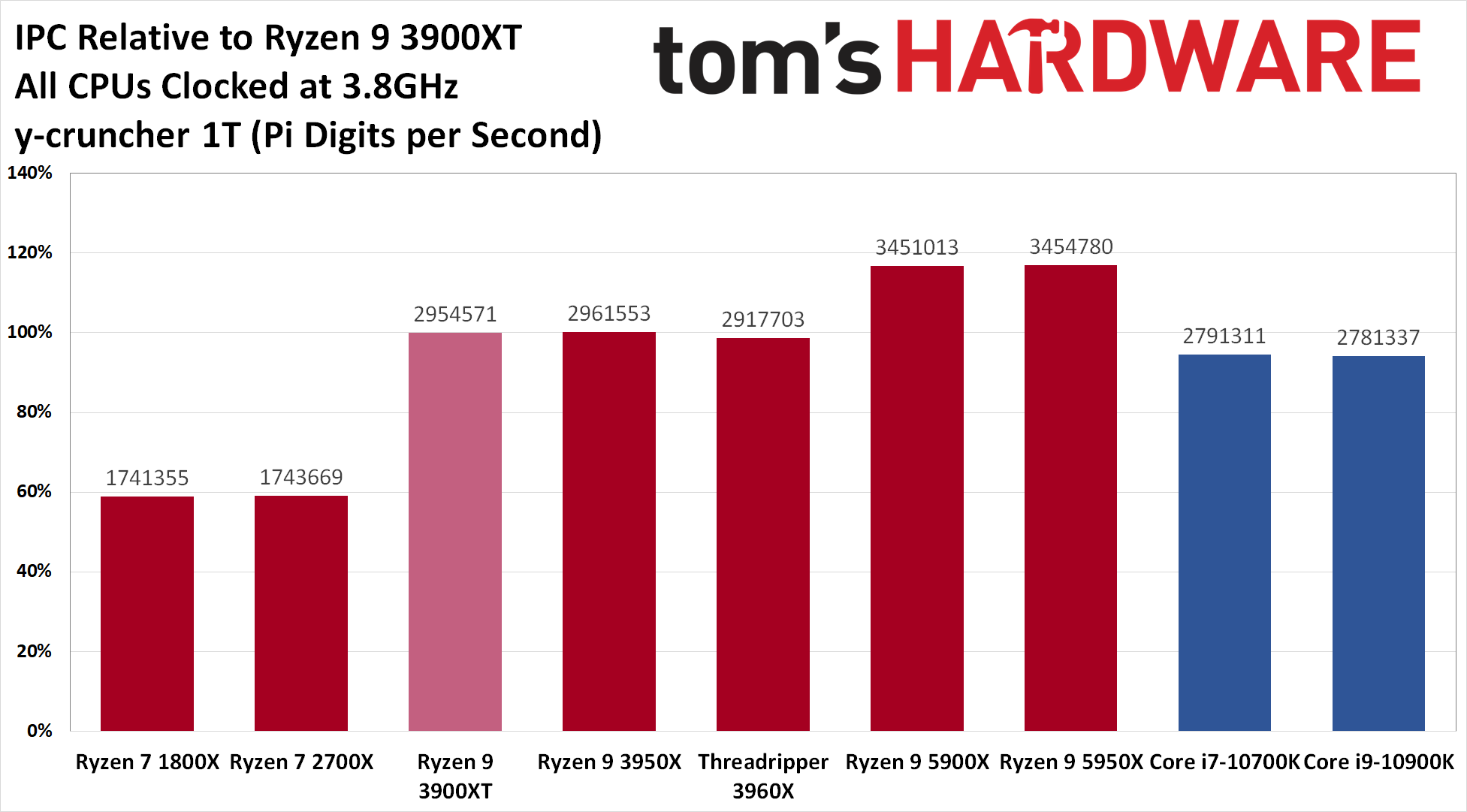
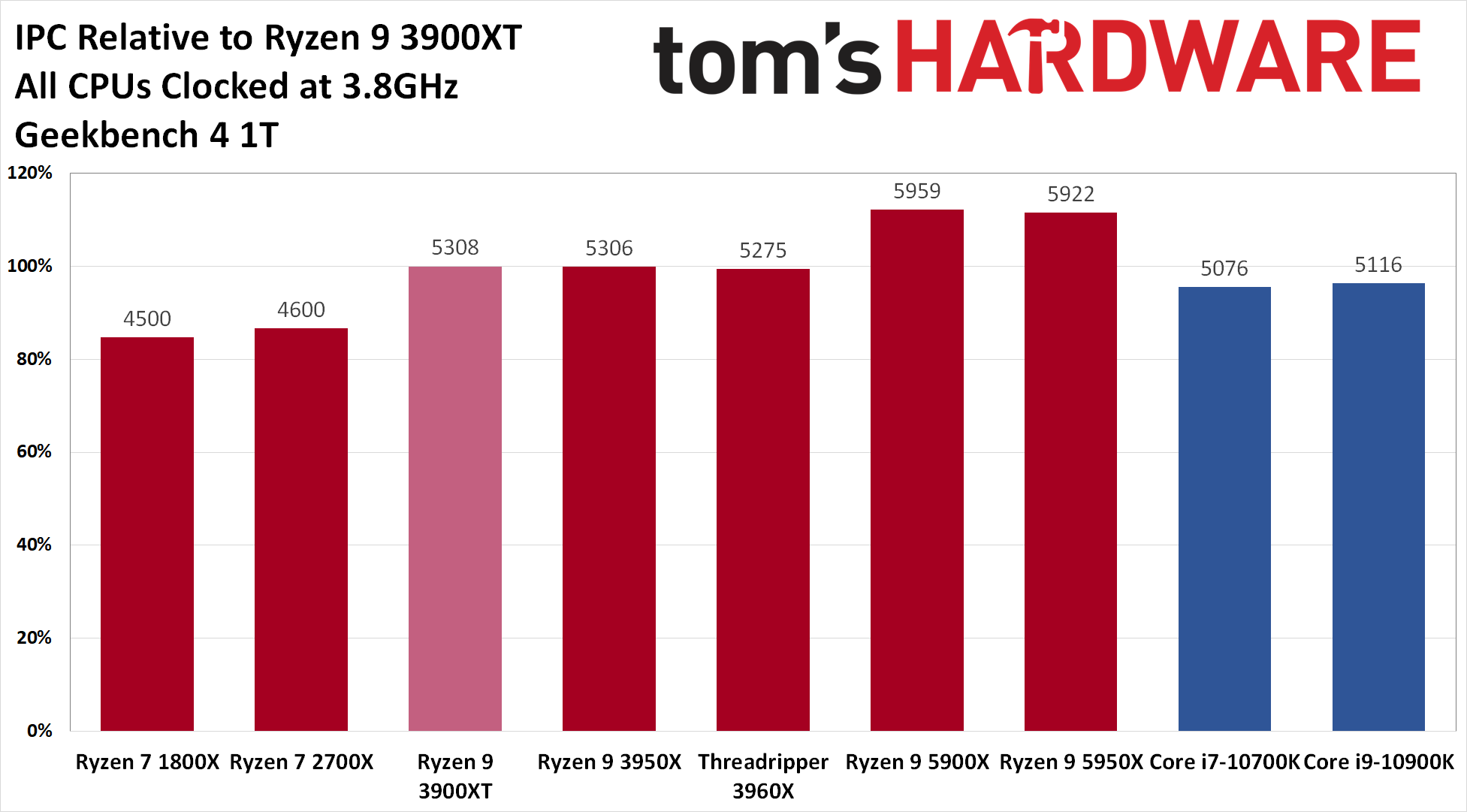
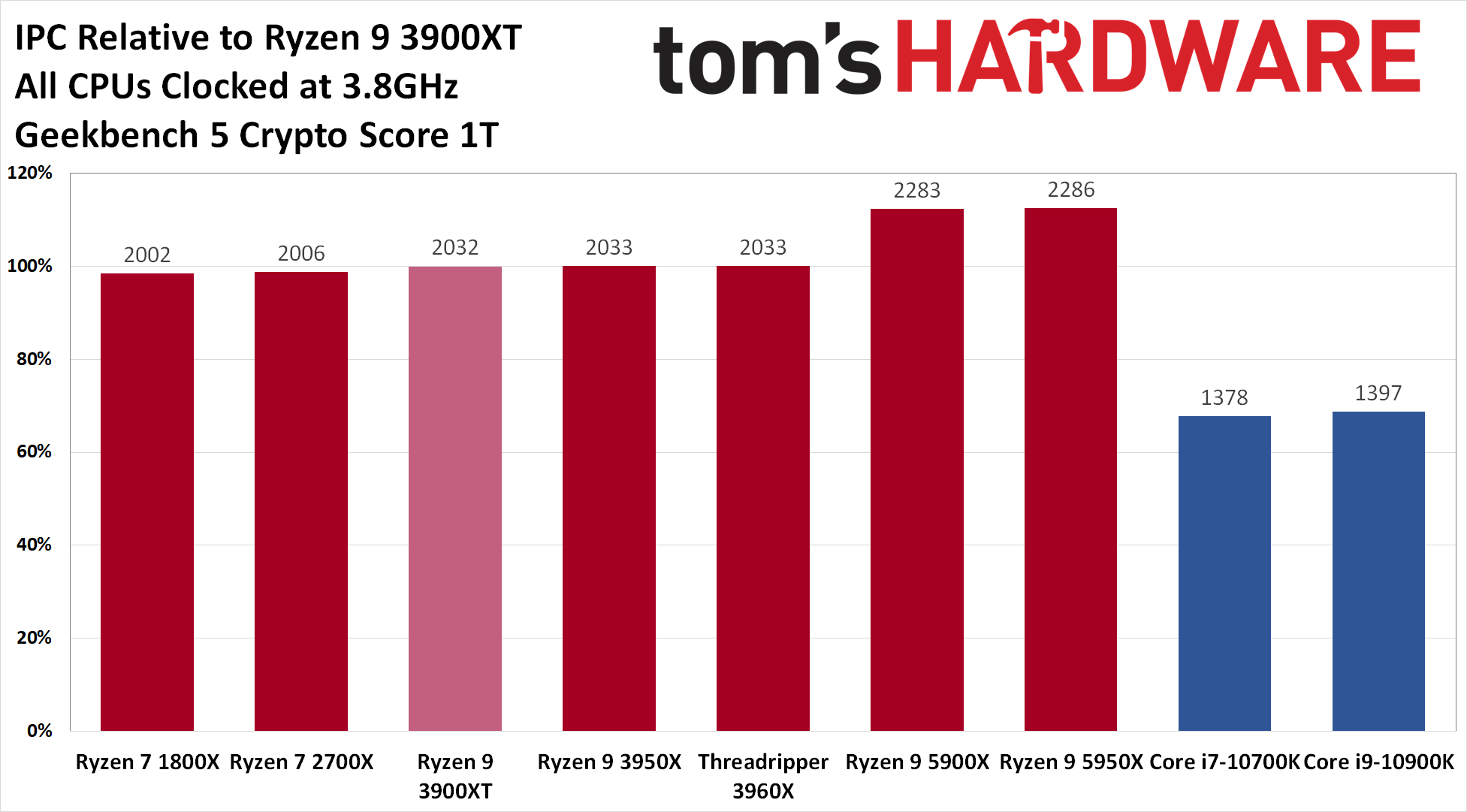
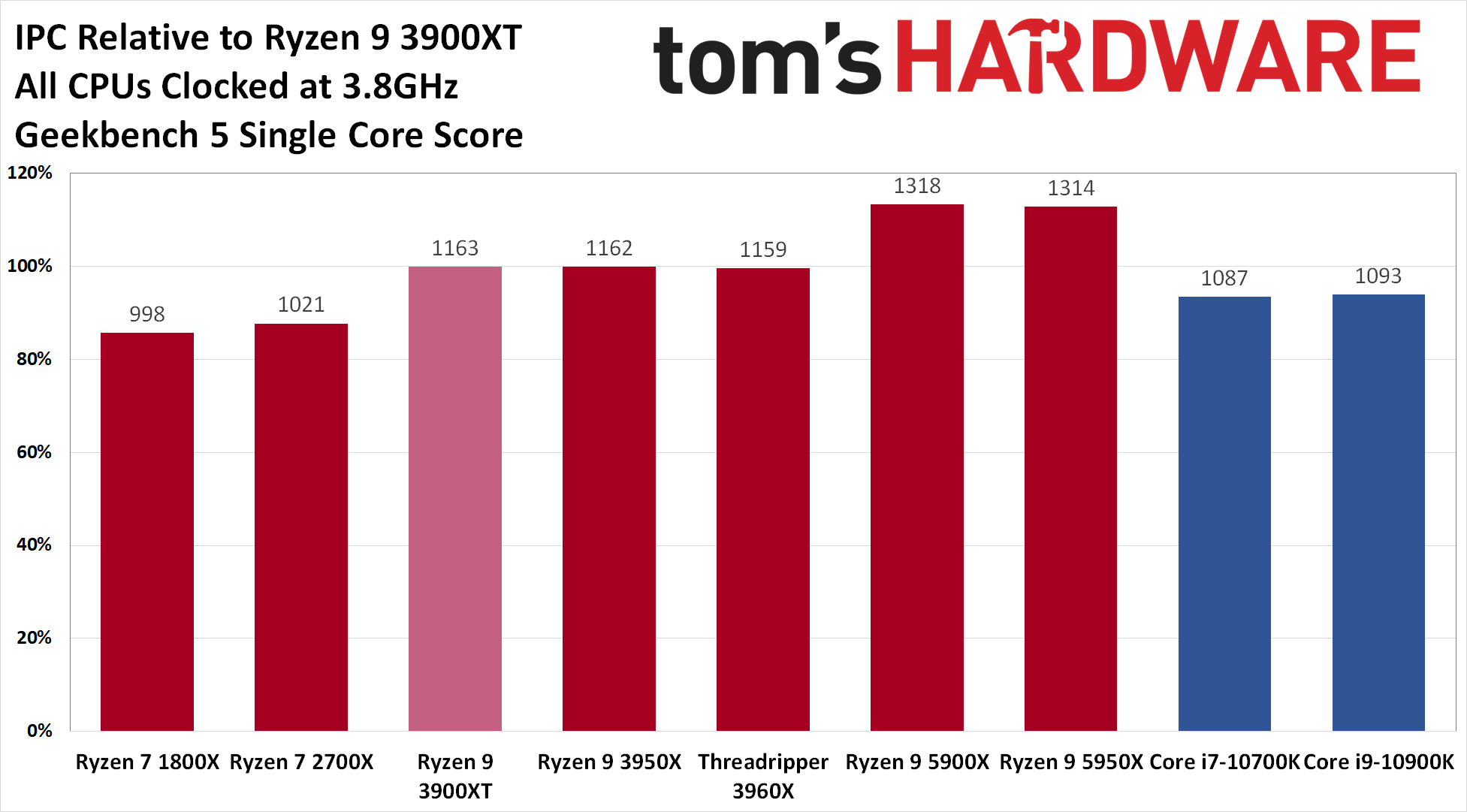
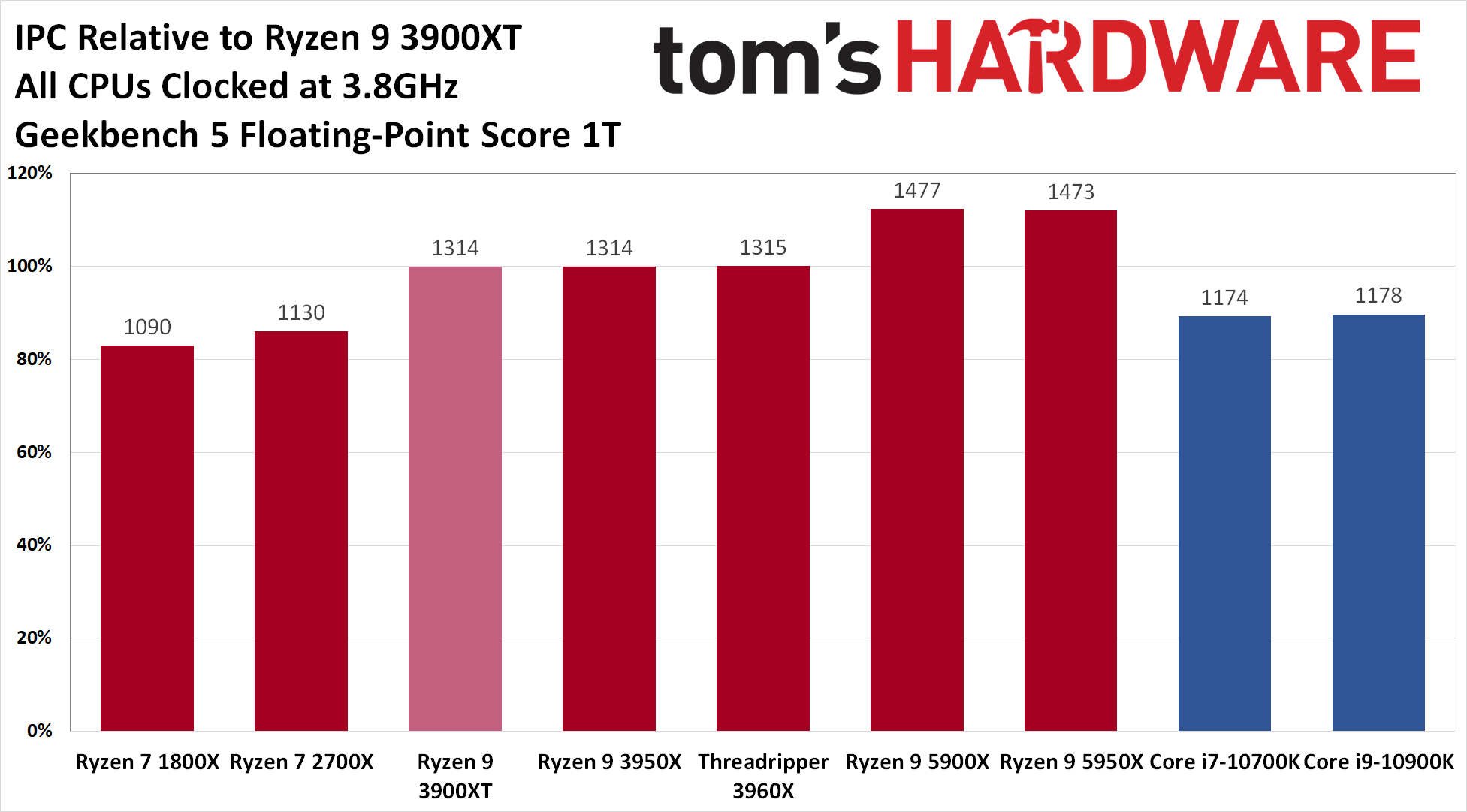
We tested a limited subset of single-threaded workloads to see the instruction per cycle (IPC) throughput improvements, locking all chips to a static 3.8 GHz all-core clock with the memory dialed into the officially supported transfer rate.
AMD's generational march forward is clear as we move from the left to the right of each chart. Overall, AMD's gen-on-gen IPC increases are exceptional, and Zen 3's IPC obviously beats Intel's Comet Lake chips with ease. AMD has certainly delivered on its 19% improvement to IPC promise.
AMD Ryzen 5000 Zen 3 Power Consumption and Efficiency
AMD extracted more efficiency from the ‘same’ 7nm node, which is difficult and requires a combination of both better design methodologies and architectural improvements. As a result of these factors, AMD says it wrung out another 24% gen-on-gen efficiency improvement with the Ryzen 9 5900X over the Zen 2-powered Ryzen 9 3900XT. That’s impressive. Intel's most recent Comet Lake CPUs had to increase power draw quite a bit to stay competitive, but still had far smaller performance improvements.
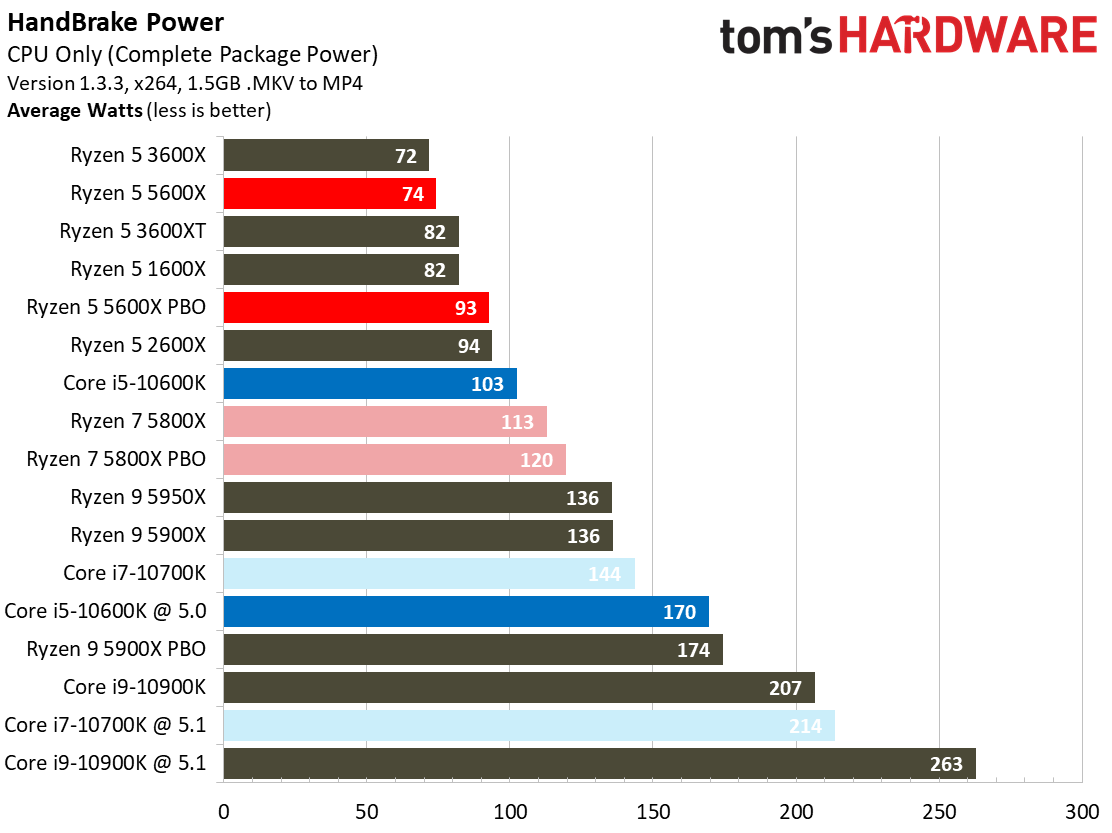
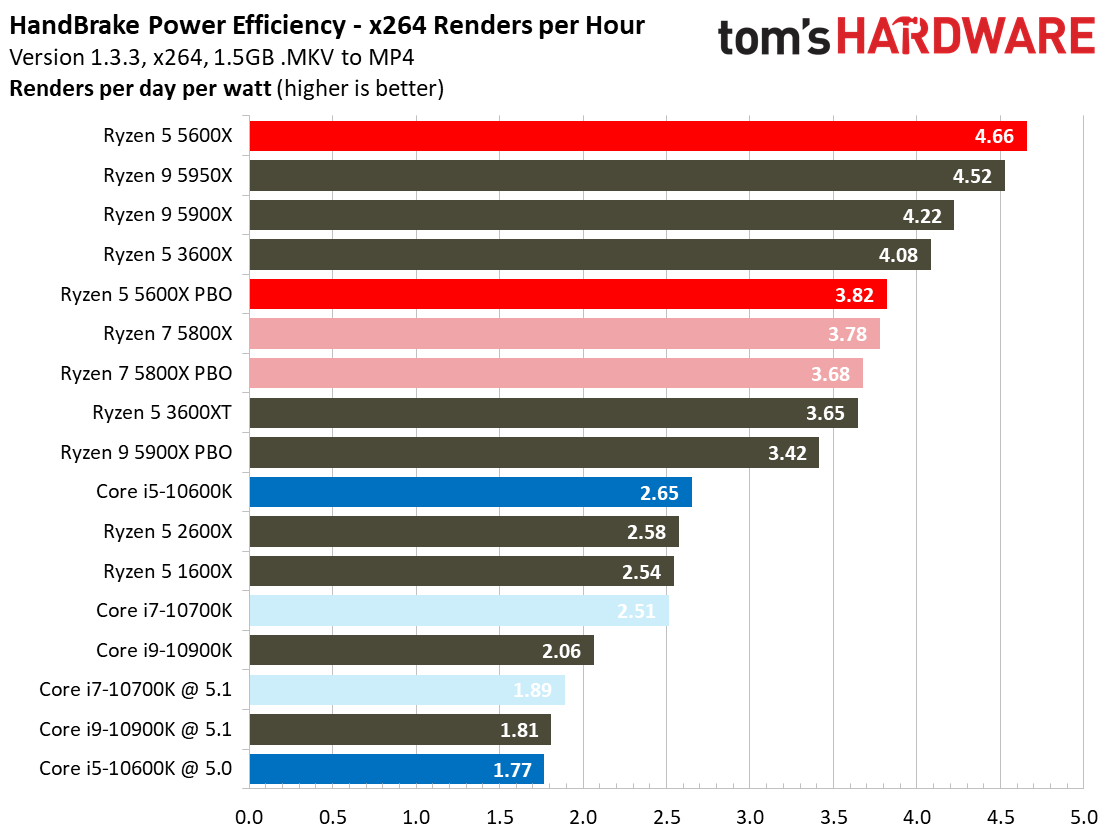
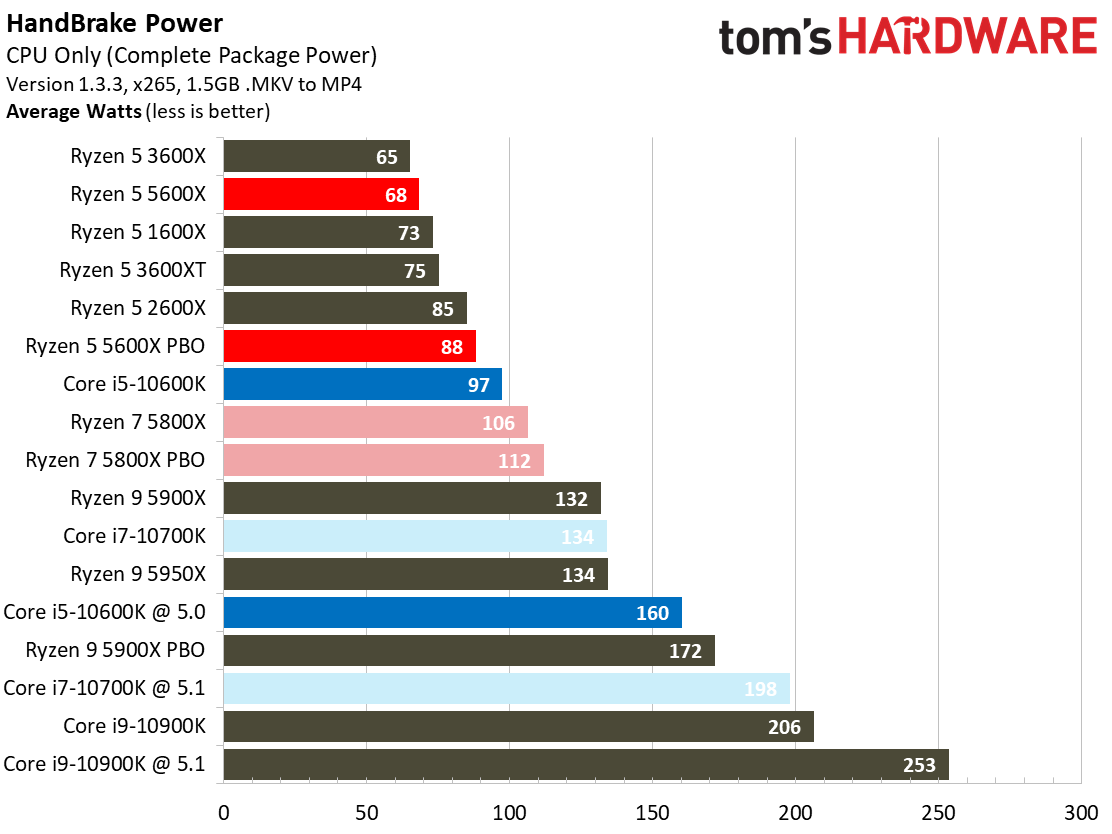
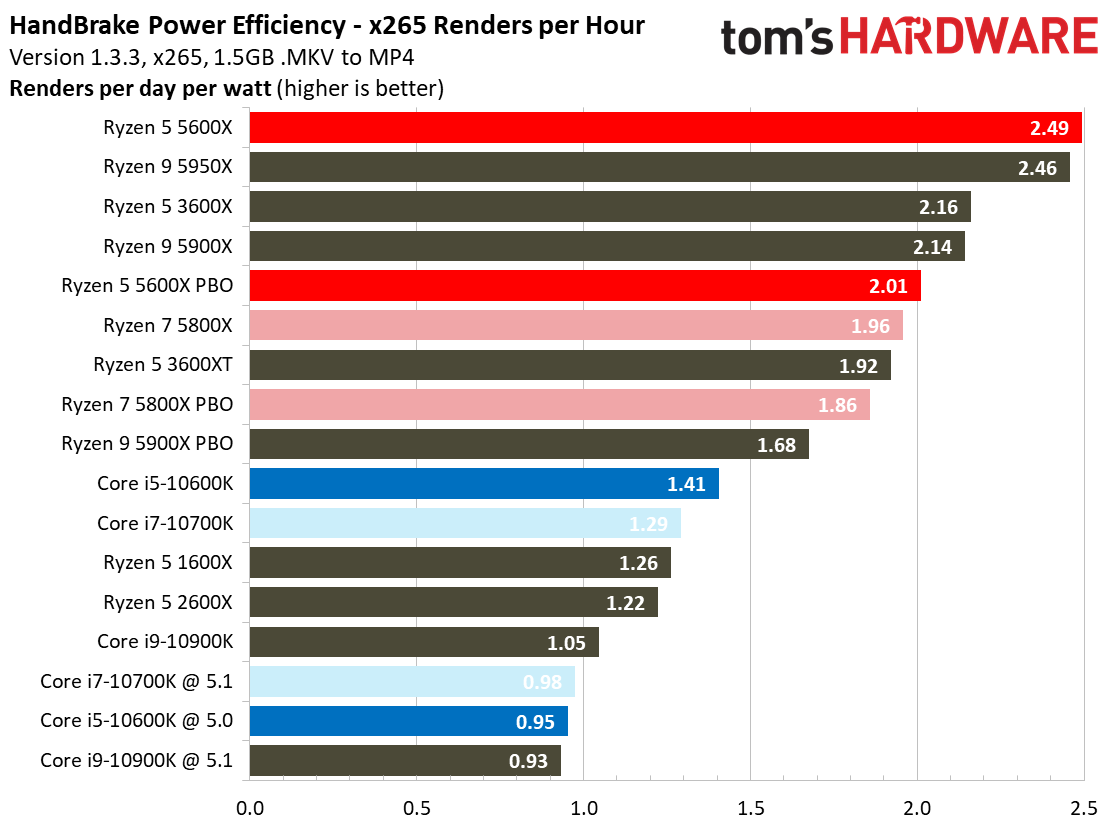
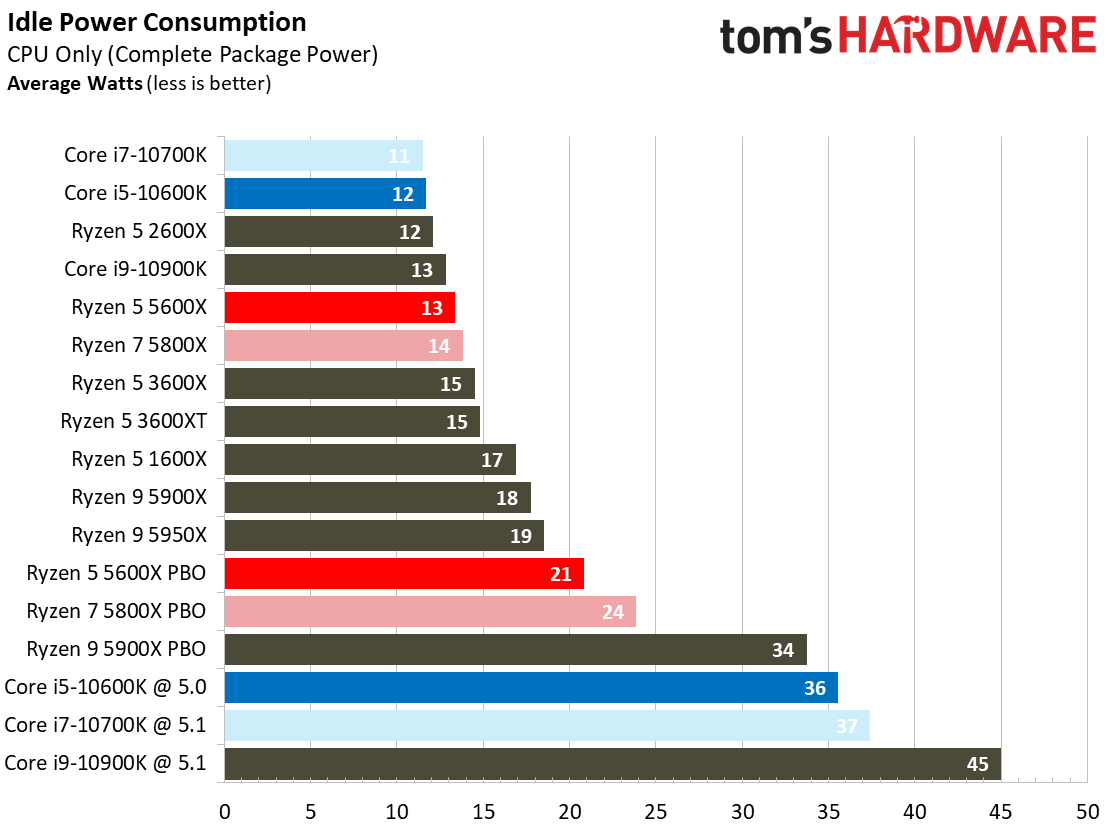
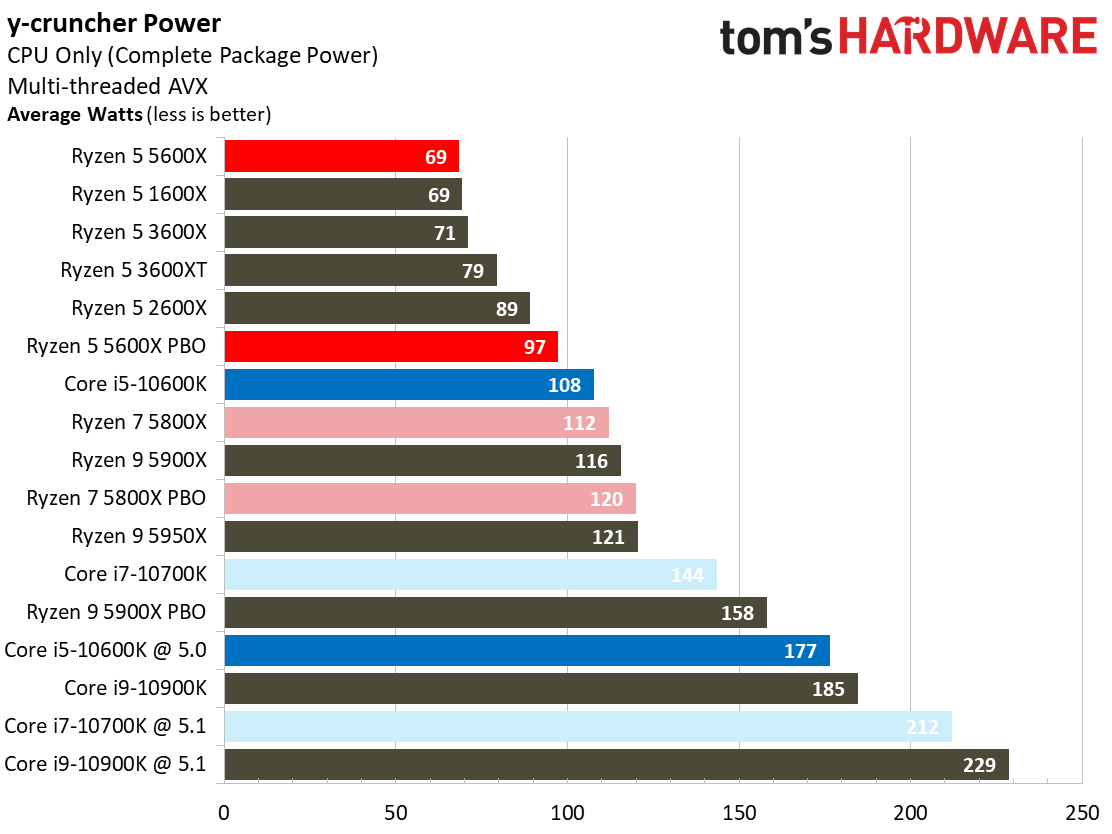
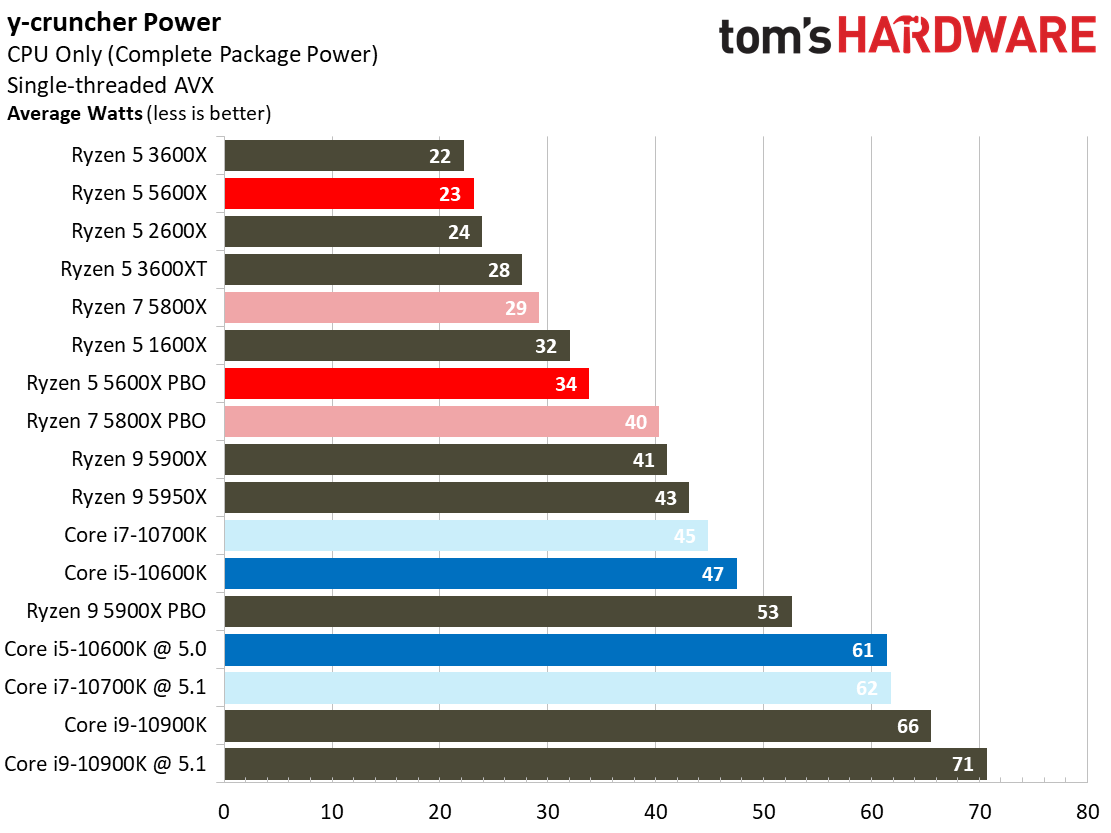
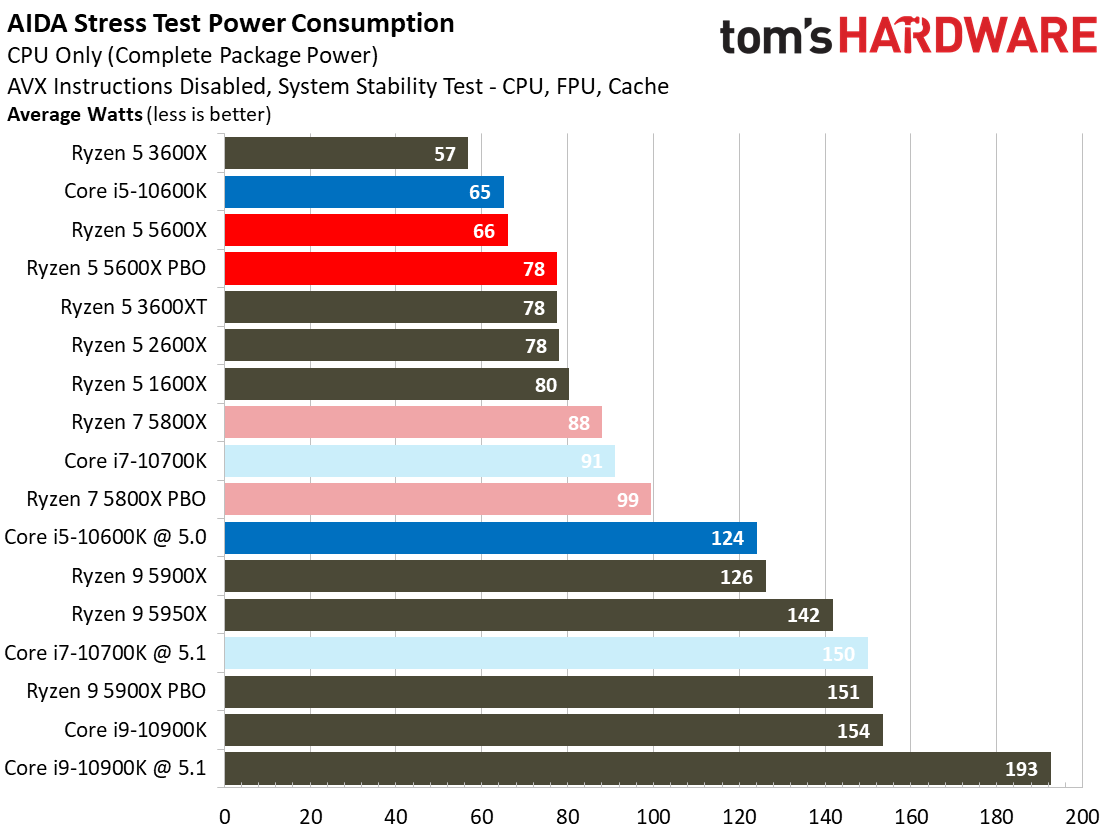

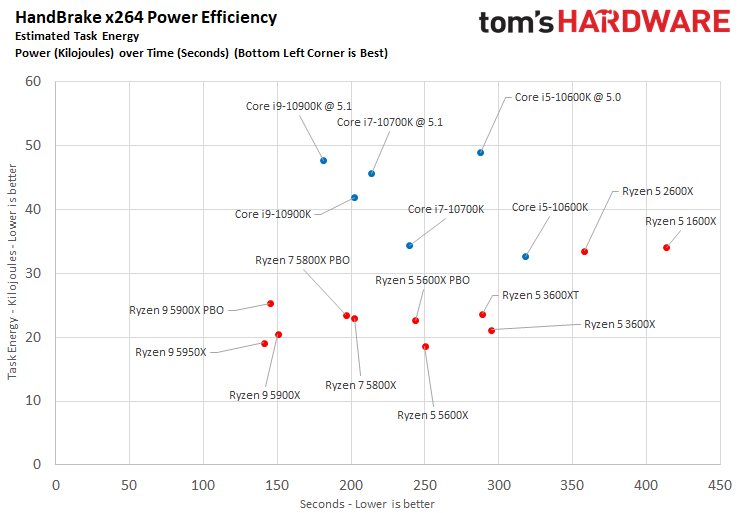
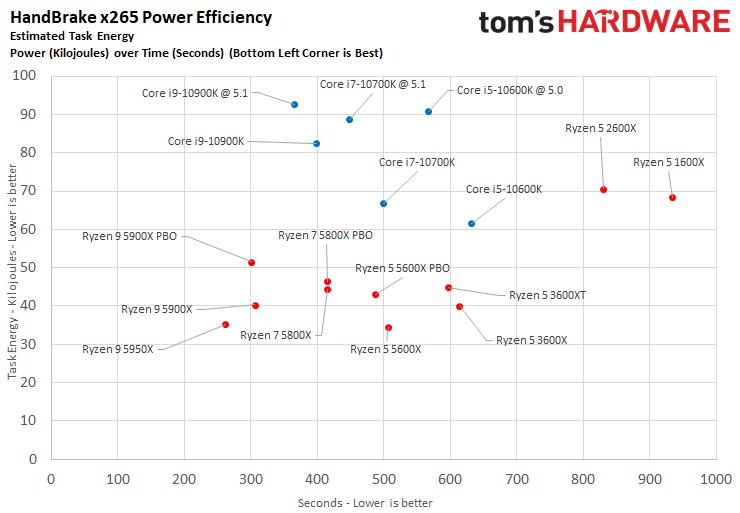
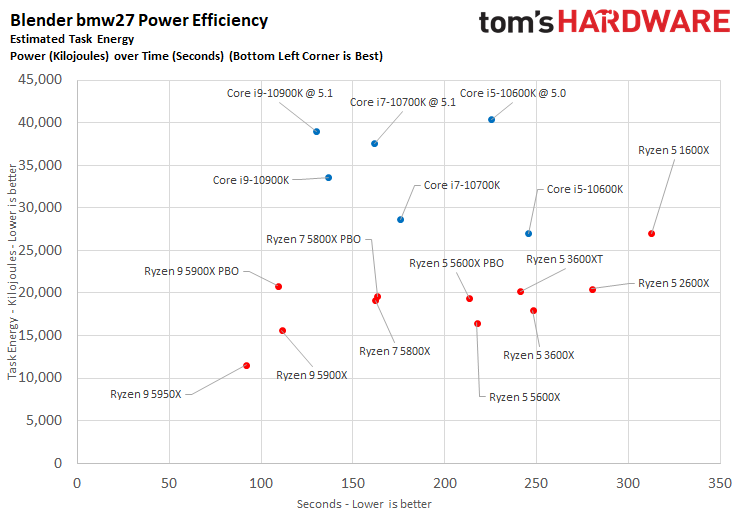
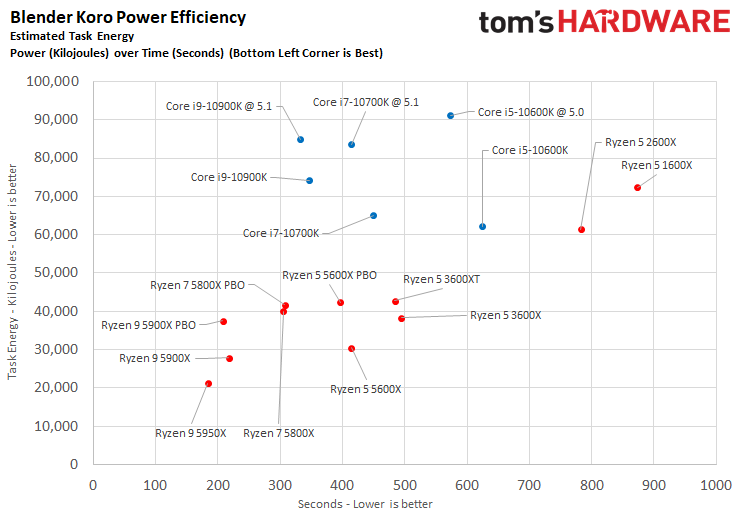
Here's a roll-up of the power and efficiency testing for the Ryzen 5000 processors compared to the Intel Comet Lake series. Yes, you've guessed it: For deeper analysis, jump over to our reviews.
Overall, these charts outline a massive power efficiency advantage for Ryzen 5000 chips. What does that mean to you? Faster, cooler, and quieter performance for your PC compared to AMD's previous processors - and those models already posed a stiff challenge to Intel's Comet Lake.
- MORE: Best CPUs for Gaming
- MORE: CPU Benchmark Hierarchy
- MORE: AMD vs Intel
- MORE: Zen 4 Ryzen 7000 All We Know
- MORE: How to Overclock a CPU
- MORE: How to check CPU Temperature
- MORE: All CPUs Content

Paul Alcorn is the Editor-in-Chief for Tom's Hardware US. He also writes news and reviews on CPUs, storage, and enterprise hardware.
-
spongiemaster The performance looks good but the value looks worse than Intel's 10th gen. No price/performance improvement is quite disappointing.Reply -
NightHawkRMX Will have to see when reviews come out, but I don't think its worse. Probably on par or slightly better for games. For a lot of other applications I would assume intel doesn't compete at all.Reply -
NightHawkRMX We need a 5600 for like $229 or something that matches a 10600k. Its looking like the higher end chips will beat a 10600k in gaming.Reply -
sizzling Reply
Once you factor in cheaper motherboards and cooling there is probably little in it.spongiemaster said:The performance looks good but the value looks worse than Intel's 10th gen. No price/performance improvement is quite disappointing. -
spongiemaster Reply
Getting even would still not be an improvement which you usually want you want to see with a new generationsizzling said:Once you factor in cheaper motherboards and cooling there is probably little in it. -
NightHawkRMX Reply
Perhaps not for straight fps in games, but you do get things like superior performance in other programs, pcie4, likely more power efficiency, probably cheaper motherboards, etc.spongiemaster said:Getting even would still not be an improvement which you usually want you want to see with a new generation -
sizzling Reply
Its not common for a generation to leapfrog the product range from value option to market leading option. If all the claims are true and Intel cannot currently outperform AMD in any aspect then you can charge a market leading price.spongiemaster said:Getting even would still not be an improvement which you usually want you want to see with a new generation -
spongiemaster Reply
Sure at the top of the heap you're free to charge a halo tax. AMD can charge whatever they feel like for the 5950x. Intel has no answer for that, but through the rest of the stack you expect more performance for you dollar vs last generation.sizzling said:Its not common for a generation to leapfrog the product range from value option to market leading option. If all the claims are true and Intel cannot currently outperform AMD in any aspect then you can charge a market leading price. -
Awev AMD is able to provide the same performance as Until, while consuming less power, and no need for a new socket (how many new sockets in the last 5 years has Until introduced?), and so no need for a new motherboard, cooler, or other things - they have pretty much the same power profile. Who knows, I might be able to install one of these into my X370 motherboard within the next 6 months (I dough it, yet I can always hold on to a false hope).Reply
If you want the best you can purchase it starting November 5, of this year. And you can not expect Until's Rocket Lake until March of next year - at the earliest, and since it requires more power to do less, even with PCIe gen 4, I don't expect much - maybe a big (14 nm) SMALL (10mn) hybird?
Pricing. So, would you be willing to spend 2X+ as much for just a .8 improvement? That is what you get going from nVidia's RTX 3080 to RTX 3090. The Ryzen 5 5600X is a 20% price increase for a 19% performance improvement - the only one where it closely matches up. For the 9 5950X it is like a 6.7% (.067) price hike for a 19% (.19) improvement. Remind me, doesn't Until increase the price with each new generation?
I will upgrade my current CPU to something like a Zen 2 Ryzen 9 3900, and then in a couple years build a new AMD with a AM5 socket and Zen 4 or 5 chipset. This is great, Until finally has a true challenge.
